

Trang 2
UNIT 1: CÁC YẾU TỐ ĐỂ NHỚ TỪ VỰNG
từ vựng cần trí nhớ
sau:
Tính chủ động
Khi các em ch ng, các em s nh ty cái có sn, các em nên t tra cu t n và to
thói quen thấy từ mới là ngay lập tức tự tra cứu. Nu các em có tài liu cho sn ghi chép
li mt cách cn thn và khoa hu bng t n Anh-Vit t
lên mt bc là tra cu t n Anh-Anh. Cun t n Anh-Anh các em nên dùng là cuốn từ điển giải
thích nghĩa kèm các từ đồng nghĩa/ trái nghĩa.
Lưu ý:
Các em không nên dùng Google dịch - nhiu khi không chính xác mà li làm cho các em mt d
t. Các em có th tham kho mt s cun t n Anh - Vitratu.vn, vdict.
com hay các t n Anh - macmillandictionary.com, dictionary.cambridge.org. Ngoài ra, khi
dùng offline, các em có th ti phn mm Lạc Việt cho máy tính hay laptop và Tflat n thoi di
ng. Tài lieu tham kho các em nên vào trang sachhoc.com có rt nhiu tài liu ôn thi
Tính liên kết
Ví dụ:
Enlated: phấn chấn, tự hào, hãnh diện
c câu: She was elated at the resuilt of last term
Cô ấy rất tự hào về kết quả học tập của kỳ học trước.
elated elated
cô ấy là ai, cô ấy tự hào về cái gì,... các em
Tính khoa học
sách này.
UNIT 2: LÀM THẾ NÀO KHI GẶP TỪ VỰNG KHÓ?

Trang 3
Ví dụ
Although the company’s income from sales was higher than expected, its high costs in the form of
salaries and other overheads put it in a disadvantageous position.
+ Có hai mệnh đề: Mệnh đề phụ, Mệnh đề chính
+ Là một tính từ, vì nó đứng trước danh từ “position”
+ Mang nghĩa phủ định vì có tiền tố “dis”,
+ Từ gốc là “advantage” là lợi ích, vậy có tiền tố dis, ta đoán từ này có thể là không tốt
+ Câu hỏi này có mệnh đề trạng ngữ chỉ sự nhượng bộ, đối lập “Although”, vậy ý của mệnh đề trái
ngược với mệnh đề thứ nhất - mệnh đề phụ.
y ta có th disadvantageous có th badKhông tốt, bất lợic
vdoanh thu cao thì tốt

Trang 4
UNIT 3: CÁCH HỌC TỪ VỰNG QUA VÍ DỤ
Ví dụ 1:
Earn one’s living: kim sng
* sau:
He earns his living by driving a taxi.
Ông ấy kiếm sống bằng nghề lái taxi.
She earned her living by selling flowers.
Cô ấy kiếm sống bằng việc bán hoa.
Ví dụ 2:
Have (no) intention of doing sth: có (không có) ý nh làm gì.
He has intention of buying a new car.
Ông ta có ý định mua một chiếc xe mới.
They had no intention of giving up.
Họ không có ý định bỏ cuộc.
Lưu ý: ch

Trang 5
UNIT 4: CÁCH GHI CHÉP TỪ VỰNG
I. Các em nên ghi chép
II.
III.
chóng.

Trang 6
UNIT 1: CHỦ ĐỀ CÔNG VIỆC
WORD 001 Application /æpli'kein/ n. s ng tuyn, ng dng
Please send in your applications early as places are limited.
Hãy nộp đơn ứng tuyển sớm bởi vì các vị trí chỉ có giới hạn.
collocations:
- formal, written |successful| unsuccessful| job, membership,
patent, planning, etc.
- file, lodge, make, send in, submit | withdraw | consider,
examine, process, screen | invite | refuse | reject, turn down
other word forms:
n. applicant v. apply
WORD 002
Construct
v
When was the bridge constructed?
Cây cầu được xây dựng lúc nào?
collocations:
- construct something
other word forms:
- construct something from/out of/of something
n. construction adj. constructive
WORD 003
Enthusiasm
n.
He had a real enthusiasm for the work.
Anh ấy rất tâm huyết với công việc.
collocations:
- enthusiasm (for doing something)
- be full of, feel, have | convey, express, show | conceal, hide
| share | maintain | lose
- a lack of enthusiasm
other word forms:
adj. enthusiastic
WORD 004
Imaginary
adj.
The equator is an imaginary line around the middle of the Earth.
Đường xích đạo là đường kẻ tưởng tượng xung quanh vùng trung tâm trái đất.
collocations:
- completely, purely, wholly
other word forms:
n.
imagination
adj.
imaginative
v.
imagine
WORD 005 Impression /im'pren/ n. s n ng
She gives the impression of being very busy.
Cô ấy gây ấn tượng là đang cực kì bận rộn.
collocations:
- considerable, deep, powerful, profound, strong, tremendous
| superficial | abiding, indelible, lasting | excellent,

Trang 8
-on/upon
other word forms:
v. impress
WORD 006 Interview /'intvju:/ n. cuc phng vn
Yesterday, in an interview on German television, the minister denied the reports.
Hôm qua, trong một cuộc phỏng vấn trên kênh truyền hình Đức, ngài bộ trưởng đã
phủ nhận những bài báo đó.
collocations:
- face-to-face | telephone | group | in-depth | police |
newspaper, press, radio, television | job
- carry out, conduct, do, hold | do, give (sb), grant (sb) |
attend, be called for, have
- in an/the ~ | ~ about | ~ between | ~ for | ~ with
other word forms:
n. interviewer v. interview
interviewee
WORD 007 Irrigation ntiêu
Irrigation has increased the area of cultivable land.
Việc tưới tiêu đã làm tăng diện tích đất trồng trọt được.
collocations:
- large-scale, small-scale
other word forms:
- project, scheme, system | canal, channel, ditch | pump
v. irrigate adj. irritable
WORD 008
Pressure
n
The nurse applied pressure to his arm to stop the bleeding.
Y tá tạo áp lực lên cánh tay của anh ấy để ngăn máu chảy.
collocations:
- gentle, light | firm | downward
other word forms:
- apply, put | reduce
v. pressure
WORD 009
Qualification
n
In this job, experience counts for more than paper qualifications.
Với công việc này thì kinh nghiệm còn quan trọng hơn nhiều so với bằng cấp.
collocations:
- formal, paper, recognized | basic, minimum | entry | further
| appropriate, necessary | special, specialist, etc.
- acquire, gain, obtain | have, hold
- ~ for | ~ in
other word forms:
v. qualify adj. qualified
WORD 010
Recommendation
/,rekəmen'deiʃn/ n.
The committee made recommendations to the board on teachers' pay and conditions.

Trang 9
Ủy ban đưa ra các đề xuất với liên đoàn về việc trả lương và các điều kiện khác dành cho
giáo viên.
collocations:
- firm, strong | clear | unanimous | detailed | specific | broad,
general, wide-ranging
- come up with, make, produce | give, offer, put forward,
submit | publish | consider, discuss, review | agree with |
disagree with | accept, adopt, approve, endorse | reject | act
on, carry out, follow, implement | enforce | support | oppose |
ignore | be in accordance with, be in line with
- - | ~ about/as to/conceming/on | - by/from
| ~ for
other word forms:
v. recommend
WORD 011
Reference
n.
She made no reference to her illness but only to her future plans.
Cô ấy không đề cập gì đến việc cô ấy ốm mà chỉ nói đến những kế hoạch trong
tương lai của cô ấy.
collocations:
- extensive | brief, casual, passing | occasional | frequent,
repeated | constant | further
- general | particular, special, specific
- ~to
other word forms:
n. referent v. refer
WORD 012
Responsibility
n.
We are recruiting a sales manager with responsibility for the European market.
Chúng tôi đang tuyển quản lí bán hàng phụ trách thị trường châu Âu.
collocations:
- full, total | awesome, great, heavy, weighty | direct | overall
| primary | ultimate
- have | accept, assume, bear, shoulder, take (on/over) | share
| lay, place | delegate, devolve, hand over
- ~ for | ~ towards
other word forms:
adj. responsible
WORD 013
Suitable
adj.
This programme is not suitable for children.
Chương trình này không phù hợp cho trẻ em.
collocations:
- suitable for something/somebody
other word forms:
- suitable to do something
n. suitability

Trang
10
WORD 014
Vacancy
n
There's 3 vacancy in the accounts department.
Có một vị trí chưa có người làm ở phòng kế toán.
collocations:
- unfilled | suitable | casual, temporary | job, presidential,
senate, staff
- have | create, leave | fill
- arise, exist, occur
- ~ for | ~ in
other word forms:
adj. vacant
CÁC TỪ VỤNG VÀ CẤU TRÚC KHÁC
1.
Application Form:
mẫu đơn xin việc
2.
Blue-collar worker:
người lao động chân tay
3.
Candidate
/'kændidit/
ứng cử viên, thí sinh
4.
Challenging
đầy thách thức
5.
Effort
sự nỗ lực
6.
Experience
kinh nghiệm, trải nghiệm
7.
Fascinating
cực kì thú vị, hấp dẫn
8.
Fulfill
/ful'fil/
hoàn thành, đạt được
9.
Manual work
công việc chân tay
10.
Mental work
công việc trí óc
11.
Résumé
/ri'zju:m/
sơ yểu lí lịch
12.
Rewarding
đáng làm
13.
Wholesale
/'houlseil/
bán sỉ
14
Workforce
lực lượng lao động
15
White-collar worker
nhân viên văn phòng, người
làm công việc nhẹ nhàng
16
Have a part-time job
có một công việc bán thời gian
17
Have a nine-to-five job = To work nine-
làm hành chính (từ 9h sáng đến
5h chiều)
18
Have a full-time job
có một công việc toàn thời gian
19
Make an effort
nỗ lực
20
Work extra hours = Work overtime
làm thêm giờ
BÀI TẬP TRẮC NGHIỆM TỪ VỰNG

Trang
11
1. She never her ambition of becoming a doctor.
A. reached B. completed C. obtained D. achieved
2. a suitable
for the position of sales consultan
A. applying B. application C. applicant D. applicator

Trang
12
3. Our Human Resource Department will let you know if we have any suitable
A. redundancies B. vacancies C. abilities D. capabilities
4. I did not take that job offer because I was not to work at weekends.
A. available B. capable C. acceptable D. accessible
5. Hundreds of young people may face because the number of graduates is increasing.
A. unemployment B. employment C. unemployed D. employed
6. He put on smart clothes because he really wanted to create a good at the interview.
A. B. C. D.
7. During the interview, you should show your interest in work and your sense of .
A. responsible B. responsibility C. responsive D. respond
8. Despite her as an accountant, she was still the best employee we could ever hope for.
A. advantages B. shortcomings C. qualifications D. experiences
9. Her job is of the mentally retarded children in the area.
A. cooking B. taking care C. taking part D. watching
10. She used to her living by selling seafood at the beach.
A. earn B. gain C. get D. win
11. The government should have special policies to help the sick, the elderly and the .
A. disable B. disabled C. disability D. disablement
12. She is a biologist. She spends all her life studying sea plants and animals.
A. ocean B. marine C. botany D. sea
13. The staff should be able to work .
A. dependency B. independence C. independent D. independently
14. He does not know much about IT but he is very .
A. enthusiastic B. enthusiast C. enthusiasm D. enthusiastically
15. The company must reduce costs to compete .
A. effect B. affect C. effective D. effectively
16. Wage rates should depend on levels of .
A. produce B. productivity C. product D. producer
17. The singer was on the piano by her boyfriend.
A. played B. performed C. accompanied D. helped
18. Choose the word with a similar meaning to the underlined word in the following sentence:
My uncle, who is an accomplished guitarist, taught me how to play.
A. skilful B. famous C. perfect D. modest
19. You need a who has special training to sort out your financial issues.
A. professional B. profession C. professionalism D. professor
20. The central purpose of management is to make every action or decision to a carefully chosen
goal.
A. get B. achieve C. gain D. meet
21. run into with our new project.
A. matters B. trouble C. inconvenience D. issues

Trang
13
22. Our immediate is extra staff during this peak season.
A. requirement B. require C. required D. requisite
23. This price reduction is due to high among suppliers.
A. competitiveness B. competition C. competitor D. compete
24. To encourage the staff to work more efficiently, the company should pay them .
A. appropriate B. appropriately C. appropriation D. appropriating
25. My qualifications and previous helped me to get a job in that well-known company.
A. politeness B. experience C. attention D. impression

Trang
14
ĐÁP ÁN
Câu
Đáp
án
Giải thích
1.
D
achieve one’s ambition: reach
a goal; obtain complete
2.
C
applicant:
3.
B
have vacancies:
(“Phòng nhân sự của chúng tôi
sẽ cho anh biết nếu chúng tôi còn vị trí cần tuyển.”)
4.
A
to be available to do sth:
5.
A
unemployment (n):
làm.
gì.
6.
B
to create ... impression
7.
B
Sense of responsibility
8.
B
shortcomings
9.
B
take care of sth/sbd
10.
A
Earn one’s living
11.
B
The + Tính từ
12.
C
A botany biologist
13.
D
Work independently
14.
A
enthusiastic
15.
D
Effectively
16.
B
-ing. Productivity
Product: Hàng hóa, Producer:
17.
C
To be accompanied on sthaccompany còn
18.
A
Accomplished Skilful

Trang
15
19.
A
professional

Trang
16
Profession:
Professionalism:
chuyên
20.
B
Achieve/Reach a goal
21.
B
run into trouble
22.
A
« Immediate » Requirement
23.
B
Sau due to Competitiveness
“Việc giảm giá này là do sự cạnh tranh giữa các nhà
cung cấp.
24.
B
Appropriately
lý.
25.
B
Experience“Bằng cấp và kinh
nghiệm trước đây của tôi đã giúp tôi có được một công việc trong công ty danh
tiếng đó.”

Trang
17
UNIT 2: CHỦ ĐỀ GIA ĐÌNH
WORD 001 Gathering /'gæðri/ n. s t hp, cuc hi hp
He had an impressive speech in front of a large gathering of world leaders.
Anh ta có một bài phát biểu hết sức ấn tượng trước một cuộc họp lớn của các
nhà lãnh đạo trên toàn thế giới.
collocations:
- big, large | small | informal, private, public | illegal |
family gathering
- gathering of
other word forms:
v. gather
WORD 002
Obedience
n.
They, of course, are not figures of blind obedience.
Tất nhiên, họ không phải là những con người phục tùng mù quáng.
collocations:
- absolute, complete, total obedience
- blind, passive, unquestioning obedience
- in obedience to somebody/ obedience to something
other word forms:
adv. obediently adj. obedient
WORD 003
Permit
v.
She will not permit them to go out.
Cô ta không cho phép bọn chúng ra ngoài.
collocations:
- refuse to | be designed to permit
- legally | generally, normally permit
- permit somebody to do something | permit doing
something | ask permission
other word forms:
v. permission adj. permissive
WORD 004
Resemblance
n.
There is no resemblance between his and his older brother.
Không có điểm nào giống nhau giữa anh ấy và anh trai
collocations:
- close, physical | family resemblance
other word forms:
- resemblance between/ to
v. resemble
WORD 005
Responsibility
n.
I did it on my own responsibility.
Tôi làm nó là vì trách nhiệm của tôi.

Trang
18
A. collocations:
- have | accept, assume, take (on/over) responsibility
to somebody for something/ doing something

Trang
19
- responsibility for/ towards
- a sense of responsibility, the burden of
responsibility
B. other word forms:
v. respond adj. responsible
adv. responsibly
WORD 006 Sacrifice /'sækrifais/ v. hi sinh
She always sacrifices everything for her children.
Cô ấy luôn hy sinh mọi thứ cho những đứa con của mình.
collocations:
- be obliged to, have to | be prepared to, be willing to
sacrifice
- sacrifice something (for somebody/something)
- sacrifice something for the sake of something
other word forms:
n. sacrifice adj. sacrificial
adv. sacrificially
WORD 007
Rivalry
n.
David and Venus insist they do not have a sibling rivalry.
David và Venus nhấn mạnh rằng họ không có cuộc ganh đua giữa các anh chị
em.
collocations:
- friendly | international | ethnic, personal, political,
professional, sibling rivalry
- rivalry between/ for/ with
other word forms:
n. rival (a person) adj. rivalrous
v. rival
WORD 008
Secure
adj
One of the most important things is to keep his documents secure.
Một trong những điều quan trọng nhất là giữ an toàn cho tài liệu của anh ta.
C. collocations:
- be, feel | become | make sth | keep sth | give
somebody upbringing/ have upbringing
- extremely, very | absolutely, completely, entirely,
perfectly, quite, totally, utterly | fairly, pretty,
reasonably, relatively | enough, sufficiently
- | apparently | economically, financially | socially
D. other word forms:
n. security adv. securely
v. secure
WORD 009 Stable adj
At this point, he is quite stable.
Về điểm này, anh ấy hoàn toàn kiên định.

Trang
20
E. collocations:
- be, feel, look, seem | make sth | keep sth

Trang
21
- extremely, very | perfectly, quite | fairly, pretty |
enough, sufficiently
- be, look, seem | become | remain | keep sth
- extremely, highly, remarkably, very | completely,
perfectly
- broadly, comparatively, fairly, more or less, quite,
reasonably, relatively, roughly | enough, sufficiently
| apparently | emotionally, financially, politically
F. other word forms:
n. stability adv. stably
v. stabilize
WORD 010 Support /s'p:t/ n. s ng h ta
The pipeline is to be built with international support.
Đường ống này được xây dựng với sự hỗ trợ của Quốc tế
G. collocations:
- complete, full, total | active, considerable,
enthusiastic, firm, generous, good, great, loyal, solid,
strong, unqualified | growing, increased, increasing |
continued, continuing | broad, community, general,
majority, mass, popular, public, wide/ widespread |
main | limited, qualified | adequate, sufficient |
direct, indirect | long-term
- | personal | mutual
- enjoy, have | derive, draw, get, receive | count on,
rely on
- in ~ of | with/without... ~ | ~ against | ~ among | ~
between | ~ for ~ from
- a base of support | a cut/decline in support, an
expression of support | a lack of support, a source of
support
H. other word forms:
v. support adj. supportive
WORD 011 Upbringing /'n.
She is a product of a strict upbringing.
Cô ta là sản phẩm của một nền giáo dục nghiêm khắc.
collocations:
- | sheltered, strict | cultural | middle-class upbringing
- give somebody upbringing/ have upbringing
- upbringing give somebody something, prepare
somebody (for something)
- part of your upbringing
WORD 012
Willing
adj

Trang
22
That is the reason why we are not willing to give up.

Trang
23
Đó chính là lý do vì sao chúng tôi không sẵn sàng từ bỏ.
I. collocations:
- appear, be, prove, seem willing
- increasingly | perfectly, quite | apparently | always |
no longer willing
- to be willing to do something
J. other word forms:
n. willingness adv. willingly
v. will
CÁC TỪ VỤNG VÀ CẤU TRÚC KHÁC
1.
All over the world
khắp mọi nơi
2.
Be crowded with
đông đúc
3.
Close-nit
/close-nit/
quan hệ khăng khít, đoàn kết
4.
Family rule
quy tắc trong gia đình
5.
Frankly
thẳng thắn, trung thực
6.
Give someone a hand = help some
one
giúp ai một tay
7.
Great grandfather
ông cố
8.
Harmonious
không có sự bất đồng hoặc ác
cảm
9.
Household chores
việc nhà, việc vặt trong nhà
10.
Mischief
trò tinh nghịch, tinh quái
11.
Night shift
ca đêm
12.
Join hands = work together
cùng làm việc, chung sức
13.
Project
dự án, đề án
14
Run the household
trông nom việc nhà
15
To be allowed to do sth
được phép làm gì
16
To be under pressure
dưới sức ép, áp lực
17
To be willing to sb
sẵn lòng làm việc gì
18
To get on well with
sống hòa thuận
19
To get together
tụ họp lại
20
To leave home to school
đến trường
21
To let sb to do sth
để cho ai làm việc gì
22
To make a decision = to decide
/
quyết định
23
To permit sb to do sth
cho phép ai làm gì

Trang
24
24
To permit doing sth
cho phép làm gì

Trang
25
25
To play trick (on sb)
chơi xỏ ai
26
To rush to
xông tới, lao tới
27
chia sẻ tình cảm
28
To take the responsibility for doing
chịu trách nhiệm làm gì
29
Take out= remove
xoá sạch, tẩy sạch, làm mất đi
30
Well behaved
cư xử phải phép
BÀI TẬP TRẮC NGHIỆM TỪ VỰNG
1. It was quite another to trick her betraying her father
A. in B. to C. into D. for
2. want the of a baby.
A. responsible B. responsibility C. respond D. responsibly
3. He strongly his mom in appearance and in temperament.
A. resemble B. is resembled C. resembles D. resembled
4. Mom always had a good with her sisters and brothers in her family.
A. relationship B. link C. tie-in D. connection
5. They often more time on playing with the first child.
A. exhaust B. run C. use D. spend
6. She has two older to learn from, but she may also depend on them too much.
A. friend B. siblings C. elder D. people
7. Working as a doctor would be fascinating job because I would have a chance to people's
health.
A. look after B. pay attention to C. focus on D. heal
8. Parents are .
A. sleep B. sleeping C. being slept D. slept
9. Children are in gardening, they can work in the garden for hours.
A. excited B. interesting C. exciting D. interested
10. be allowed the church unless you wear a suit and tie.
A. into B. in C. to D. on
11. imagine an with no parents, a clan of brothers who hated him, and no ability
to change his nature.
A. upbringing B. training C. nurture D. instruction
12. Parents help their children more social and emotional skills than friends do.
A. developed B. develop C. developing D. development
13. She was on her way to meet her parents at a gathering.
A. family B. meeting C. assembly D. group
14. If parents play with their children more then they will learn how to be more .
A. sociably B. social C. sociable D. unsociable
15. They become extremely self-conscious and may be overly about their appearance.

Trang
26
A. nervous B. sensitive C. unstable D. emotional
16. Within a year, boys and girls can gain an average of 4.1 inches and 3.5 inches in
respectively.
A. height B. tall C. short D. high
17. Watching too much on TV and in video games is the main reason which increases in
violence among young people.
A. violences B. violent C. violence D. violently
18. She is very close her mother-in-law and I am happy about that.
A. to B. in C. down D. up
19. Does your son really enjoy with his mom on every single weekend?
A. hanging up B. hanging out C. hanging off D. hanging around
20. The study found a strong between a lack of friends and sibling .
A. rival B. rivalled C. rivaling D. rivalry
21. I have a lot more in with my friends than with my family.
A. ordinary B. exceptional C. common D. familiar
22. He has established a close with an older member of his family.
A. stranger B. gap C. friend D. connection
23. To raise a child to requires your heart, energy, time and wealth.
A. adulthood B. old C. girlhood D. childhood
24. Who are you most to in your family?
A. like B. same C. similar D. resemble
25. The final stage before adulthood is .
A. adolescence B. baby C. middle-age D. old

Trang
27
ĐÁP ÁN TỪ VỰNG CHỦ ĐỀ GIA ĐÌNH
(FAMILY)
Câu
Đáp
án
Giải thích
1.
C
Into: Trick sb into st/doing st
2.
B
Responsibilitythe.
3.
C
Resemble:
he resemble
4.
A
5.
D
Spendspend something on something/on doing
something gì
6.
B
SiblingCô ta có hai người chị
để học hỏi nhưng cô ấy lại dựa dẫm vào họ quá nhiều.
7.
A
Look afterBác sĩ là một công việc
tuyệt vời, nó cho ta cơ hội được chăm sóc sức khỏe cho mọi người.
8.
B
Sleeping:
S + be + V-ing
9.
D
InterestedBe interested in st/doing st
gì
10.
A
Into:
Bạn không được phép vào trong nhà thờ nếu không mặc vest và đeo cà vạt
11.
A
Upbringing
an
12.
B
Develophelp somebody (to) do
something
13.
A
Familyfamily gathering
14.
C
Sociable
15.
B
SensitiveHọ trở nên tự ái và quá
nhạy cảm về vẻ bề ngoài của mình.

Trang
28
16.
A
Height: (number) in height
(number) tall/short/hight
metres tall, 2 metres short, 2 metres high.

Trang
29
17.
C
Violencewatch:
watch st.
18.
A
To: be close to sb
19.
B
Hanging out:
20.
D
Rivalrysibling rivalry
21.
C
Commonhave st in common with sb
22.
D
Connection: Anh ta có
quan hệ gần gũi với một thành viên lớn tuổi hơn trong gia đình.
23.
A
AdulthoodNhiều nghiên cứu chỉ
ra rằng áp lực ở tuổi trưởng thành có thể là do tuổi thơ không mấy hạnh
phúc.
24.
C
Similarbe similar to sb/st
25.
A
Adolescence
Giai đoạn cuối cùng trước khi bước vào tuổi trưởng thành gọi là tuổi niên
thiếu

Trang
30
UNIT 3: CHỦ ĐỀ GIÁO DỤC
WORD 001 Academic 'demk] adj. có tính hc thut, hàn
lâm The students return in October for the start of the new academic
year. Sinh viên quay lại vào tháng Mười để bắt đầu một năm học mới.
collocations:
- be | become
other word forms:
- merely, purely, strictly | largely, rather, somewhat
n. academic, academy
WORD 002
Assessment
n.
Objective assessment of the severity of the problem was difficult.
Thật khó đánh giá khách quan về tính nghiêm trọng của vấn đề.
collocations:
- quick, rapid | external, internal | initial | final | accurate,
balanced, fair, good, proper, realistic | careful,
comprehensive, detailed, formal, systematic, thorough |
independent, objective | personal, subjective | adequate |
critical | optimistic, pessimistic | environmental, financial,
medical, psychiatric, scientific
- carry out, do, give, make, undertake
- a form/method of assessment
other word forms:
n. assessor
WORD 003
Attend
['tend] v. tham gia
Chúng tôi muốn có càng nhiều người tham gia càng tốt.
collocations:
- regularly
- gia
- be able/unable to | be asked to, be invited to
other word forms:
n. attendee
WORD 004
Compulsory
adj
English is a compulsory subject at this level.
Tiếng Anh là môn học bắt buộc ở trình độ này.
collocations:
NA
WORD 005 Chemistry /'kemistri/ n. môn hóa
hc Jane is studying Chemistry at school at the
moment. Giờ Jane đang học hóa ở trường.
collocations:
- study, teach
- analytical, applied, theoretical | environmental, physical |

Trang
31
industrial | inorganic, organic
other word forms:
n. chemist, chemical

Trang
32
WORD 006 Demonstration n.
We were given a brief demonstration of the computer's functions.
Chúng tôi được giới thiệu qua về các chức năng của máy tính.
collocations:
- do, give sb | watch
other word forms:
v. demonstrate n. demonstrator
WORD 007
Disabled
/dis'eibl/ adj
He was born disabled.
Anh ấy sinh ra đã bị khuyết tật.
collocations:
- be | be born | become | leave sb
- badly, profoundly, seriously, severely, very | partially,
slightly | chronically, permanently | mentally, physically
other word forms:
n. disability
WORD 008
Disruptive
adj
She had a disruptive influence on the rest of the class.
Cô ấy đã có một ảnh hưởng gây rối đối với phần còn lại của lớp.
collocations:
- extremely, highly, very | slightly | potentially | socially
other word forms:
- be disruptive to something
n. disruption
WORD 009
Education
n.
She completed her formal education in 1995.
Cô ấy hoàn thành việc học chính khóa của mình vào năm 1995.
collocations:
- good | poor | compulsory | fornial | adult, further, higher,
pre-school, primary, secondary | university | professional,
vocational | all-round | health, religious, sex | full-time, part-
time | public, state | private
- have, receive | give sb, provide (sb with) | enter | continue,
extend | leave | complete, finish
other word forms:
v. educate adj educational
n. educator
WORD 010
Effective
[i'fektiv] adj
I admire the effective use of colour in her paintings.
Tôi ngưỡng mộ việc sử dụng màu sắc hiệu quả của cô ấy trong các bức vẽ.
collocations:
- brilliantly, especially, extremely, highly, particularly,
really, remarkably, very | completely, fully, perfectly |
increasingly | fairly, moderately, partially, pretty, quite,
rather, reasonably | enough
- be effective in/at

Trang
33
other word forms:
n. effect v. affect

Trang
34
WORD 011 Eliminate /i'limineit/ v. loi b
The police have eliminated two suspects from their investigation.
Cảnh sát vừa loại 2 người khỏi diện tình nghi.
collocations:
- altogether, completely, entirely, totally | virtually | largely |
effectively
- from
other word forms:
n. elimination
WORD 012
Eradicate
/i'rædikeit/ v.
We are determined to eradicate racism from our sport.
Chúng tôi quyết tâm loại bỏ nạn phân biệt chủng tộc ra ngoài thể thao.
collocations:
- completely, entirely, totally | successfully
- from
- an attempt/effort to eradicate sth
other word forms:
n. eradication
WORD 013
Examination
n.
Your proposals are still under examination.
Những đề xuất của bạn vẫn đang được xem xét.
collocations:
- carry out, conduct, do, make, perform | come under, have,
be subject/subjected to, undergo | stand up to
- careful, close, detailed, full, lengthy, rigorous, thorough
other word forms:
v. examine n. examiner, examinee
WORD 014
Geography
n.
Some people think the future will be determined not by geography but by culture.
Nhiều người nghĩ rằng tương lai sẽ không còn được xác định bởi địa lý mà được xác
định bởi văn hóa.
collocations:
- economic, historical, human, physical, political, social
other word forms:
adj. geographical
WORD 015 History n. lịch sử
Many people throughout history have dreamt of a world without war.
Nhiều người xuyên suốt các giai đoạn lịch sử đều mơ ước về một thế giới không chiến
tranh.
collocations:
- cultural, economic, human, literary, military, political,
social, etc.
- apiece of history

Trang
35
other word forms:
n. historian adj. historic, historical
adv. historically
WORD 016
Humanitarian
n./ adj

Trang
36
Two of the hostages were released on humanitarian grounds.
Hai trong số các con tin được thả trên tinh thần nhân đạo.
collocations:
- purely | essentially
other word forms:
n. human,
humanitarianism
WORD 017 Illiteracy /i'litrsi/ n. s mù ch, nn mù ch
The illiteracy rate on the island is still unacceptably high.
Tỉ lệ mù chữ trên đảo vẫn ở mức cao.
collocations:
- illiteracy rate
other word forms:
adj. illiterate
WORD 018 Independent /,indi'pendnt/ adjc lp
The police force should be independent of direct government control.
Lực lượng cảnh sát nên độc lập khỏi sự kiểm soát của chính phủ.
collocations:
- become | remain | make sth | declare sth
- completely, entirely, fully, genuinely, quite, totally, truly,
wholly | almost, fairly, largely, virtually | increasingly |
effectively, essentially
- from | of
other word forms:
n. independence
WORD 019
International
adj
Tiếng Pháp đã trở thành ngôn ngữ dùng trong các vấn đề liên quan đến ngoại giao và
quốc tế.
collocations:
NA
WORD 020 Language /'lægwid/ n. ngôn ng
It takes a long time to learn to speak a language
well. Mất nhiều thời gian để nói tốt một ngôn ngữ.
collocations:
- first, native | foreign, second | original | source, target |
national | international | minority | spoken, written | body,
non-verbal
- speak | understand | use | learn, study | master | be couched
in, be expressed in | enrich
- command/knowledge/mastery of (a) language | use of
language
other word forms:
n. linguist, linguistics
WORD 021
Methodical
adj

Trang
37
She is very slow but methodical in her work.
Cô ấy chậm nhưng làm việc cẩn thận.

Trang
38
collocations:
NA
WORD 022 National adjgia
These buildings are a part of our national heritage.
Những tòa nhà này là một phần di sản quốc gia.
collocations:
NA
other word forms:
n. nationality, nation
WORD 023 Opposition /,p'zin/ n. s chng li, chng i
Delegates expressed strong opposition to the plans.
Các đại biểu kịch liệt phản đối kế hoạch đó.
collocations:
N/A
other word forms:
n. oppose adj. opposite, oppositional
WORD 024 Optional adj
Certain courses are compulsory; others are optional.
Một số khóa học thì bắt buộc, số khác thì tùy chọn.
collocations:
- entirely, purely
other word forms:
n. option v. opt
WORD 025 Passion n. mê
The English have a passion for gardens.
Người Anh có đam mê với vườn tược.
collocations:
- considerable, great, high, real
other word forms:
adj. passionate
WORD 026 Professional [prnl] n. tay nhà nghi chuyên nghip
You need a professional to sort out your finances.
Bạn cần một chuyên gia để giúp anh giải quyết vấn đề tài chính.
collocations:
- committed, dedicated, experienced
other word forms:
adj. professional n. profession
WORD 027 Proficiency n.
Candidates must be able to demonstrate a high level of proficiency in both languages.
Các thí sinh phải có khả năng thể hiện khả năng ngôn ngữ thành thạo.
collocations:
- proficiency in something/in doing something
- considerable, great | technical | language, oral, reading,
written | cycling, skiing, etc.
- acquire, develop, increase | demonstrate, show
other word forms:
adj. proficient adv. proficiently

Trang
39
WORD 028 Physics /'fiziks/ n. lí
He is my Physics teacher.

Trang
40
Thầy ấy là thầy giáo dạy môn Vật Lý của tớ.
collocations:
- study, teach
other word forms:
adj. physical adv. physically
WORD 029 Regulation n.
Under the new regulations, spending on
office equipment will be strictly
controlled.
Theo quy định mới, việc chi tiêu dành cho các thiết bị văn phòng sẽ bị kiểm soát nghiêm
ngặt.
collocations:
- strict, tight, tough | increased | government, international,
official, professional, public, state || economic,
environmental, financial | price, temperature - call for,
demand | introduce | be subject to
other word forms:
v. regulate n. regulator
WORD 030 Require v. yêu
These pets require a lot of care and attention.
Những con vật này cần nhiều sự quan tâm và chăm sóc.
collocations:
- require something
- require somebody/something to do something
- require doing something
other word forms:
n. requirement, requisite
WORD 031
Retard
v.
The progression of the disease can be retarded by early surgery.
Phẫu thuật sớm có thể làm chậm sự phát triển thêm của căn bệnh.
collocations:
NA
other word forms:
n. retardation
WORD 032 Stimulate /'stimjuleit/ v. kích thích
The article can be used to stimulate discussions among students.
Có thể sử dụng bài báo để khơi dậy các cuộc thảo luận giữa học sinh với nhau.
collocations:
- stimulate somebody to do something
- greatly, significantly, strongly | further | effectively |
directly | intellectually
other word forms:
n. stimulation

Trang
41
CÁC TỪ VỤNG VÀ CẤU TRÚC KHÁC
1.
Algebra
/'ældʤibrə/
đại số
2.
Boarding school
trường nội trú
3.
Campaign
/kæm'pein/
chiến dịch, cuộc vận động

Trang
42
4.
Certificate
chứng chỉ
5.
Computing
tin học
6.
Curriculum
chương trình giảng dạy
7.
Degree
/di'gri:/
bằng cấp
8.
Diploma
bằng cấp, văn bằng
9.
Dumb
câm
10.
Fee
/fi:/
chi phí
11.
Further education
học cao hơn
12.
General education
chương trình học chung
13.
High school
trường cấp 3
14
Kindergarten
mẫu giáo
15
Lower secondary
trường cấp 2
16
Memorize
ghi nhớ, học thuộc
17
Nursery
nhà trẻ
18
Preschool
/'pri:'sku:l/
trường mẫu giáo
19
Primary Education
giáo dục tiểu học
20
Public school
trường công
21
Separate
/'seprit/
tách biệt
22
Standard
tiêu chuẩn
23
State school
trường công
24
Statistics
số liệu thống kê
25
Undergraduate course
khóa học dành cho sinh viên
chưa tốt nghiệp
26
Upper secondary (10-12):
cấp 3
27
Well-behaved
/'wel bi'heivd/
cư xử lịch sự, đúng đắn
28
To do/take a course:
học khóa học gì
BÀI TẬP TRẮC NGHIỆM TỪ VỰNG
Choose the best answer to complete the following sentences.
1. your favourite at high
A. subject B. topic C. lesson D. theme
2. In Vietnam it is for children to start their primary school at the age of six.
A. enforced B. compulsory C. obliged D. made
3. The new library was built in the centre of the .
A. application B. campus C. creativity D. accommodation

Trang
43
4. English students usually their GCSEs at the age of sixteen.
A. pass B. make C. take D. follow
5. The year in England runs from September to July and is divided into three terms.
A. academic B. academy C. academically D. academia
6. A(n) school is a school that is not financed by local or national government.
A. state B. independent C. secondary D. primary
7. ave to pay fees if they go to schools.
A. public B. independent C. state D. private
8. She was such a candidate that all of the members in the Board of Management
A. well-qualified B. well-behaved C. well-known D. well-mannered
9. Several students failed to reach the standard.
A. require B. required C. requisite D. requirement
10. A university degree has become a for entry into most professions.
A. registration B. requisite C. receipt D. reference
11. She failed to gain to the university of her choice.
A. admission B. acceptance C. decision D. attendant
12. She completed her formal in 1982.
A. educational B. education C. educated D. educator
13. is the scientific study of the life and structure of plants and animals.
A. Physics B. History C. Geography D. Biology
14. films should be made for school.
A. Educational B. Educating C. Educated D. Educate
15. Parents realized that young teachers were making great to help their poor kids.
A. efforts B. sorrow C. exhibition D. opposition
16. This semester in geography we have studied rock .
A. information B. formations C. formal D. formality
17. Despite the poverty, they to send their children to college.
A succeeded B. obtained C. completed D. managed
18. is the state of not knowing how to read or write.
A. Literacy B. Illiteracy C. campaign D. struggle
19. Nam was the first prize in the speaking competition.
A. disappointed B. completed C. excited D. awarded
20. The rate was unacceptably high in the mountainous areas of Vietnam fifty years ago.
A. illiteracy B. literate C. illiterate D. literacy
21. No one from these educationally groups has a chance of getting to university.
A. handicapped B. unfortunate C. underprivileged D. illiterate
22. Vietnam has taken moves to make its illiteracy efforts productive.
A. removal B. eradication C. deletion D. fight
23. In state schools, students have to follow a national specified by the Ministry of Education
and Training.

Trang
44
A. curriculum B. program C. subject D. compulsory
24. She lives on , so it is very convenient to commute to school.
A. campus B. hostel C. guest house D. dormitory
25. We must start a for illiteracy eradication immediately
A. contest B. company C. champion D. campaign

Trang
45
ĐÁP ÁN TỪ VỰNG CHỦ ĐỀ GIÁO DỤC
(EDUCATION)
Câu
Đáp
án
Giải thích
1.
A
Subject: Môn học
2.
B
Compulsory:
3.
B
In the centre of the campus
4.
C
Take + tên một chương trình học/ khóa học
5.
A
“Academic year”
6.
B
An independent school
7.
A
Puclic schools:
8.
A
Well-qualified
9.
B
Reach the required Standard
10.
B
Requisite for sth
11.
A
Gain admission to
12.
B
Formal education
13.
D
Biology:
14.
A
Educational films
15.
A
Make efforts
16.
B
Rock formation
17.
D
Manage to do sth
18.
B
Illiteracy
19.
D
To be awarded

Trang
46
20.
A
Illiteracy rate

Trang
47
21.
C
Educationally underprivileged groups
22.
B
Make sth + ADJ
23.
A
National curriculum
thông qua)
24.
A
On campus
25.
D
Start a campaign

Trang
48
UNIT 4: CHỦ ĐỀ MÔI TRƯỜNG
WORD 001 Abundant /ə'bʌndənt/ adj. di dào, phong
phú Fish are abundant in the lake.
Hồ có nhiều cá.
collocations:
NA
other word forms:
n. abundance adv. abundantly
WORD 002 Agriculture /'ægrikʌltʃə/ n. nông
50% of the country's population depends on agriculture.
Một nửa dân số đất nước phụ thuộc vào nông nghiệp.
collocations:
- modem | efficient | intensive | organic | sustainable |
traditional | peasant | subsistence
- be employed in, be engaged in, work in | depend
other word forms:
adj. agricultural
WORD 003
Alternative
/ɔ:l'tə:nətiv/ adj.
Do you have an alternative solution?
Bạn có giải pháp thay thế không?
collocations:
- attractive, constructive, effective, good, radical, useful |
acceptable, available, credible, possible, practical, real,
realistic, reasonable, satisfactory, serious, suitable | clear,
obvious | cheap, healthy, interesting, safe
- have | offer, provide | seek | find
- for | to
other word forms:
n. alternative adv. alternatively
v. after
WORD 004 Available /ə'veiləbl/ adj. sn có, rnh ri
We'll send you a copy as soon as it becomes available.
Chúng tôi sẽ gửi bạn một bản sao ngay khi có.
Will she be available this afternoon?
Cô ấy có rảnh để gặp vào chiều nay không?
collocations:
- be | become | make
- easily, freely, readily | widely
- for, from, to
other word forms:
n. availability
WORD 005
Biodiversity
n.
The mining project threatens one of the world's richest areas of biodiversity.

Trang
49
Dự án đào mỏ đe dọa một trong những khu vực hệ sinh thái phong phú nhất của thế giới.
collocations:
NA

Trang
50
WORD 006 Conserve /kən'sə:v/ v. bo tn
Renewable energy resources can help conserve fossil fuels and reduce carbon emissions.
Những nguồn năng lượng tái sinh có thể giúp bảo tồn nguồn năng lượng hóa thạch và
giảm thiểu phát thải khí CO2
collocations:
NA
other word forms:
n. conservation
WORD 007 Consumption [kən'sʌmp∫n] n. s tiêu th
Gas and oil consumption always increases in cold weather.
Lượng tiêu thụ ga và dầu luôn tăng vào mùa lạnh.
collocations:
- heavy, high | low | average | overall, total | excessive | annual,
daily
- boost, encourage, increase, stimulate | cut down, reduce
- go up, increase, rise | decline, decrease, fall, go down
other word forms:
v. consume
WORD 008
Contaminate
/kən'tæmineit/ v.
The drinking water has become contaminated with lead.
Nước uống đã bị ô nhiễm bởi chì.
collocations:
- be | become | remain
- badly, heavily, highly | potentially
- with
other word forms:
n. contamination, contaminant
WORD 009
Chemical
/'kemikəl/ n.
Farmers are being urged to reduce their use of chemicals.
Nông dân đang bị hối thúc phải giảm sử dụng hóa chất.
collocations:
- pure | organic | inorganic, synthetic | dangerous, harmful,
hazardous, poisonous, toxic | agricultural, household,
industrial
- manufacture, produce | discharge, dump
- factory, plant, works | business, company | industry,
manufacturing
other word forms:
n. chemistry, chemist adj. chemical
WORD 010 Damage /'dæmidʤ/ v.
Smoking seriously damages your health.
Hút thuốc lá phá hủy nghiêm trọng sức khỏe của bạn.

Trang
51
collocations:
badly, seriously, severely
other word forms:
n. damage

Trang
52
WORD 011 Deforestation /di,fɔris'teiʃn/ n. s cht phá rng
Land erosion is caused by widespread deforestation.
Xói mòn đất xảy ra do chặt phá rừng ngày càng gia tăng.
collocations:
N/A
other word forms:
v. deforest
WORD 012 Desert /di'zə:t/ n. sa
He became the first person to cross the desert on foot.
Ông ấy là người đầu tiên đi bộ qua sa mạc.
collocations:
- arid, barren, dry | vast | inhospitable | Arctic, polar | cultural
- become, turn into/to | cross
- stretch
- across/through the ~
other word forms:
v. desert adj. deserted
WORD 013
Destruction
/dis'trʌkʃn/ n.
Many people are very concerned about the destruction of the rainforests.
Nhiều người lo ngại về việc những cánh rừng bị phá hủy.
collocations:
- complete, total, wholesale | large-scale, mass, massive,
widespread | environmental, forest, habitat
- bring (about), cause, lead to, result in | prevent
other word forms:
v. destroy adj. destroyable,
destructive
WORD 014
Disappearance
/,disə'piərəns/ n.
Modern farming practice has led to the virtual disappearance of this bird.
Các hoạt động trồng trọt của hiện đại đã dẫn đến sự biến mất hoàn toàn của loài chim
này.
collocations:
- rapid | gradual | complete, total | virtual | apparent |
mysterious
- lead to | investigate | explain
other word forms:
v. disappear
WORD 015
Discharge
/dis'tʃɑ:dʤ/ v.
The factory was fined for discharging chemicals into the river.
Nhà máy bị phạt vì thải hóa chất ra sông.
collocations:
- directly
other word forms:
- from, into
n. discharge

Trang
53
WORD 016
Ecologist
/i'kɔlədʤist/ n.
Ecologists argue that the benefits of treating sewage with disinfectants are doubtful.

Trang
54
Các nhà sinh thái học tranh cãi rằng những lợi ích mà việc xử lý nước thải bằng nước tẩy
uế mang lại không chắc chắn.
collocations:
N/A
other word forms:
n. ecology adj. ecological
WORD 017
Electricity
/ilek'trisiti/ n.
The electricity is cut off.
Điện bị cắt.
collocations:
- generate, produce | provide, supply | conduct | be powered
by, use | cut off, disconnect | save
- bill | charges, costs, prices | consumption, demand | generator
| cable, line, wire
other word forms:
n. electrician adj. electrical, electric
WORD 018
Eliminate
/i'limineit/ v.
The police have eliminated two suspects from their investigation.
Cảnh sát vừa loại 2 người khỏi diện tình nghi.
collocations:
- altogether, completely, entirely, totally | virtually | largely |
effectively
- from
other word forms:
n. elimination
WORD 019
Employment
/im'plɔimənt/ n.
Graduates are finding it more and more difficult to find employment.
Nhiều sinh viên tốt nghiệp ngày càng thấy khó tìm việc.
collocations:
N/A
- paid, salaried | full-time, part-time | lifelong, lifetime
- look for, seek | find, gain, get, obtain, secure | take up | give
up, lose | give sb, offer sb | create, generate, provide | boost,
increase, raise, stimulate
- in ~ | out of ~
other word forms:
n. employer, employee adj. employed
v. employ
WORD 020
Endangered
[in'deindʒə(r)] adj.
14% of primate species are highly endangered.
14% các loài linh trưởng đang gặp nguy hiểm.
collocations:
N/A
other word forms:
n. danger adj. dangerous
WORD 021 Energy /'enədʤi/ n.
It is important to conserve energy.

Trang
55
Bảo tồn nguồn năng lượng là quan trọng.
collocations:
- renewable | atomic, nuclear, solar, wave, wind
- generate, produce | harness | provide, supply | consume, use |
store | conserve, save | waste | need, require
- a demand for energy | energy-saving | a form of energy, a
source of energy
other word forms:
adj. energetic
WORD 022
Environment
/in'vaiərənmənt/ n.
Một môi trường gia đình không hạnh phúc có thể ảnh hưởng tới cách cư xử của trẻ.
collocations:
- create, provide | adapt to | improve | explore
- conservation/protection of the environment, damage to the
environment | harmful to the environment | pollution of the
environment up, improve | have an impact on | damage, harm,
pollute
other word forms:
n. environmentalist adj. environmental
WORD 023
Exhaust
/ig'zɔ:st/ n.
Car exhaust is the main reason for the city's pollution.
Khí thải từ ô tô là nguyên nhân chính gây ra ô nhiễm trong thành phố.
collocations:
- emission, fumes, gas, pollution, smoke | pipe, system
WORD 024 Exploit /'eksplɔit/ v. khai thác
No minerals have yet been exploited in Antarctica.
Chưa chất khoáng nào được khai thác ở Nam Cực.
collocations:
- be determined to, be keen to, hope to, seek to | be quick to
other word forms:
n. exploitation
WORD 025 Extinction /iks'tiɳkʃn/ n. tuyt
chng The mountain gorilla is on the verge of
extinction. Khỉ đột núi đang trên bờ vực tuyệt
chủng.
collocations:
- cause, lead to | be doomed to, be in danger of, be on the
other word forms:
brink/ edge/verge of, be threatened with, face | be saved from
adj. extinct
WORD 026
Fertilizer
/'fə:tilaizə/ n. phân bón
He spread fertilizer on the field with a rake.
Anh ấy dùng cào để trải phân bón trên ruộng.

Trang
56
collocations:
- natural | artificial, chemical | liquid
- spray, spread, use
other word forms:
adj. fertile n. fertility

Trang
57
WORD 027 Geographical /dʤiə'græfik/ adj. thuc v a lý
The importance of the town is due to its geographical
location. Thị trấn quan trọng vì vị trí địa lý của nó.
collocations:
N/A
other word forms:
n. geography
WORD 028 Geothermal [,dʒi:ou'θə:məl] adj. thuc v a nhit
Geothermal energy is thermal energy generated and stored in the
Earth. Năng lượng địa nhiệt là năng lượng được tách ra từ nhiệt trong
lòng đất.
collocations:
N/A
other word forms:
WORD 029 Harmful /'hɑ:mful/ adj. gây hi
Many household products are potentially harmful.
Nhiều sản phẩm gia dụng có nguy cơ gây hại tiềm tàng.
collocations:
- extremely, particularly, positively, very
other word forms:
n./v. harm
WORD 030 Habitat /'hæbitæt/ n. ng sng
The panda's natural habitat is the bamboo forest.
Môi trường sống tự nhiên của gấu trúc là rừng cây tre.
collocations:
- native, natural
- important | endangered, fragile, threatened
- provide, conserve, protect, damage
other word forms:
n. inhabitant adj. inhabited
v. inhabit
WORD 031
Interference
/,intə'fiərəns/ n.
They resent foreign interference in the internal affairs of their country
Họ phẫn nộ vì sự can thiệp của nước ngoài vào các vấn đề trong nước của nước họ.
collocations:
- bureaucratic, government, political, state | external, outside
other word forms:
v. interfere
WORD 032 Limited /'limitid/ adj. có gii hn, hn
ch We are doing our best with the limited resources
available. Chúng tôi đang làm hết sức với nguồn năng
lượng hạn chế.

Trang
58
collocations:
- in | to
other word forms:
v. limit n. limitation
WORD 033 Nature /'neitʃə/ n. t nhiên, thiên
nhiên Enjoy the beauties of nature.
Tận hưởng vẻ đẹp của tự nhiên.

Trang
59
collocations:
- commune with | be/get back to | be found
- endow (sb with) sth | produce sth
- conservation | reserve | trail
other word forms:
adj. natural
WORD 034
Pesticide
/'pestisaid/ n.
Many farmers are using dangerous pesticides, which is not good for people's health.
Nhiều nông dân đang sử dụng thuốc diệt côn trùng, và không tốt cho sức khỏe con người.
collocations:
- chemical | dangerous, hazardous | approved | banned,
WORD 035
Pollution
unapproved
/pə'lu:ʃn/ n.
The level of pollution in the river was falling.
Mức độ ô nhiễm của sông đang giảm xuống.
collocations:
- air, atmospheric, environmental, marine, river, water |
chemical, industrial, nuclear | lead, nitrate, noise, oil, ozone,
sewage, vehicle, etc. | airborne
n. pollutant
Each company is fighting to protect its own commercial interests.
Mỗi công ty đang đấu tranh để bảo vệ lợi ích thương mại của công ty đó.
collocations:
- protect somebody/something/youiself (against/from
something)
other word forms:
n. protection adj. protective
WORD 037 Renewable /ri'nju:əbl/ adj. tái sinh
Renewable resources are natural ones such as wind, water, and sunlight which are always
available.
Những nguồn tái sinh là những nguồn luôn sẵn có như gió, nước, ánh sáng mặt trời.
collocations:
N/A
other word forms:
v. renew
WORD 038 Reserve /ri'zə:v/ v. c
I'd like to reserve a table for three for eight o'clock.
Tôi muốn đặt bàn cho 3 người vào 8 giờ
collocations:
-for
- great, huge, large, substantial, vast | sufficient | low, small |
existing | additional | last
other word forms:
v. pollute
WORD 036
Protect
adj. polluted
[prə'tekt] v.

Trang
60
other word forms:
n. reservation
WORD 039
Survival
/sə'vaivəl/ n.

Trang
61
Survivals skills are so necessary that everyone should know.
Kỹ năng sinh tồn rất cần thiết mà ai cũng nên biết.
collocations:
- long-term, short-term | continued | day-to-day | sheer |
improved | chance, miraculous | business, economic, human,
national, physical, political
- fight for | ensure | improve, prolong | threaten | be crucial
for/to, be essential to, be necessary for, be vital for/to
other word forms:
v. survive
WORD 040
Temperate
/'tempərit/ adj.
Dalat has temperate climate without extremes of heat or cold.
Đà Lạt có khí hậu ôn hòa, không quá nóng hay quá lạnh.
collocations:
N/A
other word forms:
n. temperature
WORD 041 Territory /'teritəri/ n. lãnh
They have refused to allow UN troops to be stationed in their territory.
Họ không cho phép quân đội Liên Hợp Quốc đóng quân ở lãnh thổ của họ.
collocations:
- neighbouring, surrounding | home, national | alien, foreign,
overseas | enemy, hostile | neutral | colonial, dependent |
sovereign | unoccupied | disputed | familiar | uncharted,
unexplored, unknown, virgin | dangerous
- hold | control, govern, rule
other word forms:
adj. territorial
WORD 042
Toxic
/'tɔksik/ adj.
Many pesticides are highly toxic.
Nhiều thuốc diệt cỏ cực kì độc.
collocations:
- extremely, highly, very | quite | potentially
other word forms:
- be toxic to something
n. toxin
WORD 043
Threaten
/'θretn/ v.
They broke my windows and threatened me.
Họ đập vỡ cửa sổ nhà tôi và đe dọa tôi.
collocations:
- threaten somebody
- threaten somebody with something
- threaten something
- threaten to do something

Trang
62
other word forms:
n. threat
WORD 044
Tropical
/'trɔpikəl/ adj.

Trang
63
We lose millions of acres of tropical forests a year.
Một năm chúng ta mất đi hàng triệu hecta rừng nhiệt đới.
collocations:
N/A
other word forms:
n. the tropics
WORD 045 Vulnerable /'vʌlnərəbl/ adj. d b ng, d b tn
Many polar bear populations will be vulnerable to extinction within the next century if
warming trends in the Arctic continue at the current pace.
Nhiều quần thế gấu Bắc cực sẽ dễ bị tuyệt chủng trong thế kỷ tiếp theo nếu xu hướng
nóng lên ở Bắc Cực tiếp tục như tốc độ hiện nay.
collocations:
- appear, be, feel, look, seem ~
- become | remain | leave sb/sth, make sb/sth ~
- acutely, especially, extremely, highly, intensely, particularly,
very | completely, totally, utterly | increasingly | quite, rather ~
- potentially | peculiarly, uniquely ~
- oddly, sTrangely ~
- somehow | economically, militarily, politically ~
-~to
other word forms:
n. vulnerability adv. vulnerably
WORD 046 Wilderness /'wild nis/ n. vùng hoang vu, hoang dã
The garden was a wilderness of weeds and overgrown bushes.
Khu vườn đó là vùng hoang vu đầy cỏ dại và bụi rậm mọc um tùm.
collocations:
- last | great | barren, desert, desolate | frozen | uncharted |
unspoilt | political
- transform | explore
- in the ~
CÁC TỪ VỤNG VÀ CẤU TRÚC KHÁC
1.
Abandon
/ə'bændən/
bỏ rơi ai, bỏ lại cái gì
2.
Capture
bắt giữ, đoạt được, chiếm được
3.
Carnivorous
ăn thịt
4.
Co-exist
/kouig'zist/
cùng tồn tại
5.
Commercial
thuộc về thương mại
6.
Decline
/di'klain/
giảm
7.
Develop
phát triển
8.
Discourage
làm nản lòng, không khuyến khích

Trang
64
9.
Elevation
sự nâng lên
10.
Enforce
làm cho có hiệu lực

Trang
65
11.
Entertainment
sự giải trí
12.
Establish
thiết lập
13.
Expedition
chuyến thám hiểm
14.
Explore
khảm phá
15.
Growth
sự tăng trưởng
16.
Heat
/hi:t/
nhiệt
17.
Illegal
bất hợp pháp
18.
Injure
làm bị thương ai đó
19.
Lose
/lu:z/
làm mất
20.
Marine
thuộc về biển, liên quan đến biển
21.
Measure
đo lường, đánh giá, biện pháp
22.
Moisture
độ ẩm
23.
Offspring
con cháu
24.
Peace
/pi:s/
hòa bình
25.
Plentiful
/'plentifl/
nhiều, đa dạng
26.
Poach
săn bắn
27.
Potential
tiềm năng
28.
Prevent
/pri'vent/
ngăn cản
29.
Prohibit
/prohibit/
cấm
30.
Recreation
sự giải trí
31.
Reduce
/ri'dju:s/
giảm
32.
Release
/ri'li:s/
thải ra
33.
Scene
/si:n/
khung cảnh, sự kiện
34.
Scientists
nhà khoa học
35.
Solar
thuộc về mặt trời
36.
Species
các loài động thực vật
37.
Urbanization
đô thị hóa
38.
Variety
sự đa dạng
39.
Be on the verge of
sắp sửa làm gì, trên bờ ...
40.
Be on the edge of
sắp sửa làm gì
41.
Be under threat
đang bị đe dọa
42.
Be in danger
đang gặp nguy hiểm
43.
Be at risk
có nguy cơ rủi ro
44.
Be at stake
đang bị đe dọa, gặp lâm nguy

Trang
66
45.
Enact a law
thi hành một đạo luật
46.
Pass a law
thông qua một đạo luật
47.
Prevent sb from doing sth
cản trở ai làm gì
48.
Protect sb from doing sth/
against sth
bảo vệ ai bị làm sao, khỏi cái gì
49.
Take measures
thực hiện các biện pháp để giải quyết
vấn đề gì đó
50.
Take actions:
cần hành động đê giải quyết vấn đề gì
đó
BÀI TẬP TRẮC NGHIỆM TỪ VỰNG
1. is a branch of Natural Science, and is the study of living organisms and how they
interact with their environment.
A. Biology B. Biologist C. Biological D. Biologically
2. An endangered species is a population of an organism which is at risk of becoming .
A. extinction B. extinct C. extinctive D. extensively.
3. Choose a word with a similar meaning to the underlined word in the following sentence.
It is found that endangered species are often concentrated in poor and densely populated areas such as
Asia and Africa.
A. threatened B. reduced C. dangerous D. disappeared
4. Choose a word with a similar meaning to the underlined word in the following sentences.
Life on Earth is disappearing fast and will continue to do so unless urgent action is taken.
A. vanishing B. damaging C. polluting D. destroying
5. Energy should be promoted; otherwise we will run out of natural resources.
A. survival B. reserve C. conservation D. supply
6. Hunting for meat and burning forests for soil cause destruction to wildlife.
A. organization B. contamination C. protection D. damage
7. Measures have been taken to deal with issues.
A. environment B. environmental C. environmentally D. environmentalist
8. The act of cutting down or burning the trees in an area is called .
A. deforest B. deforestation C. forest D. forestry
9. The of natural resources is the use of natural resources for economic growth.
A. exploitation B. exploit C. exploitative D. exploiter
10. wastes from factories are pollutants that cause serious damage to species habitats.
A. Chemists B. Chemistry C. Chemical D.
11. Many species of animals are in of extinction.
A. danger B. dangerous C. endanger D. endangered
12. Our health is being threatened by air .
A. pollute B. pollution C. pollutant D. polluted

Trang
67
13. is the existence of a large number of different kinds of animals and plants which make a
balanced environment.
A. Biodiversity B. Biology C. Nature D. Creature
14. The is the bamboo forest.
A. inhabit B. habitat C. inhabitant D. living
15. The primary causes of species extinction are habitat , commercial exploitation and pollution.
A. destroy B. destructive C. destruction D. destroyer
16. Pesticides can rivers and land.
A. contaminate B. contaminated C. contaminant D. contaminator
17. Increased water temperatures have driven many species to the of extinction.
A. verge B. edge C. bank D. side
18. This species has nearly died out because its habitat is being destroyed.
A. appeared B. disappeared C. existed D. destroyed
19. Laws have been introduced to prohibit the killing of endangered animals.
A. advised B. decreased C. ban D. encouraged
20. We are having less fresh air/ water by adding to it.
A. polluted B. pollutions C. polluters D. pollutants
21. That part of the city is a of run-down houses and derelict factories.
A. wilderness B. wildlife C. wild D. wildness
22. It is estimated that by 2040, the world's consumption will have increased by almost 50%.
A.energy B. energetic C. reenergize D. energetically
23. Scientists may have more to the mars to find life.
A. expedition B. travel C. voyage D. excursion
24. to be energy from wind.
A. powered C. supplied C. given D. provided
25. A is a large area of land that has very little water and very few plants growing on it.
A. pond B. soil C. desert D. sea

Trang
68
ĐÁP ÁN TỪ VỰNG CHỦ ĐỀ MÔI TRƯỜNG
(ENVIRONMENT)
Câu
Đáp
án
Giải thích
1.
A
-Biology (n): Sinh
2.
B
To become extinct
3.
A
Endangered species
4.
A
Disappear = Vanish
5.
C
Conservation
tài nguyên thiên
6.
D
Destruction = damage:
7.
B
Environmental issues:
8.
B
Deforestation = The
9.
A
Exploitation:
10.
C
Chemical waste:
11.
A
To be in danger of + N:
12.
B
Air pollution:
13.
A
Biodiversity
14.
B
Habitat
15.
C

Trang
69
16.
A
Contaminate

Trang
70
17.
A
to the verge of extinction:
18.
B
Die out = Disappear =
19.
C
To prohibit = to ban:
20.
D
Pollutant
21.
A
A wilderness of +
22.
A
Energy consumption:
23.
A
Expedition
Travel
24.
A
To be powered by:
provided with, Không dùng give energy
25.
C
Desert (n):

Trang
71
UNIT 5: CHỦ ĐỀ VĂN HÓA
WORD 001 Apologize
We apologize for the late departure of this flight.
Chúng tôi xin lỗi vì sự chậm trễ của chuyến bay.
collocations:
- sincerely | profusely | humbly | publicly apologize
- ought to, should | want to, wish to, would like to apologize
- apologize (to somebody) (for something)
other word forms:
n. apology
WORD 002
Approve
His boss did not approve of that plan.
Sếp của anh ta không chấp nhận bản kế hoạch đó.
collocations:
- heartily, thoroughly, very much, wholeheartedly
- approve of
- formally, officially
- | overwhelmingly, unanimously
other word forms:
n. approval adv. approvingly
WORD 003
Believe
I coundn't believe a word of what he said.
Tôi không thể tin nổi một lời nào của hắn ta.
collocations:
- firmly, really, seriously sincerely | mistakenly
-
to | be inclined to | lead sb to
- can/could hardly/scarcely believe sth, not believe a word of
sth
other word forms:
n. belief adj. believable
adv. believably
WORD 004
Compliment
My old friend sent me many flowers with his compliments on opening ceremony of my
shop.
Một người bạn cũ đã gửi cho tôi rất nhiều hoa kèm với những lời chúc mừng nhân dịp
khai trương cửa hàng.
collocations:
- great, tremendous | pretty | unexpected compliment
- give somebody, present (somebody with), send somebody
compliment
- compliment on something/to somebody

Trang
72
other word forms:
v. compliment adj. complimentary
WORD 005
Concern
I was really surprised by his lack of concern.

Trang
73
Tôi thực sự bất ngờ trước sự thiếu quan tâm của hắn ta.
collocations:
- considerable, deep, grave, great, major, serious | growing,
mounting | common, widespread | national, public
- feel | express, show, voice | cause
- for
- be of (no) concern to sb | (a) cause for concern | a lack of
concern | a matter of concern
- concern
other word forms:
v. concern
WORD 006 Confide
She confided all her secrets to her best friend.
Cô ấy thổ lộ mọi bí mật với người bạn thân của cô ấy.
collocations:
- confide something (to somebody)
- confide (to somebody) that...
- confide in somebody
other word forms:
n. confidence adj. confiding
adv. confidingly
WORD 007
Dependent
The economy of this country is heavily dependent on oil and gas exports.
Nền kinh tế của nước này phụ thuộc rất nhiều vào việc xuất khẩu dầu khí.
collocations:
- be, feel | become | remain dependent
- closely, deeply, greatly, heavily, highly, very | critically,
crucially | absolutely, completely, entirely, solely, totally,
utterly, wholly | increasingly | essentially, largely, mainly |
partially, partly | directly | mutually | economically,
financially | emotionally
- ~ on/upon
other word forms:
n. dependence
v. depend adv. dependently
WORD 008
Determine
An inquiry was set up to determine the cause of the accident.
Một cuộc điều tra đã được thực hiện để xác định nguyên nhân vụ tai nạn.
collocations:
- exactly, precisely determine
- try to | be used to, help to | be easy to, be possible to | be
difficult to, be impossible to | be necessary to | be able to
determine
- determine something | determine to do something |
determine on something

Trang
74
other word forms:
n. determination adj. determined

Trang
75
adv. determinedly
WORD 009 Diversity /dai'v:siti/ v. s ng, loi khác nhau
The producer was under pressure to maintain a diversity in his
output. Nhà sản xuất chịu sức ép để duy trì sự đa dạng trong sản
phẩm.
collocations:
- considerable, enormous, extraordinary, great, immense,
rich, wide | growing, increased, increasing | biological,
genetic | cultural, ethnic, linguistic, political, regional
- create | encourage, promote | maintain, preserve, protect |
decrease, increase | allow (for)
- ~ in | ~ of
other word forms:
v. diversify adj. diverse
adv. diversely
WORD 010
Influence
He has a huge amount of influence over the city council.
Anh ta có tầm ảnh hưởng lớn đối với hội đồng thành phố.
collocations:
- big, considerable, enormous, great | beneficial, positive
influence
- influence (on/upon somebody/something)
- influence (over somebody/something)
other word forms:
v. influence adj. influential
WORD 011
Maintain
/men'
The two countries have always maintained close relations.
Hai quốc gia vẫn luôn duy trì mối quan hệ thân thiết.
collocations:
- have to, need to | strive to, try to | help (to) | be able to | be
difficult to maintain
- properly, well | poorly maintain
- maintain somebody/something
other word forms:
n. maintenance
WORD 012
Pray
We will pray for you to recover soon.
Chúng tôi sẽ cầu nguyện cho bạn sớm bình phục.
collocations:
- earnestly, fervently, hard | quietly, silently | regularly |

Trang
76
together pray
- pray for somebody/something
- pray to somebody (for somebody/something)
- pray to do something
other word forms:
n. prayer
WORD 013
Protect

Trang
77
They believed that it was their duty to protect the children.
Họ tin rằng trách nhiệm của họ là bảo vệ những đứa trẻ.
collocations:
- fully | adequately, properly, suitably | inadequately |
carefully | effectively, successfully | jealously, rigorously
- need to | seek to, strive to, try to | act to, fight to | take steps
to
- | help (to) | serve to | be designed to
- against | from | with
- be aimed at protecting sth, a desire/duty/need to protect sb/
sth | heavily/highly protected | legally/officially/specially
protected | measures to protect sb/sth, poorly/well protected
other word forms:
n. protection adj. protective
WORD 014 Reject /'ri:dra
He rejected any her apologies.
Anh ta không chấp nhận bất kỳ lời xin lỗi nào của cô ấy.
collocations:
- firmly, roundly, strongly | immediately, instantly | quickly |
consistently | eventually, finally | deliberately | formally |
publicly reject
- vote to | be free to, have the right to | urge somebody to
reject
- reject something/somebody
other word forms:
n. rejection
WORD 015
Represent
/,repri'
The competition attracted over 500 contestants representing 8 different countries.
Cuộc thi đã thu hút được hơn 500 thí sinh đại diện cho 8 quốc gia khác nhau.
collocations:
- accurately | fairly | falsely | diagrammatically, graphically
represent
- be intended to represent
- choose somebody to, elect somebody to, select somebody to
represent
- represent somebody/something | represent somebody/
something doing something
other word forms:
n. representation, representative
adj. representative
CÁC TỪ VỰNG VÀ CẤU TRÚC KHÁC
1.
Agrarian
/ə'greəriən/
thuộc nghề nông
2.
Altar
bàn thờ

Trang
78
3.
Ancestor
tổ tiên

Trang
79
4.
Apoplectic
hối lỗi
5.
Apricot blossom
/'
hoa mai
6.
Banquet
buổi yến tiệc
7.
Blessing
lời cầu chúc
8.
Ceremony
nghi lễ
9.
Cauliflower
súp lơ, bông cải
10.
Decent
/'di:snt/
đứng đắn
11.
Do a clean up
/kli:n/
dọn dẹp sạch sẽ
12.
Evil spirit
/'i:vl 'spirit/
ma quỷ
13.
Fatty pork
mỡ lợn
14.
French fries
khoai tây chiên
15.
Good spirit
/gud 'spirit/
thần thánh
16.
Groceries
cửa hàng tạp hóa
17.
In return
đền đáp lại
18.
Kumquat tree
cây quất vàng
19.
Master of ceremonies
mc, chủ lễ
20.
Longevity
trường thọ
21.
Lucky money
tiền lì xì
22.
Lunar calendar
âm lịch
23.
National Independence Day
/'
ngày quốc khánh
24.
Oblige to do sth
bắt buộc, cưỡng bách
25.
Overthrow
lật đổ
26.
Parade
diễu hành
27.
Peach blossom
hoa đào
28.
Pine tree
/pain tri:/
cây thông
29.
Shrine
đền thờ
30.
Solar calendar
dương lịch
31.
Sticky rice
/'stiki rais/
nếp
32.
Startling
rất ngạc nhiên, làm sửng sốt
33.
Thanksgiving
lễ tạ ơn
34.
The newly wedded couples
/'nju:li 'wedid
những cặp vợ chồng mới cưới
35.
The shank of the evening
lúc sẩm tối
36.
To argue with with sb about
tranh luận với ai về cái gì

Trang
80
sth
37.
To ask their ancestors
xin phép ông bà
38.
To be wrapped
/ræp/
được bọc, gói
39.
To confide in sb
giao phó, tin tưởng ai
40.
To talk sth over
thảo luận cái gì
BÀI TẬP TRẮC NGHIỆM TỪ VỰNG
1. Your behavior and comments in the party last night were inappropriate and fell below the
standards.
A. accept B. acceptable C. acceptance D. acceptably
2. Many scientists have all their life for their scientific research.
A. spent B. had C. sacrificed D. devoted
3. The meeting was attended by the Prime Minister and the from Asian countries.
A. representatives B. representation C. represents D. representable
4. Some species of rare animals are in of extinction.
A. danger B. threat C. risk D. hazard
5. We stopped at the homestay have a rest.
A. so as B. in order that C. in order to D. in order
6. The of a modem water system will take several days.
A. install B. installing C. instalment D. installation
7. Asia has a big population and it is a region of cultures.
A. authentic B. diverse C. popular D. identical
8. She apologized me interrupting my work.
A. to/for B. to/by C. x/for D. to/to
9. a (n)
A. insult B. admiration C. compliment D. praise
10. The manager has decided to try a different to the customers in this marketing campaign.
A. access B. approach C. method D. decision
11. The companies nationwide are obliged decent wages for their employees.
A. to pay B. paying C. pay D. to paying
12. Her teacher advised her to her research with a brief introduction.
A. preceding B. precedence C. precede D. preceded
13. There are small between British and American English.
A. differences B. changes C. contrasts D. disparities
14. Newcomers will certainly get into trouble if they do not to the norms of social behaviors in
the host country.
A. follow B. avoid C. understand D. conform
15. I found it difficult to into the university life when I was a freshman.
A. go B. blend C. get D. come

Trang
81
16. The essay is aimed at discussing the similarities and the differences between English pronouns and
the Vietnamese .
A. counterparts B. partners C. fellows D. twins
17. Fulfilling a dream, besides good luck, requires a strong .
A. determine B. determined C. determining D. determination
18. It is important to have someone that you can whenever you have a problem.
A. rely on B. give in C. live on D. confide in
19. Mike is a boy. He usually plays tricks on the others.
A. caring B. helpful C. generous D. mischievous
20. They had absolutely no when picking their teeth and placing their elbows on the table.
A. charm B. table manners C. kindness D. openness
21. The big gap between their two families seems to be the considerable on their love.
A. power B. influence C. authority D. control
22. She prayed God recovery.
A. to/for B. with/for C. on/to D. with/to
23. Vietnam asked for to ASEAN in 1995.
A. admit B. admission C. admissive D. admissibility
24. Japan, the land of the rising sun, attracts many tourists every year.
A. is B. known as C. is known as D. that is
25. Our professors would like us more time in the laboratory to prepare for the competition.
A. spending B. spend C. to spending D. to spend

Trang
82
ĐÁP ÁN TỪ VỰNG CHỦ ĐỀ VĂN HÓA
(CULTURE)
Câu
Đáp
án
Giải thích
1.
B
Acceptable:
standards
2.
C
Sacrificesacrifice st for st = hi sinh cái gì cho cái gì. Câu
n
have sacrificed.
spend st on st = dành cái gì cho cái gì,
devote st to st i gì
3.
A
Representative:
the.
4.
A
Danger: be in danger of st
5.
C
In order to:
In order that + clause, so as + to
6.
D
Installation: the
7.
B
Diverse:
cultures Châu Á là khu vực có lượng dân số lớn
và đa văn hóa
8.
A
To/for: apologize to sb for st/doing st =
9.
C
Compliment: a
10.
B
Approach: approach to st =
Access a,
method for st/doing st: Decision on st:
11.
A
To pay: be obliged to do st
oblige sb to do st
12.
C
Precede: advise
sb to do st = khuyên ai làm gì
13.
A
Differences: Có những sự khác
biệt nhỏ giữa Anh Anh và Anh Mỹ.
14.
D
Conform: conform to st
cái gì

Trang
83
15.
B
Blend: blend into:

Trang
84
16.
A
Counterparts:
Bài viết nhằm mục đích đưa ra những điểm giống và
khác nhau giữa các đại từ trong tiếng Anh và các từ tương đương trong
tiếng Việt
17.
D
Determination:
strong a.
18.
D
Confide: confide in sb
19.
D
Mischievous:
20.
B
Table manners:
21.
B
Influence: influence (n) on st:
Power over st =
Authority over st Control
over st = gì
22.
A
To/ for: pray to sb for st
23.
B
Admission: ask for st
24.
B
Known as:
Japan, which is known as the land of the
rising sun, attracts many tourists every year
25.
D
To spend: Would like sb to do st

Trang
85
UNIT 6: CHỦ ĐỀ XÃ HỘI
WORD 001 Accelerate v. nhanh
The Aids epidemic is accelerating dramatically.
Dịch Aids đang gia tăng đáng kể.
collocations:
- hard, quickly | smoothly
- | suddenly | away
- dramatically, greatly, rapidly, sharply
other word forms:
n. acceleration adj. accelerative
WORD 002
Advise
v.
The doctor advised me to take a rest.
Bác sĩ khuyên tôi nên nghỉ ngơi.
collocations:
- strenuously, strongly | badly, wrongly | properly | legally
advise
- advise somebody to do something
- advise (somebody) on/against/about something/ doing
something
- be pleased to | regret to
other word forms:
n. advice, advisor adj. advisable, advisory
v. advise adv. advisedly
WORD 003
Ambitious
adj.
He is a highly ambitious politician.
Ông ta là một chính trị gia đầy tham vọng.
collocations:
- be, seem
- extremely, highly, very | socially ambitious
- hugely, very | rather | overly
- ambitious for
- promote something as something
other word forms:
n. ambition adv. ambitiously
WORD 004
Appoint
v.
A date for the meeting has been appointed.
Ngày diễn ra cuộc họp đã được ấn định.
collocations:
- appoint somebody
- appoint somebody to something
- appoint somebody as something
- appoint ambassador, chairman, governor, leader, manager,
representative, etc.

Trang
86
other word forms:
n. appointment, appointee

Trang
87
WORD 005 Argue v. cãi
We're always arguing with each other about money.
Chúng tôi lúc nào cũng cãi nhau vì tiền.
collocations:
- fiercely, furiously, heatedly | endlessly argue
- be disposed to, wish to | attempt to, try to | go on to argue
- argue against, for, about, over something argue with
somebody
other word forms:
n. argument adj. arguable
adv. arguably
WORD 006 Attract v.
The exhibition has attracted thousands of visitors.
Cuộc triển lãm đã thu hút được hàng nghìn người tham quan.
collocations:
- attract applicant, attention, audience, capital, sponsorship,
etc.
- attract somebody/something (to something)
other word forms:
n. attraction adj. attractive
adv. attractively
WORD 007 Challenge n. v. thách
Mike challenged me to a game of chess.
Mike thách thức tôi đánh cờ.
collocations:
Challenge (v)
- Directly | seriously | effectively | successfully challenge
- challenge somebody (to something)/to do something
- challenge assumption, decision, competence, wisdom, etc.
Challenge (n)
- considerable, huge, significant, strong | difficult, economic,
environmental, intellectual, political challenge
- be, pose, present | face, meet, respond to, rise to, take on/up
challenge
other word forms:
adj. challenging
WORD 008
Contribute
v.
We hope everyone will contribute to the discussion.
Chúng tôi hy vọng mọi người cùng đóng góp cho cuộc thảo luận.
collocations:
- generously, greatly | fully (effectively | further | actively,
directly contribute
- be asked to, be encouraged to contribute
- have little/a lot/much to contribute (to something)

Trang
88
- contribute something (to/towards something)

Trang
89
other word forms:
n. contributor, adj. contributive
contribution adv. contributively
WORD 009 Co-operate /kau-'preit/ v. hp tác, chung sc
The two groups agreed to co-operate with each other.
Hai nhóm đồng ý hợp tác cùng nhau.
collocations:
- fully | closely co-operate
- will/would | agree to, be prepared to, be willing to | refuse
to co-operate
- cooperate (with somebody) (in/on something)
other word forms:
n. co-operation adj. co-operative
adv. co-operatively
WORD 010 Donation /dou'nein/ n. khon cho/ tng, vt tng
They often make a generous donation to the charity.
Họ thường xuyên thực hiện một khoản đóng góp hào phóng cho tổ chức từ thiện.
collocations:
- generous, handsome, large, substantial | small | company,
corporate | personal, private | public | voluntary | charitable,
political | cash, financial | blood, organ donation
- give, make, send | get, receive | appeal for, ask for | depend
on, need, rely on donation
- in ~s | - to | ~ towards
other word forms:
n. donor n. donate
WORD 011
Efficient
adj.
We offer a fast, friendly and efficient service.
Chúng tôi cung cấp một dịch vụ nhanh, thân thiện và hiệu quả.
collocations:
- appear, be, look, seem, sound | become | make something
efficient
- extremely, highly, really, remarkably, very, reasonably,
relatively efficient
- efficient at/in something
- efficient administration, delivery, method, operation,
management, etc.
other word forms:
n. efficiency adv. efficiently
WORD 012
Formal
adj.
He has no formal teaching qualifications.
Anh ta không có một chứng chỉ sư phạm chính thức nào.
collocations:
- be, seem, sound, become formal

Trang
90
- extremely, fairly, very, rather, relatively | oddly formal
- formal acceptance, agreement, introduction, reception,

Trang
91
language, evaluation, etc.
other word forms:
n. formality adv. formally
v. formalize
WORD 013 Frighten /'fraitn/ v. làm hong s, làm s
Sorry, I didn't mean to frighten you.
Xin lỗi, tôi không cố ý làm cô hoảng sợ.
collocations:
- really | quite | almost | easily frighten
- frighten (somebody) | frighten somebody to do something
- frighten somebody into doing something/ out of doing
something
- frighten/scare the life out of somebody/ somebody to death
other word forms:
n. fright adj. frightening
adv. frighteningly
WORD 014 Gratitude /'grætitju:d/ n. lòng bi bit
I would like to express my gratitude to all teachers.
Tôi muốn thể hiện lòng biết ơn của mình tới tất cả các thầy cô giáo.
collocations:
- deep, profound | heartfelt, real, sincere | eternal, undying
gratitude
- express, show | earn (somebody) gratitude
- a debt of gratitude to somebody | a feeling/sense of
gratitude
- gratitude (to somebody) (for something)
WORD 015
Integration
n.
The government's aim is to promote economic integration.
Mục đích của chính phủ là thúc đẩy hội nhập kinh tế.
collocations:
- true | greater, improved, increased | rapid | economic,
political integration
- a move towards integration | a need for integration, a
process of integration
- Integration between/with/ within
other word forms:
v. integrate adj. integrated
WORD 016
Intervention
n.
People resented his interventions in the debate.
Mọi người khó chịu vì sự xen ngang của anh ta trong buổi tranh luận.
collocations:
- direct | active, decisive, forceful | early, immediate, timely
intervention

Trang
92
- make | call for, demand | resist intervention
- intervention against/ in/ on behalf of something

Trang
93
other word forms:
v. intervene adj. interventional
WORD 017 Interrupt v. gián
The morning's work was constantly interrupted by phone calls.
Công việc buổi sáng hôm nay liên tục bị gián đoạn bởi những cuộc điện thoại.
collocations:
- impatiently | rudely | harshly, sharply
- abruptly, suddenly | temporarily | constantly, repeatedly
- occasionally, periodically
- be sorry to | (not) dare (to) interrupt
other word forms:
n. interruption adv. interruptively
adj. interruptive/ interruptible
WORD 018 Promote v.
She worked hard and was soon promoted.
Cô ta làm việc chăm chỉ và nhanh chóng được thăng tiến.
collocations:
- strongly | actively, directly | indirectly | deliberately,
intentionally promote
- aim to, seek to, try to | help (to) | be designed to | be likely
to | serve to, tend to promote
- promote something as something
- promote somebody (from something) (to something)
other word forms:
n. promotion adj. promotional
adv. promotionatly
WORD 019 Society n.
He felt isolated from the rest of society.
Anh ta cảm thấy bị cô lập với phần còn lại của xã hội.
collocations:
- wider | contemporary, modem | traditional | advanced |
primitive | egalitarian, free, just, open | closed | civilized,
humane | affluent | consumer, consumerist | throwaway |
permissive | multicultural, multiracial, pluralistic | divided,
stratified | civil
- | secular | human | class | classless | tribal | matriarchal,
patriarchal | bourgeois | capitalist, democratic, feudal,
socialist, etc. | industrial, post-industrial, pre-industrial |
agricultural, technological | Western | rural, urban, village |
polite.
- build, create, shape | permeate, pervade | fit into | polarize
-| a member of society | the rest of society | the structure of a
society | society as a whole
other word forms:
v. socialize adj. social
adv. socially

Trang
94
WORD 020 Volunteer n. phong
He has been working as a volunteer for international organizations for many years.
Ông ta đã làm việc như một tình nguyện viên cho các tổ chức Quốc tế nhiều năm nay.
collocations:
- unpaid | full-time, part-time | committed, dedicated,
enthusiastic, willing | qualified, trained potential, prospective,
would-be | conservation, Red Cross
- appeal for, ask for, call for, look for | find, get, recruit |
provide | encourage | need, want | work as
- come forward | man sth, staff sth | carry sth out | provide
support, support sb
- staff, worker | career, driver, helper
- ~ for
other word forms:
v. volunteer adv. voluntarily
adj. voluntary
CÁC TỪ VỰNG VÀ CẤU TRÚC KHÁC
1.
A.D (Anno Domini)
sau công nguyên
2.
Affection
yêu mến
3.
Agency
cơ quan, tác dụng
4.
Ambiguous
mơ hồ
5.
Appal
kinh hoảng
6.
Applaud
vỗ tay, ca ngợi
7.
Attract
attention
gây sự chú ý của ai
8.
B. C. (Before Christ)
trước công nguyên
9.
Biography
tiểu sử
10.
Birth control method
phương pháp hạn chế sinh con
11.
Burial
sự mai táng
12.
thu hút sự chú ý của ai
13.
Catholicism
đạo thiên chúa
14.
Centenarian
người sống trăm tuổi
15.
Charity (n)
tổ chức từ thiện
16.
Christianity
/,kristi'æniti/
đạo cơ đốc
17.
Come true
thành sự thật
18.
Commitment
lời hứa, cam kết

Trang
95
19.
Convention (n)
hiệp định

Trang
96
20.
Cross the road
băng qua đường
21.
Death rate
ti lệ tử vong
22.
Delegate
/'deligit/
người đại diện, người đại biểu
23.
Demographic
thuộc nhân khẩu học
24.
Depression
sự suy yếu
25.
Development country
nước đang phát triển
26.
Disaster-stricken
bị thiên tai tàn phá
27.
Direct the traffic
/di'
chỉ dẫn giao thông
28.
Dominate
chi phối, thống trị
29.
Donation
khoản tăng/ đóng góp
30.
Dynasty
triều đại
31.
Ease
/i:z/
giảm nhẹ, vơi bớt
32.
Eliminate sth/ sb from sth
/i'limineit/
loại bỏ/ loại trừ
33.
Emphasis
sự nhấn mạnh
34.
Enclose
/in'klouz/
dựng tường rào (xung quanh cái gì)
35.
Encounter
chạm trán
36.
Enterprise
luật doanh nghiệp
37.
Epidemic
/,epi'demik/
bệnh dịch
38.
Eradicate
/i'rædikeit/
nhổ rễ, bị tiêu hủy
39.
Eternal
sự bất diệt, vĩnh cửu
40.
Ethnic minority
dân tộc thiểu số
41.
Excursion
chuyến chơi ngắn ngày
42.
Explosion
sự bùng nổ
43.
Express gratitude
/iks'pres 'grætitju:d/
bày tỏ lòng biết ơn
44.
Family planning
kế hoạch hóa gia đình
45.
From then on
từ đó trở đi
46.
Fund-rasing
gây quỹ
47.
GDP (Gross Domestic
Product)
/'grous dou'mestik'
tổng sản lượng nội địa
48.
Gratitude
/'grætitju:d/
lòng biết ơn
49.
Guideline
/'gaidlain/
nguyên tắc chỉ đạo
50.
Handicapped
/'hændikæp/
tật nguyền
51.
Headquarters
sở chỉ huy
52.
Hesitation
sự do dự

Trang
97
53.
Homeless
/'houmlisnis/
vô gia cư
54.
Humanitarian
nhân đạo
55.
Impartial
công bằng, vô tư
56.
Inflation
sự lạm phát
57.
Inhabitant
dân cư
58.
Insurance
sự bảo hiểm
59.
Intersections
giao lộ
60.
Islam
đạo hồi
61.
Jump up and down
daun/
nhảy lên
62.
Orientation
sự định hướng
63.
Labour-saving
tiết kiệm sức lao động
64.
Land law
luật đất đai
65.
Lawn
bãi cỏ
66.
Lead a life
sống một cuộc sống
67.
Legal ground
cơ sở pháp lý
68.
Living condition
điều kiện sống
69.
Livelihood (n)
/'laivlihud/
cách kiếm sống
70.
Local
/'
địa phương
71.
Magnificence
/mæg'nifisns/
vẻ tráng lệ
72.
Make less severe
làm cho bớt nghiêm trọng
73.
Mandarin
vị quan
74.
Marble
cẩm thạch
75.
Materialistic
quá thiên về vật chất
76.
Mature
chín chắn, trưởng thành
77.
Martyr
liệt sỹ
78.
Micro-technology
công nghệ vi mô
79.
Mission
sứ mệnh, nhiệm vụ
80.
Mysterious
sự huyền bí
81.
Name after (v)
đặt tên theo
82.
Natural disaster
thiên tai
83.
Neutral
(nước) trung lập
84.
Obtain
giành được, nhận được
85.
Organization for
Educational Development
tổ chức phát triển giáo dục

Trang
98
86.
Orphanage
/'
trại mồ côi
87.
Overcome difficulties
vượt qua khó khăn
88.
Overpopulated
quá đông dân
89.
Policy
chính sách
90.
Place of interest
/pleis əv 'intrist/
danh lam thắng cảnh
91.
Plane crash (n)
/
vụ rơi máy bay
92.
Psychological tense
tâm lý căng thẳng
93.
Pyramid
kim tự tháp
94.
Quote
/kwout/
lời trích dẫn
95.
Quarrel
cãi nhau
96.
/reiz -/
giơ tay
97.
Raise money
quyên góp tiền
98.
Reform
cải tổ, cải cách
99.
Renovation
sự đổi mới
100.
Religion
tôn giáo
101.
Resource
tài nguyên
102.
Set foot on
đặt chân lên
103.
Socio-economic
thuộc kinh tế xã hội
104.
Stagnant
trì trệ
105.
Sandstone
/'sændstoun/
sa thạch (đá do cát kết lại thành)
106.
Statue
/'stætju:/
tượng
107.
Stand for
viết tắt của cái gì...
108.
Stand in
/stænd in/
đại diện cho
109.
State intervention
sự can thiệp của nhà nước
110.
Stimulate
/'stimjuleit/
kích thích
111.
Strike
/straik/
cuộc đình công
112.
Subsidy
sự bao cấp
113.
To be awarded
được trao giải
114.
Tomb
/tu:m/
ngôi mộ
115.
Technical failure
trục trặc kỹ thuật
116.
The Green Saturday
phong trào thứ bảy xanh
117.
The third World
thế giới thứ 3
118.
Throne
ngai vàng
119.
Tragic
bi thảm

Trang
99
120.
Treasure
kho báu
121.
United Nations
liên hiệp quốc
122.
Venture
việc mạo hiểm
123.
War invalid
thương binh
124.
Wonder
kỳ quan
BÀI TẬP TRẮC NGHIỆM TỪ VỰNG
1. The more you are, the better results you will get.
A. afraid B. confident C. shy D. confidential
2. Many people agree that physical does not play a crucial part in maintaining a long-lasting
relationship.
A. ability B. feature C. attractiveness D. condition
3. Studies found that the autistic children seem to have poor linguistic ability and .
A communicate B. communication C. communicative D. communicator
4. She sent me a thank-you letter for my invitation.
A. polite B. politely C. politeness D. impoliteness
5. I find it quite to talk in front of a group of people.
A. embarrassingly B. embarrass C. embarrassment D. embarrassing
6. Police have for ensuring safety in our society.
A. burden B. authority C. responsibility D. obligation
7. In recent years a policy has been introduced to control the pollution caused by automobile
manufacturers. Both domestic and imported automobiles must anti-pollution devices.
A. equip with B. be equipped with C. equip by D. be
8. The rising can result in a host of troublesome problems.
A. employment B. unemployment C. employ D. unemployed
9. The ongoing tourism industry has contributed millions of dollars the country s economy.
A. to B. into C. for D. on
10. Sales and are two key elements in a marketing campaign.
A. promote B. promotion C. promotional D. promotionally
11. On behalf of our company, I would like to send my gratitude all the collaborators
their contribution today.
A. to/for B. to/to C. on/for D. on/to
12. Would you mind if I the door?
A. to open B. opened C. opening D. open
13. Luckily, my dad smoking a few years ago.
A. gave in B. gave away C. gave up D. gave up on
14. Some French buildings in the Old Quarter promoted the in architecture of Hanoi.
A. diversity B. likeness C. similarity D. deviation

Trang
100
15. The government are trying to increase the use of energy to deal with the alarming
environmental issues.
A. efficiency B. efficient C. efficiently D. effectiveness
16. They had cooperated closely the investors the planning of the upcoming project.
A. with/for B. with/towards C. to/in D. with/in
17. Teacher is a career that is considered both and rewarding.
A. interested B. challenging C. excited D. destitute
18. They advised us on a trip due to the harsh weather conditions
A. to go B. going C. not to go D. to going
19. Jane got into a heated with her husband over the financial difficulties.
A. argument B. support C. agreement D. rivalry
20. All the efforts has been made to promote the economic .
A. unification B. combination C. integration D. alliance
21. My 75 year-old grandpa is mostly living on his retirement
A. payment B. money C. income D. pension
22. His mother strongly objected his decision on leaving home.
A. on B. to C. against D. over
23. A new project run by the Red Cross has attracted a lot of worldwide.
A. volunteer B. voluntary C. voluntarily D. volunteers
24. You should be for your presentation tomorrow.
A. ill-mannered B. ill-prepared C. well-prepared D. well-mannered
25. Most of the patients make an astonishing recovery without any further medical .
A. intervention B. intervene C. intervening D. interventional

Trang
101
ĐÁP ÁN TỪ VỰNG CHỦ ĐỀ XÃ HỘI (SOCIAL
ISSUES)
Câu
Đáp án
Giải thích
1.
B
Confident: The + comparative + S + V, the +
comparative + S + V
2.
C
Physical attractiveness:
3.
B
Communication
and
4.
A
Polite: -you letter. Trong 4
5.
D
Embrassing: Find it + adj + to do st
6.
C
Responsibility: To have responsibility for doing st =
làm gì
7.
B
Be equipped with:
8.
B
Unemployment:
the.
9.
A
To: contribute st to st
10.
B
Promotion:
and.
11.
A
To/ for: gratitude to sb for st =
12.
B
Opened. Would you mind if + clause (past tense) =
13.
C
Gave up:
14.
A
Diversity:
15.
B
Efficient: use.
16.
D
With/ in: cooperate with sb in st
17.
B
Challenging: -ing
-ing and
-ing.
18.
C
Not to go: advise sb (not) to do st = khuyên ai nên/không nên làm gì.
19.
A
Argument: Get into an argument with sb over/about st = tranh
20.
C
Integration:

Trang
102
21.
D
Pension: retirement pension: lương hưu

Trang
103
22.
B
To: object to st
23.
D
Volunteers: a lot of
24.
C
Well-prepared:
25.
A
Intervention:

Trang
104
UNIT 7: CHỦ ĐỀ THỂ THAO
WORD 001 Athlete n. kinh)
She was once a Olympic athlete.
Bà ấy từng là một vận động viên Ô-lim-píc.
collocations:
- fine, good, great, Olympic, outstanding, talented, top,
world-class | suddenly | away
other word forms:
n. athletics adj. athletic
WORD 002 Appreciate v.
We should appreciate the difficulties our players are facing.
Chúng ta nên nhận thức được những khó khăn các cầu thủ đang đối mặt.
collocations:
- really, fully, properly
- deeply, greatly, really, very much
- fully, properly
- fail to appreciate
- be generally/widely appreciated
other word forms:
n. appreciation adj. appreciative
WORD 003
Compete
v.
A lot of tennis players have gathered to compete in a new tournament.
Nhiều vận động viên quần vợt đã tập hợp để tranh tài tại 1 giải đấu mới.
collocations:
- effectively, successfully | directly
- internationally, nationally
- compete against/with sb, compete for sth
other word forms:
n. competition, competitiveness
adj. competitive adv. competitively
WORD 004
Champion
n.
The former champion was defeated in the final by a weaker opponent.
Nhà cựu vô địch đã bị đánh bại ở trận chung kết bởi 1 đối thủ yếu hơn.
collocations:
- great, supreme, undisputed | defending, reigning
- former | national, world | Olympic
- become, be crowned
other word forms:
n. championship
WORD 005
Eliminate
/i'limineit/ v.
Their team was eliminated in the quarter-final.
Đội của họ đã bị loại trong trận tứ kết.

Trang
105
collocations:
- altogether, completely, entirely, totally
WORD 006
Enthusiasm
- eliminate sth from sth
v

Trang
106
The Vietnamese always participate in the SEA GAMES with great enthusiasm.
Việt Nam luôn tham dự SEA GAMES với sự nhiệt tình cao.
collocations:
- burning, considerable, enormous, extraordinary, great,
immense, passionate, tremendous | genuine, real |
growing | boundless, unbounded, unbridled |
undiminished | excessive | spontaneous, sudden - a lack
of enthusiasm
other word forms:
adj. enthusiastic
WORD 007 Final /'fainl/ adj. n. cui cùng, chung cuc; trn chung kt
The final will be held in a famous stadium.
Trận chung kết sẽ được tổ chức ở 1 sân vận động nổi tiếng.
collocations:
- grand
- hold, stage | be/get through to, go through to, make it
to, qualify for, reach
other word forms:
adv. finally
WORD 008
Glory
v. vinh quang
Many people try their best to seek glory in their sports.
Nhiều người cố gắng hết mình để tìm kiếm vinh quang trong môn thể thao của họ.
collocations:
- full, personal
other word forms:
- for/ to the glory of
adj. glorious
WORD 009
Participate
v.
Would you like to participate in the volleyball contest at our school next week?
Bạn muốn tham gia vào cuộc thi bóng rổ ở trường chúng ta tuần tới không?
collocations:
- be able to, have the opportunity to | be allowed to, be
encouraged to, be invited to
- participate in
other word forms:
adj. participant, participation
WORD 010
Perform
v.
Our athletes performed well and won a lot of medals.
Các vận động viên của chúng ta đã thi đấu tốt và giành được nhiều huy chương.
collocations:
- brilliantly, efficiently, excellently, faultlessly,
successfully, well
- poorly | adequately, competently, reliably, satisfactorily
| correctly | duly, faithfully

Trang
107
other word forms:
n. performance
performer
WORD 011
Popular
adj.

Trang
108
Football is the most popular sport all over the world.
Bóng đá là môn thể thao được ưa chuộng nhất trên khắp thế giới.
collocations:
- be, prove, seem | become | remain | make sth
- enormously, especially, extremely, genuinely, highly,
hugely, immensely, incredibly, massively, particularly,
phenomenally, really, vastly, very, wildly | increasingly |
less than, not exactly
- fairly, pretty, quite, rather, relatively | deservedly
other word forms:
n. popularity
WORD 012
Promote
adj.
Most international sports competitions can promote friendship and solidarity.
Hầu hết các giải đấu thể thao quốc tế đều có thể tăng thêm tình bạn và sự đoàn kết.
collocations:
- actively, directly | indirectly | deliberately, intentionally,
other word forms:
strongly
n. promotion
WORD 013
Organize
n.
My university has decided to organize a meeting between its students and some
famous volleyball stars.
Trường đại học của tôi đã quyết định tổ chức 1 buổi gặp gỡ giữa sinh viên trường
và một vài ngôi sao bóng chuyền.
collocations:
- effectively, efficiently, properly, successfully, well |
badly, poorly | carefully, neatly | locally, nationally |
centrally | jointly
other word forms:
n. organization (organisation), organizer/ organiser
WORD 014
Sportsman
n.
The president is talking to the sportsmen who won medals in the Olympic Games.
Tổng thống đang nói chuyện với những vận động viên thể thao đã giành được huy
chương tại Thế vận hội Ô-lim-píc.
collocations:
- famous | great, outstanding | keen | amateur,
professional
other word forms:
WORD 015 Victory /'viktri/ n. s chin thng
Vietnam U23 Football team had a historic victory over Qatar in the semi-final of the
AFC U23 championship.
Đội tuyển bóng đá U23 Việt Nam đã có chiến thắng lịch sử trước Qatar trong trận

Trang
109
bán kết giải bóng đá U23 Châu Á.
collocations:
- famous, glorious, great, historic, impressive, notable,
outstanding, remarkable, significant, superb | clear, clear-
cut, comfortable, convincing, crushing, easy, emphatic,

Trang
110
handsome, landslide, massive, overwhelming,
resounding, sweeping
other word forms:
n. victor adj. victorious
CÁC TỪ VỰNG VÀ CẤU TRÚC KHÁC
1.
Association
hiệp hội, liên đoàn
2.
Eject
đuổi ra (khỏi trận đấu)
3.
Event
/i'vent/
sự kiện
4.
Facilities
phương tiện
5.
Foul
/faul/
lỗi (thể thao)
6.
Goal
/goul/
bàn thắng; khung thành
7.
Match
trận đấu
8.
Medal
/'medl/
huy chương
9.
Opponent
đối thủ
10.
Outstanding
nổi trội, nổi bật
11.
Quarter-final
tứ kết
12.
Rank
xếp hạng
13.
Record
kỷ lục
14.
Referee
trọng tài
15.
Runner-up
người, đội về nhì (trong trận chung kết)
16.
Semi-final
/semi 'fainl/
bán kết
17.
Solidarity
sự đoàn kết
18.
Stadium
sân vận động
19.
Support
ủng hộ, cổ vũ
20.
Tie
/tai/
trận có tỉ số hòa
21.
Title
/'taitl/
danh hiệu, tước hiệu
22.
Trophy
/'troufi/
cúp vô địch
23.
Tournament
giải đấu (gồm nhiều vòng đấu)
24.
Whistle
/'wisl/
cái còi (của trọng tài)
CẤU TRÚC HAY COLLOCATIONS
1.
Aquatic sports
các môn thể thao dưới nước
2.
Commit a foul
phạm lỗi
3.
Sporting/ sports event
sự kiện thể thao
4.
Score a goal
ghi bàn

Trang
111
5.
Governing body
cơ quan chủ quản, cơ quan tổ chức

Trang
112
6.
The first half:
hiệp 1
7.
The second half
hiệp 2
8.
Host country
nước chủ nhà (đăng cai 1 sự kiện thể thao)
9.
The most outstanding athlete title
danh hiệu Vận Động Viên Xuất Sắc Nhất
10.
Friendly match
trận đấu giao hữu
11.
Win a medal
giành huy chương.
12.
Rank second, third...
xếp hạng 2, hạng 3
13.
Defend the championship title
bảo vệ danh hiệu vô địch
14.
Break the record:
phá kỷ lục
15.
Gold medal
huy chương vàng
16.
Silver medal
huy chương bạc
17.
Bronze medal
huy chương đồng
TÊN MỘT SỐ MÔN THỂ THAO
1.
Athletics
môn điền kinh
2.
Bodybuilding
thể dục thể hình
3.
Fencing
môn đấu kiếm
4.
Freestyle
sự bơi tự do
5.
Rugby
bóng bầu dục
6.
Squash
bóng quần
7.
Scuba-diving
lặn sâu có bình khí
8.
Snorkelling
lặn nông có ống thở
9.
Sprinting
chạy nước rút
10.
Synchronized swimming
bơi nghệ thuật
11.
Water polo
bóng nước
12.
Windsurfing
môn lướt ván buồm
13.
Wrestling
môn đấu vật
TỪ VỰNG CHỦ ĐỀ BÓNG ĐÁ
1.
Attack
hàng tấn công
2.
Attacker
tiền đạo
3.
Captain
/'kæptin/
đội trưởng
4.
Coach
huấn luyện viên
5.
Defence
/di'fens/
hàng hậu vệ hậu vệ

Trang
113
6.
Defender
đội hình

Trang
114
7.
Formation
khung thành; sự ghi bàn, bàn thắng
8.
Goal
/goul/
thủ môn ( = goalie /'gouli:/)
9.
Goalkeeper
hàng tiền vệ
10.
Midfield
/mid'fi:ld/
tiền vệ
11.
Midfielder
/mid'
loạt đá luân lưu 11 mét
12.
Penalty shoot-out
sân bóng (= football’s field)
13.
Pitch
hàng tấn công
BÀI TẬP TRẮC NGHIỆM TỪ VỰNG
1. They ranked in the Local Golf Tournament last week.
A. the three B. three C. the third D. third
2. Try not to a foul unless there is no other choice.
A. commit B. limit C. submit D. admit
3. We had a football match with the neighbouring school yesterday.
A. friend B. friendship C. friendly D. friendless
4. He was defeated in the final and officially became the champion this year.
A. former B. formerly C. formal D. formally
5. Usain the 100 metres world record at 9.58 seconds in Berlin in 2009.
A destroyed B. broke C. damaged D. smashed
6. It is necessary to show respect for our in any kind of sports.
A. opponents B. enemies C. foes D. villains
7. The Vietnam National under-23 football team was only the in the AFC U-23 Championship,
but their efforts were much appreciated.
A. second-hand B. breadwinner C. runner-up D. onlooker
8. How many gold medals did Vietnam at the 2017 SEA GAMES ?
A. put B. win C. catch D. test
9. They are always strong opponents to anyone that competes them.
A. to B. at C. with D. of
10. Russia is the country for The FIFA World Cup from 14 June to 15 July 2018.
A. house B. home C. host D. hall
11. The weaker team had a victory their opponents in the final match.
A. with B. at C. onto D. over
12. A swimming championship is going to be in the centre of the city next week.
A. taken B. held C. kept D. built
13. The football match between our school and their school ended in a with no goal.
A. tie B. tip C. tap D. task
14. A new organization has been set up as a governing for sports.
A. head B. back C. body D. heart
15. The first goal was only scored in second half.

Trang
115
A. a B. an C. the D. 0
16. In football, no player except the goalkeeper can touch the ball with their .
A. legs B. hands C. heads D. backs
17. Synchronized swimming, windsurfing and water polo are sports.
A. athletic B. academic C. politic D. aquatic
18. That football player received the second yellow card at the end of the first half and was
from the match by the referee.
A. detected B. rejected C. ejected D. expected
19. They are trying to the championship title they got last year, but it seems to be a hard task in
this tournament.
A. collect B. research C. promise D. defend
20. The News mentioned a lot of events which took place during this month.
A. sportsman B. sporting C. sportsmanship D. sported

Trang
116
ĐÁP ÁN TỪ VỰNG CHỦ ĐỀ THỂ THAO
(SPORTS)
Câu
Đáp
án
Giải thích
1.
D
Rank + số thứ tự (first, second, third ...) -
"Họ xếp hạng 3 trong giải gôn địa phương
tuần trước".
2.
A
Commit a foul
3.
C
Friendly match
4.
A
Formerthe former Champion
5.
B
Break a world record
- -mai-ca -
-
6.
A
Opponent
7.
C
Runner-up Runners-up
Second-hand-
8.
B
Win a medal:
9.
C
Compete with/ against sb:
“Họ luôn là những đối thủ mạnh đối với bất kỳ ai thi đấu với họ”.
10.
C
Host country
11.
D
Had a victory over sb
"

Trang
117
12.
B
ta dùng Hold - -
13.
A
Tie

Trang
118
14.
C
Governing Body
"
thao".
15.
C
The: The first half
The second half
16.
B
Hand
17.
D
Aquatic sports:
18.
C
Reject sb from a macth
19.
D
Defend the championship title
"
20.
B
Sporting eventSports event)
"
này".

Trang
119
UNIT 8: CHỦ ĐỀ GIẢI TRÍ – SỞ THÍCH – SÁCH
WORD 001 Collection /klek
/ n. s m, b m, b tp
I have a good collection of stamps.
Tôi có một bộ sưu tầm tem kha khá.
collocations:
- big, extensive, huge, large, major, substantial, vast |
small | growing | complete, comprehensive | core,
permanent
- amazing, extraordinary, fascinating, fine, good, great,
important, impressive, interesting, magnificent,
outstanding, remarkable, rich, stunning, superb, unique,
useful, valuable | bizarre, disparate, diverse,
heterogeneous, jumbled, miscellaneous, motley, odd,
random, strange, varied | representative
- boast, have | acquire, amass, assemble, build up,
compile, make
other word forms:
n. collector adj. collective
v. collect adv. collectively
WORD 002 Communicate /kket/ v. liên lc, giao tip
Music is a good way to communicate among people all over the world.
Âm nhạc là 1 phươmg thức tốt để giao tiếp của mọi người khắp thế giới.
collocations:
- clearly,effectively, successfully, well | directly | easily |
verbally
- by, through, with
other word forms:
n. communication, communicator
adj. communicative adv. communicatively
WORD 003
Describe
v.
Can you describe the amusement park which you visited last week?
Con có thể miêu tả khu vui chơi con đến thăm tuần trước không?
collocations:
- accurately,exactly, in detail | fully | adequately | briefly |
vividly
- cannot | be difficult to, be hard to, be impossible to | go
on to
other word forms:
n. description adj. descriptive
WORD 004
Imagine
v.
Imagine that you are playing the guitar in front of a crowd.
Hãy tưởng tượng bạn đang chơi đàn ghi-ta trước 1 đám đông.

Trang
120
collocations:
- clearly, easily, readily | hardly, scarcely | just | actually |
always | fondly, naively
- can/could (well) | can/could not (possibly) | try to | be

Trang
121
difficult to, be hard to, be impossible to | be easy to
- really, seriously | almost | actually | fondly, naively
- be easy to
other word forms:
n. imagination
adj. imaginative (có trí tưởng tượng)
imaginary (không có thật, chỉ là tưởng tượng)
WORD 005 Information /nfme
/ n. thông tin
Reading books can give us a lot of useful information.
Đọc sách có thể cung cấp cho ta nhiều thông tin hữu ích.
collocations:
- accurate, correct, precise | false | relevant, useful,
valuable | useless | available | missing | fresh, new | latest,
up-to-date | additional, extra, further | general | basic |
background | detailed | factual | classified, confidential,
secret | price- sensitive | bibliographic, economic,
educational, financial, social, technological, etc.
- contain | have | retain, store | need, require | ask for,
request | look for, seek | find, gain, get, obtain | collect,
gather | receive | dig up | extract, retrieve | access |
download | disclose, give, impart, make available,
provide (sb with), supply (sb with) | leak | pass on |
circulate, disseminate | exchange
other word forms:
n. informant adj. informative
v. inform
WORD 006 Introduce /ntrv. gii thiu
Can I introduce my wife?
Tôi có thể giới thiệu vợ mình được chứ ?
collocations:
- formally, properly
- allow me to, can, let me, may
- as | to
other word forms:
n. introduction
WORD 007 Joy n.
She jumped for joy after knowing her parents will take her to the zoo.
Cô ấy nhảy lên vì vui sướng sau khi biết bố mẹ sẽ đưa cô đi vườn thú.
collocations:
- delirious, ecstatic, fierce, great, heady, overwhelming,
pure, real, sheer, true, wild, wonderful | simple | sudden |
inner | physical
- bring sb | experience, feel | be filled with, be full of |
express | find, get, take dance, jump, sing, weep, etc. for

Trang
122
joy

Trang
123
other word forms:
n. joyfulness adj. joyful
WORD 008 Knowledge n.
The old man had vast knowledge of the history of the village. Ông cụ có kiến thức
rất lớn về lịch sử của ngôi làng.
collocations:
- considerable, great, vast | complete, comprehensive,
sound, thorough | deep, detailed, intimate, profound |
broad, encyclopedic, extensive, wide | unrivalled | expert,
specialist | inside | local | direct, first-hand | up-to-date |
limited, | general | factual | practical | working | common
| public | full
- acquire, gain | have | demonstrate, flaunt, parade, show
(off) | test | apply | share | spread | broaden, extend,
improve, increase | deny
other word forms:
v. know
adj. knowledgeable
WORD 009 Entertainment /enttenmnt/ n. s gii trí, tiêu khin
There are not many forms of entertainment in the countryside.
Không có nhiều loại hình giải trí ở vùng nông thôn.
collocations:
- pure| free | live | evening, nightly | mass, popular |
family, light, musical | home, public, street
- business, industry, world | centre, venue | programme |
value
- a form of entertainment, a place of entertainment
other word forms:
v. entertain adj. entertaining
CÁC TỪ VỰNG VÀ CẤU TRÚC KHÁC
1.
Accompany
/ əˈkʌmpəni /
đệm đàn (cho ai hát)
2.
Accomplished
/ /
tài giỏi, có tài năng
3.
Avid
/ /
khao khát, say mê, cuồng
4.
Chew
/ /
nhai
5.
Convey
/ /
truyền đạt (tư tưởng, suy nghĩ, mơ ước)
6.
Cricket
/ /
môn cờ-rích-kê (một môn đánh bóng bằng
gậy)
7.
Darts
/ /
trò chơi ném phi tiêu
8.
Delight
/ /
làm vui thích
9.
Digest
/ daɪˈdʒest /
/ /
tiêu hóa
10.
Emotion
/
/
cảm xúc, tình cảm

Trang
124
11.
Express
/ /
thể hiện

Trang
125
12.
Funeral
/ /
đám tang, đám ma
13.
Household
/ /
hộ gia đình
14.
Integral
/ /
rất quan trọng, thiết yếu
15.
Leisure
/ /
lúc rảnh rỗi
16.
Mournful
/ /
tang thương, buồn bã
17.
Pastime
/ /
trò giải trí, sự tiêu khiển
18.
Pool
/ /
một lối chơi bi-a
19.
Pursuit
/ /
sở thích, thú vui theo đuổi
20.
Recreation
/
/
sự giải trí
21.
Reviewer
/ /
nhà phê bình (sách)
22.
Sense
/ sens /
giác quan
23.
Shoemaking
/ /
sự chế tạo giày dép, sự đóng giày
24.
Snooker
/ /
một lối chơi bi-a (sử dụng nhiều bóng hơn lối
chơi pool)
25.
Solemn
/ /
trang nghiêm
26.
Swallow
/ /
nuốt chửng
27.
Taste
/ /
nếm
28.
Trend
/ trend /
xu hướng
29.
Tune
/ /
giai điệu
.
CẤU TRÚC HAY COLLOCATIONS
1.
By far
dùng để nhấn mạnh so sánh hơn nhất của tính
từ
2.
Describe sth as
miêu tả cái gì như thế nào
3.
Dip into
đọc lướt, đọc các ý chính
4.
Entry qualification
tiêu chuẩn đầu vào, tiêu chuẩn để có thể tham gia
5.
Fish tank
bể cá
6.
Form of entertainment
hình thức giải trí
7.
Glass engraving
sự khắc hình lên đồ thủy tinh
8.
Hard-to-pick-up-again
không thể đọc tiếp (miêu tả sách không hay)
9.
Hard-to-put-down
không thể đặt xuống (miêu tả sách hay)
10.
Here and there
đây đó, khắp nơi
11.
Home based
ở nhà, trong nhà
12.
In fact
thực tế là, thực ra là

Trang
126
13.
Indulge in
say mê, say sưa

Trang
127
14.
Keep sb occupied
làm ai bận rộn
15.
Lull sb to sleep
ru ai ngủ
16.
On offer
được bày bán; được giao bán, quảng cáo
17.
Once in a while
thỉnh thoảng
18.
Pick up
chọn, lấy ra
19.
A sequence of sth
một chuỗi, một dãy; cảnh quay
20.
Set sth in motion
cho cái gì chuyển động liên tục
21.
Source of knowledge
nguồn cung cấp kiến thức
22.
Source of pleasure
nguồn giải trí
23.
Spectator sport
môn thể thao có đông người xem
24.
Stamp collector
người sưu tầm tem
25.
Take part in
tham gia, tham dự
26.
Television set
cái ti vi
27.
Television viewing time
thời gian xem truyền hình
28.
Wake sb up
đánh thức ai dậy
29.
All work and no play makes jack a
dull boy
nếu chỉ làm mà không chơi thì bạn sẽ thấy chán và
người khác cùng chán bạn. (ngạn ngữ Anh).
TÊN CÁC LOẠI SÁCH
1.
Biography
tiểu sử
2.
Comic book
truyện tranh
3.
Craft book
sách dạy kỹ thuật (đan, thêu, khắc ...)
4.
Fiction book
truyện viễn tưởng
5.
Novel
tiểu thuyết
6.
Romance
truyện tình cảm lãng mạn
7.
Science fiction book
truyện khoa học viễn tưởng
8.
Thriller
truyện trinh thám; truyện giật gân, li kỳ
BÀI TẬP TRẮC NGHIỆM TỪ VỰNG
1. The boy dipped the book and then placed it on the table.
A. on B. in C. onto D. into
2. The atmosphere at a funeral is usually quite .
A. cheerful B. mournful C. careful D. graceful
3. If a book is thought to be "hard-to-put-down", that book is a one.
A. good B. bad C. cheap D. expensive
4. He indulged playing computer games so much that he neglected most of his lessons.

Trang
128
A. at B. on C. from D. in
5. This piece of music is the best one I have ever heard.
A. by the way B. by all means C. by far D. by accident
6. When her new novel came out, it was described uninteresting.
A. like B. as C. with D. for
7. He is an boy with a lot of surprising ideas.
A. imagine B. imagination C. imaginative D. imaginatively
8. His research kept him , and he didn't even have time to have lunch.
A. occupy B. occupation C. occupied D. occupying
9. There are always a lot of good new films offer at the National Cinema Center.
A. to B. of C. about D. on
10. What is the most interesting form of can we find in this city?
A. entertains B. entertainment C. entertaining D. entertained
11 Music really helps us our emotions easily to others without our speaking
A. convert B. conserve C. convey D. concrete
12. The mother tried to lull her baby sleep.
A. to B. in C. from D. with
13. He has an avid coin . He always tries to get rare coins at all cost.
A. collect B. collection C. collector D. collective
14. The boy jumped joy when he knew he had passed the exam.
A. for B. of C. at D. to
15. I have just bought a . The book includes a lot of short stories about a detective who
tries to discover the truth about some crimes.
A craft book B. novel C. romance D. thriller
16. Football seems to be the most popular sport all around the world.
A. audience B. spectator C. onlooker D. viewer
17. He goes fishing in this lake once in a .
A. when B. which C. while D. what
18. In Vietnam, almost all of the households have at least a television .
A. box B. set C. machine D. bag
19. A lot of leisure activities in this city are .
A. basing home B. based home C. home basing D. home based
20. Not only do books provide us with knowledge, but they are also a wonderful of pleasure.
A. position B. change C. source D. side

Trang
129
ĐÁP ÁN TỪ VỰNG CHỦ ĐỀ GIẢI TRÍ
(ENTERTAINMENT) – SỞ THÍCH (HOBBIES) –
SÁCH (BOOKS)
Câu
Đáp án
Giải thích
1.
D
Dip into
2.
B
Mournful:
Không khí ở một đám tang thì thường là buồn bã.
dáng
3.
A
Hard-to-put-down 1
quyển sách hay.
4.
D
Indulge in sth: say mê làm gì
"Nó say mê chơi điện tử trên máy tính đến nỗi nó bỏ bê hầu hết các bài học".
5.
C
dùng By far
Bản nhạc này là bản hay nhất tôi từng nghe"
6.
B
Describe sth as + adj
Khi cuốn sách mới của bà ấy xuất bản, nó được đánh giá là không hay".
7.
C
Imaginative
"Cậu ta là 1 cậu bé giàu trí tưởng tượng với nhiều ý tưởng đáng ngạc nhiên".
8.
C
Keep sb occupied
Nghiên cứu của ông ấy làm ông ấy bận rộn, và thậm chí ông ấy còn không có thời gian
ăn trưa.
9.
D
On offer
Luôn có nhiều phim hay để mua vé xem ở Rạp chiếu phim quốc gia".
10.
B
Form of entertainment
"Cái nào là hình thức giải trí thú vị nhất chúng tôi có thể tìm thấy trong thành phố" ?
11.
C
ConveyConvey sth to sb
Âm nhạc có thể giúp chúng ta truyền đạt tư tưởng đến người khác một cách dễ dàng
mà không cần nói ra trực tiếp
12.
A
Lull sb to sleep
"Người mẹ cố gắng ru đứa con ngủ".

Trang
130
13.
C
Coin collector
Ông ấy là một nhà sưu tầm đồng xu rất say mê. Ông ấy luôn cố gắng tìm được các
đồng xu hiếm bằng mọi giá.
Collect
14.
A
Jump for joy
"Cậu bé nhảy lên vì vui sướng khi biết tin mình đã thi đỗ".

Trang
131
15.
D
Thriller
"Tôi vừa mua 1 quyển truyện trinh thám. Quyển truyện bao gồm các truyện ngắn về 1
người thám tử cố gắng tìm ra sự thật về các tội ác".
Craft bookNovelRomance
16.
B
Spectator sport
"Bóng đá dường như là môn thể thao có đông người xem phổ biến nhất trên toàn thế
giới".
17.
C
Once in a while
"Thỉnh thoảng ông ấy đi câu cá ở hồ".
18.
B
Television set: cái ti vi.
"Ở Việt Nam, gần như tất cả các hộ gia đình đều có ít nhất 1 cái ti vi".
19.
D
Home based
20.
C
Source of pleasure
"Sách không chỉ cung cấp cho chúng ta kiến thức mà nó còn là nguồn giải trí tuyệt
vời".

Trang
132
UNIT 9: CHỦ ĐỀ NƠI CHỐN
WORD 001 Architecture n. trúc
This church acquires a reputation for its architecture.
Nhà thờ này nổi tiếng nhờ vào kiểu kiến trúc của nó.
collocations:
- classical, medieval, modem | vernacular | Gothic,
Romanesque, etc. | church, domestic, ecclesiastical,
landscape, naval, railway
- a school/style of architecture
other word forms:
n. architect adj. architectural adv. architectually
WORD 002 Charming adj.
His sister is a charming person.
Chị gái cô ấy là một cô gái duyên dáng.
collocations:
- be, look, seem | find sb/sth
- extremely, really, very | absolutely, altogether, perfectly,
quite, thoroughly, utterly | rather | exquisitely
other word forms:
n. charm adv. charmingly
WORD 003
Comprise
v.
This collection comprises 25 famous paintings all over the world.
Bộ sưu tập này bao gồm 25 bức tranh nổi tiếng trên khắp thế giới.
collocations:
- be comprised of
- comprise something
WORD 004
Cosmopolitan
adj. n.
London has a cosmopolitan city.
London luôn là một thành phố dạng mang tính quốc tế.
My boss is a cosmopolitan.
Sếp của tôi là một người đã đến nhiều nơi trên thế giới.
collocations:
- (a) cosmopolitan city | resort
- distinctly, truly, very
WORD 005 Dense /dens / adj.
Hanoi is a dense city.
Hà Nội là một thành phố đông đúc.
collocations:
- dense forest | wood | woodland | jungle
- a dense crowd | population
- a dense fog | smoke | fume

Trang
133
- a dense covering of something | network of something
other word forms:
n. density adv. densely

Trang
134
WORD 006 Destination nen / n. m n
Danang is a must- go destination in Vietnam for foreign tourists.
Đối với du khách nước ngoài, Đà Nẵng là nơi nhất định phải đến tại Việt Nam.
collocations:
- eventual, final, ultimate | favourite, popular | ideal, perfect
| intended | holiday, tourist | unknown
- arrive at, reach
- to a/the| ~ for
- (phrases) the country/port/state of destination
other word forms:
WORD 007 Derelict lkt / adj. b b hoang, b ch
The house has been derelict for 120 years.
Căn nhà đã bị bỏ hoang 120 năm nay rồi.
collocations:
- be, lie, look, seem, stand
- | become | make sth
- totally | almost, virtually | partially, partly
other word forms:
n. derelict
WORD 008 Dull adj.
The small town looks deadly dull in the dark.
Thị trấn nhỏ trông thật tối tăm ảm đạm lúc chiều tà.
collocations:
- appear, be, look, seem, sound | become, get
- make sth | find sth
- deadly, extremely, stupefyingly, very
- | a bit, a little, fairly, pretty, rather, somewhat |
disappointingly
other word forms:
v. dull
WORD 009
Engrave
v.
His mother's name was engraved on the silver ring.
Tên thân mẫu của anh ta được khắc lên chiếc nhẫn bạc.
collocations:
- engrave A with B = engrave B on A
- (idiom) be engraved on/in your heart, memory, mind, etc.:
other word forms:
n. engraver
WORD 010
Enlighten
v.
He was not enlightened about his past.

Trang
135
Anh ta không được làm sáng tỏ về quá khứ của mình.
collocations:
- (formal) enlighten somebody

Trang
136
other word forms:
n. enlightenment adj. enlightened
WORD 011 Flourish n.
She managed her company with a flourish at that time.
Thời kỳ đó, cô ta đã lãnh đạo công ty phát triển mạnh mẽ.
collocations:
- final | dramatic, rhetorical, theatrical
- end in/with, finish with | start (off) with | sign with
- with a ~
- a flourish of trumpets
other word forms:
v. flourish
WORD 012
Glorious
adj.
Her first movie was about Greece's glorious time.
Bộ phim đầu tay của cô ấy nói về thời gian huy hoàng của Hy Lạp.
collocations:
- a glorious victory | time | hero
other word forms:
- a glorious summer day
n. glory adj. gloriously
WORD 013
Locate
v.
His coffee shop is located in a crowded busy street.
Quán cà phê của anh ấy tọa lạc trên một cung đường rất nhộn nhịp.
collocations:
- accurately, precisely | quickly | easily
- be able/unable to, can/could| try to| fail to
- centrally | conveniently, ideally, strategically | physically |
abroad
- at, between, close to, in, on, near, outside, within, etc.
other word forms:
n. location adj. local
adv. locally
WORD 014 Mingle v. trn ln, hòa vào
All of his emotions mingled together when his name was announced.
Tất cả cảm xúc của anh ấy hòa vào nhau khi giây phút tên mình được xướng lên.
collocations:
- freely | together
WORD 015
Origin
- with
n.
That some Vietnamese customs have their origins in China is a common thought.
Thường thấy ý kiến cho rằng một số phong tục của Việt Nam có nguồn gốc từ Trung
Quốc.
collocations:
- common | doubtful, obscure, unknown | true | ancient,

Trang
137
early, primitive | recent immediate | foreign | local | mixed |
natural | supernatural | environmental, geographical,
historical, intellectual | animal, human, plant, vegetable

Trang
138
- have, share | investigate, trace | owe| explain | reflect
- go back to sth, lie in sth
- in| of
- sth
other word forms:
v. originate adj. original
adv. originally
WORD 016 Reserved /rzadj. dè dt
She is always reserved when she has to interact with others.
Cô ấy luôn dè dặt khi phải tiếp xúc với người xung quanh.
collocations:
- be, seem
WORD 017
Section
- deeply, extremely, very | quite, rather | naturally
adj.
That section of the house is still being repaired.
Khu vực đó của ngôi nhà vẫn đang được sửa.
collocations:
- large, long | short, small | main | personnel | business,
finance, travel, etc. (of trong báo) | biology, history,
etc. (in an orchestra)
- devide sth into
- section manager
- in a | the | under
- (phrase) a section of society (?)
other word forms:
v. section
WORD 018
Spacious
adj.
We need a spacious room for our meeting next week.
Chúng tôi cần một căn phòng rộng rãi cho buổi gặp mặt vào tuần tới.
collocations:
- be, feel, look, seem
- extremely, very | fairly, quite, reasonably | deceptively,
surprisingly
other word forms:
n. spaciousness, space adv. spaciously
WORD 019
Symbol
n.
What does that symbol mean?
Biểu tượng đó mang ý nghĩa gì?
collocations:
- clear, dramatic, perfect, potent, powerful, supreme,
ultimate | universal | outward, physical, visual | ancient,

Trang
139
traditional | national | cultural, military, political | status |
written, graphic | linguistic, musical, etc.

Trang
140
- adopt sth as, regard sth as, see sth as, use sth as
- bear, be marked with, have] display, show, use| look out
for, see| decipher, interpret, understand
- denote sth, indicate sth, mean sth, represent sth
- in | for
other word forms:
n. symbolism adj. symbolic
v. symbolize adv. symbolically
WORD 020 Unspoiled /ld / adj. nguyên vn, không b tn hi
My hometown is still an unspoiled countryside.
Quê hương tôi vẫn còn là một vùng nông thôn nguyên sơ.
collocations:
- unspoiled beach | beauty | coastline
- | countryside | island
other word forms:
WORD 021 Vibrant brnt / adj. sôi ny khí lc
Bangkok is a vibrant city during the night.
Bangkok là một thành phố vô cùng sôi nổi về đêm.
collocations:
- vibrant personality |
- vibrant color | community | culture | economy |
neigbourhood
other word forms:
n. vibrancy adv. vibrantly
WORD 022
Well-known
adj.
Song Joong Ki, a well-known Korean actor, has got married recently.
Diễn viên nổi tiếng Hàn Quốc Song Joong Ki đã kết hôn gần đây.
collocations:
- painting | fact | voice of love | performer
- people | performer
CÁC TỪ VỰNG VÀ CẤU TRÚC KHÁC
1.
At the point
tại điểm
2.
Be situated
nằm ở
3.
Boat trip
chuyến đi bằng tàu thủy
4.
một mình
5.
Car-sickness
say xe
6.
Cave
hang, động
7.
Central park
công viên trung tâm
8.
Co Loa Citadel
di tích thành cổ loa

Trang
141
9.
Cottage
nhà tranh
10.
Den Hung Remains
khu di tích đền hùng

Trang
142
11.
Dynasty
triều đại
12.
Flourish
hưng thịnh, phát triển mạnh mẽ
13.
Get sunburn
bị cháy nắng
14.
Get away
tránh xa
15.
Grassland
bãi cỏ
16.
In the shape of
có hình dáng
17.
Independence Palace
dinh độc lập
18.
Occupied
đã có người
19.
On the grounds of
trên khu đất
20.
Picturesque
đẹp như tranh vẽ
21.
Harbour
cảng
22.
Have a day off
có một ngày nghỉ
23.
Have difficulty + Ving
khó khăn trong việc gì đó
24.
Ho Chi
Mausoleum
lăng chủ tịch Hồ Chí Minh
25.
Hoa Lu capital
cố đô Hoa Lư
26.
House of Parliament
tòa nghị viện
27.
Hue imperial City
kinh thành Huế
28.
Metropolitan
thuộc về đô thị
29.
Pack up
gói ghém
30.
Prefer sth to sth else
thích một điều gì hơn một điều gì khác
31.
Representative
biểu tượng
32.
Reunification Hall
dinh thống nhất
33.
Sacred
thiêng liêng
34.
Stay the night away
from home
ở xa nhà một đêm
35.
Suitable for sb
phù hợp với ai
36.
Time was up
hết thời gian
37.
The Imperial Enclosure
tử cấm thành
38.
The Statue of liberty
tượng nữ thần tự do
39.
The Royal Citadel
hoàng thành
40.
Thong Nhat Conference
hội trường thống nhất
41.
Valley of love
thung lũng tình yêu
42.
Well-preserved
được bảo toàn tốt

Trang
143
BÀI TẬP TRẮC NGHIỆM TỪ VỰNG
1. Thailand has recently emerged as a tourist .
A. attraction B. attractiveness C. attractive D. attractively
2. Vernacular , the simplest form of addressing human needs, is seemingly forgotten in
modem architecture.
A. symbol B. way C. architecture D. design
3. She warmly welcomed us in a tiny but very room.
A. charm B. charming C. charmingly D. charmer
4. That area of the town is mainly of Chinese families.
A. contained B. included C. combined D. comprised
5. My sister-in-law is a true . She had experiences in various places all over the world.
A. tourist B. cosmopolitan C. traveler D. visitor
6. What is the most populated city in the world?
A. dense B. crowd C. densely D. crowded
7. This island is an ideal for cat lovers.
A. destination B. department C. faculty D. visitation
8. Several rumors about that house were created after the death of their daughter.
A. new B. derelict C. beautiful D. modem
9. Unfortunately, the first day we came back to the town was , which made me fell lazy all
day long.
A. sunny B. windy C. dull D. dry
10. The day he went away will always be in my mind.
A. save B. saved C. engrave D. engraved
11. She is a very helpful friend who me every school subject.
A. enlighten B. enlightening C. enlightens D. enlightened
12. Choose a word with a similar meaning to the
underlined word in the following sentence.
These kinds of plant can grow well in tropical climate.
A. plant B. flourish C. harvest D. exist
13. Dien Bien Phu Battle is one of the most victories in the modem history.
A. wonderful B. exciting C. glorious D. tragic
14. When I was young, I went to a primary school.
A. location B. locally C. locate D. local
15. At first, no one believed that those two ingredients could well.
A. smell B. taste C. mingle D. stir
16 The movie was released in 1964, which gained a lot of controversial sentiments.
A. originate B. original C. origin D. originally
17. Even though we have already met at the English club, she was still quite when talking to
me.
A. energetic B. talkative C. mysterious D. reserved
18. Where did you find that news? - In the sports of a magazine.

Trang
144
A. section B. department C. field D. centre
19. Only our living-room is enough for my niece to play in.
A. spaciousness B. spacious C. spaciously D. space
20. Pigeon is the of peace.
A. picture B. reflection C. symbol D. character
21. This beach used to be a(n) one until some unsustainable investment damaged the whole
area.
A. normal B. unspoiled C. good D. quiet
22. Siam Niramit is a must-see show in Bangkok, showing Thai history .
A. vibrantly B. vibrant C. vibrancy D. vibrato
23. Choose a word with a similar meaning to the
underlined word in the following sentence.
The man on the black suit over there is very famous for his study on applied science.
A. handsome B. well-known C. great D. outstanding
24. A man helped her to engrave the silver cup her family name.
A. on B. with C. in D. above
25. This kind of Lunar New Year customs is probably from Cambodian culture.
A. originated B. original C. origin D. originally

Trang
145
ĐÁP ÁN CHỦ ĐỀ NƠI CHỐN (PLACES)
Câu
Đáp án
Giải thích
1.
A
Attraction: tourist attraction
“attractiveness”
2.
C
Architecture: Vernacular architecture =
3.
B
Charming:
4.
D
Comprise: be comprised of .
5.
B
Cosmopolitan:
Cô ấy có nhiều kinh nghiệm ở nhiều nơi trên thế giới.
6.
C
Densely: densely populated city =
7.
A
Destination: ideal destination
8.
B
Derelict: căn nhà bỏ hoang bị đồn đại trong
quá khứ dereclict house.
9.
C
Dullmake me feel lazy
10.
D
Engraved: be engraved in my mind =
11.
C
Enlightens:
who
12.
B
Flourish = grow well
13.
C
Glorious:
14.
D
Local: local primary
school.
15.
C
Mingle: two ingredients
16.
B
Originalthe
original movie
17.
D
Reserved:
(eventhough),
18.
A
Section:
19.
B
Spacious: enough.
20.
C
Symbol:
21.
B
Unspoiled:
22.
A
Vibrantly: show.
23.
B
Well-known = famous
24.
B
Withengrave A with B

Trang
146
25.
A
Originated: originate from phát ....

Trang
147
UNIT 10: CHỦ ĐỀ CÔNG NGHỆ
WORD 001 Adjust v.
If students find the lesson too difficult, she needs to adjust her syllabus.
Nếu học sinh cảm thấy bài giảng quá khó hiểu, cô ấy cần phải điều chỉnh lại giáo
án.
collocations:
- slightly | finely | automatically | carefully accordingly |
downwards, upwards | quickly, rapidly | gradually,
slowly adjust
- adjust for | to
- be difficult/hard to| need/take time to| try to adjust
other word forms:
n. adjustment adj. adjustable
WORD 002
Calculation
n. tính toán, phép toán, phép tính
According to her doctor's calculation, she still has time.
Theo tính toán của bác sĩ, cô ấy vẫn còn thời gian.
collocations:
- accurate, correct, exact, precise | incorrect, wrong |
approximate, rough | complex, detailed | simple | quick,
rapid | arithmetical, mathematical | economic, financial
calculation
- do, make calculation
other word forms:
n. calculator, calculability
v. calculate adj. calculable
WORD 003
Convert
v.
This bedroom will be converted into a reading room.
Phòng ngủ này sẽ được chuyển thành phòng đọc sách.
collocations:
- convert something into something
- convert (from something) (into/to something)
- convert somebody (from something) (to something)
- (intransitive) convert into/to something
other word forms:
n. convert, converter adj. convertible
convertibility
WORD 004
Crash
v.
My laptop crashed when | was doing my assignment.
Máy tính bỗng ngừng hoạt động khi tôi đang viết bài tiểu luận của mình.
collocations:
- crash into something
- crash something into something
- crash something adj

Trang
148
other word forms:
n. crash
WORD 005
Data
n.

Trang
149
To complete the research, data must be collected by students before Monday.
Để hoàn thành bản báo cáo, học sinh phải thu thập được dữ liệu trước thứ Hai.
collocations:
- accurate, reliable | comprehensive, detailed, extensive |
raw | factual, hard | experimental, | demographic,
environmental, financial, geological, historical, technical
- acquire, collect, gather, get, obtain | enter, feed in |
have, hold, record, store | access, retrieve | analyse,
examine, interpret, look at, study | handle, manage,
manipulate, process | exchange, share, transfer data
- present (sb with) | provide (sb with)
- data acquisition, capture, collection | entry, input
- in the | about | for | from | on data
- (phrases) the acquisition/ handling/ storage, etc. of data,
a source of data
other word forms:
n. datum (singular)
WORD 006 Design /dzan / v. thit k, phác tho
Her dream is to design a wedding dress for her own.
Mơ ước của cô ấy là được thiết kế một bộ váy cưới cho riêng mình
collocations:
- carefully, cleverly | specially, specifically
- design for
(n)
- graphic | computer-aided | architectural, industrial,
interior
- business, company, consultancy, firm | consultant,
engineer, staff, team | centre, department, studio | work |
process | program, software | project | ability, expertise,
skills
- art and design
other word forms:
n. designer
WORD 007
Download
v.
Can you show me how to download a video from Youtube?
Cậu có thể chỉ cho tớ cách tải xuống một video từ Youtube không?
collocations:
- a computer program | information
- download st from
other word forms:
n. download adj. downloadable
WORD 008
Hardware
v.
The hardware of this computer is very expensive.

Trang
150
Ổ cứng máy tính này rất đắt tiền.

Trang
151
collocations:
- computer hardware
- design, develop | provide, supply
- hardware component, device, product | environment,
platform, system | configuration | design, development |
company, manufacturer, supplier, vendor
WORD 009
Insert
v.
My son is learning how to insert a table on a Microsoft Word document at school.
Con trai tôi đang học cách lồng bảng vào một văn bản Word tại trường.
collocations:
- carefully | gently insert
other word forms:
- insert between | in/into | through
n. insert
WORD 010
Interact
v.
There are not enough time for a teacher to interact with all children in one lesson.
Không có đủ thời gian cho một giáo viên để tương tác với tất cả học sinh trong
một giờ học.
collocations:
- closely | directly interact
- interact with
other word forms:
n. interaction adj. interactive
adv. interactively
WORD 011
Enormous
adj.
The environmental problems in our city are enormous.
Những vấn đề về môi trường tại thành phố là rất lớn.
collocations:
- enormous problem, amount, interest, cost
other word forms:
adv. enormously
WORD 012 Memory n. toán)
Have you got enough memory to save these videos?
Cậu còn đủ bộ nhớ để lưu mấy cái video này không?
collocations:
- excellent, good, long, prodigious, retentive | bad, poor,
short | long-term, short-term
-| visual | photographic
- jog, refresh | lose | commit sth to
- from ~ | ~ for
- in living/recent memory
other word forms:
v. memorize
adj. memorable
WORD 013
Multiply
v.

Trang
152
Cigarette smoking multiplies the risk of lung cancer.

Trang
153
Hút thuốc lá làm tăng nguy cơ mắc ung thư phổi.
collocations:
- fourfold, fivefold, manifold, etc. | endlessly,
indefinitely | quickly, rapidly | together, up
- multiply A by B
- multiply A and B (together)
- multiply something
other word forms:
n. multiplicity
WORD 014
Navigate
v.
How do you navigate your way without a compass?
Bạn định vị đường như thế nào khi không có la bàn?
collocations:
- accurately, successfully
- across, by | through
- navigate your way
other word forms:
n. navigation, navigator, navigability
adj. navigational, navigable
WORD 015
Occur
v.
When exactly did the accident occur?
Chính xác là vụ tai nạn xảy ra khi nào?
collocations:
- commonly, frequently | infrequently,
sporadically naturally | spontaneously
rarely
|
- be likely to, tend to | be unlikely to
other word forms:
n. occurence
WORD 016
Press
/pres / v.
Press this button to turn off the machine.
Ấn nút này để tắt máy.
collocations:
- firmly, hard | gently, lightly | close/closely | back,
down, forward, together, up
- against | into | on | to
- press sth flat/open/shut
WORD 017
Program
n.
Apple has launched a new computer program to facilitate the download process
Apple vừa tung ra một phần mềm máy tính mới nhằm hỗ trợ quá trình tải ứng dụng.
collocations:
- computer, software | analysis, database, design, desktop
publishing, drawing, graphics, image-editing, page make-
up, simulation, spreadsheet, video-editing, word-
processing, etc. | shareware

Trang
154
- run, use | design, develop, write | download, execute,
install, load | uninstall | copy

Trang
155
- program crash | allow sth | contain sth | require sth |
create sth | operate, run | close
other word forms:
v. program n. programmer
WORD 018 React n.
The way he reacted to the problem makes me dubious.
Cách anh ta phản ứng với vấn đề này khiến tôi nghi ngờ.
collocations:
- strongly | favourably, positively, sympathetically |
adversely, badly, negatively, unfavourably | aggressively,
angrily, violently | cautiously, coolly | sharply |
appropriately | immediately, instantly | quickly, swiftly |
differently | accordingly | automatically, instinctively,
spontaneously | physically
- tend to | be slow to | not know how to
- against | by | to | with
other word forms:
n. reaction
WORD 019
Software
n.
Zing mp3 is one of the most popular music-sharing softwares.
Zing mp3 là một trong những phần mềm âm nhạc được ưa chuộng nhất.
collocations:
- computer | application accounting, design, educational,
management, music-sharing, etc. | anti-virus | proprietary
| pirated software
- use, run | design, develop, write | download, install
- run
- application, package, product, program, system, tool |
development, engineering | developer, engineer |
company, firm, house
other word forms:
WORD 020 Store /stv. tr
Thousands of pieces of data are stored in a computer's memory.
Hàng nghìn mẫu dữ liệu được lưu trữ trên bộ nhớ máy.
collocations:
- carefully, properly, safely | conveniently, easily |
electronically
- | separately | together | away, up
other word forms:
n. storage adj. storable
WORD 021
Surf
v.
How often do children surf the Internet nowadays?
Trẻ em ngày nay lướt mạng thường xuyên như thế nào?

Trang
156
collocations:
- surf (something)

Trang
157
- to surf the net
other word forms:
n. surf
WORD 022 Upgrade v. nâng cp
If you want to run this program, your computer needs upgrading.
Nếu bạn muốn chạy chương trình này thì máy tính của bạn cần phải được nâng cấp.
collocations:
- significantly, substantially | constantly
- upgrade from ... to | with
other word forms:
n. upgradation
CÁC TỪ VỰNG VÀ CẤU TRÚC KHÁC
1.
A desktop PC
máy tính để bàn
2.
A gadget
//
công cụ
3.
A techie
//
người đam mê công nghệ
4.
Act on
//
ảnh hưởng
5.
Adjust the volume
//
điều chỉnh âm lượng
6.
Air-conditioner
máy điều hòa
7.
Authority work
//
công việc tạo ra các điểm truy cập
8.
Camcorder
//
máy quay phim
9.
Cell-phone
//
điện thoại di động
10.
Central processing unit
(CPU)
//
thiết bị xử lý trung tâm
11.
Chief source of
information
/
/
nguồn thông tin chính
12.
Computer age
//
thời đại máy tính
13.
Computer buff
//
người giỏi sử dụng máy tính
14.
Configuration
/
/
cấu hình
15.
Cord
//
rắc cắm tivi
16.
Cutting - edge
//
tiên tiến, dẫn đầu
17.
Dial tone
//
tiếng chuông điện thoại
18.
Gateway
//
cổng kết nối mạng internet
19.
Electric cooker
//
nồi cơm điện
20.
Fax machine
/
máy fax
21.
Floppy dish
//
đĩa mềm
22.
Fire service
//
dịch vụ cứu hỏa
23.
High - spec (lap-top)
máy tính mạnh, chất lượng cao

Trang
158
24.
Internet security
//
an ninh mạng
25.
Intranet
/ /
mạng nội bộ
26.
Lightning speed
//
tóc độ tia chớp
27.
Miraculous device
//
thiết bị kỳ diệu
28.
Microprocessor
//
bộ vi xử lý
29.
Modem invention
/
/
phát minh hiện đại
30.
Multi-user
đa người sử dụng
31.
Plug in
/
cắm vào
32.
Public telephone
//
điện thoại công cộng
33.
Remote access
//
truy cập từ xa qua mạng
34.
Remote control
//
điều khiển từ xa
35.
Speed up
//
tăng tốc, xúc tiến
36.
Social media
//
mạng xã hội
37.
Source code
//
mã nguồn
38.
To back up files
//
tạo file dự phòng
39.
To be stuck behind a
computer
/ /
sử dụng máy tính trong một thời gian
dài
40.
To be used for + Ving/
V1
được dùng để...
41.
To book mark a
webpage
/
đánh dấu một trang web
42.
To boot up
//
khởi động
43.
To browse websites
//
tìm kiếm trên những website
44.
To navigate a website
//
tìm kiếm thông tin cần thiết trên
45.
To go online = to use
the internet
sử dụng mạng
46.
To surf the web
lướt web
47.
VDU (visual display
unit) = Computer
screen
/ /
màn hình máy tinh
48.
Video conferencing
//
cuộc họp qua video
49.
Wireless hotspot
//
trạm phát wifi
50.
Wireless network
//
mạng không dây
51.
Word processing
//
xử lý văn bản
BÀI TẬP TRẮC NGHIỆM TỪ VỰNG

Trang
159
1. Her final paper needs a few minor .
A. adjustments B. adjusts C. adjusting D. adjusted
2. Excuse me, can I use your pocket ?
A. calculation B. calculate C. calculator D. calculating
3. What rate will I get if I convert my dongs dollars?
A. on B. into C. with D. by
4. I guess you should have your laptop repaired. It is again.
A. crash B. crashing C. crashed D. crashes
5. Personal computers can be used as a store of .
A. datum B. letters C. data D. information
6. Tom Green, who is a famous architectural , is my uncle-in-law.
A designer B. engineer C. doctor D. astronaut
7 Have you folders.
A. got B. had C. owned D. downloaded
8. What do we call the physical part of a computer system?
A. mouse B. software C. hardware D. keyboard
9. Choose a word with a similar meaning to the underlined word in the following sentence.
After finishing your personal information part, please add your comments about our service manners.
A. insert B. write C. bonus D. merge
10. When he was at the age of 12, he started his interest in between two chemical elements.
A. interact B. interaction C. interactor D. interacting
11. family is rich.
A. enormously B. enormous C. enormousness D. enormouslessly
12. Choose a word with a similar meaning to the underlined word in the following sentence.
Have your phone had enough available space for another application?
A. area B. zone C. memory D. field
13. What do you get when you multiply 4 3?
A. with B. to C. off D. by
14. A person finding the right way during an adventure on the ocean.
A. crew B. sailor C. navigator D. captain
15. Choose a word with a similar meaning to the underlined word in the following sentence. When exactly
do the eclipses happen this year?
A. come B. occur C. arrive D. visit
16. His team is now working on a new computer which helps users manage their work more
efficiently.
A. game B. data C. information D. program
17. saw his to the news.
A. reaction B. react C. reactivate D. reactivity
18. Her husband used to work in a company located in Silicon Valley.
A. floppy disk B. software C. program D. speaker

Trang
160
19. If you want to open that door, the red button on the left.
A. play B. touch C. press D. punch
20. Young generation nowadays spend their time the Internet rather than reading books.
A. playing B. surfing C. appearing D. watching
21. Your account needs to be or you are not allowed to download these premium templates.
A. renewed B. opened C. restarted D. upgraded
22. able to thousands pieces of data.
A. store B. get C. have D. make
23. Our website links to more than 100 other sites which offer .
A. information B. pages C. clip arts D. documents
24. Some computers have their USB in the back, which is hard to recognize.
A. wires B. sockets C. chips D. disks
25. He inserted more papers into his colour and waited to see his first masterpiece.
A. computer B. speaker C. printer D. mouse

Trang
161
ĐÁP ÁN CHỦ ĐỀ CÔNG NGHỆ
(TECHNOLOGY)
Câu
Đáp án
Giải thích
1.
A
Adjustments: minor.
2.
C
Calculatorpocket calculator
3.
B
Into: convert something into something =
4.
C
Crashed:
5.
C
Data:
6.
A
Designer: fashion designer =
7.
D
Downloaded: download something from something =
8.
C
Hardware:
9.
A
Insert = add
10.
B
Interaction: interaction between... =
11.
A
Enormously: ..... rich.
12.
C
Memory = space = bộ nhớ (điện thoại).
13.
D
By: multiply A by B =
14.
C
Navigator:
15.
B
Occur = happen =
16.
D
Program: computer program
17.
A
Reaction: Reactivity
18.
B
Software: software company =
19.
C
Press: press a button
20.
B
Surf: surf the Internet =
21.
D
Upgrade: upgrade an account
22.
A
Store: store data = lưu trữ dữ liệu
23.
C
Clip arts:
24.
B
USB socket

Trang
162
25.
C
Printerinserted
more papers printer Anh ta cho

Trang
163
thêm giấy in vào máy in màu ...
PHẦN 3:
PHÂN BIỆT CÁC TỪ, CỤM TỪ DỄ NHẦM
Các em cứ nhớ không nhất thiết cặp từ nào cũng sẽ xuất hiện trong đề thi chính
thức. Vic phân bit các t d nhm ngoài phân bit cách dùng riêng ca tng t hay
cm t, các n thêm các cu trúc riêng ca chúng, thì vic phân bit s d
t nhiu.
Ví dụ: He is always me from my homework.
A. disturbing B. distracting C. bothering D. annoying
áp án, mà
UNIT 1: DO – MAKE – HAVE – GIVE – GO – TAKE AWAY
PHÂN BIỆT THEO TÍNH CHẤT
MAKE:
Ví dụ:
DO: - mang tính hoàn thành nó.
Ví dụ: do housework: làm vic nhà.
HAVE: -
Ví dụ:
GIVE:
Ví dụ:
TAKE: -
Ví dụ:

Trang
164
LƯU Ý:
have và take
a/ an + số ít

Trang
165
- Yesterday, they made an appointment to meet the next
day.
Hôm qua, họ (quyết định) hẹn gặp nhau ngày hôm sau.
They have an appointment today.
HAVE
* HAVE ng t ging vi nhng t i.
Ví dụ:
DO
- do housework: làm việc nhà
- do homework: làm bài tập về nhà
- do an assignment: làm bài tập được giao
- do business: làm kinh doanh
- do well/badly: thực hiện tốt/dở
- do exercises: tập thể dục, làm bài tập
- do an experiment: thực hiện thí nghiệm
- do sth right/ wrong: làm việc đúng/ sai
- làm hết sức mình
- do sb/ sth harm: làm hại ai, có hại cho ai
- do sb a favour: giúp đỡ ai
- do sb good: có lợi cho ai
- do research (on sth): nghiên cứu (về cái gì)
do + the + v-ing
- do the cooking: nấu ăn
- do the ironing: là, ủi
- do the washing up: giặt rửa
- do the shopping: đi mua sắm
- do the cleaning: lau dọn
do + một số môn thể thao
- do karate: tập karate
- do yoga: tập yoga
- do aerobics: tập aerobics
- do judo: tập judo
MAKE
- make amends: bù đắp
- make an appointment: (tạo ra) hẹn gặp ai
- make an attempt: nỗ lực, cố gắng
- make the bed: dọn giường (gấp lại chăn màn)
- make a choice: lựa chọn
- make a mistake: mắc lỗi
- make a difference: tạo ra sự khác biệt
- make a discovery: khám phá
- make an excuse: biện minh
- make an effort: nỗ lực, cố gắng
- make a fuss (about sth): làm om sòm (về điều gì)
- make a decision: quyết định
- make a profit: kiếm lời
- make a loss: bị thua lỗ
- make money: kiếm tiền
- make a fortune: kiếm được rất nhiều tiền
- make friends (with sb): kết bạn (với ai)
- make war (on sb): gây chiến tranh (với ai)
- make a noise: gây ồn
- make a mess: làm bừa bãi, làm lộn xộn
- make fun of sb: trêu trọc ai
- make a phone call: gọi điện thoại
- make progress: tiến bộ
- make a difference: tạo ra sự khác biệt
- make a suggestion: gợi ý
- make a proposal: đề xuất
- make sense of: hiểu
- make a living: kiếm sống
He has made a lot of efforts in his study.

Trang
166
Họ có cuộc hẹn hôm nay.
- have a look: nhìn (có thể dùng: take a look)
have an appointment: có cuộc hẹn have fun: thấy
- have a bath: tắm
- have breakfast/ lunch/ dinner: ăn sáng/trưa/ tối
- have a chat: tán gẫu
- have a conversation: trò chuyện
- have a discussion: thảo luận (có lúc sẽ dùng
make)
- have a fever: bị sốt
- have a headache: bị đau đầu
- have a party: có 1 bừa tiệc
- have a picnic: đi picnic
- have a barbecue: có 1 bữa tiệc ngoài trời
vui vẻ
have (no) intention of doing sth: (không) có ý
định làm gì
have difficulty with sth: gặp khó khăn với việc gì.
have difficulty (in) doing sth: có khó khăn trong
việc làm gì
have trouble (with sth): có vấn đề (với...)
have sth in common (with sb): có chung cái gì
(với ai)
have a quarrel/ row/ argument (with sb): tranh
cãi với ai
TAKE
* Take Ví dụ: have/ take a shower, have/ take a rest
- take action: thực hiện
- take a bath: tắm
- take a shower: tắm bằng vòi hoa sen
- take a chance: liều mình
- take care: bảo trọng
- take care of sb: quan tâm, chăm sóc ai
- take a photo: chụp ảnh
- take advantage of sth: tận dụng
- take place: diễn ra
- take sth into account: xem xét cái gì
- take your time: không cần làm gấp, cứ từ từ
- take notice of sth: để ý đến
- take note of để ý đến và ghi nhớ
- take part in sth: tham gia việc gì
- take the opportunity: tận dụng cơ hội
- take an exam: dự thi
- take a rest: nghỉ ngơi
- take a break: nghỉ giải lao
- take a look (at): nhìn
- take a swim: bơi
- take a nap: ngủ giấc ngắn (ngủ trưa)
- take a risk: liều, làm liều
- take a measure (to do sth): thực hiện giải pháp,
giải quyết
GO
GO + V-ing
(V bao gồm các hoạt động)
- go swimming
- go walking
- go shopping
- go fishing
Cấu trúc khác:
-
GO FOR A + N
(hoạt động)
-
-
-
-
-
-

Trang
167
GIVE
- give (sb) a smile: cười với ai
- give (sb) a kiss: hôn ai
- give (sb) a hug: ôm ai
- give a speech: nói chuyện, thuyết giảng
- give a talk: nói chuyện
- give (sb) advice: khuyên bảo ai
- give an answer: trả lời
- give way to: nhường đường, nhượng bộ
- give a lecture: thuyết trình, giảng bài
- give report: báo cáo
- give sb a complimet: khen ngợi ai
- give a warning about/ against (doing) sth: cảnh
báo về cái gì/ cấm (làm) cái gì
PAY
- pay attention to: để ý đến
- pay tax: đóng thuế
- pay a bill/ a check: thanh toán hóa đơn
- pay (sb) a visit: đến thăm ai
- pay sb a compliment: khen ngợi ai
- pay (sb) a call/ pay a call on sb: gọi điện cho ai
EXERCISE 1
1. How often do you swimming?
A. do B. make C. pay D. go
2. The surgeons a lot of effort to save the patient.
A. made B. paid C. took D. had
3. A good coach driver should never a risk when carrying a lot of passengers.
A. go B. take C. make D. pay
4. Did you difficulty in finding a lodging there?
A. make B. go C. have D. pay
5. Could you me a favour? I am having trouble with my bike.
A. have B. do C. go D. pay
6. The manager the new employee a lot of compliment on the first day he worked there.
A. paid B. have C. take D. make
7. We are going to an important exam in June.
A. give B. do C. make D. take
8. The girl started yoga 2 months ago, but she gave up after some days.
A. paying B. giving C. doing D. making
9. What about for a walk now?
A. having B. going C. doing D. giving
10. I
A. made B. did C. gave D. had
11. You look tired. I think you should a nap now.
A. take B. go C. do D. give
12. a decision about where to go this summer.

Trang
168
A. pay B. go C. do D. make
13. I some hobbies in common with my cousin.
A. go B. do C. have D. take
14. She often helps her mother the washing-up.
A. pay B. go C. do D. make
15. Yoghurt can you good
A. have B. do C. give D. take
16. Most enterprises try to avoid enough tax.
A. doing B. paying C. making D. having
17. He some proposals in the meeting yesterday but they were all ignored.
A. made B. went C. paid D. took
18. The man left home after a quarrel with his wife.
A. doing B. going C. taking D. having
19. A lot of discoveries have been by accident.
A. done B. paid C. made D. taken
20. Could you me some advice in this situation?
A. do B. have C. take D. give

Trang
169
0.
1.
2.
3.
4.
5.
6.
7.
8.
Exercise 1. BÀI TẬP TRẮC NGHIỆM CÁC
ĐỘNG TỪ DỄ NHẦM LẪN “DO, MAKE,
HAVE, GIVE, GO, TAKE, PAY”:
Câu
Đáp án
Giải thích
1.
D
go
2.
A
make effort:
3.
B
take a risk:
4.
C
Have difficulty in doing sth:
5.
B
do sb a favor:
6.
A
Pay sbd a compliment on sth:
7.
D
Take an exam:
8.
C
Do yoga:
9.
B
Go for a + danh từ
1
D
Have + danh từ
1
A
Take a nap:
1
D
Make a decision:
1
C
Have sth in common: có cái gì chung
1
C
Do the washing up:
1
B
Do sb good:
1
B
Pay taxes:
1
A
Make a proposal:

Trang
170
1
D
Have a quarrel with sbd:

Trang
171
0.
C
Make discoveries:
2
D
Give sb some advice:

Trang
172
UNIT 2: PHÂN BIỆT SAY – TELL – SPEAK – TALK SAY
* Chú trọng đến nội dung cụ thể được nói ra. Thường đứng 1 mình và không có tân ngữ trực tiếp là
người, nhưng có thể dùng SAY TO SB.
Ví dụ:
She said (that) she would return soon. They
said to me that they wanted to leave.
Anh ta nói: “Tôi đi bây giờ.”
Cô ấy nói rằng cô ấy sẽ sớm quay lại. Họ
nói với tôi họ muốn rời đi.
* Say dùng cho cấu trúc bị động: “người ta nói rằng”
Ví dụ:
People say that he died 3 years ago. Người ta nói rằng ông ấy đã chết 3 năm trước.
It is said that he died 3 years ago. He is
said to have died 3 years ago.
* Các cấu trúc khác với say:
- say hello: chào gặp gỡ
- say thank you: nói lời cảm ơn
- say a few words: nói vài lời
- say no: nói không
- say goodbye: chào tạm biệt
- say a word: nói một lời
- say yes: nói có
- say nothing...: chá nói gì ...
TELL
* Tell có tân ngữ ở sau, và ở những dạng như các ví dụ dưới đây:
-
- My grandmother is telling a story.
- She told him all the secrets.
-
Cấu trúc:
Anh ta bảo tôi: “Bố bạn kìa.”
Mẹ tôi đang kể chuyện.
Nàng kể cho chàng tất cả bí mật.
Đừng nói cho bà ấy về cái chết của ông ta.
tell sb to do sth (bảo/ yêu cầu ai làm gì)
Ví dụ: He told US not to come there anymore.
Ông ta bảo chúng ta không được đến đó nữa.
Cấu trúc:
tell a lie/ tell lies (nói dối)
Ví dụ:

Trang
173
Đừng tin nó. Nó đang nói dối đấy.
Cấu trúc:
tell sb/sth from sb/sth:(phân biệt ai/cái gì với ai/ cái gì)
Ví dụ: om his brother They look alike.
Tôi không phân biệt được thằng bé này với anh nó. Chúng trông giống nhau.

Trang
174
Cấu trúc:
tell the difference between... (phân biệt sự khác nhau giữa...)
Ví dụ: Can you tell the difference between a genuine Iphone X and a Chinese one?
Bạn phân biệt được sự khác nhau giữa Iphone X thật và Tàu không?
Cấu trúc:
tell the time (xem giờ (đồng hồ)
Ví dụ: Her son could tell the time when he was five.
Con trai bà ấy biết xem giờ khi nó 5 tuổi.
SPEAK
* Speak chú ý đến khả năng nói được và cách nói.
Ví dụ: He cannot speak because he is mute.
Nó không thể nói vì nó bị câm.
Không được nói với ông ấy như thể. Thế là hỗn đấy.
Cấu trúc:
Vi dụ: Can you speak Vietnamese?
speak + ngôn ngữ
Bạn có thể nói tiếng Việt không?
* -
Ví dụ: - Hello. Is Tom Xin chào. Tom ở đó không?”
- Chính là tôi (đang nghe máy) đây.”
*
*
Ví dụ: Broadly speaking, most students fear exams.
Nói chung là hầu hết học sinh đều sợ các kỳ thi.
TALK
* Talk
Ví dụ:
They talked a lot during the party.
Họ nói chuyện rất nhiều trong bữa tiệc.
Cấu trúc: talk nonsense: nói láo, nói xàm, nói sai.
Ví dụ:

Trang
175
Stop talking nonsense!
Ngừng nói xàm đi!
*
EXERCISE 2
Choose the best answer to complete the following sentences.
1. Can you Spanish?

Trang
176
A. say B. tell C. speak D. talk
2. this girl from her sister at all. They are like two peas in a pod.
A. say B. tell C. speak D. talk
3. He will be banned from official meetings because he is always nonsense.
A. saying B. telling C. speaking D. talking
4. - Hello. Is Jame there,
A. Saying B. Telling C. Speaking D. Talking
5. The clock on the wall quarter to five.
A. said B. told C. spoke D. talked
6. The woman
A. said B. told C. spoke D. talked
7. Her father a lie when she asked him about her health.
A. said B. told C. spoke D. talked
8. It is that the actor gave up his career at an early age.
A. said B. told C. spoke D. talked
9. Generally , those problems cannot be solved completely.
A. saying B. telling C. speaking D. talking
10. him about his burning house at the time.
A. say B. tell C. speak D. talk

Trang
177
0.
Exercise 2. BÀI TẬP TRẮC NGHIỆM CÁC
ĐỘNG TỪ HAY NHẦM LẪN “SAY – TELL –
SPEAK – TALK”
Câu
Đáp án
Giải thích
1.
C
2.
B
3.
D
4.
C
5.
A
6.
A
7.
B
8.
A
9.
C
Generally speaking: Nói chung
1
B

Trang
178
UNIT 3: AS – LIKE
* Ngoài những cách phân biệt dưới đây, các em hãy sưu tầm thêm các cấu trúc cố định vì thường 2 từ
này phân biệt theo cấu trúc cố định
Giống nhau
* Cả as và like đều + Danh từ/ Cụm danh từ và Mệnh đề
- He works as a doctor.
- She ran like a rabbit.
-
- You need love, like I do.
Khác nhau
AS
LIKE
as mang nghĩa: với tư cách là - hay chính
nó là nó.
Ví dụ:
He plays football as a player
Anh ấy là một cầu thủ chính thức.
As a doctor, I advise you to give up
smoking.
Với tư cách là một bác sĩ, tôi khuyên anh
bỏ thuốc.
like mang nghĩa giống - chỉ mang tính so sánh chứ không
phải
Ví dụ:
He plays football like a player.
Anh ấy không phải cầu thủ chính thức mà chỉ chơi giỏi như
vậy.
The child wore a blouse and held an injection needle like a
doctor.
Đứa bé mặc áo khoác và cầm một cây kim tiêm như 1 bác sĩ.
* MỘT SỐ CẤU TRÚC CỐ ĐỊNH VỚI AS:
- as if: như thể là
- describe sth as sth: miêu tả cái gì là cái gì
- regard sb/sth as sb/sth: coi ai/ cái gì như ai/ cái gì
- the same as: tương tự như
- work as a sb: làm nghề gì
* MỘT SỐ CẤU TRÚC CỐ ĐỊNH VỚI LIKE:
- look like: trông như thể là, trông giống như
- feel like doing sth: cảm thấy muốn làm gì
EXERCISE 3
Fill in the blank with “as” or “like”.
1. The man used to smoke a chimney, but now he has stopped doing it.
2. a lecturer, he works in a local university.
3. She never regarded him her father.
4. Do you feel going out tonight?

Trang
179
5. usual.

Trang
180
Exercise 3. BÀI TẬP TRẮC NGHIỆM PHÂN
BIỆT “Like” và “as”
Câu
Đáp án
Giải thích
1.
like
2.
As
3.
as
4.
like
5.
as

Trang
181
UNIT 4: PHÂN BIỆT: LIKE VS ALIKE
* Trường hợp phân biệt khi chúng đều mang nghĩa “giống nhau”
LIKE
ALIKE
* Sau like bao giờ cũng có một Tân ngữ hoặc có
THE ở trước - và nó có nhiều loại từ hơn: Giới
từ, Tính từ, Trạng từ và Danh từ:
-
Nàng trông giống mẹ nàng.
-
Chúng ta có cùng tư tưởng.
- In the party I could see pop stars, film stars,
Ở bữa tiệc tôi có thể nhìn thấy các ngôi sao
nhạc pop, ngôi sao điện ảnh, người mẫu và
những người (nổi tiếng) tương tự.
* Cấu trúc it looks like: có vẻ như là.
- It looks like you have choosen the wrong way.
Có vẻ như là bạn đã chọn nhầm hướng.
* alike luôn đứng một mình cuối câu (không
có Tân ngữ) - trước nó luôn từ hai đối tượng trở
lên và nó chỉ có hai loại từ là: Tính từ và Trạng
từ:
-
Quyển sách này và quyển kia không giống nhau.
-
Cả hai chị em trông giống nhau.
-
Chúng ta suy nghĩ giống nhau.
EXERCISE 4
Fill in the blank with: “like” or “alike”.
1. .
2. The child has a lot of toys, such as toy cars, wooden shapes, plastic animals and the
3. It looks
4. Your phone and my stolen phone look .
5. The boy and his father act . He seems to be mimicking his father.

Trang
182
Exercise 4. BÀI TẬP TRẮC NGHIỆM PHÂN
BIỆT “Like” và “alike”
Câu
Đáp án
Giải thích
1.
alike
2.
like
3.
like
4.
alike
5.
alike

Trang
183
UNIT 5: PHÂN BIỆT: ANOTHER – OTHER – OTHERS – THE ORTHER – THE OTHERS
Việc chọn mấy từ này chỉ phụ thuộc XÁC ĐỊNH hay KHÔNG XÁC ĐỊNH. Vậy thì phải hiểu thế nào là XÁC
ĐỊNH và thế nào là KHÔNG XÁC ĐỊNH.
1. Xác định là:
a. Đã được nhắc đến ở trước:
Ví dụ:
She has two sons. One is a teacher and the other is a doctor.
-
b. Bị giới hạn số lượng cố định:
Ví dụ:
Anna is holding her shopping bag with one hand and turning the door handle with the other.
2. Không xác định là:
- -
Ví dụ:
If he drives too fast, his car may crash into others.
Nếu nó lái quá nhanh, xe nó có thể đâm xe khác.
ANOTHER
* Another - ........... khác
Ví dụ:
This cup is dirty. I would like to have another cup please.
Cái ly này bần. Tôi muốn có mội cái ly khác.
* Another - cái/ ... khác -
Ví dụ :
Tôi không thích cái điện thoại này. Cậu có thể cho tôi xem (một) cái khác không?
* Another - - mang
Ví dụ:
He gave the boy another ten dollars.
Ông ta đưa cho thằng bé 10 đô-la nữa.

Trang
184
OTHER
* Other : ... khác - XÁC
Ví dụ :
Be careful! Or else you will hit other people.

Trang
185
Cẩn thận ! Không mày đâm vào người khác bây giờ.
THE OTHER
* The other -
-
Ví dụ:
He has three farms. Two is large and the other is small.
Ông ta có ba nông trại. Hai cái thì rộng, cái còn lại thì nhỏ.
* The other -
Ví dụ:
She is different from the other students in Class 12A because she speaks a Southern accent.
Cô ấy khác các học sinh còn lại trong lớp 12A vì cô ta nói giọng miền Nam.
OTHERS
* Others - -
Some students like the headmaster while others hate him.
Có vài học sinh thích ông hiệu trưởng trong khi những người khác ghét ông ấy.
* others/ some others.......
-
Ví dụ:
Some people buy things at this shop while some others prefer the opposite one.
Một số người mua đồ ở cửa hàng này trong khi một số khác thích cửa hàng đối diện hơn.
THE OTHERS
* The others -
Ví dụ:
Chi có một nửa thành viên của đội đang luyện tập.
-
Còn những người khác/còn lại thì sao?

Trang
186
NHỚ NHANH
- có the
- others, the others
- other + n
- the other, another
EXERCISE 5

Trang
187
Fill in the blank with: another, other, the other or the others.
1. This noodle is delicious. Could I have dish?
2. When the girl goes shopping, she always compares prices in one shop to those in shops.
3. They have two cars. One is quite cheap and is very expensive.
4. The supermarket is on side of the street.
5. There were three books on my table. One is here. Where are ?
6. This is not the only answer to the question. There are .
7. Please give me
8. He is a wonderful actor. Everyone agrees it is hard to find actor like him.
9. Mr Harris and Mrs Bate and three teachers were there.
10. He crashed into a car coming the way.

Trang
188
0.
Exercise 5. BÀI TẬP TRẮC NGHIỆM PHÂN
BIỆT “Another, other, the other, the others”
Câu
Đáp án
Giải thích
1.
another
2.
other
3.
the other
4.
the other
5.
the others
6.
others
7.
another
8.
another
9.
other
1
other

Trang
189
UNIT 6: PHÂN BIỆT: BESIDE – BESIDES
BESIDE
BESIDES
Beside sth/sb = bên cạnh; khi đặt bên, so với
(dùng cho so sánh tính chất).
Ví dụ:
- There is a bag beside the table.
Có một cái túi cạnh cái bàn.
- Our result is too bad beside hers.
Kết quả của bọn mình quá kém so với của cô ấy
Besides sth/ doing sth: ngoài ......... ra.
Ví dụ:
- He learns French besides English.
Ngoài tiếng Anh ra, ông ấy còn học tiếng Pháp.
- Besides writing books, she draws pictures to
sell. Ngoài viết sách ra, nàng còn vẽ tranh để bán.
Besides đứng trước dấu phẩy, sau nó là:
S + V + O: ngoài ra, bên cạnh đó
Ví dụ:
- Playing sports makes you healthier. Besides, it
can prevent a lot of diseases.
Chơi thể thao giúp bạn khỏe hơn. Ngoài ra, nó có
thể ngăn ngừa nhiều bệnh tật.
EXERCISE 6
Choose the best answer to complete the following sentences.
1. You have grown up. , you are the eldest son in your family.
A. Beside B. Besides
2. Who is the girl standing the rich man?
A. beside B. besides
3. killing his father, the man beat him badly.
A. Beside B. Besides
4. the cupboard to make room for the party.
A. beside B. besides
5. He sat her all night.
A. beside B. besides

Trang
190
Exercise 6. BÀI TẬP TRẮC NGHIỆM PHÂN
BIỆT “besides” và “beside”
Câu
Đáp án
Giải thích
1.
B
S + V + O
2.
A
3.
B
Besides + V-
4.
A
5.
A

Trang
191
UNIT 7: PHÂN BIỆT DRESS – PUT ON – WEAR
Hãy xem thứ tự sau:
CHƯA MẶC GÌ → PUT ON CLOTHES =
DRESS → WEAR CLOTHES
Chúng ta phải put on trước rồi mới wear được.
PUT ON
PUT ON:
- -
- put on nó lên.
Ví dụ:
It is cold outside. I think you should put on more
clothes. Ở ngoài trời lạnh. Tôi nghĩ bạn nên mặc thêm
quần áo. Put on the uniform now or you will be
punished.
Mặc đồng phục vào đi, không bạn sẽ bị phạt bây giờ.
WEAR
WEAR
-
Ví dụ:
The girl likes wearing red skirts.
Cô gái thích mặc váy đỏ.
You will recognize me easily. I will be wearing a red hat.
Bạn sẽ nhận ra mình dễ dàng thôi. Mình sẽ đội mũ đỏ.
DRESS
DRESS
* Khi DRESS
Ví dụ:

Trang
192
It takes her 15 minutes to dress.
Nàng mất 15 phút để mặc quần áo.
* Khi DRESS
mình
The mother is dressing her daughter.
Bà mẹ đang mặc quần áo cho con gái.
Our son is old enough and he can dress himself now.
Con trai chúng ta lớn rồi, và nó có thể tự mặc quần áo.
NHỚ DẠNG BỊ ĐỘNG:
get dressed ) và dress up hoc be dressed up c din)

Trang
193
EXERCISE 7
Choose the best answer to complete the following sentences.
1. Do you see the man who is the black suit over there. He is trying to break that car.
A. putting on B. wearing C. dressing
2. herself and needs help from her housemaid.
A. put on B. wear C. dress
3. The woman used to a lot of golden rings at parties when she was young.
A. put on B. wear C. dress
4. Stop the motorbike and the helmet right now. There are some traffic policemen there.
A. put on B. wear C. dress
5. You should in dark colours when going to a funeral.
A. put on B. wear C. dress
6. his watch when he left home and it was still on the desk.
A. put on B. wear C. dress
7. Hurry up! Put your coat !
A. put... on B. wear ... X C. dress ...X
8. She always entirely in black.
A. puts on B. wears C. dresses
9. up - corneas you are.
A. put on B. wear C. dress
10. She
A. was putting on B. was wearing C. was dressing

Trang
194
0.
Exercise 7. ĐÁP ÁN BÀI TẬP TRẮC NGHIỆM
PHÂN BIỆT “dress”, “put on” và “wear”
Câu
Đáp án
Giải thích
1.
B
2.
C
3.
B
4.
B
5.
C
6.
B
7.
A
8.
C
9.
C
1
B

Trang
195
UNIT 8: PHÂN BIỆT: FEW/ A FEW – LITTLE / A LITTLE
FEW/ A FEW
-
FEW
A FEW
few: ít, không nhiều - mang ý chê bai sự ít =
not many
a few: một vài, một ít = some - mang tính kể lể chứ
không quan trọng chuyện ít, nhiều
Ví dụ:
Ví dụ:
She has few friends
She went out with a few friends.
Cô ấy có ít bạn.
Nó ra ngoài cùng một vài người bạn.
* Cấu trúc: only a few: chỉ một vài.
Ví dụ:
Only a few animals survived the storm. Chỉ vài động
vật sống sót qua cơn bão.
LITTLE / A LITTLE
-
LITTLE
A LITTLE
Little: ít, không nhiều - mang ý chê bai sự ít = not
much
Ví dụ:
We cannot buy more food because we have
little money.
Chúng tôi không thể mua thêm thức ăn vì
chúng tôi có ít tiền.
* Little khi là Trạng từ sẽ bổ nghĩa cho Động từ và
đứng sau Động từ - mang nghĩa ít.
Ví dụ:
We know little about the plan.
Chúng tôi biết ít về kế hoạch.
A little: một vài, một ít = some - mang tính kể lể
chứ không quan trọng chuyện ít, nhiều
Ví dụ:
Take a little money from my wallet and buy
some ice-creams.
Lấy một ít tiền từ ví bố và đi mua kem đi.
* A little khi là Trạng từ sẽ mang nghĩa “một chút,
hơi, một lát” và có thể bổ nghĩa cho cả Động từ,
Tính từ và Trạng từ.
Ví dụ :
I was a little nervous when talking to her.
Tôi hơi căng thẳng khi nói chuyện với nàng.
We should rest a little.
Chúng ta nên nghỉ một lát.
EXERCISE 8
Choose the best answer to complete the following sentences.
1. Could you give me water. I am thirsty.
A. few B. a few C. little D. a little
2. How can you study well while you have too reference books like that?
A. few B. a few C. little D. a little

Trang
196
3. They had powder, so they could not make cakes.

Trang
197
A. few B. a few C. little D. a little
4. There were so students that he had to close the class.
A. few B. a few C. little D. a little
5. Try as we might, we saved only people in the accident.
A. few B. a few C. little D. a little
6. She felt embarrassed when he showed the flowers.
A. few B. a few C. little D. a little
7. Gary is very busy with his job. He has time for other things.
A. few B. a few C. little D. a little
8. advice.
A. few B. a few C. little D. a little
9. Do you mind if I ask you questions?
A. few B. a few C. little D. a little
10. tourists come here.
A. few B. a few C. little D. a little

Trang
198
0.
Exercise 8. ĐÁP ÁN BÀI TẬP TRẮC NGHIỆM
PHÂN BIỆT “few”, “a few”, “little” và “a little”
Câu
Đáp án
Giải thích
1.
C
2.
B
3.
D
4.
A
anh
5.
B
6.
D
7.
C
8.
D
9.
B
1
A

Trang
199
UNIT 9: PHÂN BIỆT: LACK OF – SHORTAGE OF
LACK OF
SHORTAGE OF
* Lack of sth dùng khi không có hoàn toàn cái đầy,
hoặc có vô cùng ít và cũng coi như không giá trị.
Ví dụ:
His lack of experience made him work ineffectively.
Sự thiếu kinh nghiệm của anh ta làm anh ta làm việc
kém hiệu quả. (ở đây là hoàn toàn không có kinh
nghiệm hay cực kỳ ít.)
* Lack hay đi với các Danh từ trừu tượng như lack of
respect (thiếu tôn trọng), lack of sleep (thiếu ngủ).
* Cấu trúc: complete lack of sth: hoàn toàn không có
cái gì.
* Shortage of sth dùng khi muốn nói chưa đủ,
tức là vẫn có nhưng để hoàn chỉnh hơn thì cần
thêm; có thể dịch là KHÔNG ĐỦ.
Ví dụ:
of chairs.
Cuộc họp vẫn chưa tiến hành vì thiếu ghế. (ở
đây ghế vẫn có nhưng chưa đủ.)
* Cấu trúc: serious shortage of sth: t
EXERCISE 9
Choose the best answer to complete the following sentences.
1. He performed badly due to his sleep.
A. lack of B. shortage of
2. The crop may fail this year as there is rainfall. It only rains once or twice a month.
A. lack of B. shortage of
3. There was complete electricity in this area.
A. lack of B. shortage of
4. The army was defeated because of serious supplies.
A. lack of B. shortage of
5. There is no of things to do in the town. There are many places to visit, too.
A. lack of B. shortage of

Trang
200
Exercise 9. ĐÁP ÁN BÀI TẬP TRẮC NGHIỆM
PHÂN BIỆT “lack” và “shortage”
Câu
Đáp án
Giải thích
1.
A
2.
B
3.
A
4.
B
5.
B
There is no shortage of sth = there are plenty of sth

Trang
201
UNIT 10: PHÂN BIỆT: MOST – MOST OF – THE MOST – ALMOST – MOSTLY
MOST
* Most - không có of
Ví dụ :
Most students fear exams.
Hầu hết học sinh đều sợ các kỳ thi.
MOST OF
* Most of khi sau nó là S hu cách + Danh T
Vi dụ:
Most of my students are poor.
Hầu hết học sinh của tôi đều nghèo.
* Most of us/ you/ them i t
Ví dụ :
Most of them died in the battle.
Hầu hết bọn họ đều chết trong cuộc chiến.
* Most of đi với the - danh từ
Ví dụ:
Most of the books come from foreign countries.
Hầu hết các quyển sách là từ nước ngoài.
THE MOST
* The most -
Ví dụ:
He earned the most money.
Nó kiếm được nhiều tiền nhất.
* The most
Ví dụ:
She is the most beautiful in the class.
Nàng xinh nhất lớp.

Trang
202
ALMOST
* Almost-
Ví dụ:
Tôi gần như đã chết nếu nó không cứu
tôi. That tool is almost useless.
Cái dụng cụ đó thì gần như vô dụng.

Trang
203
* Almost all of the + Danh từ:
Ví dụ:
Almost all of the plans are impractical.
Gần như tất cả các kế hoạch đều phi thực tế.
* Almost everyone (everybody)/ everything/ no one/ nothing: gt c mi/ mi th/ gn
Ví dụ:
Almost everyone in her family has blonde hair.
Gần như tất cả mọi người trong gia đình nó có tóc vàng hoe.
MOSTLY
* Mostly
Ví dụ:
Hầu như chủ nhật nào chúng tôi cũng đi chơi.
We receive a lot of foreign visitors, mostly Americans.
Bọn tôi đón tiếp nhiều du khách nước ngoài, chủ yếu là người Mỹ.
EXERCISE 10
Choose the best answer to complete the following sentences.
1. He fell asleep in the lecture.
A. most B. almost
2. He frequently walked here because he wanted to see her.
A. almost B. mostly
3. They are powerful in the competition. They can beat any opponents.
A. most B. mostly C. the most
4. of us come from middle-class families.
A. Most B. Almost
5. people know that smoking is harmful to their health.
A. The most B. Most C. Mostly D. Almost

Trang
204
Exercise 10. ĐÁP ÁN BÀI TẬP
TRẮC NGHIỆM PHÂN BIỆT
“Most/Most of/the most/almost/mostly”
Câu
Đáp án
Giải thích
1.
B
2.
B
3.
C
4.
A
5.
B

Trang
205
UNIT 11: PHÂN BIỆT: NEAR – NEARLY – NEARBY
- NEAR và NEARBY liên quan KHOẢNG CÁCH KHÔNG GIAN
- NEARLY liên quan TÍNH CHẤT
NEAR
* Near - -
Ví dụ:
She lived near the market.
Cô ấy sống gần chợ.
* Near - -
Ví dụ:
This is the nearest hospital.
Đây là bệnh viện gần nhất.
(không nói: a near hotel -
* Near - -
Vi dụ :
Tới gần đây! Ta sẽ không hại bạn đâu.
to
Ví dụ:
Đừng tới gần con chó.
* be near to sth
Ví dụ:
He was near to panic when seeing the ghost.
Ông ta khá là kinh sợ khi nhìn thấy con ma.
NEARLY
* Nearby - - - -
Ví dụ:
He went to a nearby hospital.
Ông ta đi đến 1 bệnh viện gần đây.
* Nearby - - -

Trang
206
Ví dụ:
Do your parents live nearby?
Bố mẹ bạn sống gần đây không?
NEARBY
* Nearly -
Ví dụ:

Trang
207
He nearly died in the accident.
Ông ta suýt nữa chết trong vụ tai nạn.
This is nearly impossible.
Điều này gần như không thế.
EXERCISE 11
Choose the best answer to complete the following sentences.
1. Hey, guys! Is there any hotel ?
A. near B. nearby C. nearly
2. We must find a garage to have our car repaired right now.
A. near B. nearby C. nearly
3. That ex-champion was unbeatable until this young boxer appeared.
A. near B. nearby C. nearly
4.It took them ten hours to make the kite.
A. near B. nearby C. nearly
5. The gentleman sat to the lady and smiled at her strangely.
A. near B. nearby C. nearly
6. He works for an export company his flat.
A. near B. nearby C. nearly
7. The agency may provide you with useful information.
A. near B. nearby C. nearly
8. I had lost my way in the forest before they found me.
A. near B. nearby C. nearly
9. My house is here.
A. near B. nearby C. nearly
10. as tall as you are.
A. near B. nearby C. nearly

Trang
208
0.
Exercise 11. ĐÁP ÁN BÀI TẬP TRẮC NGHIỆM
PHÂN BIỆT “Near – Nearly – Nearby”
Câu
Đáp án
Giải thích
1.
B
2.
B
3.
C
4.
C
5.
A
6.
A
7.
B
8.
C
9.
A
1
C

Trang
209
UNIT 12: PHÂN BIỆT NO – NONE – NOT
NO
* No dùng cho trả lời câu hỏi nghi vấn
Ví dụ:
Do you live here? Bạn sống ở đây phải không?
Không, tôi không sống ở đây.
* No đi trực tiếp với Danh từ - cả số ít, số nhiều, đếm được và không đếm được, mang nghĩa: không có
cái đấy.
Ví dụ:
I have no money. Tôi không có tiền.
ng t: Không còn làm gì nữa
NONE
* None
Ví dụ:
There were a lot of candidates at the interview but none was chosen.
Có nhiều ứng viên ở buổi phỏng vấn nhưng không ai được chọn.
* None of
Ví dụ:
None of your money was found in the purse.
Không có tí tiền nào của bạn được tìm thấy trong bóp.
None of the students has/ have good results.
Không có học sinh nào có kết quả tốt.
* None có th dùng trong cu trúc có left cui:
Ví dụ:
He tried to find something in the fridge to eat but there was none left.
Hắn tìm thứ gì đó trong tủ lạnh để ăn nhưng không còn gì hết.
NOT
* Not
* Not
Ví dụ :

Trang
210
We do not know what to do now.
Chúng tôi không biết làm gì bây giờ.
*
Ví dụ:
It was Tom, NOT Mary, who stole the money.
Chính Tom, không phải Mary, đã ăn cắp tiền.
*
Ví dụ:

Trang
211
Not a single letter has been sent to me over the last ten years.
Hơn 10 năm qua tôi chẳng nhận được lá thư nào.
*
Ví dụ:
-
“Hình như sắp mưa.”Tôi hi vọng là không.”
NHỚ TẮT:
- có of none
- none
- no
- not
- not
EXERCISE 12
Choose the best answer to complete the following sentences.
1. amount of money can buy true friendship.
A. No B. Not C. None
2. of the girls he met last night was polite.
A. No B. Not C. None
3. Those children have clothes on their body.
A. No B. Not C. None
4. My neighbor asked me for rice, but I had left.
A. No B. Not C. None
5. anything else, that can satisfy that obese man.
A. No B. Not C. None
6. a single word can describe my appreciation.
A. No B. Not C. None
7. He has found a lot of rings but looks like the one he lost.
A. No B. Not C. None
8. of these pens works/work.
A. No B. Not C. None
9. I longer love you.
A. No B. Not C. None
10. everybody agrees.
A. No B. Not C. None

Trang
212
0.
Exercise 12. ĐÁP ÁN BÀI TẬP TRẮC NGHIỆM
PHÂN BIỆT “No, None, Not”
Câu
Đáp án
Giải thích
1.
A
2.
C
3.
A
4.
C
None left: không còn gì
5.
A
6.
B
7.
C
None = none of a ring
8.
C
9.
A
1
B

Trang
213
UNIT 13: PHÂN BIỆT: SUIT – FIT – MATCH – GO WITH
SUIT
* Suit - thường dùng để nói về thời trang - thích hợp về phong cách, kiểu dáng, màu sắc - Tân ngữ
thường là NGƯỜI.
Ví dụ:
The red hat suited her a lot.
Cái mũ đỏ hợp với cô ấy lắm = Cô ấy trông đẹp với cái mũ đỏ.
* Suit mang nghĩa “thích hợp, phù hợp” (thường về thời gian) cho ai.
Ví dụ:
Thứ Hai tuần sau không thích hợp với chúng tôi vì chúng tôi bận rồi.
FIT
* Fit - .....
Ví dụ :
A pair of shoes with size 41 will fit you.
Một đôi giày cỡ 41 sẽ vừa (chân) bạn.
* Fit -
Ví dụ:
Cái tên này không thích hợp với bức tranh tí nào.
MATCH
* Match hay
trang trí).
Ví dụ:
Her necklace matched her earrings to make her more beautiful.
Cái vòng cổ cùa nàng hợp với đôi khuyên tai của nàng để làm nàng trông xinh hơn.
* Match
Ví dụ:
Will the supply match the demand?
Liệu Cung có đáp ứng được cầu?

Trang
214
* Match
Ví dụ:
His fingerprints match the ones the police found in the scene of the murder.
Dấu vân tay của nó khớp với dấu vân tay cảnh sát tìm được ở hiện trường vụ án.
GO WITH
* Go with trí)

Trang
215
Ví dụ:
-room.
Cái bàn không hợp với những cái ghế ngoài phòng khách.
* Sth go with Sth:
-
-
-
-
- -
fit
suit
suit
fit
go with, match
EXERCISE 13
Choose the best answer to complete the following sentences.
1. me.
A. match B. fit C. go with
2. the window.
A go with B. suit C. match
3. I want to have a talk with you today. Will 3 p.m you?
A. match B. fit C. suit
4. Lavender seems to the walls in the garden the most.
A. match B. suit C. fit
5. We have proved that your shoes the shoe prints on the ground.
A. suit B. match C. go with
6. He is trying to find a tie that him for the formal ceremony.
A. fits B. suits C. goes with
7. Blue you. You should wear it more often.
A. fits B. suits C. goes with
8. That jacket well.
A. fits B. suits C. goes with
9. Does this jacket this skirt?
A. fit B. suit C. go with
10. Disease often poverty.
A. fits B. suits C. goes with

Trang
216
0.
Exercise 13. ĐÁP ÁN BÀI TẬP TRẮC NGHIỆM
PHÂN BIỆT “Suit – Fit – Match – Go with”
Câu
Đáp án
Giải thích
1.
B
2.
A
3.
C
4.
A
5.
C
6.
B
7.
B
8.
A
9.
C
1
C

Trang
217
UNIT 14: PHÂN BIỆT: TRAVEL – TRIP – JOURNEY – TOUR – VOYAGE – EXCURSION – EXPEDITION – PASSAGE
TRAVEL
* Travel - -
Ví dụ:
I have never had foreign travel. Tôi chưa bao giờ đi du lịch nước ngoài,
* Travel -
nhiêu.
Ví dụ:
Do you travel abroad much?
Bạn có đi nước ngoài nhiều không ?
The motorbike is travelling at about 70 kilometres per hour.
Chiếc xe máy đang đi với tốc độ khoảng 70 km/h.
TRIP
* Trip - -
* Cấu trúc:
-
Ví dụ:
For our wedding anniversary, we went on a trip to Paris last week.
Để kỷ niệm lễ cưới, chúng tôi đi du lịch đến Paris tuần trước.
-
-
* Trip
JOURNEY
* Journey- xác
Ví dụ:
Journey to the West: Tây Du Ký
* Journey - - -

Trang
218
TOUR
* Tour
tour of somewhere: n nhi mm rng vi mch.
Ví dụ:
They went on a one-week tour of Vietnam.
Họ đi du lịch Việt Nam một tuần.
* Tour
Ví dụ:
The Backstreet Boys are on tour in Japan.
Nhóm nhạc Backstreet Boys đang đi lưu diễn ở Nhật.
* Tour -
around.
Ví dụ:
During our tour of the refinery, we could learn a lot of things about gasonline production.
Trong chuyến đi tham quan nhà máy lọc dầu của mình, bọn tôi học được nhiều điều về việc sản
xuất xăng dầu.
* Tour - - - ít
VOYAGE
* Voyage
Ví dụ:
Some luxury ships are protected well during their voyages.
Vài chiếc tàu đắt tiền được bảo vệ cẩn thận trong suốt chuyến đi của họ.
EXCURSION
* Excursion- không
EXPEDITION
* Expedition-
PASSAGE
* Passage

Trang
219
TÓM TẮT
-
-
-
-
- và
-

Trang
220
tour
trip
voyage
travel
journey
EXERCISE 14
Choose the best answer to complete the following sentences.
1. The newly-married couple went on a to Hawaii on their honey-moon.
A. travel B. voyage C. trip D. journey
2. I hate the tto work. The train is always crowded.
A. trip B. excursion C. journey D. voyage
3. tof your factory.
A. travel B. voyage C. trip D. tour
4. A spacecraft will take you on a tthrough space.
A. trip B. travel C. excursion D. voyage
5. Business
A. journeys B. passages C. expeditions D. trips
6. The singer had an accident when he was on tin Asia.
A. tour B. trip C. voyage D. excursion
7. tnowadays.
A. trip B. tour C. travel
8. Christopher Columbus made many discoveries during his long sea .
A. trips B. voyages C. travels D. tours
9. The Titanic sank on its first .
A. tour B. trip C. voyage D. excursion
10. We always first class.
A. tour B. travel C. voyage D. excursion

Trang
221
0.
Exercise 14. ĐÁP ÁN BÀI TẬP TRẮC
NGHIỆM PHÂN BIỆT TRAVEL, TRIP,
JOURNEY, TOUR, VOYAGE, EXCURSION,
EXPEDITION, PASSAGE
Câu
Đáp án
Giải thích
1.
C
2.
C
3.
D
4.
D
5.
D
6.
A
7.
C
8.
B
9.
C
1
B
PHẦN 4:
PHRASAL VERBS
Cụm từ gồm một động từ, tính từ hay danh từ đi với một tiểu từ như giới từ. Trong
phần này các em sẽ cùng ôn lại các cụm từ cơ bản và làm các bài tập luyện tập. Chúc
các em học hiệu quả.
Động từ đi với giới từ
Tính từ đi với giới từ
Danh từ đi với giới từ

Trang
222
UNIT 1: CÁCH HỌC HIỆU QUẢ
nhé!
GHI CHÉP THEO NHÓM:
Ví dụ:
bring out:
go out:
make out:
put out:
turn out:
phát hành, cho ra sản
phẩm đi chơi: mất điện, tắt
lửa hiểu được
dập tắt
hóa ra là; sản xuất hàng loạt
GHI CHÉP CẢ VÍ DỤ:
Ví dụ: nu các em ch ghi cm back sb up: ng h ai - c và
ghi li c ví d sau nhìn nó s His friends always back him up. (Bạn bè luôn ủng hộ ông
ấy.)
TỰ LẤY VÍ DỤ CHO CỤM KHÓ NHỚ:
Ví dụ: call off: hy b - hãy ly các ví d n hy b s kin:
- They called off the meeting. Họ đã hủy buổi họp.
- They will call off the party. Họ sẽ hủy bữa tiệc.

Trang
223
UNIT 2: CÁC ĐỘNG TỪ ĐI VỚI GIỚI TỪ
NO 001 Account for
to be a particular amount; to explain
chiếm bao nhiêu; giải thích cho, là nguyên nhân của.
A Rice accounts for 30% of the exports.
Gạo chiếm 30% hàng xuất khẩu.
NO 002 Add up (to)
to calculate the total of several numbers or amounts
NO
lấy tổng, lên tới
Our expenses add up to $10,000 this year.
Chi phí năm nay của chúng ta tổng là 10.000 đô-la.
NO 003 Agree with
to have the same opinion as
đồng ý với
I agree with you about that.
Tôi đồng ý với bạn về điều đó.
NO 004 Apply for
to make a formal request for sth (job, passport...)
xin (việc), xin cấp (hộ chiếu)
She didn't apply for that job.
Cô ấy không xin làm công việc đó.
NO 005 Apply to
to make a formal request to sb for
liên hệ với ai để xin cái gì
Who do I have to apply to for a visa?
Tôi phải liên hệ với ai để xin hộ chiếu?
NO 006 Ask (sb) for sth
to speak to sb that you want sth
đòi hỏi, xin
Don's ask me for money anymore.
Đừng xin tiền tôi nữa
NO 007 Back sb up
to support sb
ủng hộ ai
His friends always back him up.
Bạn bè luôn ủng hộ ông ấy.
NO 008 Base on
to use an idea or a feet as the point from which
something can be developed

Trang
224
dựa vào, dựa trên
The film is based on a true story.
Bộ phim dựa trên một câu chuyện có thật.
NO 009 Blow out
to extinguish (candles)

Trang
225
thổi tắt nến
The little girl blew out the candles on the gateau.
Cô gái nhỏ thổi tắt nến trên chiếc bánh ga-tô.
NO 010 Break down
to stop working
hỏng, không hoạt động
My car broke down just outside my office.
Xe của tôi hỏng ngay trước cơ quan.
NO 011 Break in
to interrupt; to enter a place to steal things
ngắt lời, đột nhập
The strange woman broke in when the chairman was giving a speech.
Người phụ nữ lạ đã ngắt lời khi người chủ tọa đang phát biểu.
NO 012 Break into
to enter a building by force
đột nhập, xông vảo (tòa nhà)
Their house was broken into last night.
Nhà họ đã bị đột nhập đêm qua.
NO 013 Break out
to start suddenly
nổ ra, bùng phát
The epidemic broke out last month.
Bệnh dịch bùng phát tháng trước.
NO 014 Break up
to end a relationship; (school) to end a term
kết thúc mối quan hệ; kết thúc học kỳ
They have broken up their marriage.
Họ đã kết thúc chuyện hôn nhân.
NO 015 Bring about
to make sth happen
gây ra, mang lại
The new policy has brought about new social changes.
Chính sách mới đã mang lại những sự thay đổi xã hội mới.
NO 016 Bring along
to take sth with sb
mang theo
Remember to bring along the water bottle.
Nhớ mang theo cái chai nước.
NO 017 Bring back
to make sb remember sth

Trang
226
gợi lại, hiện về
A lot of memories was brought back when the old friends gathered.
Nhiều kỷ niệm lại hiện về khi những người bạn cũ tụ tập nhau.
NO 018 Bring down
to make somebody lose power

Trang
227
lật đổ, hạ bệ
With the weak army, the new government is likely to be brought down.
Với quân đội khá yếu, chính phủ mới có thể bị lật đổ.
NO 019 Bring forward
to move something to an earlier date or time
làm cho (1 sự kiện) xảy ra sớm hơn
They have decided to bring forward their wedding.
Họ quyết định cử hành lễ cưới sớm hơn.
NO 020 Bring in
to introduce a new law
ban hành luật
The government should bring in new laws against poaching.
Chính phủ nên ban hành thêm luật mới chống lại nạn săn trộm.
NO 021 Bring out
to produce sth and start to sell it
cho ra mắt, tung ra thị trường, phát hành
When will you bring out your new novel?
Bao giờ ngài sẽ cho phát hành cuốn tiểu thuyết mới.
NO 022 Bring round
to make sb unconscious become conscious
làm ai hồi tỉnh
Some water was thrown in her face to bring her round.
Nước được dội vào mặt cô ấy để làm cô ấy hồi tỉnh.
NO 023 Bring up
to look after a child until he or she becomes an adult
nuôi nấng
The boy was brought up by his aunt.
Cậu bé được nuôi nấng bởi người dì.
NO 024 Call sb after sb
name someone after somebody else
đặt tên ai theo tên ai (thường là bị động)
The girl was called after her grandmother.
Cô gái được đặt theo tên người bà của mình.
NO 025 Call for
to collect somebody in order to go somewhere; to need
something
đi đón ai; cần cái gì
He often calls for his girlfriend at 7 p.m.
Anh ta thường đi đón bạn gái lúc 7 giờ tối.
NO 026 Call off
to cancel; to decide that something will not happen

Trang
228
hủy bỏ
They have call off the wedding.
Họ đã hủy bỏ lễ cưới.

Trang
229
NO 027 Call on
visit sb; to formally ask someone to do something
đi thăm (ai); trang trọng yêu cầu ai làm gì
Please call on us when you have time.
Hãy đến thăm chúng tôi khi bạn có thời gian.
NO 028 Call up
to telephone
gọi điện thoại cho (ai)
Stop calling me up at night!
Dừng ngay việc gọi cho tôi lúc nửa đêm.
NO 029 Calm down
to begin to feel more relaxed and less emotional; to
make sb do so
bình tĩnh, làm ai bình tĩnh
Calm down and tell me what happened?
Bình tĩnh và nói cho tôi biết đã xảy ra chuyện gì?
EXERCISE 1
Choose the best answer to complete the following sentences.
1. His uncle the boy after his parents died.
A. call off B. bring about C. account for D. brought up
2. The show has been because of the heavy rain.
A. brought in B. called off C. based on D. blown out
3. Could you me at my house this evening? My bike is out of order.
A. call for B. call off C. call after D. call up
4. Will her fans still continue to after the scandal?
A. back her up B. bring her down C. break up her D. call after her
5. The boy was his great grandfather, Tom.
A. called off B. called for C. called after D. called up
6. When we were out, someone our house and took some valuable things.
A. broke out B. broke up C. broke into D. broke down
7. what they said. I need more persuasive suggestions.
A. add up to B. agree with C. blowout D. bringdown
8. More stricter laws against overhunting should be .
A. called on B. accounted for C. broken down D. brought in
9. Rural people 80% of the population in this country.
A. bring about B. call up C. account for D. break up
10. When he visited the village, it lots of memories.

Trang
230
A. agreed with B. brought back C. broke into D. called for

Trang
231
NO 030 Carry on
to continue doing sth
tiếp tụ
The girl carried on looking for her doll.
Cô gái tiếp tục tìm con búp bê của mình.
NO 031 Carry out
to do and complete a task.
thực hiện
Do you know who is carrying out the investigation?
Bạn có biết ai đang thực hiện cuộc điều tra không?
NO 032 Catch on
to become popular or fashionable
trở nên được yêu thích
His new novel immediately caught on.
Cuốn tiểu thuyết mới của ông ấy ngay lập tức được ưa chuộng.
NO 033 Catch up with (cath sb
up)
to reach sb ahead; to reach the same level as sb
bắt kịp; đuổi kịp
No athletes could catch up with our hero.
Không vận động viên nào có thể bắt kịp người anh hùng của chúng ta.
NO 034 Check in
to go to a desk in a hotel and report that you have
arrived
đăng ký khi vào khách sạn
They waited for all the members to arrive at the hotel before checking in.
Họ đợi cho tất cả thành viên tới khách sạn rồi mới làm thủ tục.
NO 035 Check out
to pay your bill and leave a hotel
thanh toán khi rời khách sạn.
The strange man left the hotel without checking out.
Người đàn ông lạ đã rời khách sạn mà không làm thủ tục.
NO 036 Cheer up; cheer sb/sth
up
to become more cheerful; to make sb/sth more
cheerful
vui lên; làm ai vui lên
Those children look sad; Let's cheer them up.
Bọn trẻ kia có vẻ buồn kìa; hãy làm chúng vui lên.
NO 037 Clear up; clear sth up
to become fine or bright; to make something clean
trở nên tươi sáng; dọn dẹp
The sky cleared up after the heavy rain.
Bầu trời trở nên tươi sáng sau cơn mưa.

Trang
232
NO 038 Close down
to stop doing business
ngừng kinh doanh, đóng cửa (công ty, cửa hàng)
A lot of shops have been closed down recently.

Trang
233
Gần đây nhiều cửa hàng đã bị đóng cửa.
NO 039 Come along
to arrive at a place
đến nơi
When the girl came along, the party had already begun.
Khi cô gái đến nơi, bữa tiệc đã được bắt đầu.
NO 040 Come across
to meet or discover by chance
tình cờ gặp, tìm thấy
I came across my classmate at high school when I was walking.
Tôi tình cờ gặp bạn cùng lớp khi đang đi dạo.
NO 041 Come around/ round
to become conscious; to visit; to happen again
hồi tỉnh; ghé thăm; lại xảy ra
The woman came around soon after her faint.
Người phụ nữ đã hồi tỉnh không lâu sau khi bị ngất.
NO 042 Come back
to return
trở về
When did you come back home yesterday?
Hôm qua bạn trở về nhà khi nào?
NO 043 Come between
to prevent sb from doing or getting sth
cản trở ai với việc gì
He never lets anything come between him and football matches.
Anh ta không bao giờ để cái gì cản trở việc anh ta xem bóng đá.
NO 044 Come by
to make a short visit; to get sth
ghé thăm; có được
No one was at home when he came by.
Không ai ở nhà khi ông ta ghé thăm.
NO 045 Come down with
to start to suffer from a disease
bị bệnh gì
Her son came down with a fever some days ago.
Con trai cỏ ấy bị sốt vài ngày trước.
NO 046 Come from
to have as your place of birth; to have something as an
origin
tới từ; có nguồn gốc từ

Trang
234
This phrase comes from Greek language.
Cụm này có nguồn gốc từ tiếng Hy Lạp.
NO 047 Come in
to enter
đi vào

Trang
235
Come in, please!
Mời vào.
NO 048 Come in for
to receive sth such as criticism
gặp phải điều gì không tốt, thường là “lời chỉ trích”
His comment on the incident came in for a lot of criticisms.
Lời bình luận của anh ta về vụ việc gặp phải nhiều lời chỉ trích.
NO 049 Come into use
to start being used
bắt đầu được sử dụng
This tractor came into use during the Agrarian Reform.
Loại máy cày này bắt đầu được sử dụng trong thời kỳ Cải Cách Nông Nghiệp.
NO 050 Come off
to fall from; to succeed
ngã (xe, ngựa); thành công
The girl suddenly came off the horse.
Cô gái đột nhiên ngã ngựa.
NO 051 Come on!
used to tell somebody to hurry or to try harder
nhanh lên!; cố lên
I am worrying about my coming exam." - "Come on!"
Mình đang lo lắng về kỳ thi sắp tới" - "Cố lên!"
NO 052 Come on
to develop, to make progress
phát triển, tiến triển
Susan is coming on with her new job.
Susan đang tiến triển với công việc mới.
NO 053 Come out
to become known; to become available
(bí mật) bị tiết lộ; (phim, sách) ra mắt
My new book will come out soon.
Cuốn sách mới của tôi sẽ sớm ra mắt.
NO 054 Come over (to)
to visit
ghé thăm
I hope you will come over to my house someday.
Tôi hi vọng một ngày bạn sẽ ghé thăm nhà tôi.
NO 055 Come up
to happen; to become available; to be mentioned
discussed

Trang
236
nảy sinh; lộ diện; được đề cập đến
He is always ready to help us whenever a problem comes up.
Anh ấy luôn sẵn sàng giúp chúng ta khi có vấn đề nảy sinh.
NO 056 Come up with
to find or produce an answer

Trang
237
EXERCISE 2
nảy ra, nghĩ ra
She always comes up with amazing ideas.
Cô ấy luôn nảy ra những ý tưởng đáng kinh ngạc.
Choose the best answer to complete the following sentences.
1. The boy his bike when he tried to reach the top of the slope.
A. came from B. came in for C. came down with D. came off
2. Because of encouragements from his parents, he going to university.
A. carried on B. cheered up C. came off D. closed down
3. My son has a fever and needs to take these pills.
A. come over to B. come in for C. come down with D. come up with
4. He ran so fast that other students him.
A. catch up with B. come in for C. cheer up D. close down
5 I have a idea that is quite suitable in this situation. Do you want to hear?
A. come in for B. come up with C. come down with D. come over to
6. The important experiments were by some famous professors.
A. carried out B. cheered up C. come off D. cleared up
7. Would you like to the new house I have just moved to?
A. come over to B. come in for C. come down with D. come up with
8. I a lovely old vase in the attic.
A. carried out B. cleared up C. closed down D. came across
9. His friends tried to after he had failed his exam.
A. catch him up B. clear him up C. come him up D. cheer him up
10. The vice-president came a lot of criticism after the scandal.
A. come over to B. come in for C. come down with D. come up with
NO 057 Cool off
to become cooler
trở nên mát mẻ
We cooled off with a swim in the lake.
Chúng tôi trở nên mát mẻ khi bơi ở hồ.
NO 058 Count on
to trust; to depend on
tin tưởng, phụ thuộc
Don't count too heavily on the new worker. He is still inexperienced.
Đừng tin tưởng quá mức vào người công nhân mới. Anh ta vẫn thiếu kinh nghiệm.
NO 059 Cut back (on)
to reduce
cắt bớt, cắt giảm
Mom has cut back on my pocket money.
Mẹ đã cắt bớt số tiền tiêu của mình.

Trang
238
NO 060 Cut down (on)
to reduce; to use sth less
làm giảm, sử dụng cái gì ít hơn
The new light system will cut down on traffic accidents.
Hệ thống đèn chiếu mới sẽ làm giảm tai nạn giao thông.
NO 061 Deal with
to solve (a proplem)
giải quyết
There are a lot of problems to deal with.
Có nhiều vấn đề cần giải quyết.
NO 062 Decide on
to choose
chọn
Which car did they decide on, the read one or the white one?
Họ chọn xe nào, đỏ hay trắng?
NO 063 Die away
to become quieter or weaker and finally stop
tắt dần, lịm dần
The music from the guitar gradually died away.
Tiếng nhạc từ cây đàn từ từ lịm dần.
NO 064 Die off
to die one by one until none exist
chết dần chết mòn
The birds around the lake are dying out.
Những loài chim quanh hồ đang chết dần chết mòn.
NO 065 Die out
to stop existing
tuyệt chủng
Dinasours died out long ago.
Loài khủng long đã tuyệt chủng lâu rồi.
NO 066 Dip into
to read, or watch only parts of something
đọc lướt, xem lướt
He just dipped into the newspaper.
Ông ta chi đọc lướt qua tờ báo.
NO 067 Do away with
get rid of sth
loại bỏ, tống khứ
The government should do away with economic restriction.
Chính phủ nên loại bỏ những áp đặt giới hạn trong kinh tế

Trang
239
NO 068 Do over
to decorate sth again
trang trí lại
They are doing over the house for the new year.
Họ đang trang trí lại ngôi nhà để đón năm mới.

Trang
240
NO 069 Do up
to repair; to decorate .
sửa chữa, trang trí
His car needs doing up as it has been travelling too much.
Xe của ông ấy cần được sữa chữa vì nó đã đi quá nhiều.
NO 070 Doze off
to start to sleep, especially during the day
ngủ gà ngủ gật, ngủ gục
The boy dozed off in front of the computer.
Cậu bé ngủ gục ngay trước máy vi tính.
NO 071 Drag on
to go on for too long
kéo dài quá mức
Their argument has dragged on tor days.
Cuộc tranh luận của họ đã kéo dài mấy ngày rồi.
NO 072 Draw up
to arrive and stop
(xe cộ) đến nơi và dừng lại
A strange car drew up outside my house.
1 chiếc xe lạ dừng ngay bên ngoài nhà tôi.
NO 073 Dress up
to wear clothes that are more formal than you usually wear
ăn mặc diện
You should dress up for the party.
Bạn nên ăn diện khi đến bữa tiệc.
NO 074 Drive away
to make sb not want to stay
đuổi đi
The gangsters threatened to drive away tourists.
Những gã côn đồ dọa đuổi du khách đi.
NO 075 Drop by/in
to make a short visit
ghé thăm
We have moved to our new house. We hope you will drop in.
Chúng tôi đã chuyển đến nhà mới. Chúng tôi hi vọng bạn sẽ ghé thăm.
NO 076 Drop off
to fall asleep; to become fewer or less
ngủ gật; giảm đi
A lot of students dropped off before the lecture ended.
Nhiều sinh viên đã ngủ gật trước khi bài giảng kết thúc.

Trang
241
NO 077 Drop out
to leave school, college, cource etc. without finishing it
bỏ học giữa chừng
Bill Gates dropped out when he was studying at Havard University.
Bill Gates đã bỏ học khi ông ấy đang học ở Đại học Havard.

Trang
242
EXERCISE 3
Choose the best answer to complete the following sentences.
1. A strange car near her house and a man got out of the car.
A. dropped off B. dozed off C. drew up D. dragged on
2. The dinosaur millions of years ago.
A. died out B. cooled off C. dropped in D. cut back
3. We should not the new player as he is still inexperienced.
A. deal with B. dip into C. count on D. do over
4. He registered for an English evening course, but then after the first two lessons.
A. drew up B. died out C. cooled off D. dropped out
5. You are eating a lot of high-fat foods. Try to if you want to lose weight.
A. cut back B. die off C. drop out D. doze off
6. He is capable of complaints form customers quite well.
A. doing over B. dealing with C. counting on D. dressing up
7. A lot of species have due to overhunting.
A. died off B. drawn up C. dozed off D. dropped in
8. house, we for coffee.
A. died away B. dragged on C. dropped in D. dozed off
9. these problems for weeks. We must finish them at once.
A. die out B. cool off C. draw up D. drag on
10. The water buffalo moved its body continously to flies.
A. do over B. count on C. drive away D. decide on
NO 078 Eat out
to have a meal in a restaurant instead of at home
ăn ngoài, ăn ở nhà hàng
How about eating out tonight?
Tối nay đi ăn ngoài được chứ?
NO 079 End up
to be in a particular state or place
rốt cuộc thì, cuối cùng thì
The visitors ended up losing their ways in the forest.
Những du khách rốt cuộc lại bị lạc đường trong khu rừng.
NO 080 Embark on
to start to do sth new or difficult
bắt tay vào, dấn thân vào 1 việc khó
The old man has embarked on a new adventure.
Ông già bắt đầu dấn thân vào 1 cuộc phiêu lưu mới.
NO 081 Evolve from
to develop over time, often many generations, into
forms that are better adapted to survive changes in
their environment

Trang
243
tiến hóa từ, phát triển từ...
Did humans evolve from apes.
Có phải loài người tiến hóa từ loài vượn không?
NO 082 Explain sth to sb
tell sb about sth in a way that makes it easier to
understand
giải thích cái gì cho ai
They are explaining the rules of the game to the children.
Họ đang giải thích luật của trò chơi cho bọn trẻ.
NO 083 Face up to
to accept that a bad situation exists and try to deal with
it
đối mặt với, đương đầu với
We must face up to the reality that the current education is not effective.
Chúng ta phải đối mặt với thực tế là nền giáo dục hiện tại không hiệu quả.
NO 084 Fall behind
to fail to keep speed or level with sb/ sth; to fail to pay
at the right time
bị thụt lùi, tụt lại phía sau
The schoolboy is falling behind with his school work.
Cậu học trò nam đang học không tốt.
NO 085 Fight back
to resist an attack
đánh trả
This course will help you know how to fight back if attacked. Khóa học sẽ giúp bạn
biết cách đánh trả khi bị tấn công.
NO 086 Figure out
to be able to understand
tìm ra, đoán ra
The children still can't figure out how to use the machine.
Bọn trẻ vẫn chưa tìm ra cách sử dụng cái máy.
NO 087 Fill in
to complete a form
điền vào đơn
You must fill in the form.
Bạn phải điền vào đơn này.
NO 088 Fill out
to complete a form; to become fatter
điền vào đơn, trở nên to béo hơn
Laura has filled out recently.

Trang
244
Gần đây Laura đã béo hơn.
NO 089 Fill up
to make sth full
làm đầy
Fill up the tank with water now.

Trang
245
Làm bể đầy nước ngay đi.
NO 090 Find out
to discover
làm đầy
The police are trying to find out whose knife that was.
Cảnh sát đang cố tìm ra chủ nhân của con dao đó.
NO 091 Focus on
to pay particular attention to sth
tập trung vào
Her report focused on two main problems.
Bản báo cáo của cô ấy tập trung vào hai vấn đề chính.
EXERCISE 4
Choose the best answer to complete the following sentences.
1. Please the application form first. Here is your pen.
A. figure out B. fill in C. fall behind with D. embark on
2. The why the criminal had left the picture at the scene.
A. figured out B. focused on C. ended up D. filled out
3. You must try harder in the next term. You your study during the previous term.
A. found out B. filled up C. fell behind with D. ended up
4. The wife suggested dinner.
A. eating out B. finding out C. figuring out D. filling out
5. His proposals some main points that were related directly to the problems
A. found out B. filled in C. ended up D. focused on
6. The boy playing truant again despite the punishment he had received last week.
A. ended up B. figured out C. filled in D. fought back
NO 092 Get acros to sb/get sth
across to sb
make sb understand sth
làm ai hiểu cái gì
I have difficulty getting my spoken English across to foreigners.
Tôi gặp khó khăn trong việc nói tiếng Anh cho người nước ngoài hiểu.
NO 093 Get after
to chase
đuổi theo
The dog is getting after the two boys.
Con chó đang đuổi theo hai cậu bé.
NO 094 Get ahead
to make progress
tiến bộ, vượt tên
What should I do to get ahead in my career?
Tôi nên làm gì để tiến bộ trong sự nghiệp.
NO 095 Get along
to make progress; to leave

Trang
246
tiến bộ; rời đi
I am getting along in my new job.
Tôi đang tiến bộ trong công việc mới.
NO 096 Get along (with)
to have a friendly relationship (with sb)
hòa thuận (với ai)
She doesn't get along with her sister.
Cô ấy không hòa thuận với chị mình.
NO 097 Get around
to move from place to place; to deal with
đi lại, di chuyển; giải quyết
The blind man gets around with the help of his dog.
Người đàn ông mù đi lại với sự giúp đỡ của con chó của mình.
NO 098 Get at
to suggest something without saying it directly
ám chỉ (thường dùng ở các thì tiếp diễn)
What are you getting at?
Bạn đang ám chỉ điều gì?
NO 099 Get away (from)
to escape; to leave
trốn thoát; rời khỏi
I can't get away from the office now.
Tôi không thể rời cơ quan bây giờ được.
NO 100 Get back
to return; to have sth again
trở về; lấy lại
His dad always gets back home late.
Bố anh ấy luôn về nhà muộn.
NO 101 Get behind
to support
ủng hộ
The students seem not to be getting behind the school's new policy.
Các học sinh có vẻ không ủng hộ chính sách mới của trường.
NO 102 Get behind with
to fail to make enough progress or payment
làm không tốt; trả chậm tiền
The boy has got behind with his work recently.
Cậu bé gần đây học không tốt.
NO 103 Get by (on)
to have just enough money to live on

Trang
247
sống với thu nhập vừa đủ
She get by on my salary.
Cô ấy sống tạm đủ với số lượng của mình.
NO 104 Get sb down
to make somebody feel sad

Trang
248
làm ai buồn chán, thất vọng
Her exam results got the girl down.
Kết quả thi đã làm cô gái thất vọng.
NO 105 Get down
to write, to make a note of
ghi chép lại
Did you get her address down?
Cậu có chép lại địa chỉ của bà ấy không?
NO 106 Get down to sth
to start to do sth seriously
bắt đầu làm gì nghiêm túc
Let's get down to studying right now.
Chúng ta hãy bắt đầu học tập nghiêm túc ngay bây giờ.
NO 107 Get off
to leave (bus, train ...)
rời, xuống (xe buýt, tàu...)
The woman got off the bus and walked.
Người phụ nữ xuống xe buýt và đi bộ.
NO 108 Get off with
to receive no punishment
trốn tội, thoát tội
He got off with murder.
Ông ta thoát được tội giết người.
NO 109 Get on
enter a bus, train
đi lên xe buýt, tàu
I saw him get on the train to London.
Tôi nhìn thấy anh ta đi lên tàu tới Luân-đôn.
NO 110 Get on (well) with
to have a friendly relationship with sb
hòa thuận với ai
I don't get on well with my mother-in-law.
Tôi không hòa thuận với mẹ chồng.
NO 111 Get out
to leave; to publish
rời khỏi; xuất bản (sách)
Get out of here immediately!
Ra khỏi đây ngay!
NO 112 Get over
to recover; to feel better again

Trang
249
hồi phục (sau ốm); vượt qua (nỗi buồn)
It took her some weeks to get over her serious illness.
Bà ấy mất mấy tuần để hồi phục trận ốm nặng.
NO 113 Get through
to deal with; to be successful in (an exam); (of a law)

Trang
250
to be accepted
giải quyết, vượt qua; thành công trong (thi cử); (luật)
được chấp thuận, thông qua
The villagers are collecting food to get through the winter this year.
Những người dân làng đang thu lượm thức ăn để qua được mùa đông năm nay.
The law is unlikely to get through.
Đạo luật có khả năng không được chấp thuận.
NO 114 Get up
to get out of bed; to wake sb; to organize sth
thức dậy; đánh thức ai; tổ chức việc gì
He never gets up before noon.
Cậu ta chưa bao giờ dậy trước buổi trưa.
EXERCISE 5
Choose the best answer to complete the following sentences.
1. he set his father-in-
A. behind with B. along with C. down to D. away from
2. He wanted to know what I was getting when I said such a thing.
A. at B. back C. over D. after
3. The girl finally got her purse after she had lost it for a week.
A. back B. off C. over D. behind
4. I think you should get cleaning your car now. It is still too dirty.
A. behind with B. on with C. down to D. off with
5. Many people get the idea of rebuilding the museum.
A. over B. behind C. off D. by
6. Do you get -
A. on with B. by on C. behind with D. down to
7. How could he get a monthly salary of $100 like that?
A. by on B. off with C. down to D. behind with
8. The Prime Minister finally got with corruption at the end of his trial.
A. up B. back C. off D. over
9. She quikly got her serious illness.
A. over B. down C. off D. after
10. The new law because of its impracticality.
A. away B. through C. out D. back
NO 115 Give away
to give sth as a gift; to reavel a secret
cho đi; tiết lộ bí mật
The spy gave away state secrets to the enemy.
Người điệp viên để lộ bí mật quốc gia cho quân địch.

Trang
251
NO 116 Give back
to return sth to its owner.
trả lại, đưa lại
Could you give me my eraser and ruler back?
Bạn trả lại cục tẩy và thước kẻ của mình được không?
NO 117 Give in (to sb)
to surrender
đầu hàng, nhượng bộ
The rebels decided to give in to the government.
Những người nổi loạn quyết định đầu hàng chính phủ.
NO 118 Give off
to produce something such as a smell, heat, light
thải ra, tỏa ra (khí thải)
Rubbish piles give off unpleasant odours all the time.
Những bãi rác lúc nào cũng thải ra mùi khó chịu.
NO 119 Give up
to stop trying to do something; to stop doing sth
bỏ cuộc, từ bỏ
Her husband finally gave up smoking.
Chồng bà ấy cuối cùng cũng bỏ thuốc.
NO 120 Give way to
to be replaced by something
nhường chỗ, nhượng bộ
The rain has given way to bright sunshine.
Cơn mưa đã nhường chỗ cho ánh nắng mặt trời tỏa sáng.
NO 121 Glance at
to look somewhere quickly and then look away
liếc nhìn, nhìn trộm
The girl sometimes glanced at him.
Cô gái thỉnh thoảng liếc nhìn ông ta.
NO 122 Go ahead
to start or continue to do something, especially after
waiting for permission; to happen; to arrive before
others
bắt đầu tiến hành, tiếp tục (sau khi đợi sự cho phép);
xảy ra; đến trước
"May I start my lecture now?" - "Go ahead."
"Tôi có thể bắt đầu bài giảng bây giờ không?" – “Tiến hành đi."
NO 123 Go after
to chase; to follow
đuổi theo; đi theo

Trang
252
The police are going after the suspect.
Cảnh sát đang đuổi theo nghi phạm.
NO 124 Go along
to continue to happen; to travel with sb; to make
progress

Trang
253
tiếp tục diễn ra; đi theo ai; tiến triển, tiến bộ
Our construction was going along nicely until the rainy season came.
Việc xây dựng của chúng tôi diễn ra thuận lợi cho đến khi mùa mưa tới.
NO 125 Go along with
to agree with sb or sth
đồng ý với
I don't really go along with what you said.
Tôi không đồng ý lắm với điều bạn nói.
NO 126 Go around/ round
to visit; to move in a circle; to be enough (for
everyone)
đi thăm; di chuyển quanh; có đủ (cho mọi người)
Is there enough food to go around today?
Có đủ thức ăn cho hôm nay không?
NO 127 Go away
to move away from
rời đi, ra đi
She never forgets the day her husband went away.
Bà ấy không bao giờ quên ngày người chồng ra đi.
NO 128 Go back
to return
trở về
The child didn't want to go back to his parents.
Đứa bé không muốn quay về với bố mẹ.
NO 129 Go back on
to fail to keep a promise
thất hứa
That man never goes back on his words.
Người đàn ông đó không bao giờ giữ lời.
NO 130 Go by
to pass; to move past (a place)
trôi qua; đi ngang qua
A lot of things changes as time goes by.
Nhiều thứ thay đổi khi thời gian trôi.
NO 131 Go down
(prices) to become less; to sink
(giá cả) hạ xuống; chìm, lặn
The prices of fruit are going down.
Giá hoa quả đang hạ xuống.
NO 132 Go down with
to become ill with a disease

Trang
254
bị mắc bệnh gì
Our daughter has gone down with flu.
Con gái chúng tôi bị cúm rồi.

Trang
255
NO 133 Go in
to enter
đi vào
Go in, it's cold outside.
Đi vào đi, bên ngoài trời đang lạnh.
NO 134 Go in for
to take an exam or enter a competition; to enjoy; to
choose (a subject)
tham gia (cuộc thi), thích (cái gì), lựa chọn (nghề
nghiệp, chuyên ngành)
Would you like to go in for the English speaking competition in our school?
Các bạn có muốn tham gia cuộc thi nói tiếng Anh tại trường chúng ta không?
NO 135 Go into detail
to explain something fully about sth
nói rõ ràng chi tiết về điều gì
The secretary refused to go into detail about the finance of the company.
Người thư ký từ chối nói rõ ràng về tài chính của công ty.
NO 136 Go off
to explode; to starting ringing
nổ; đổ chuông
The bomb suddenly went off.
Quả bom bất ngờ phát nổ.
The alarm went off noisily.
Đồng hồ báo thức đổ chuông ồn ào.
NO 137 Go on
to happen; to continue doing; to begin an activity
xảy ra; tiếp tục làm gì; bắt đầu 1 hoạt động
What is going on?
Cái gì đang diễn ra vậy?
We can't go on living here.
Chúng ta không thể tiếp tục sống ở đây.
She has gone on a diet.
Cô ấy bắt đầu chế độ ăn kiêng.
NO 138 Go out
to leave your house to go to a social event; (of a fire or
a light) stop burning or shining
ra ngoài chơi; (đám cháy hoặc đèn điện) ngừng cháy
hoặc tắt
Let's go out for a meal tonight.
Hôm nay chúng ta hãy ra ngoài ăn đi.

Trang
256
The fire must have gone out
Hẳn là đám cháy đã tắt.
NO 139 Go over
to check sth carefully
kiểm tra kỹ

Trang
257
You should go over the reports before handing in them.
Bạn nên kiểm tra kỹ các bài báo cáo trước khi nộp chúng.
NO 140 Go through
to experience or suffer something
trải qua, gặp phải, chịu đựng
We are going through a period of water shortage.
Chúng ta đang trải qua thời kỳ thiếu nước.
NO 141 Go up
to increase, to become higher
(giá cả) tăng lên
The prices of petrol seem to be going up.
Giá xăng dầu có vẻ đang tăng lên.
NO 142 Go with
to combine well with sth
hợp với, đồng bộ với
Your shoes really go with your skirt.
Đôi giày của bạn thực sự hợp với chiếc váy.
NO 143 Go without
to manage without sth/ doing sth
vẫn ổn mà không có thứ gì
I can go without my salary this month's salary.
Tôi vẫn ổn mà không cần lương tháng này.
EXERCISE 6
Choose the best answer to complete the following sentences.
1. The secreatary the report carefully before handing it over to her director.
A. gave back B. gave off C. went around D. went over
2. Knowing that they could not win the battle, all the soldiers .
A. went on B. gave off C. went by D. gave in
3. A lot of people have malaria recently.
A. given way to B. given back C. gone down with D. gone around
4. Plants oxygen during the process of Photosynthesis.
A. give off B. go off C. give back D. go back
5. The board of directors decided to increase salary for workers, but they it.
A. gone through with B. given away to C. given in to D. gone in for
6. He finally his job and looked for a new job.
A. gave off B. went off C. gave up D. went up
7. All the cars on the road stopped to the ambulance.
A. go through with B. give way to C. go back on D. give in to
8. The alarm clock was up.
A. going up B. going off C. going down D. going away

Trang
258
9. colour his black suit.

Trang
259
A. gives back B. goes with C. gives off D. goes without
10. Please ! I am sorry for interrupting your speech.
A. go way B. go down C. go up D. go ahead
NO 144 Grow up
to develop into an adult
trưởng thành, lớn lên
She grew up in a peaceful village.
Cô ấy lớn lên ở một làng quê yên bình.
NO 145 Grow out of
to stop doing sth as you become older; to become too
big to fit into clothesp; to develop from
lớn rồi nên bỏ thói quen cũ; lớn quá nên mặc không
vừa quần áo; nảy sinh từ
The boy has grown out of toys.
Cậu bé đã không chơi đồ chơi nữa.
NO 146 Hand in
to give something to a person in authority
nộp, giao nộp
Students must hand in their essays to the teacher before the weekend.
Học sinh phải nộp bài tập cho giáo viên trước cuối tuần.
NO 147 Hand over
to give sth in hands to sb; to give sth formally
đưa tận tay; đệ trình
The boy handed over the letter to the girl and left.
Cậu bé trao lá thư tận tay cho cô gái và bỏ đi.
NO 148 Hang on
to wait (on telephone);
giữ máy
Hang on a minute! I am having a call on another phone.
Giữ máy 1 lát! Mình đang có cuộc gọi ở máy khác.
NO 149 Hang up
to stop using a telephone
cúp máy điện thoại
She hung up while I hadn't finished the story.
Cô ấy gác máy trong khi tôi vẫn chưa nói xong câu chuyện.
NO 150 Head for
to go in a particular direction
đi về đâu, hướng về đâu
The soldiers are heading for the city.
Những người lính đang tiến về thành phố.

Trang
260
NO 151 Hear about
to receive information about an event or fact
biết được thông tin gì về 1 sự kiện
Have you heard about the magic show?

Trang
261
Bạn đã biết về buổi biểu diễn ảo thuật chưa?
NO 152 Hear from
to receive a letter, email, phone call, etc. from sb
liên lạc với, giữ liên lạc với
I haven't heard from my close friend recently.
Gần đây tôi không liên lạc gì với người bạn thân của mình.
NO 153 Hear of
to receive news about sb/ sth
biết về ai, nghe tin cái gì
He was shocked when he heard of her death. Ông ấy sốc khi nghe tin về cái chết của
bà ấy.
NO 154 Hold on
to wait
chờ; giữ máy điện thoại
Can you hold on? I will come back soon.
Bạn giữ máy được không? Mình sẽ quay lại ngay
NO 155 Hold off (on)
to delay; to stop sth from happening
trì hoãn; cản trở
The police held off arresting the man until the next day.
Cảnh sát trì hoãn việc bắt người đàn ông cho đến hôm sau.
NO 156 Hold up
to delay
ngăn trở; làm bị kẹt
My bus was held up by a street accident
Xe buýt tôi đi bị kẹt bởi 1 tai nạn trên đường.
NO 157 Insist on
to say firmly that sth must happen
khăng khăng điều gì
She insisted on being taken to the park.
Cô ấy cứ đòi được đưa đi công viên.
NO 158 Jump on
to criticize
chỉ trích, phê bình
My boss usually jumps on me publicly.
Ông chủ của tôi hay chỉ trích tôi công khai.
NO 159 Keep away (from)
to avoid
tránh xa

Trang
262
Keep away from the tiger cage!
Tránh xa cái chuồng hổ ra!
NO 160 Keep on
to continue doing sth
tiếp tục, liên tục làm gì
The children kept on asking him stupid questions.

Trang
263
Bọn trẻ liên tục hỏi ông ta những câu hỏi ngớ ngẩn.
NO 161 Keep up with
to move or make progress at the same rate as
somebody/ something
bắt kịp, theo kịp
He is trying to keep up with his classmates.
Cậu ta đang cố gắng bắt kịp bạn cùng lớp.
NO 162 Knock down
to destroy a building
phá sập (nhà)
Some of the old houses are going to be knocked down.
Một vài tòa nhà cũ sắp bị phá sập.
NO 163 Knock out
to make sb unconscious; defeat
đánh bất tỉnh, đánh bại
The boxer knocked out his opponent easily.
Võ sĩ đấm bốc đã đánh bất tỉnh đối thủ dễ dàng.
NO 164 Laugh at
to make sb/sth seem stupid by making jokes about
them
cười nhạo
Her classmates are laughing at her new shoes.
Bạn cùng lớp đang cười nhạo đôi giày mới của cô ấy.
NO 165 Lay down
to establish a rule, a law
ban hành luật lệ
The school has just laid down some new rules.
Nhà trường vừa ban hành một số luật lệ mới.
NO 166 Lay off
to stop emplying sb
sa thải, cho thôi việc
The financial crisis forced the company to lay off a lot of workers.
Cuộc khủng hoảng kinh tế khiến công ty phải cho nhiều công nhân thôi việc.
NO 167 Lead to
to be the cause of; to result in
dẫn đến, dẫn tới
The heavy rains led to the floods all over the area.
Những cơn mưa lớn dẫn đến lũ lụt khắp vùng.
NO 168 Leak out
to become known by the public
bị tiết lộ

Trang
264
The president's big secrets have leaked out.
Những bí mật lớn của tổng thống đã bị tiết lộ.
NO 169 Lean on
to depend on
dựa vào, phụ thuộc vào

Trang
265
Don't lean heavily on your parents for such petty things.
Đừng phụ thuộc quá nhiều vào bố mẹ bạn ở những việc nhỏ bé vậy.
NO 170 Leave for
to go away from a place to another place
rời đến, đi đến
We are going to leave for Singapore.
Chúng tôi sắp đi đến Sin-ga-po.
NO 171 Leave out
to not include sb/ sth
không thêm ai, bỏ mặc
Leave me out of your constant messages.
Đừng gửi cho tôi những tin nhắn liên tục vậy.
NO 172 Let down
to disappoint sb
làm ai thất vọng
His parents had expected him to pass the exam, but he finally let them down.
Bố mẹ đã mong cậu ấy thi đỗ, nhưng cậu ấy đã làm họ thất vọng.
NO 173 Let off
to not punish sb
tha bổng, không phạt
Surprisingly, the traffic police let him off.
Thật kỳ lạ là cảnh sát giao thông đã không phạt ông ta.
EXERCISE 7
Choose the best answer to complete the following sentences.
1. rules can confusion among the students.
A. hold off B. hear from C. leave out D. lead to
2. results really . I expected her to get much higher scores.
A. let me down B. held me off C. left me out D. kept me away
3. They were late for work because their train had been .
A. let off B. held off C. laid down D. handed over
4. We must our assignment to our teacher before Friday.
A. leave for B. hear of C. hand in D. jump on
5. your son recently. The last time he phoned me was 2 months ago.
A. heard from B. let off C. led to D. knocked down
6. The rescue team searching for the mis her.
A. grew up B. kept on C. laid down D. let off
7. The old lady felt anymore.
A. grown up B. let off C. held up D. left out
8. Smart businessmen must always find ways to changes in economy.
A. knocked down B. hang over C. keep up with D. keep away from

Trang
266
9. Why did all the things I had told you ?

Trang
267
A. leak out B. grow up C. hang on D. keep away
We are Japan tonight.
A. leaving for B. leaning on C. hearing from D. knocking down
NO 174 Lie around
to spend time doing nothing
vật vờ không làm gì
Don't lie around all the time like this!
Đừng có vật vờ suốt như thế!
NO 175 Lie down
to rest by lying
nằm nghỉ ngơi
I think you should lie down for a while.
Tôi nghĩ bạn nên nằm nghỉ một lát.
NO 176 Line up
to form a row
xếp thành hàng
The instructor asked the trainees to line up.
Người hướng dẫn yêu cầu các học viên xếp thành hàng.z
NO 177 Listen to
to pay attention to a sound
lắng nghe
She is listening to the lyrics of the song.
Cô ấy đang lắng nghe lời bài hát.
NO 178 Listen up
used for getting the attention
nghe đây, chú ý này!
Listen up! You should try harder for the coming exam.
Nghe đây! Các em phải cố gắng hơn cho kỳ thi sắp tới.
NO 179 Live on
to have enough money for the things you need to live;
to continue to live
sống với (số tiền bao nhiêu); vẫn tồn tại
Their family can't live on such small income.
Gia đình họ không thể sống với thu nhập ít ỏi vậy.
NO 180 Live up to
to be as good as what was expected
như mong đợi, đáp ứng
The tour didn't live up to our expectations.
Chuyến du lịch không đúng như mong đợi của chúng ta.
NO 181 Log in
to start using a Computer system

Trang
268
đăng nhập mạng
She logged in from a different computer to avoid being recognised.
Cô ấy đăng nhập từ cái máy tính khác để tránh bị phát hiện.

Trang
269
NO 182 Log out
to finish using a Computer system
đăng xuất mạng
Remember to log out with your account when you leave the computer.
Nhớ đăng xuất tài khoản khi bạn không dùng máy tính nữa.
NO 183 Look at
to direct the eye towards sb/sth
nhìn vào đâu
Look at those splendid those splendid waterfalls.
Hãy nhìn những ngọn thác kỳ vĩ kia kìa!
NO 184 Look after
to take care of
trông nom, chăm sóc
Looking after these naughty kids is a nightmare.
Trông nom lũ trẻ nghịch ngợm này là 1 ác mộng.
NO 185 Look back on
to think about sth in the past
hồi tưởng lại, nhìn lại quá khứ
The old man is looking back on the memories in his village.
Ông già đang hồi tưởng lại những kỷ niệm ở ngôi làng của mình.
NO 186 Look down to
to think that you are better than sb
coi thường
The girl from the city seemed to look down on the other students in the class.
Cô gái đến từ thành thị có vẻ coi thường các học sinh khác trong lớp.
NO 187 Look for
to search for
tìm kiếm
Her son is looking for a job as a driver.
Con trai bà ấy đang tìm công việc liên quan đến lái xe.
NO 188 Look forwart to
(doing) sth
to feel happy and excited about sth
mong đợi, chờ đợi điều gì
We are looking forward to our trip next month.
Chúng tôi đang mong đợi chuyến đi vào tháng tới.
NO 189 Look into
to examine, to try to discover the fact about
điều tra
All the teachers are looking into the cause of the broken glass.
Tất cả các giáo viên đang điều tra nguyên nhân của việc vỡ kính.

Trang
270
NO 190 Look out
used to warn sb to be careful
cẩn thận
Look out! A stone is failing down.
Cẩn thận! Một hòn đá đang rơi xuống kìa.

Trang
271
NO 191 Look out for
to try to avoid something bad happening; to take care
of
để ý đến, trông chừng
The guards had to look out for the expensive cars all day.
Những vệ sĩ phải trông chừng những chiếc xe đắt tiền cả ngày.
NO 192 Look to (sb for sth)
to consider about sth; to hope to get help from sb
xem xét việc gì; trông chờ vào ai
All the members were looking to the captain for solutions.
Tất cả các thành viên đều trông chờ vào giải pháp từ người đội trưởng.
NO 193 Look on
to watch an event without involved in it
đứng xem, ngó xem
A lot of people were looking on around the scene of the accident.
Nhiều người đang đứng xem quanh hiện trường vụ tai nạn.
NO 194 Look on sb/sth as
sb/sth
to think of sb/sth in a particular way
coi ai/ cái gì như thế nào
She said she looked on him as a brother.
Cô ấy nói cô ấy coi anh ấy như người anh trai.
NO 195 Look through
to read quickly
đọc lướt
The woman looked through the directory to find a number.
Người phụ nữ đọc lướt qua danh bạ để tìm sổ điện thoại nào đó.
NO 196 Look up
to raise your eyes when you are looking down at
something
ngước lên, nhìn lên
She looked up from her book as I entered the room.
Cô ấy ngước lên khỏi cuốn sách của mình khi tôi bước vào phòng.
to try to find information in a dictionary, book to get
better; visit sb
tra cứu; trở nên tốt hơn; ghé thăm
You can look up this world in a dictionary.
Bạn có thể tra cứu từ này trong một quyển từ điển.
NO 197 Look up to
to admire or respect sb
ngưỡng mộ, kính trọng ai

Trang
272
We all look up to him for his honesty.
Chúng tôi đều ngưỡng mộ ông ấy vì sự thật thà.
EXERCISE 8

Trang
273
Choose the best answer to complete the following sentences.
1. she always them.
A. looks up to B. looks forward to C. looks down on D. looks back on
2. What you have to my expectations.
A. line up B. listen up C. live up D. look up
3. Tom just during his summer holiday.
A. lay around B. looked up C. checked out D. looked out
4. Customers in front of the shop and waited for their turns to enter.
A. logged out B. looked out C. listened up D. lined up
5. The old man is memories he had when he lived in the wooden house.
A. looking back on B. living on C. living up to D. looking up to
6. The children the nun because she taught them good things.
A. looked into B. looked up to C. looked over D. looked out for
7. The old man just wanted to a bit as the long journey was making him exhausted.
A. lie down B. log in C. look into D. look on
8. The Investigation Committee arrived at the scene to the cause of the plane crash.
A. look through B. look after C. look forward to D. look into
9. ! A group of foreign students are going to visit our school. We need some students
who can speak English well.
A. Listen up B. Look up C. Lie down D. Look down
10. a job in the neighbourhood. More jobs are available there.
A. look back on B. look for C. look up to D. look after
NO 198 Make do with
to manage with something that is not really good
enough
dùng tạm cái gì (mà vẫn tốt)
I made do with the old calculator during the exam.
Tôi dùng tạm cái máy tính cũ trong suốt kỳ thi.
NO 199 Make for
to move towards sth; to help to make sth possible
đi hướng về đâu; làm cho việc gì có thể xảy ra
He put on the coat and made for the door.
Ông ta mặc cái áo khoác vào và tiến về phía cửa.
NO 200 Make it + a
preposition
to do sth related to the position following
thực hiện hành động liên quan đến Giới từ đi theo
During the escape, we made it out by ourselves.
Trong suốt cuộc đào tẩu, chủng tôi tự thoát ra ngoài.
NO 201 Make off
to leave quickly
chuồn nhanh

Trang
274
The robber stole the wallet and made off.
Tên trộm lấy cái ví rồi chuồn nhanh.
NO 202 Make off with
to escape with sth, especially something stolen
lấy gì rồi bỏ đi
Susan's new boyfriend made off with her car.
Người bạn trai mới của Susan đã chuồn đi với chiếc xe của cô ta.
NO 203 Make out
to manage to understand, see, or hear sth
cố gắng hiểu, nhìn thấy, hay nghe thấy
We couldn't make out what he was mentioning.
Chúng tôi không thể hiểu ý anh ta muốn đề cập đến là gì.
NO 204 Make up
to invent a story, poem ...; to invent an explanation
sáng tác truyện, thơ...; bịa lý do
The students made up a poem for their teachers on the Teachers' Day.
Các bạn học sinh sáng tác 1 bài thơ tặng giáo viên trong ngày Nhà Giáo.
to form sth
tạo nên, tạo ra, tạo thành
This dish is made up of more than 20 different ingredients.
Món ăn này bao gồm hơn 20 nguyên liệu khác nhau.
to become friendly again
làm lành
The couple made up after a heated argument.
Đôi vợ chồng đã làm lành sau cuộc tranh cãi nảy lửa.
to put make-up on the face
trang điểm
She always makes up herself before going out.
Cô ấy luôn trang điểm trước khi ra ngoài.
NO 205 Make up for
to compensate for
bù đắp, bù lại
The boy is trying hard to make up for the time he was absent from class.
Cậu bé đang cố gắng để bù đắp cho khoảng thời gian cậu nghỉ học.
NO 206 Name after
to name a child using another family member's name
đặt tên theo
I was named after my grandfather.

Trang
275
Tôi được đặt tên theo ông của tôi.
NO 207 Nod off
to fall asleep
ngủ gật

Trang
276
The movie was so boring that I nodded off before it was finished.
Bộ phim quá chán đến nỗi tôi đã ngủ gật trước khi nó kết thúc.
NO 208 Open up
to share feelings
chia sẻ (cảm xúc)
I'm glad that John feels comfortable enough around me to open up.
Tôi vui là John đã thoải mái chia sẻ khi bên tôi.
NO 209 Pass away
to die
qua đời
After battling cancer for several years, he finally passed away at the age of 87.
Sau vài năm đấu tranh với bệnh ung thư, ông ấy qua đời ở tuổi 87.
NO 210 Pass by
to go past
đi qua
Three buses passed by, but none of them was the one I was waiting for.
Ba cái xe buýt đi qua rồi, mà chẳng có cái nào là cái mà tôi đang đợi cả.
NO 211 Pass down
to give knowledge or teach skills to your children or to
younger people
truyền lại (cho thế hệ sau)
These crafts have been passed down from generation to generation.
Những nghề thủ công này đã được truyền lại từ thế hệ này qua thế hệ khác.
NO 212 Pass out
to distribute
phân phát
The hall was silent as the exam papers were passed out.
Cả hội trường im lặng khi giấy thi được phát.
NO 213 Pass out
to become unconscious
bất tỉnh
He passed out because the room was too hot.
Anh ta ngất xỉu vì căn phòng quá nóng.
NO 214 Pay back
to repay
trả lại tiền
If I loan you money, will you pay me back?
Nếu tớ cho cậu vay tiền, cậu sẽ trả lại tớ chứ?
NO 215 Pay off
to complete payment on a debt

Trang
277
trả hết nợ
It took me ten years to pay off my credit card debt.
Phải mất 10 năm tôi mới trả hết nợ thẻ tín dụng.
NO 216 Pick out
to choose

Trang
278
chọn
Diane picked out a lovely dress for the dance.
Diane chọn một chiếc váy đẹp cho buổi khiêu vũ.
NO 217 Pick up
to lift an object with the hands
nhặt, nâng ...lên
Keep your back straight when you pick the TV up.
Hãy giữ thẳng lưng khi nâng cái ti vi lên nhé.
to come and get someone in a vihicle
đón ai đó
What time are you going to pick me up, mommy?
Mấy giờ mẹ sẽ đón con ạ?
NO 218 Point out
to indicate
chỉ ra
I'd like to point out that figures in column two might be outdated.
Tôi muốn chỉ ra rằng các số liệu ở cột số 2 có thể đã cũ.
NO 219 Put across
to communicate (an idea or suggestion) clearly so that
it is understood
trình bày rõ ràng
I thought Ms. Smith put her ideas across rather clearly in the meeting.
Tôi nghĩ cô Smith đã trình bày ý tưởng của mình khá rõ ràng tại buổi họp.
NO 220 Put aside
to save money; to deliberately not consider or include
sth
tiết kiệm, để dành; bỏ qua, gạt sang một bên
You should put aside some money in case of illness.
Bạn nên để dành ít tiền phòng khi ốm đau.
NO 221 Put away
to tidy
dọn dẹp
Please put away all your toys at once.
Con hãy cất hết đồ chơi ngay đi nào.
NO 222 Put sth down
to put sth onto the surface; to write sth
đặt cái gì xuống; ghi chép lại cái gì
He put her name down on the list.
Ông ta viết tên cô ấy vào danh sách.

Trang
279
NO 223 Put sth down to sth
to consider that sth is caused by sth
quy cái gì là do cái gì
His bad behaviour is put down to his lack of early education.

Trang
280
Sự ứng xử kém của anh ta được cho là do sự thiếu giáo dục hồi nhỏ.
NO 224 Put forward
to change the time or date of an event so that it
happens earlier
rời lịch sớm hơn, cho xảy ra sớm hơn
The meeting was put forward to Friday instead of Sunday
Buổi họp được đẩy xuống thứ sáu thay vì chủ nhật.
NO 225 Put sth on
to dress yourself in something
mặc đồ vào
Please put on your coat. It's cold outside.
Con mặc áo khoác vào đi, ngoài trời lạnh đấy.
to apply sth on your skin, face, etc.
bôi cái gì lên mặt, da
She is putting on her make-up.
Cô ấy đang trang điểm.
to become heavier, especially by the amount
mentioned
tăng cân
She looks like she's put on weight.
Cô ấy trông có vẻ tăng cân.
NO 226 Put sth off
to change something to a later time or date (postpone/
delay)
trì hoãn (lùi lại ngày/giờ khác)
We've had to put off our wedding until September.
Chúng tôi phải lùi giờ tổ chức lễ cưới tới tháng 9.
NO 227 Put out
to extinguish (a fire)
dập lửa
Fire-fighters soon put the fire out.
Các lính cứu hóa sớm dập tắt trận hỏa hoạn.
NO 228 Put up
to build
xây, dựng lên
Let's put up the tent now. Chúng ta dựng lều thôi.
NO 229 Put sb up
to let sb stay in your house

Trang
281
cho ai ở nhờ nhà
He put me up when I went on business in his city.
Anh ta đã cho tôi ở nhờ nhà khi tôi đi công tác ở thành phố nơi anh ấy ở.
NO 230 Put up with
put up with

Trang
282
chịu đựng
I'm not going to put up with their smoking any longer.
Tôi sẽ không chịu đựng việc hút thuốc của họ thêm nữa đâu.
EXERCISE 9
Choose the best answer to complete the following sentences.
1. out what he was saying. He spoke so unclearly.
A. make B. put C. turn D. take
2. They made a little poem and wrote it on the card.
A. off B. up C. out D. in
3. Nothing can make for the loss of a child.
A. up B. in C. out D. off
4. All the witnesses had been paid . Nobody told the truth at the court.
A. out B. in C. off D. over
5. I distracted.
A. out B. up C. on D. over
6. The market was burnt, but the firefighters could come on time to the fire.
A. put up B. put away C. put off D. put out
7. had to the workshop until next Monday because the chairman is seriously sick.
A. put on B. put off C. put away D. put up
8. Ms. Hien often picks her children after she finishes work at Hanoi University.
A up B. out C. in D- off
9. His best friend is Nam, so his son was named that friend.
A. over B. after C. behind D. with
10. The fireman quickly the fire, and luckily nobody was injured or killed.
A. put up B. put away C. put out D. put off
11. They had to put the wedding accident.
A. out B. away C. up D. off
12. I will not your bad behaviour any longer!
A. put up with B. put out with C. put up over D. put on with
13. Hurry up! Put your coat ! The train is coming!
A. off B. on C. up D. out
14. He must have several kilos.
A. got on B. put on C. weighed up D. turned up
15. His grandfather passed at the age of 88 though he was strong at that time.
A. off B. up C. over D. away
NO 231 Result from
to be caused directly by sth that happened first
là hậu quả của việc gì, là do

Trang
283
His illness results from his playing football in the rain yessterday.
Trận ốm của anh ta là do việc anh ta đá bóng dưới mưa hôm qua.
NO 232 Result in
to make sth happen
gây ra
Global warming has resulted in climate changes.
Sự nóng lên của trái đất đã gây ra những biến đổi khí hậu.v
NO 233 Ring up
telephone
gọi điện cho ai
Jack rang me up last night at 3:00 in the morning.
Jack gọi điện cho tôi lúc 3h sáng.
NO 234 Run across
find or meet sb/ sth unexpectedly
tình cờ gặp ai, thấy cái gì
I ran across some old photos while I was cleaning my house.
Tôi tình cờ tìm thấy vài bức ảnh cũ khi tôi đang dọn nhà.
NO 235 Run against
compete in an election
tranh cử
Gore ran against Bush in the 2000 election in the U.S.A.
Gore tranh cử với Bush trong lần tranh cử năm 2000 ở Mỹ.
NO 236 Run away
leave home permanently before you are a legal adult
bỏ nhà đi
The child ran away because her parents beat her cruelly.
Đứa bé bỏ nhà đi vì bị bố mẹ bạo hành một cách tàn bạo.
NO 237 Run down
criticize
chỉ trích
My boss always runs everyone down.
Sếp tôi lúc nào cũng chỉ trích mọi người.
NO 238 Run for
campaign for a government position
vận động tranh cử
Gore is running for president of the U.S.A.
Gore đang vận động tranh cử tổng thống Mỹ.
NO 239 Run into
meet sb unexpectedly
tình cờ gặp...

Trang
284
I ran into my English teacher at the movies last night.
Tôi tình cờ gặp cô giáo tiếng Anh của mình ở rạp chiếu phim tối hôm qua.
NO 240 Run out of
not have any more of something
hết sạch

Trang
285
We ran out of milk this morning, so we need to go to the store.
Sáng nay mình đã hết sạch sữa rồi, nên chúng ta cần đi cửa hàng mua.
NO 241 Run over
to hit sb or sth with a vehicle and drive over them
(xe) cán qua
Her cat was run over by 3 truck in the street.
Con mèo của bà ấy đã bị xe tải cán qua trên phố.
NO 242 Save up
to accumulate (money)
để dành tiền
We are saving up for our holiday this summer.
Chúng tôi đang để dành tiền cho chuyến nghỉ hè năm nay.
NO 243 See sb off
go to the airport/ train station to say good bye to sb
tiễn ai
I'll come and see you off at the airport tomorrow.
Mai tớ sẽ đi tiễn cậu ở sân bay.
NO 244 Sell off
to sell things cheaply because you want to get rid of
them or because you need the money
giảm giá, bán rẻ
The company will have to sell off assets to avoid bankruptcy.
Công ty sẽ phải bán rẻ tài sản của mình để tránh phá sản.
NO 245 Sell out
to be all sold
bán hết sạch
The tickets sold out within hours.
Vé được bán hết sạch sau hai giờ.
NO 246 Set up
to establish, to start a business
thành lập, bắt đầu sự nghiệp
The bank helps people who want to set up business.
Ngân hàng trợ giúp cho những ai muốn khởi nghiệp.
NO 247 Set aside
to reserve, to save (money)
để dành
You should set aside some money for future use in the event of bad luck.
Bạn nên để dành tiền nếu sau này gặp rủi ro.
NO 248 Set sth back
to delay the progress of something/ somebody by a

Trang
286
particular time
trì hoãn, làm chậm tiến trình
The storm has set the flight back by 2 hours.
Cơn bão đã làm chuyến bay bị hoãn lại 2 tiếng.
NO 249 Set off
begin a journey

Trang
287
khởi hành
We should set off before dawn to get there on time.
Chúng ta nên khởi hành trước khi trời sáng.
NO 250 Set out
begin work with a particular aim in mind
bắt đầu lên đường
He set out to climb Everest.
Anh ta đã bắt đầu leo đỉnh núi Everest.
NO 251 Settle down
to start to have a quieter way of life, living in one
place
an cư, ổn định
When are you ever going to settle down and get married?
Khi nào anh mới ổn định và kết hôn vậy?
NO 252 Show off
show to everybody with a lot of pride
thể hiện, khoe khoang
He likes to show off how well he speaks English.
Anh ta thích thể hiện khả năng nói tiếng Anh giỏi của mình.
boast, draw attention to oneself
khoe khoang
NO 253 Show up
arrive without previous notice
xuất hiện, đến
I invited him for eight clock, but he did not show up until 9.30 p.m.
Tôi mời anh ta lúc 8 giờ nhưng mãi 9:30 anh ta mới tới.
NO 254 Shut up
make quiet
trật tự. im lặng
Would someone shut him up? He's talking so loudly that we're going to get in trouble.
Ai làm cho cậu ta im mồm giúp tôi? Cậu ta nói to đến nỗi chúng ta sẽ gặp rắc rối
đấy.
NO 255 Sit down
to move from a standing position to sitting position
ngồi xuống
The teacher said to the students: "Sit down, please!".
Cô giáo nói với các em học sinh: "Mời các em ngồi xuống!"
NO 256 Slow down
make move more slowly

Trang
288
chậm lại
Because Mary's level in English is lower than the rest of the students, she slows the class down.

Trang
289
Vì trình độ tiếng Anh của Mary thấp hơn cả lớp, nên cô ấy khiến cả lớp bị chậm lại.
NO 257 Sort sth out
to deal with somebody s/your own problems
successfully
giải quyết được vấn đề.
If you can wait a moment, I'll sort it all out for you.
Nếu bạn có thể đợi, tôi sẽ giải quyết mọi vấn đề cho bạn.
NO 258 Stand by sb
wait
chờ
I need you to stand by and answer the phone when my broker calls.
Tôi cần anh chờ ở đây và trả lời điện thoại khi người môi giới của tôi gọi điện.
to support sb, to be loyal to sb
ủng hộ, trung thành với ai
She stood by him through his troubled career.
Cô ấy đã ủng hộ anh ấy trong suốt quá trình anh ấy gặp khó khăn trong sự nghiệp.
NO 259 Stand for
to represent, to be an abbreviation or symbol of
thay thế cho, viết tắt của
U.N. stands for "United Nations".
Chữ U.N là viết tắt của "United Nations = Liên Hợp Quốc
NO 260 Stand out
to be very noticeable
nổi bật
H'Hen Niê is so beautiful! She really stands out in a crowd.
H Hen Niê thật xinh đẹp! Cô ấy thực sự nổi bật trước đám đông.
NO 261 Stand up for
to defend (something one believes in)
bảo vệ, bênh vực
Always stand up for your friends.
Hãy luôn bảo vệ bạn bè của mình.
NO 262 Stand up to
to remain in good condition despite bad treatment; to
resist sb
(sản phẩm) chống chịu tốt; chống lại ai
Will the lorries stand up to the journey over rough roads?
Mấy cái xe tải có chịu tốt qua hành trình trên đường gồ ghề không?
NO 263 Stay over
to spend the night at a person's house

Trang
290
ở lại qua đêm
It takes you so long to take the bus home, so why don't you just stay over?
Mất khá nhiều thời gian để đi xe buýt về nhà, vậy tại sao cậu không qua đêm ở đây
nhỉ?

Trang
291
NO 264 Stick to
to persevere, to keep trying
theo, lưu giữ, bão tồn
She finds it impossible to stick to a diet.
Cô ấy thấy việc tuân thủ một chế độ ăn thật là khó.
EXERCISE 10
Choose the best answer to complete the following sentences.
1. I a letter from my ex-boy friend when I was tidying up my bedroom.
A. ran over B. ran across C. ran into D. ran away
2. If you want to pass the National Final Exam, you should set a timetable and stick it.
A. with B. in C. to D.over
3. What docs stand ? It is the short abbreviation of Unidentified Flying Object.
A. for B. up C. out D. over
4. she turns on time today.
A. in B. un C. off D. over
5. Their new orange sports car stood from all the rest. It is so beautiful and luxurious.
A. off B. up C. out D. over
6. I went to get some bread, but the shop had sold .
A. out B. off Cover D. up
7. Her one metre long hair made Lan among other friends.
A. stand up B. stand out C. stand off D. stand over
8. to stay his house because the
weather was raining heavily, but I decided to take a taxi home.
A. in B. over C. on D. up
9. H&H English Centre was in late October, and has attracted hundreds of students
to the centre just thanks to word of mouth marketing.
A. setoff B. set out C. set over D. setup
10. When you are at the intersection, you should slow to avoid accidents.
A. up B. down C. off D. in
11. Our project ran difficulties when we lost a sponsor.
A. on B. over C. into D. off
12. Many hospitals are running money.
A. over with B. out of C. up to D. up with
13. While I was shopping on the street, I
time.
an old friend at high school, and we talked for a long
A. ran into B. ran off C. ran over D. ran up
14. keep running from the problem.
A. off B. on C. up D. away
15. it all for you.

Trang
292
A. off B. out C. up D. over
NO 265 Be tacken aback
to be shocked or surprised
rất ngạc nhiên, sửng sốt
We were taken aback by his sudden anger.
Chúng tôi rất ngạc nhiên với sự tức giận bất chợt của ông ấy.
NO 266 Take after
to look or behave like an older member of your
family, especially your mother or father
giống ai (về ngoại hình hay cách cư xử)
Your daughter doesn't take after you at all.
Con gái bạn chẳng giống bạn gì cả.
NO 267 Take back
to return an item to a store
trả lại
The dress my grandmother bought for me didn't fit, so I took it t a pair of pants.
Cái váy bà tôi mua cho tôi không vừa, nên tôi mang trả lại cho cửa hàng.
NO 268 Take in
to learn, to understand
học được, thu được (kiến thức), hiểu được
Are you taking in all of these phrasal verbs?
Các em có học được tất cả các cụm động từ này không?
NO 269 Take sb in
to trick sb into believing sth that is not true
lừa ai
He took you in when he said the door had been locked.
Hắn ta đã lừa bạn khi hắn ta nói cửa đã khóa.
NO 270 Take on
to employ sb
tuyển, nhận ai đó vào làm việc gì
She was taken on as a secretary.
Cô y được tuyển vào vị trí thư ký.
NO 271 Take off
to leave the ground and begin to fly
cất cánh
The plane took off an hour late.
Máy bay cất cánh muộn một giờ đồng hồ.
to remove clothing

Trang
293
cởi đồ
I'd better take my shoes off.
Tôi nên cởi giày ra.
NO 272 Take over
to begin to have control of or responsibility for

Trang
294
something, especially in place of somebody else
tiếp quản
I need someone to take over my classes because I am too sick to continue to teach.
Tôi cần ai đó tiếp quản các lớp của tôi vì tôi quá ốm để tiếp tục dạy.
to gain control of a political party, a country, etc.
chiếm quyền kiểm soát
The army is threatening to take over if civil unrest continues.
Quân đội đe dọa chiếm quyền kiểm soát nếu tình trạng náo động trong dân chúng
tiếp tục tái diễn.
NO 273 Take up
to learn or start to do something, especially for
pleasure .
bắt đầu chơi môn thể thao hay tham gia một hoạt
động giải trí nào đó
She has taken up golf because she has more free time.
Cô ấy đã bắt đầu chơi gôn vì cô ấy có thêm thời gian rảnh rỗi.
to fill or use an amount of space or tim
chiếm (khoảng trống, hay thời gian)
The table takes up too much room.
Cái bàn chiếm quá nhiều diện tích.
I won't take up any more of your time.
Tôi sẽ không làm mất thêm thời gian của anh đâu.
NO 274 Talk over
to discuss
thảo luận
I hope my parents talk their relationship problems over before they get
divorced. Tôi hy vọng bố mẹ tôi sẽ thảo luận về các vấn đề gặp phải trong mối
quan hệ của họ trước khi ly hôn.
NO 275 Think over
to consider
cân nhắc, suy nghĩ lại
Think over the job offer before you sign the contract.
Bạn hãy cân nhắc lại lời mời làm việc đó trước khi ký hợp đồng.
NO 276 Think through
to consider carefully
suy nghĩ cẩn thận
You need to think this through before you decide what school to enrol in
Các em cần suy nghĩcẩn thận trước khi quyết định chọn trường.

Trang
295
NO 277 Throw away
to discard
vứt đi

Trang
296
Don't throw away those bottles; we can recycle them.
Đừng vứt những chai này đi, chúng ta có thể tái chế chúng.
NO 278 Throw out
to remove by force from (a room, school, a house,
etc.)
tống cổ ai ra ngoài
Mary threw out her boy friend because he betrayed her.
Mary tống cổ anh bạn trai ra khỏi phòng vì anh ta đã phản bội cô ấy.
NO 279 Tie up
to tie securely
thắt chặt
When we dock, make sure you tie the boat up.
Khi chúng ta đưa tàu vào bến, nhớ thắt chặt thuyền nhé.
NO 280 Tire out
to cause someone to be very tired
làm mệt lử
Speaking English all day tires me out.
Nói tiếng Anh cả ngày khiến tôi mệt lử.
NO 281 Try on
to put on to make sure a piece of clothing fits
thử đồ
Try on the shoes before you buy them.
Hãy đi thử đôi giày trước khi bạn mua chúng nhé.
NO 282 Try out
to test sth or sb to see whether they are effective or
suitable
thử nghiệm, kiểm tra
He is trying out his new computer.
Anh ta đang chạy thử chiếc máy tính mới.
NO 283 Turn sbd away
to refuse to deal or give service
đuổi ai ra
Hundreds of people were turned away from the stadium because it was full.
Hàng trăm người bị đuổi khỏi sân vận động vì đã hết chỗ.
NO 284 Turn sbd/sth down
to reject an offer, a job, a romantic proposa, to lower
the volume or intensity of a TV, radio, heater etc.
từ chối
He asked her to marry him but she turned him down.
Anh ấy cầu hôn cô ấy, nhưng cô ấy đã từ chối.

Trang
297
NO 285 Turn in = hand in
to submit (a paper, homework, report etc.)
nộp bài
You must all turn in your projects by the end of next week.
Các em phải nộp bài tập lớn/tiểu luận vào cuối tuần sau.

Trang
298
NO 286 Turn into
to become something different, change into something
else
biến thành, trở thành
In one year she turned from a problem child Into a model student.
Trong vòng một năm, cô ấy từ một đứa trẻ gây rắc rối thành một học sinh gương
mẫu.
The prince was turned into a frog by the witch.
Hoàng tử bị mụ phù thủy biến thành một con ếch.
NO 287 Turn off
to shut; stop the function of (a TV, a car, a stove etc.)
tắt đi
Please turn the television off before you go to bed.
Con hãy tắt Ti vi đi trước khi đi ngủ nhé.
NO 288 Turn on
to start the function of (a TV, a machine)
bật lên
It's hot inside; can I turn on the air-conditioner?
Trong này nóng quá, tôi có thể bật điều hòa lên không?
NO 289 Turn out
to switch off a light
tắt đèn
Remember to turn out the lights when you go to bed.
Nhớ tắt đèn trước khi đi ngủ nhé.
to be discovered to be; to prove to be
hóa ra là...
It turned out that she was a friend of my sister.
Hóa ra cô ấy là bạn của chị gái tôi.
NO 290 Turn over
to change position so that the other side is facing
towards the outside or the top
lật
If you turn over you might find it easier to get to sleep.
Nếu bạn lật người, bạn sẽ thấy dễ ngủ hơn đấy.
NO 291 Turn round
to change position or direction so as to face the other
way; to make somebody/something do this
quay lại
She felt something behind her and turned round, but she saw nothing.

Trang
299
Bà ấy cảm thấy có gì đó sau lưng mình và quay lại, nhưng không thấy gì.
NO 292 Turn up
to increase the volume or intensity of a TV, radio,
heater etc.
tăng âm lượng

Trang
300
Please turn up the TV. I want to hear the news more clearly.
Bật to ti-vi lên đi. Tớ muốn nghe tin tức rõ hơn.
to appear unexpectedly, arrive
xuất hiện (một cách tình cờ), đến
I had invited her out for dinner, and she said "yes" but the did not turn
up. Tôi đã mời cô ấy đi ăn tối, và cô ấy đã đồng ý nhưng cô ấy đã không
đến. He'S still hoping something luck will turn up.
Anh ta vẫn đang hy vọng một điều gì đó may mắn sẽ đến.
EXERCISE 11
Choose the best answer to complete the following sentences.
1. She tries to set some money every month to buy a new mobile phone. Her old one
is not working very well.
A. up B. off C. aside D. down
2. The firm has been by one of its main competitors.
A. taken over B. taken off C. taken after D. taken up
3. We off for the VN103 flight quite late; luckily, we got to the airport on time.
A. took B. put C. set D. called
4. Please turn your research paper before next Sunday.
A. on B. off C. over D. in
5. A fund will be set for the disabled children by the new Miss Uniververse of Vietnam -
Niê.
A. up B. off C. over D. in
6. She after me with her love of animals, especially dogs.
A. looks B. runs C. names D. takes
7. - something lucky will turn
A. off B. over C. on D. up
8. I sort this problem. Can you help me?
A. up B. out C. off D. over
9. I smoking when I was at High school.
A. took up B. took off C. took after D. took over
10. He offered her a trip to Australia but she turned it/him .
A. down B. up C. over D. off
NO 293 Use up
use all of something
dùng hết
I used up all of the soap, so we need to buy some more.
Tôi đã dùng hết xà phòng, vì vậy chúng tôi cần mua thêm một ít nữa.

Trang
301
NO 294 Wait up (for)
not sleep because you are waiting for something or
someone
thức đợi...
"Don't wait up for me. I'll be home late," my husband said."
Chồng tôi bảo đừng thức đợi anh ấy vì anh ấy sẽ về muộn.
NO 295 Wake up
awaken
thức giấc
Wake up. Its time to get ready for work.
Thức dậy đi, đã đến lúc sẵn sàng làm việc rồi.
NO 296 Wash-up
do the dishes, to wash plates, glasses, etc. after a meal
rửa bát đĩa
My husband never helps me wash up.
Chồng tôi chả bao giờ giúp tôi rửa bát đĩa.
NO 297 Watch out
be careful
hãy cẩn thận
Watch out - there's a snake in the garden!
Hãy cẩn thận! Có một con rắn ở trong vườn.
NO 298 Watch out for
be careful of
canh chừng cái gì
Watch out for snakes while you are hiking In the desert.
Hãy canh chừng những con rắn khi bạn đi bộ trên sa mạc.
NO 299 Wear off
disappear after a period of time
biến mất
The side-effects of the medicine will wear off after a few hours.
Phản ứng phụ của thuốc sẽ biến mất sau vài giờ.
NO 300 Wear out
to become, or makesomething become, thin or no
longer able to be used, usually because it has been
used too much
sờn, mòn
He wore out two pairs of shoes last year.
Năm ngoái, anh ta đã đi mòn hai đôi giày.
to make yourself/ somebody feel very tired
(Exhausted)
mệt lử

Trang
302
The kids have totally worn me out.
Bọn trẻ đã làm tôi mệt lử rồi.
NO 301 Wind up
tighten the spring of a watch or similar machine

Trang
303
lên dây cót
Anh ta lên dây cót con chó đồ chơi và để nó trên sàn nhà.
NO 302 Wipe sbd out (inf.)
cause to be very tired
mệt mỏi
After surfing all day, I was completely wiped out.
Sau khi lướt sóng cả ngày, tôi mệt lử rồi.
NO 303 Work out
solve
giải quyết
I hope you two can work out your problems.
Tôi hy vọng các bạn có thể giải quyết được vấn đề.
exercise
luyện tập
I work out three times a week at the fitness center.
Tôi luyện tập 3 lần 1 tuần ở phòng tập.
be successful
thành công
I am glad your new catering business is working out.
Tôi vui vì kinh doanh ăn uống của bạn đang thành công.
NO 304 Write down
record
ghi lại
Write down the directions so you don't forget them.
Hãy ghi lại chỉ dẫn đi lại để bạn không quên.
NO 305 Zone out
to fall asleep, become unconscious or stop paying
attention
ngủ gật, mất tập trung
He zoned out during Ms. Hien's English class.
Anh ta ngủ gật mất tập trung trong giờ học tiếng Anh của cô Hiền.
NO 306 Zoom in
to show the object that is being photographed from
closer away, with the use of a zoom lens
thu gần (máy ảnh)
The camera zoomed in on the actor's face.
Máy ảnh phóng gần lại mặt của diễn viên nam.

Trang
304
NO 307 Zoom out
to show the object that is being photographed from
further away, with the use of a zoom lens
phóng xa (ở máy ảnh)
In the last shot he zoomed out to a wide view of the garden.

Trang
305
Trong lần chụp ảnh trước, anh ta đã phóng xa máy ảnh để thu được hình ảnh rộng
của cái vườn.
EXERCISE 12
Choose the best answer to complete the following sentences.
1. The cashiers were asked to watch for forged banknotes.
A. up B. out C. over D. off
2. All that travelling has wiped her .
A. over B. off C. out D. off
3. all the milk - we need some for breakfast.
A. use over B. use up C. use off D. use of
4. This method of learning Vocabulary really out for me.
A. works B. puts C. wipes D. turns
5. You should write the key points during the lectures before you forget it.
A. off B. over C. down D. out
6. Most patients find that the numbness from the injection off after about an hour.
A. puts B. goes C. turns D. wears
7. wear yourself if you carry on working so hard.
A. over B. out C. off D. down
8. She oftens waits for her husband until late at night.
A. over B. out C. in D. up
9. The camera zoomed on a cat stuck in the tree to see it more clearly.
A. out B. in Cover D. off
10. uted, but it was too late - she had knocked the whole tray of drinks
onto the floor.
A. Go B. Watch C. Put D. Turn

Trang
306
1. ĐÁP ÁN PHẦN ĐỘNG TỪ ĐI VỚI GIỚI TỪ
Exercise 1:
Câu
Đáp án
Giải thích
1.
D. brought up
nuôi nấng
2.
B. called off
hủy bỏ
3.
A. call for
đón
4.
A. back her up
ủng hộ
5.
C. called after
đặt theo tên
6.
C. broke into
đột nhập
7.
Agree with
Tôi không đồng ý với
8.
D. brought in
ban
hành.
9.
C. account for
chiếm
10.
B. brought back
gợi lại
Exercise 2:
Câu
Đáp án
Giải thích
1.
D. came off
ngã
2.
A. caried on
tiếp tục
3.
C. come down with
bị sốt
4.
A. catch up with
5.
B. come up with
nảy ra
6.
A. carried out
thực hiên
7.
A. come over to
tới thăm
8.
D. came across
Tôi tình cờ tìm thấy
9.
Cheer him up
làm cậu vui lên
10.
Come in for
dính phải
Exercise 3.
Câu
Đáp án
Giải thích
1.
C. drew up
đỗ lại
2.
A. died out
tuyệt chủng

Trang
307
3.
C. count on
Chúng ta không nên tin tưởng vào

Trang
308
4.
D. dropped out
bỏ giữa chừng
5.
A. cut back
giảm
bớt cân
6.
B. dealing with
giải quyết
7.
A. died off
dần tuyệt chủng
8.
C. dropped in
ghé vào thăm
9.
D. drag on
kéo dài
10.
C. drive away
đuổi
Exercise 4.
Câu
Đáp án
Giải thích
1.
B. fill in
điền vào
2.
A. figured out
tìm ra
3.
C. fell behind with
học không tốt
4.
A. eating out
đi ăn quán
5.
D. focused on
tập trung vào
6.
A. ended up
rốt cuộc
Exercise 5.
Câu
Đáp án
Giải thích
1.
B. along with
Anh ta có hòa thuận
2.
A. at
ám chỉ
3.
A. back
Cô lấy lại
4.
C. down to
nghiêm túc
5.
B. behind
ủng hộ
6.
A. on with
Ông có hòa thuận
7.
C. by on
đủ sống -
8.
C. off
thoát được
án.
9.
A. over
hồi phục
10.
B. through
thông qua
Exercise 6.

Trang
309
Câu
Đáp án
Giải thích

Trang
310
1.
D. went over
kiểm tra lại
2.
D. gave in
đầu hàng.
3.
C. gone down with
mắc phải
4.
A. give off
thải ra khí ô-
5.
A. gone through
with
thực hiện
6.
C. gave up
bỏ
7.
B. give way to
nhường đường cho
8.
B. going off
đổ chuông
9.
B. goes with
hợp với
10.
D. go ahead
cắt ngang
Exercise 7.
Câu
Đáp án
Giải thích
1.
D. lead to
cắt ngang
2.
A. let me down
làm tôi thất vọng.
3.
B. held off
mắc kẹt.
4.
C. hand in
nộp
5.
A. heard from
liên lạc
6.
B. kept on
tiếp tục
7.
D. left out
bị bỏ mặc
8.
C.keep up with
bắt kịp
9.
A. leak out
bị tiết lộ ra ngoài?
10.
A. leaving for
đi
Exercise 8.
Câu
Đáp án
Giải thích
1.
C. locks down on
coi thường
2.
C. live up (to)
đúng như mong đợi

Trang
311
3.
A. lay around
vật vờ không làm gì

Trang
312
4.
D. lined up
Khách hàng xếp hàng
5.
A. looking back on
Ông lão hồi tưởng lại
6.
B. looked up to
kính trọng
7.
A. lie down
nằm nghỉ
8.
D. look in to
điều tra
bay.
9.
A. listen up
Nghe này!
10.
B. look for
tìm
Exercise 9.
Câu
Đáp án
Giải thích
1.
A. make out
hiểu
2.
B. make up
nghĩ ra
3.
A. make up for
bù đắp
4.
C. pay off
hối lộ.
5.
B. put up with
chịu được
6.
D. put out
dập tắt
7.
B. put off
hoãn
8.
A. pick up
đón
9.
B. name after
đặt tên
theo
10.
C. put out
dập tắt
11.
D. put off
hoãn
12.
A. put up with
chịu đựng
13.
B. put on
Nhanh lên! Mặc áo khoác vào
14.
B. put on
tăng lên vài cân.
15.
D. pass away
qua đời
Exercise 10.
Câu
Đáp án
Giải thích
1.
B. ran across
Tôi tình cờ thấy

Trang
313
2.
C. stick to
và thực hiện theo nó.

Trang
314
3.
A. stand for
thay thế -
Flvina Object
4.
B. turn up
đến
5.
C. stand out
nổi bật
6.
A. sell out
bán hết sạch
7.
C. stand out
nổi bật
8.
B. stay over
ở lại
9.
D. set up
thành lập
10.
B. slow down
đi chậm lại
11.
C. run into
difficulties
gặp phải khó khăn
12.
B. run out of
hết
13.
A. run into
tình cờ gặp lại
14.
D. run away from
trốn chạy
15.
B. sort out
giải quyết vấn đề cho anh.
Exercise 11.
Câu
Đáp án
Giải thích
1.
C. set asdie
để dành
2.
A. take over
tiếp quản.
3.
C. set off
Chúng tôi khởi hành
4.
D. turn in
nộp bài nghiên cứu
5.
A. set up
lập
6.
D. take after
giống
7.
D. turn up
xuất hiện,
xem!
8.
B. sort out
giải quyết
9.
A. take up
Tôi bắt đầu
10.
A. turn down
từ chối.
Exercise 12.

Trang
315
Câu
Đáp án
Giải thích
1.
B. watch out
cảnh giác
2.
C. wipe out
mệt lử.
3.
B. use up
dùng hết -
4.
A. work out
hiệu quả
5.
C. write down
Hãy ghi lại
6.
D. wear of
biến mất sau 1
7.
B. wear out
kiệt sức
8.
D. wait up
thức đợi
9.
B. zoom in
phóng dần
10.
B. watch out
cẩn thận!”

Trang
316
UNIT 3: CÁC TÍNH TỪ ĐI VỚI GIỚI TỪ
Sau đây là các bài tập về cụm tính từ có kèm giới từ. Các em làm cẩn thận, nếu sai các em nhớ sửa lại có
kèm giải thích nhé!
TÍNH TỪ + GIỚI TỪ OF
NO 308 Afraid of
feeling fear or worried about what might happen
e ngại/sợ điều gì
The kid started to feel afraid of going out alone at night.
Đứa nhỏ bắt đầu thấy sợ khi phải ra ngoài một mình vào ban đêm.
NO 309 Ashamed of
feeling shame or guilt
xấu hổ/ hổ thẹn vì
She was deeply ashamed of her behavior at the party.
Cô ấy rất xấu hổ vì cách cư xử của cô ấy tại bữa tiệc.
NO 310 Aware of
knowing or realizing something
nhận thức được
I suddenly became aware of people looking at me.
Tôi chợt nhận ra mọi người đang nhìn vào tôi.
NO 311 Capable of
having the ability to do something
có khả năng
When he's drunk, he is capable of saying bad words.
Khi anh ta say, có thể anh ta sẽ nói những điều không hay.
NO 312 Confident of
feeling certain
tin tưởng/tin chắc
Our team is confident of winning this competition.
Đội chúng tôi tin chắc sẽ thắng trong cuộc thi này.
NO 313 Fond of
feeling affection for somebody or liking to do
something
thích ai/cái gì
She is very fond of travelling and taking photos.
Cô ấy rất thích đi du lịch và chụp ảnh.
NO 314 Full of
having a lot, with no empty space
đầy cái gì, chứa nhiều cái gì
The room is full of furniture.

Trang
317
Căn phòng chứa đầy đồ nội thất.
NO 315 Guilty of
having done something illegal
phạm tội về, có tội về
The police investigated that he was not guilty of the offence.
Cảnh sát điều tra được rằng anh ta không có tội trong việc vi phạm này.

Trang
318
NO 316 Hopeful of
believing that something you want will happen
hi vọng
I am hopeful of completing this essay on time.
Tôi hi vọng hoàn thành bài luận này đúng hạn.
NO 317 Independent of
not connected with or influenced by
something/somebody
độc lập
Vietnam became independent of the invaders in 1975.
Việt Nam trở thành một nước độc lập với giặc ngoại xâm vào năm 1975.
NO 318 Ignorant of
lacking knowledge or information about something
thiếu kiến thức về
He's ignorant of the upcoming event in his company.
Anh ta không biết gì về sự kiện sắp tới của công ty.
NO 319 Jealous of
unhappy and angry because someone has something
that you want
ghen tị
She is sometimes jealous of her sister's beauty.
Đôi khi cô ấy cảm thấy ghen tị với sắc đẹp của chị gái mình.
NO 320 Nervous of
anxious about something or afraid of something
lo lắng về
She is always nervous of her career in the future.
Cô ấy luôn lo lắng về sự nghiệp trong tương lai.
NO 321 Proud of
feeling pleased and satisfied about something that you
own or have done
tự hào về
Your achievements are something that you can be proud of.
Những thành tựu bạn đạt được là những điều đáng để bạn tự hào.
NO 322 Short of
not enough
không đủ, thiếu
His last throw was only three centimetres short of the world record.
Cú ném cuối cùng của anh ấy chỉ kém 3 cm so với kỉ lục thế giới.
NO 323 Sick of
bored with or annoyed about something

Trang
319
chán nản về
I am sick of those words that you are saying.
Tôi chán ngấy những lời mà cậu đang nói rồi.
NO 324 Sure of
confident that you know something or that you are
right

Trang
320
chắc chắn về
I am sure of this piece of information
Tôi chắc chắn về thông tin này.
NO 325 Suspicious of
feeling that somebody has done something wrong,
without having any proof
nghi ngờ về
They became suspicious of his weird attitude when he was asked about the
accident. Họ cảm thấy nghi ngờ thái độ bất thường của anh ta khi anh ta được hỏi
về vụ tai nạn.
NO 326 Tired of
feeling not interesting
mệt mỏi, nhàm chán về
Please stop! I am tired of your complaints.
Làm ơn hãy dừng lại đi! Tôi quá mệt mỏi vì những lời phàn nàn của anh rồi.
NO 327 Terrified of
being frightened
khiếp sợ về
I am terrified of losing you, my dear!
Anh rất sợ mất em, người yêu của anh!
EXERCISE 13
Choose the best answer to complete the following sentences.
1. John, who is living in a big city, is looking for a peaceful town for his holiday.
A. terrified of B. tired of C. nervous of D. fond of
2. His sister is dancing. She dances every day.
A. fond of B. sick of C. ashamed of D. capable of
3. Stop smoking, please! Are you the harm of smoking?
A. aware of B. suspicious of C. sick of D. short of
4. He felt his reaction last night when his wife came home late.
A. nervous of B. aware of C. guilty of D. ashamed of
5. We cannot restore those pieces of information because the phone is .
A. ignorant of B. full of C. short of D. jealous of
6. Are you talking in front of a group of people in the presentation?
A. suspicious of B. afraid of C. ashamed of D. sick of
7. With his excellent background knowledge, Mike is getting the job.
A. jealous of B. nervous of C.confident of D. proud of
8. She is always complaining about money, which makes me
A. sick of B. jealous of C. terrified of D. ignorant of
9. We all believe that he is overcoming this surgery.
A. confident of B. suspicious of C. proud of D. capable of

Trang
321
10. Bill is very his sister because she always gets good marks.

Trang
322
A. suspicious of B. afraid of C. guilty of D. jealous of
11. You should what you have tried for this semester.
A. capable of B. proud of C. tired of D. ashamed of
12. By the age of eighteen, he was totally his parents.
A. independent of B. proud of C. terrified of D. nervous of
13. She became his strange actions frequently.
A. afraid of B. guilty of C. suspicious of D. confident of
14. The village remained completely the dangers.
A. tired of B. hopeful of C. nervous of D. ignorant of
15. The authorities are quite the successful implementation of this new policy.
A. hopeful of B. afraid of C. full of D. sick of
16. The boy felt of the scary film that he watched last night.
A. Nervous of B. terrified of C. aware of D. suspicious of
17. This job is risks and challenges.
A. independent of B. full of C. short of D. capable of
18. His mother feels his trip this time because of the poor weather conditions.
A. proud of B. ignorant of C. nervous of D. suspicious of
19. The police found that she was murder.
A. Suspicious of B. independent of C. afraid of D. guilty of
20. I find it difficult to understand your research. Are you all the facts?
A. sure of B. aware of C. short of D. confident of
TÍNH TỪ + GIỚI TỪ TO
NO 328 Acceptable to
being agreed or approved of
có thể chấp nhận
The principle should give a solution that is acceptable to all teachers.
Hiệu trưởng nên đưa ra một giải pháp mà mà tất cả giáo viên đều có thể chấp
nhận.
NO 329 Accustomed to
familiar with something and accepting it as normal or
usual
quen với
She became accustomed to living without her mother.
Cô ấy đã quen với việc sống mà không có mẹ bên cạnh.
NO 330 Addicted to
unable to stop doing something
đam mê, nghiện
He gets addicted to computer games.

Trang
323
Cậu ấy nghiện chơi điện tử.
NO 331 Agreeable to
willing to do something or allow something
có thể đồng ý
I am afraid that they will not agreeable to my proposal.
Tôi e là họ sẽ không đồng ý với đề xuất của tôi.
NO 332 Clear to
obvious and leaving no doubt at all
rõ ràng
It was dear to me that she was the liar.
Với tôi, rõ ràng cô ta là kẻ nói dối.
NO 333 Delightful to
very pleasant, attractive, or enjoyable
thú vị đối với ai
The play was indeed delightful to all the audience.
Vở kịch thực sự rất thú vị đối với tất cả khán giả.
NO 334 Equal to
the same in size, quantity, value, etc. as something
else
tương đương, bằng
The supply is equal to the demand.
Cung bằng với cầu
NO 335 Familiar to
well known to you; often seen or heard and therefore
easy to recognize
quen thuộc
His face looks so familiar to me, I bet that I have seen him somewhere.
Nhìn mặt anh ta rất quen, tôi cá là đã gặp ở đâu rồi.
NO 336 Grateful to
showing thanks because somebody has done
something kind for you or has done as you asked
biết ơn ai
We are extremely grateful to all the collaborators for their contributions.
Chúng tôi vô cùng biết ơn tất cả các cộng tác viên vì những đóng góp của họ.
NO 337 Harmful to
causing damage or injury to somebody/something
có hại
Eating too much sugar can be harmful to your health.
Ăn quá nhiều đường có thể có hại cho sức khỏe.
NO 338 Important to
having a great effect on people or things; of great

Trang
324
value
quan trọng đối với ai
Family is always important to me.
Gia đình luôn luôn quan trọng đối với tôi.

Trang
325
NO 339 Pleasant to
friendly and polite
thân thiện, lịch sự
I'm really impressed when she's pleasant to everyone.
Tôi thực sự ấn tượng khi cô ấy luôn thân thiện với tất cả mọi người.
NO 340 Rude to
having or showing a lack of respect for other people
and their feelings
thô lỗ
Why are you so rude to me? Am I wrong?
Tại sao cậu lại thô lỗ với tôi? Là tôi sai sao?
NO 341 Similar to
like somebody/something but not exactly the same
giống với
Her teaching style is not similar to that of most other teachers.
Phong cách dạy học của cô ấy không giống như các giáo viên khác.
NO 342 Useful to
that can help you to do or achieve what you want
có ích cho ai
The treatment seems to be useful to her.
Liệu pháp này dường như có ích với cô ấy.
EXERCISE 14
Choose the best answer to complete the following sentences.
1 It is very to me that I should equip many soft skills before leaving university.
A. useful B. preferable C. essential D. pleasant
2. Many studies illustrate that consuming too much sugar can be to your health.
A. helpful B. harmful C. bad D. good
3.
Find the synonym of the italic phrase.
A. similar to B. different from C. familiar to D. take after
4. means:
A. dependent on B. rely on C. addicted to D. count on
5. Standard is a level of quality that is acceptable most of people in society.
A. for B. by C. with D. to
6. not sound to him anymore.
A. useful B. delightful C. pleasant D. important
7. He was rude to us when we mentioned his unsolved crime 3 years ago. Find the antonym of the italic
phrase.
A. impolite to B. disrespectful to C. nice to D. ignorant to
8. Ballad is a piece of music that is to the ears with slow melody.

Trang
326
A. pleasant B. preferable C. familiar to D. harmful

Trang
327
9. She became the frequent use of computer.
A. similar to B. acquainted to C. delightful to D. clear to
10. It is to me that his actions are an act of betrayal.
A. clear B. suspicious C. open D. close
11. The contract must be agreeable to both sides. Agreeable to means:
A. delightful to B. acceptable to C. preferable to D. useful to
12. We are truly grateful you and your family this special house-warming present.
A. for/for B. to/with C. for/with D.to/for
13. One dollar is roughly 25,000 VND.
A. similar to B. familiar to C. equal to D. comparable to
14. The book entitled The fault in our stars seems to be to her because it awakens her curiosity
about a true love.
A. delightful B. useful to C. clear to D. addicted to
15. This melody sounds so familiar me.
A. on B. to C. with D. for
TÍNH TỪ + GIỚI TỪ FOR
NO 343 Anxious for
feeling worried or nervous
lo lắng cho
Each year, there are loads of graduates anxious for work.
Hàng ngàn sinh viên tốt nghiệp mỗi năm lo lắng về công ăn việc làm.
NO 344 Available for
able to be bought or used
có sẵn, có thể dùng được
There are seats available for all of the students.
Chỗ ngồi có sẵn cho tất cả sinh viên.
NO 345 Bad for
harmful to something/somebody
xấu cho
Smoking is bad for your health.
Hút thuốc có hại cho sức khỏe.
NO 346 Convenient for
useful, easy or quick to do; not causing problems
thuận tiện cho
Luckily, the schedule seems to be convenient for my work.
May mắn là lịch trình khá thuận tiện cho công việc của tôi.
NO 347 Dangerous for
likely to injure or harm somebody, or to damage or
destroy something
nguy hiểm cho
It is very dangerous for children to go out alone at night.

Trang
328
Rất nguy hiểm khi trẻ em ra ngoài một mình vào ban đêm.

Trang
329
NO 348 Difficult for
not easy; needing effort or skill to do or to understand
khó khăn cho
This job became difficult for her as she had to seek for customers' information.
Công việc này trở nên khó khăn cho cô ấy khi cô ta phải tìm kiếm thông tin khách
hàng.
NO 349 Famous for
known about by many people
nổi tiếng về
Nghe An is famous for its cuisines and beautiful beaches.
Nghệ An nổi tiếng về ẩm thực và những bãi biển đẹp.
NO 350 Fit for
suitable for something/somebody
phù hợp với
This food is not fit for children' digestive system.
Loại đồ ăn này không phù hợp với hệ tiêu hóa của trẻ.
NO 351 Good for
useful/helpful
có lợi cho
Global integration is good for the country's economy.
Hội nhập quốc tế có lợi cho nền kinh tế nước nhà.
NO 352 Grateful for
feeling or showing thanks for something
biết ơn về điều gì
I am really grateful for your help in this project.
Tôi thực sự biết ơn sự giúp đỡ của cậu trong dự án lần này.
NO 353 Greedy for
wanting more money, power, food, etc. than you
really need
tham lam
The company that was greedy for profits offered a host of poor-quality products.
Công ty tham lợi nhuận đã tung ra hàng loạt các sản phẩm kém chất lượng.
NO 354 Late for
near the end of a period of time
muộn/trễ
Be quick! We are going to be late for school.
Nhanh lên! Chúng ta sắp muộn học rồi.
NO 355 Necessary for
that is needed for a purpose or a reason
cần thiết vì một mục đích hay lý do nào đó

Trang
330
Knowledge and attitude are both necessary for a highly-paid job.
Kiến thức và thái độ đều cần thiết để có một công việc với mức lương cao.
NO 356 Perfect for
exactly right for someone or something
hoàn hảo cho
Your linguistic capacity is totally perfect for this position.

Trang
331
Năng lực ngoại ngữ của bạn vô cùng hoàn hảo cho vị tri này.
NO 357 Qualified for
having particular skills or experience
đủ khả năng, đủ kinh nghiệm
He is well qualified for the job but he does lack appropriate manners.
Anh ta đủ năng lực cho công việc nhưng lại hoàn toàn thiếu thái độ làm việc.
NO 358 Ready for
prepared/available
sẵn sàng cho
Everything has been prepared to be ready for the trip.
Mọi thứ đã được chuẩn bị sẵn sàng cho chuyến đi.
NO 359 Responsible for
having job/duty
có trách nhiệm
The criminal had to be responsible for what he had done.
Tên tội phạm đã phải chịu trách nhiệm cho những gì hắn đã làm.
NO 360 Sorry for
feeling sad and ashamed about something that has
been done
xin lỗi, lấy làm tiếc cho
He felt sorry for leaving without saying a word.
Anh ta xin lỗi vì đã rời đi mà không nói một lời.
NO 361 Suitable for
right or appropriate for a particular purpose or
occasion
phù hợp cho
The violent films are not suitable for children.
Những bộ phim bạo lực không phù hợp với trẻ em.
NO 362 Well-known for
known about by many people
nổi tiếng về
The restaurant is well-known for its breath-taking views and excellent services.
Quán ăn này nổi tiếng với cảnh đẹp và dịch vụ tốt.
EXERCISE 15
Choose the best answer to complete the following sentences.
1. The exercise-with-answer-key format is self-study.
A. acceptable to B. suitable for C. bad for D. inappropriate for
2. - with:
A. famous for B. good for C. ready for D. perfect for

Trang
332
3. She did fall in love with a man that was greedy fame and money.
A. to B. with C. for D. in
4. felt sorry for
phrase.

Trang
333
A. apologized B. regretted C. confessed D. admitted
5. Traffic accidents are about 90% of deaths.
A. dangerous for B. bad for C. sorry for D. responsible for
6. means:
A. harmful to B. dangerous for C. bad for D. difficult for
7. A comfortable environment is absolutely an adequate sleep.
A. bad for B. ready for C. perfect for D. grateful for
8. seem necessary us meet this strange guy.
A. for/to B. for/for C. to/to D. to/for
9. fit for is:
A. good for B. inappropriate for C. suitable for D. proper for
10. It seemed to be for me to blend into the university life when I was a freshman.
A. bad B. suitable C. dangerous D. difficult
11. Parents are always for their children even though they are adults.
A. nervous B. sorry D. independent D. anxious
12.
A. acceptable to B. agreeable to C. convenient for D. perfect for
13. I am extremely grateful you this job opportunity.
A. to/for B. for/for C. to/to D. for/to
14. Inflation is not only insecurity.
A. good B. great C. bad D. convenient
15. What makes you think you is qualified for the job?
means
A. money B. experience/skills C. passion D. talent
16. She got up earlier this morning, getting for the interview.
A. good B. suitable C. late D. ready
17. It seems to be me to get back on track again.
A. good for B. good at C. good with D. good to
18. The new products are not
A. available B. good C. ready D. perfect
19. She is renowned for her in-Renowned for means:
A. good for B. well-known for C. qualified for D. greedy for
20. We will be for the last train unless we leave in hurry.
A. sorry B. early C. late D. convenient
TÍNH TỪ + GIỚI TỪ AT
NO 363 Amzed at
very surprised
ngạc nhiên về
I was absolutely amazed at her knowledge of English literature.

Trang
334
Tôi hoàn toàn ngạc nhiên về vốn kiến thức văn học Anh của cô ấy.
NO 364 Angry at
having strong feelings about something that you
dislike very much
giận dữ
He felt angry at me about the leak of information to the press.
Anh ta giận dữ với tôi về sự rỏ rỉ thông tin cho báo chí.
NO 365 Annoyed at
slightly angry
khó chịu về
He was beginning to get very annoyed at my carelessness.
Anh ta bắt đầu khó chịu về sự bất cần của tôi.
NO 366 Bad at
not good at something
không giỏi, dở về (cái gì)
Her friend is so bad at controlling her temper.
Bạn cô ta không giỏi kiềm chế cảm xúc.
NO 367 Exellent at
extremely good at something
xuất sắc về
Jane is excellent at making handmade things.
Jane làm đồ handmade rất giỏi.
NO 368 Good at
able to do something well
giỏi về
He is always good at finding potential customers.
Anh ta luôn giỏi trong việc tìm kiếm các khách hàng tiềm năng.
NO 369 Quick at
done with speed
nhanh về
I am getting quite quick at using Photoshop apps.
Tôi dần trở nên nhanh nhạy trong việc sử dụng các phần mềm chỉnh sửa ảnh.
NO 370 Surprised at
feeling or showing surprise
ngạc nhiên về
He was completely surprised at her excellent knowledge of designing websites.
Anh ta hoàn toàn ngạc nhiên về kiến thức thiết kế web của cô ấy.
NO 371 Terrible at
of very bad quality; very bad
tệ hại về

Trang
335
He is really terrible at driving.
Anh ta lái xe rất tệ.
EXERCISE 16
Choose the best answer to complete the following sentences.

Trang
336
1. My manager was angry me making such a foolish mistake.
A. with/ to B. at/about C. at/by D. with/by
2. Amazed at means:
A. surprised at B. excellent at C. good at D. clever at
3. Find the antonyms.
A. good at & excellent at B. good at & bad at
C. surprised at & amazed at D. clever at & skillful at
4. Stephanie is really excellent baking.
A. in B. for C. at D. both A&C
5. He did the Math exercise in the blink of an eye. His mind is really at Math.
A. quick B. amazed C. good D. bad
6. Teacher is getting annoyed students their disobedience.
A. at/about B. with/at C. at/with B. at/at
7. The severe accident resulted from the fact that he was very at driving.
A. good B. excellent C. quick D. terrible
8. Everyone was totally her remarkable achievements last year.
A. amazed at B. angry at C. annoyed at D. bad at
9. means:
A. quick at B. good at C. clever at D. bad at
10. She has studied accounting for 10 years. This is the reason why she is so good working with
numbers.
A. for B. to C. with D. at
TÍNH TỪ + GIỚI TỪ WITH
NO 372 Bored with
feeling tired and impatient because you have lost
interest in something
chán ngán, chán nản với
The children quickly got bored with staying indoors.
Lũ trẻ nhanh chóng chán việc phải ở trong nhà.
NO 373 Busy with
having a lot to do
bận rộn với
Her daughter is always busy with assigments and projects.
Con gái bà ấy lúc nào cũng bận rộn với bài luận và các dự án.
NO 374 Careful with
giving attention or thought to something to avoid
hurting yourself
cẩn thận với
I put the glasses inside this box, please be careful with it!
Tôi để những chiếc ly trong hộp. làm ơn hãy cẩn thận với nó.
NO 375 Crowded with
full of something

Trang
337
đầy, đông
In the winter, Sapa is crowded with tourists.
Vào mùa đông, Sapa ngập tràn khách du lịch.
NO 376 Delighted with
very pleased with something
vui với, hài lòng với
Mrs. Ha was really delighted with your presentation yesterday.
Cô Hà rất hài lòng với bài thuyết trình của cậu ngày hôm qua.
NO 377 Friendly with
behaving in a pleasant, kind way towards someone
thân thiện với, thân mật với
He soon became friendly with the couple next door.
Anh ta nhanh chóng thân với đôi vợ chồng hàng xóm.
NO 378 Furious with
very angry
giận dữ với
She was furious with herself for letting things get out of control.
Cô ấy giận chính bản thân mình đã khiến mọi thứ đi quá tầm kiểm soát.
NO 379 Popular with
liked or enjoyed by a large number of people
phổ biến/ quen thuộc với
That song is very popular with people who are in the same generation with my father.
Bài hát đó rất quen thuộc với những người cùng thế hệ với bố tôi.
NO 380 Satisfied with
pleased because you have achieved something
hài lòng với
The person who is satisfied with what he has is the happiest.
Người biết tự hài lòng với những gì mình có là người hạnh phúc nhất.
EXERCISE 17
Choose the best answer to complete the following sentences.
1. How popular is smartphone youngsters?
A. with B. between C. on D. to
2. He was with his girlfriend for chatting with another strange guy frequently.
A. angry B. satisfied C. furious D. delighted
3. Some friends are getting bored with the game that she created. It means the game is .
A. normal B. fun C. amazing D. amusing
4. Behaving in a pleasant, kind way towards someone means:
A. delighted with B. friendly with C. satisfied with D. careful with

Trang
338
5. She loves this sandwich in which she covered the meat a layer of cheese.
A. with/by B. with/X C. X/with D. by/with
6. satisfied with the new arrangement. Find the antonym of the italic phrase.

Trang
339
A. content B. fulfilled C. furious D. unhappy
7. Getting with work is the way for her to forget him.
A. busy B. covered C. popular D. delighted
8. hot and visitors.
A. popular B. busy with C. crowded with D. friendly with
9. Please be with this steel knife which I sharpened yesterday.
A. careless B. careful C. carefully D. caring
10. Thanks for your help. I am absolutely delighted with my new house.
Delighted with means:
A. very unsatisfied B. very furious C. very grateful D. very pleased
TÍNH TỪ + GIỚI TỪ ABOUT
NO 381 Anxious about
feeling worried or nervous
lo lắng về
He looked anxious about the upcoming event.
Anh ta trông có vẻ lo lắng cho sự kiện sắp tới.
NO 382 Confused about
unable to think clearly or to understand what is
happening
bối rối về
People are confused about the different explanations of "Block chain".
Mọi người bối rối về các cách giải thích khác nhau của "Block chain
NO 383 Crazy about
very enthusiastic or excited about something
cuồng nhiệt, say mê với
My Spanish friend is crazy about Vietnamese food.
Người bạn Pháp của tôi nghiện đồ ăn Việt Nam.
NO 384 Disappointed about
upset because something you hoped for has not
happened
thất vọng về
I am disappointed about Ricky not coming.
Tôi thất vọng vì Ricky đã không đến.
NO 385 Doubtful about
not sure; uncertain and feeling doubt
nghi ngờ về
She became doubtful about his strange reaction.
Cô ấy cảm thấy nghi ngờ về phản ứng kì lạ của anh ta.
NO 386 Excited about
feeling or showing happiness and enthusiasm
hào hứng về, hứng thú về

Trang
340
Fortunately, the kids were excited about the teaching style of the new teacher.
Thật may mắn khi lũ trẻ hứng thú với cách dạy của giáo viên mới.

Trang
341
NO 387 Happy about
satisfied with
hài lòng với, vui với
His teacher is not happy about his performance this time.
Giáo viên của anh ta không hài lòng với bài thể hiện của anh ấy lần này.
NO 388 Serious about
sincere about something; not joking
nghiêm túc về, nghiêm trọng về, chân thành về
Are you serious about wanting to get engaged with that guy?
Cậu có nghiêm túc với việc muốn đính hôn với hắn ta không đấy?
NO 389 Upset about
unhappy or disappointed
buồn về, thất vọng về
She is still upset about her divorce.
Cô ấy vẫn còn buồn về chuyện li hôn.
NO 390 Worried about
thinking about problems or unpleasant things that
have happened
lo lắng về
The test is over. Don't be worried about it.
Bài thi kết thúc rồi. Đừng lo lắng về nó nữa.
EXERCISE 18
Choose the best answer to complete the following sentences.
1. I am about his leaving without a word.
A. serious B. upset C. happy D. doubtful
2. with:
A. disappointed about B. upset about
C. anxious about D. serious about
3. I feel anything?
A. confused about B. excited about C. bored with D. suspicious of
4. The teacher was doubtful about his result in the English test last week. Find the synonym of the italic
phrase.
A. certain about B. dubious about C. clear about D. sure about
5. He was crazy football when he was seventeen.
A. of B. with C. by D. about
6. The team leader was not about the poor match.
A. happy B. worried C. upset D. disappointed
7. Her voice proved that she was very serious about dismissing some unskilled employees. It means she
was:
A. joking B. determined C. untrustworthy D. funny

Trang
342
8. means:
A. suspicious of B. disappointed about

Trang
343
C. worried about D. afraid of
9. The new coffee shop is nothing to get excited
A. about B. in C. at D. Both A & B
10. Making somebody disappointed about something means:
A. cheer her/him up B. sadden her/him
C. make her/him happy D. buoy her/him up
TÍNH TỪ + GIỚI TỪ IN
NO 391 Confident in
feeling sure about your own ability to do things and be
successful
tin vào, tin cậy vào
Be confident in yourself can determine 60% of success.
Tin vào bản thân đã có thể thành công 60% rồi.
NO 392 Deficient in
not having enough of something
thiếu hụt
A diet deficient in vitamin D may cause the disease rickets.
Một chế độ ăn thiếu vitamin D có thể dẫn đến bệnh còi xương.
NO 393 Engaged in
busy doing something, involve in
bận, đắm chìm vào, hòa vào
Teacher highly appreciated her efforts even though the audience was not very engaged in her
presentation.
Mặc dù người nghe không thực sự hòa mình vào bài thuyết trình của cô ấy nhưng
giáo viên vẫn đánh giá cao sự nỗ lực của cô ấy.
NO 394 Experienced in
having knowledge or skill in a particular job or
activity.
có kinh nghiệm trong
He's very experienced in designing banners and posters for events.
Anh ta có nhiều kinh nghiệm trong việc thiết kế banner và poster cho các sự kiện.
NO 395 Fortunate in
having or bringing an advantage, an opportunity, a
piece of good luck
may mắn
We are fortunate in having a great father.
Chúng ta may mắn có được người cha thật vĩ đại.
NO 396 Honest in
always telling the truth, and never stealing or cheating
thành thật, thẳng thắn

Trang
344
He is always scrupulously honest in his business activities.
Anh ấy luôn thành thật trong hoạt động kinh doanh của mình.
NO 397 Interested in
showing attention, interest in something and finding it

Trang
345
exciting
quan lâm đến, hứng thú với
Here's some news you might be interested in.
Đây là một vài thông tin có thể bạn quan tâm.
NO 398 Rich in
containing or providing a large supply of something
Orange is a tropical fruit that is rich in vitamin C.
Cam là một loại quả nhiệt đới giàu vitamin C.
NO 399 Successful in
achieving your aims or what was intended
thành công trong
That country was very successful in the political dialogue yesterday.
Quốc gia đó đã rất thành công trong đàm phán chính trị ngày hôm qua.
NO 400 Weak in
not good at something
yếu về
He's weak in pronunciation.
Anh ta yếu về mặt phát âm.
EXERCISE 19
Choose the best answer to complete the following sentences.
1. Even though my family is not affluent, we are in happiness.
A. rich B. poor C. successful D. confident
2. She is very interested in learning culinary skills. It means she cooking.
A. hates B. loves C. wants D. needs
3. We are confident his ability to make a significant breakthrough in negotiation with our
partners.
A. of B. about C. in D. on
4. Having knowledge or skill in a particular job or activity means:
A. perfect for B. experienced in C. good at D. successful in
5. How amazing you are! You are fabulously winning this contract.
A. interested in B. independent of C. confident in D. successful in
6. Weak in with:
A. Bad at B. good at C. excellent at D. perfect for
7. so in the talk that he can remember every detail the speaker delivered.
A. excited B. experienced C. occupied D. engaged
8. Despite deficient in professional techniques, he can identify the problem very quickly. Find the
synonym of the italic phrase.
A. full of B. skillful at C. inadequate for D. crowded with

Trang
346
9. They are fortunate winning the lottery.
A. in B. for C. of D. on

Trang
347
10. honest in
A. trustworthy B. counterfeit C. reliable D. sincere
TÍNH TỪ + GIỚI TỪ FROM
NO 401 Absent from
not in a place, not present in something
vắng mặt, không xuất hiện
John has been absent from school for three days.
John đã không đi học được 3 ngày rồi.
NO 402 Derived from
coming and developing from something, causing by
được bắt nguồn từ, bị gây ra bởi
The word 'politics' is derived from a Greek word meaning 'city'.
Từ “politics " bắt nguồn từ một từ Hy Lạp có nghĩa là "thành phố".
NO 403 Different from
not the same as somebody/something; not like
somebody/ something else
khác với, không giống với
English pronouns are significantly different from the Vietnamese counterparts.
Đại từ trong tiếng Anh khác hoàn toàn trong tiếng Việt.
NO 404 Divorced from
appearing not to be affected by something; separate
from something
không phụ thuộc, không bị ảnh hưởng, tách biệt
Politicians seem to be divorced from reality.
Các chính trị gia dường như tách biệt với thực tế.
NO 405 Escorted from
being protected from
được bảo vệ
They were escorted from the attack by terrorism.
Họ được bảo vệ khỏi sự tấn công của khủng bố.
NO 406 Estranged from
no longer friendly, loyal or in contact with somebody
xa lánh, cắt đứt, không còn liên lạc
She has been estranged from her husband since 1999.
Cô ta cắt đứt với chồng từ năm 1999.
NO 407 Far from
at a greater distance away from you
xa
My university is not far from my house.

Trang
348
Trường đại học cách không xa nhà tôi.
NO 408 Isolated form
without much contact with other people
cô lập
The autistic child seem to be isolated from other children.

Trang
349
Trẻ tự kỉ thường bị cô lập bởi những đứa trẻ khác.
NO 409 Safe from
protected from any danger or harm
an toàn, được bảo vệ
Their aim is to make the country safe from terrorist attacks.
Mục đích của họ nhằm bảo vệ quốc gia khỏi những vụ tấn công khủng bố.
NO 410 Tired from
feeling that you would like to sleep or rest; needing
rest
mệt mỏi
I am still a little tired from the flight.
Tôi vẫn còn mệt một chút sau chuyến bay.
EXERCISE 20
Choose the best answer to complete the following sentences.
1. Luckily, their daughter was safe from the dreadful traffic accident. Find the synonym of the italic
phrase.
A. dangerous B. risky C. protected D. harmful
2. Divorce from means:
A. separated from B. no longer married C. affected by D. associated with
3. Can you tell me what the homework is? I was school yesterday.
A. present in B. absent from C. isolated from D. late for
4. The real situation is totally different from what I expected. Find the antonym of the italic phrase.
A. similar to B. distinct from C. separated from D. isolated from
5. She is isolated activities.
A. to B. with C. by D. from
6. Being protected from something means:
A. estranged from B. escorted from C. disengaged from D. derived from
7. He became from his family after the heated argument.
A. tired B. different C. estranged D. far
8. The accident was derived from phrase.
A. resulted from B. resulted in C. caused by D. Both A & C
9. She live from here. Just two kilometers.
A. far B. near C. long D. short
10. He became tired his long walk.
A. of B. from C.about D. with
TÍNH TỪ + GIỚI TỪ ON
NO 411 Dependent on
needing somebody/something in order to survive or
be successful

Trang
350
lệ thuộc vào, dựa dẫm vào

Trang
351
Bạn không thể dựa dẫm vào cha mẹ cả đời được.
NO 412 Hard on
to be difficult for or unfair to somebody/something or
to be likely to hurt or damage something
khó cho ai, hại cho, chỉ trích nặng nề
It's hard on people who are not equipped technical skills.
Nó khó cho những ai chưa được trang bị các kĩ năng kĩ thuật.
NO 413 Intent on
giving all your attention to something
tập trung vào
He was so intent on his work that he didn't notice time.
Anh ta quá tập trung vào công việc đến nỗi không để ý đến thời gian.
NO 414 Keen on
liking somebody/something very much
thích, say đắm, hứng thú về, hăm hở làm gì
Cô ấy không quá hứng thú với việc đi dự tiệc.
NO 415 Reliant on
needing somebody/something in order to survive, be
successful, etc.
phụ thuộc vào
People have become more and more reliant on social networks.
Con người ngày càng lệ thuộc vào mạng xã hội.
EXERCISE 21
Choose the best answer to complete the following sentences.
1. Jack was so intent on
all to the test.
A. attention B. money C. time D. energy
2. His eyes tell me that so on her.
A. reliant B. dependent C. keen D. hard
3. hard on mean:
A. difficult or unfair B. hurt or damage
C. treat or criticize severely D. very interested in
4. They arc making the transition towards the energy industry which is not fossil fuels.
A. hard on B. reliant on
C. intent on D. resulted from
5. Children who do not reach the age of eighteen are still on their parents.

Trang
352
A. independent B. influenced C. controlled D. dependent

Trang
353
1.
B. watch out
cẩn thận!”
ĐÁP ÁN TÍNH TỪ ĐI VỚI GIỚI TỪ
1. TÍNH TỪ ĐI VỚI GIỚI TỪ OF
Exercise 13:
Câu
Đáp án
Giải thích
1.
B
Tired of
2.
A
Fond of:
3.
A
Aware of:
sao?
4.
D
Ashamed of:
5.
C
Short of
6.
B
Afraid of:
7.
C
Confident of
8.
A
Sick of:
9.
D
Capable of:
10.
D
Jealous of:
11.
B
Proud of:
12.
A
Independent of:
13.
C
Suspicious of:
14.
D
Ignorant of:
15.
A
Hopeful of:

Trang
354
16.
B
Terrified of:
17.
B
Full of:
18.
C
Nervous of:
19.
D
Guilty of:
20.
A
Sure of:
không?
2. TÍNH TỪ ĐI VỚI GIỚI TỪ TO
Exercise 14.
Câu
Đáp án
Giải thích
1.
A
Useful to somebody
2.
B
Harmful to:
3.
A
Look like = Similar to:
4.
C
Addicted to something
gì
5.
D
Acceptable to:
6.
D
Important to somebody:
7.
C
Rude to somebody:
8.
A
Pleasant to
9.
B
Acquainted to
10.
A
Clear to somebody
11.
B
Agreeable to: Acceptable to:
12.
D
Grateful to somebody for something:
13.
C
Equal to:

Trang
355
14.
A
Delightful to somebody
yêu.
15.
B
Familiar to:
3. TÍNH TỪ ĐI VỚI GIỚI TỪ FOR
Exercise 15.
Câu
Đáp án
Giải thích
1.
B
Suitable for:
2.
A
Well-known for = famous for
3.
C
Greedy for something: tham lam cái gì
4.
A
Sorry for something = Apologize for something:
5.
D
Responsible for
6.
B
Dangerous for:
7.
C
Perfect for
8.
A
Necessary for somebody to do something
9.
B
Fit forInappropriate for:
10.
D
Difficult for somebody:
11.
D
Anxious for = Nervous about/of
kèm.
12.
C
Convenient for
13.
A
Grateful to somebody for something:
14.
C
Bad for
15.
B
Qualified for
16.
D
Ready for
17.
A
Good for:
18.
A
Available for

Trang
356
19.
B
Renowned for = well-known for:
20.
C
Late for:
4. TÍNH TỪ ĐI VỚI GIỚI TỪ AT
Exercise 16
Câu
Đáp án
Giải thích
1.
B
Angry at somebody about something:
2.
A
Amazed at = Surprised at:
3.
B
Good at: Bad at:
4.
C
Excellent at:
5.
A
Quick at:
6.
B
Annoyed with somebody at something:
7.
D
Terrible at:
8.
A
Amazed at:
9.
C
Clever at means having or showing the ability to learn and understand things quickly
10.
D
Good at:
5. TÍNH TỪ ĐI VỚI GIỚI TỪ WITH
Exercise 18
Câu
Đáp án
Giải thích
1.
A
Popular with:
2.
C
Furious with:
3.
A
Bored with:
4.
B
Friendly with somebody means behaving in a pleasant, kind way towards somebody:
5.
C
Cover something with something:
6.
D
Satisfied with something: Unhappy with
something:
7.
A
Busy with
8.
C
Crowded with

Trang
357
9.
B
Careful with:
10.
D
Delighted with = very pleased:
6. TÍNH TỪ ĐI VỚI GIỚI TỪ ABOUT
Exercise 18
Câu
Đáp án
Giải thích
1.
B
Upset about:
2.
C
Worried about = Anxious about:
3.
A
Confused about
4.
B
Doubtful about = dubious about:
5.
D
Crazy about:
6.
A
Happy about
7.
B
Serious about:
Determined:
8.
C
Worried about means thinking a lot about problems or unpleasant things then feeling
9.
A
Excited about:
10.
B
Make somebody disappointed about something:
sadden somebody:
7. TÍNH TỪ ĐI VỚI GIỚI TỪ IN
Exercise 8
Câu
Đáp án
Giải thích
1.
A
Rich in
2.
B
Interested in:
3.
C
Confident in:
4.
B
Experienced in means having knowledge or skill in a particular job or activity: có kinh
5.
D
Successful in
6.
A
Weak in = Bad at:
7.
D
Engaged in:

Trang
358
8.
C
Deficient in = Inadequate for:
9.
A
Fortunate in:
10.
B
Honest in: Counterfeit:
8. TÍNH TỪ ĐI VỚI GIỚI TỪ FROM
Exercise 20
Câu
Đáp án
Giải thích
1.
C
Safe from = protected from:
2.
A
Divorced from = Separate from:
3.
B
Absent from:
4.
A
Different from: Similar to:
5.
D
Isolated from:
6.
B
Escorted from
7.
C
Estranged from:
8.
D
Derived from = Resulted from = Caused by:
9.
A
Far from
10.
B
Tired from:
9. TÍNH TỪ ĐI VỚI GIỜI TỪ ON
Exercise 21
Câu
Đáp án
Giải thích
1.
A
Intent on
2.
C
Keen on
3.
D
Hard on:
4.
B
Reliant on:
5.
D
Dependent on:
BÀI TẬP TỔNG HỢP CÁC IDIOMS
Câu
Đáp án
Giải thích
1.
A. set fire to
đốt

Trang
359
2.
A. lost touch with
-

Trang
360
- mất liên lạc
3.
D. caught sight of
Cô gái bắt gặp
4.
C. take care of
- chăm sóc tác?
-
5.
C. made fun of
trêu chọc
6.
A. make room for
có chỗ
7.
D. took advantge of
tận dụng
8.
B. put an end to
chấm dứt
9.
C. paying a visit to
đi thăm
10.
B. made use of
tận dụng

Trang
361
UNIT 4: DANH TỪ ĐI KÈM GIỚI TỪ
NO 001 Absence from vng mt khi
His absence from Ms. Hien's English class yesterday made him impossible to complete the
homework.
Việc vắng mặt khỏi lớp học tiếng Anh của cô Hiền hôm qua khiến anh ta không thể
hoàn thành bài tập về nhà được.
NO 002 Access to tip cn, gn
She fights for free access to her children.
Cô ta đấu tranh vì quyền tự do tiếp cận với các con của cô ấy.
NO 003 Addiction to nghin
He had an addiction to fast cars.
Anh ta nghiện các dòng xe hơi chạy nhanh.
NO 004 Admission to s thu np, s nhn
vào He has got admission to the Academy.
Anh ta vừa được nhận vào viện Hàn Lâm.
NO 005 Advantage of li th
These students have the advantage of speaking English fluently.
Những em sinh viên này có lợi thế nói tiếng Anh trôi chảy.
NO 006 Anxiety about lo lng v
Her anxiety about speaking in public caused her to lose the confidence.
Sự lo lắng của cô ta về việc nói trước công chúng khiến cô ấy mất tự tin.
NO 007 Appetite for ngon mi
They recognized that those animals had no appetite for further fighting.
Họ nhận ra rằng những con động vật đó không có sự thèm ăn để chiến đấu thêm
nữa.
NO 008 Authority over/ on quyn lc
Central government has extensive authority over citizens.
Chính quyền trung ương có thẩm quyền rộng rãi đối với công dân.
NO 009 Belief in ng v
His belief in not harming animals was something he learned from his mother.
Niềm tin của ông trong việc không làm hại động vật là điều ông đã học được từ mẹ

Trang
362
mình.
NO 010 Chance of i
The missing climber's chances of survival are slim.
Cơ hội sống sót của người leo núi bị mất tích là mong manh.
NO 011 Comparsion with so sánh vi
These new books are not interesting in comparison with the old ones.

Trang
363
Những cuốn sách mới này không thú vị so với những cuốn cũ.
NO 012 Compassion for i
He was filled with overwhelming love and compassion for his wife.
Anh ta tràn ngập tình yêu và lòng từ bi dành cho vợ.
NO 013 Compensation for n bù, bng
She received a large amount of money as compensation for her injuries.
Cô ta đã nhận được một khoản tiền lớn như là sự bồi thường cho những thương tích
cô ấy.
NO 014 Control over kim soát
They have little control over that side of the business.
Họ có ít sự kiểm soát đối với hoạt động kinh doanh.
NO 015 Credit for công nhn, nhc tín dng)
She took credit for improving the filing system.
Cô ta đã nhận được một khoản tín dụng để cải tiến hệ thống lưu trữ hồ sơ.
NO 016 Dedecation to cng hin
His dedication to teaching was very impressive.
Sự cống hiến của anh ấy trong lĩnh vực giảng dạy là vô cùng ấn tượng.
NO 017 Delay in chm tr
The delay in processing the visa caused problems.
Sự chậm trễ trong quá trình xin thị thực gây ra nhiều rắc rối.
NO 018 Dependence on ph thuc
The country has a growing dependence on foreign aid.
Nước này ngày càng lệ thuộc vào sự viện trợ của nước ngoài.
NO 019 Desire for khát khao, mong mun
Artists need to satisfy their desire for space and freedom.
Họa sĩ cần thỏa mãn ước muốn của họ về không gian và tự do.
NO 020 Difference in/ between khác bit
What's the difference between an ape and a monkey?
Sự khác nhau giữa vượn và khỉ là gì?
NO 021 Devotion to tn tâm
His devotion to education allowed him to become the great teacher.

Trang
364
Sự cống hiến của ông ấy đối với giáo dục đã đưa ông trở thành một người thầy vĩ
đại.
NO 022 Disadvantage of không thun li
The disadvantage of flying is that you can't see the scenery along the way.
Một điều bất lợi của máy bay là bạn không thể ngắm cảnh dọc đường đi.
NO 023 Experience in kinh nghim

Trang
365
She wanted to broaden her experience in international affairs.
Cô ấy muốn mở rộng kinh nghiệm của mình trong các vấn đề quốc tế.
NO 024 Fear of
His fear of flying made travel difficult.
Sự sợ hãi của ông ta về chuyến bay khiến du lịch trở nên khó khăn.
NO 025 Fondness for s yêu mn
I've always had a certain fondness for her.
Tôi đã luôn luôn có một sự yêu mến nhất định đối với cô ấy.
NO 026 Glance at nhìn qua (cái gì)
A glance at my watch told me it was already past six o'clock.
Một nháy mắt trên đồng hồ của tôi nói với tôi rằng nó đã được sáu giờ.
NO 027 Gratitude for/to s nh/bit
I would like to express my deep sense of gratitude to the staff for their patience.
Tôi xin bày tỏ lòng biết ơn sâu sắc đối với nhân viên về sự kiên nhẫn của họ.
NO 028 Greed for tham lam
He was driven by greed for money and power.
Ông bị thúc đẩy bởi lòng tham vì tiền bạc và quyền lực.
NO 029 Habit of thói quen
His habit of smoking in restaurants caused many problems in California.
Thói quen hút thuốc trong nhà hàng của anh ta đã gây ra nhiều vấn đề ở
California.
NO 030 Indifference to th
It's a matter of indifference to me whether he goes or not.
Đó không phải là vấn đề với tôi cho dù ông ấy có đi hay không.
NO 031 Inquiry into cuu tra
A public enquiry into the environmental effects of the proposed new road.
Một cuộc điều tra công khai về những tác động môi trường của con đường mới
được đề xuất.
NO 032 Insight into s nhìn/hiu thu
The research will provide direct insight into molecular mechanisms.
Nghiên cứu sẽ cung cấp cái nhìn trực tiếp về cơ chế phân tử.
NO 033 Kindness to s t t

Trang
366
I'll never forget your kindness to me.
Tôi sẽ không bao giờ quên sự tử tế của cậu với tôi.
NO 034 Knowledge of kin thc, s hiu bit
Her knowledge of climbing has helped her during the competition.
Kiến thức về leo núi đã giúp cô ấy trong suốt cuộc thi.

Trang
367
NO 035 Love of tình yêu, s yêu
thích She had a great love of painting.
Cô ấy đã có một tình yêu tuyệt vời về bức tranh
NO 036 Longing for lòng khát khao, s ham mun
People have a longing for normality.
Mọi người đều có một khao khát bình thường.
NO 037 Need for cn, cn thit
The government has denied the need for economic reform.
Chính phủ đã phủ nhận sự cần thiết phải cải cách nền kinh tế.
NO 038 Memory of k nim
Their memories of traveling in Africa will stay with them forever.
Những kỷ niệm của họ về chuyến đi du lịch ở Châu Phi sẽ còn đọng lại mãi mãi.
NO 039 Preference for
The government's preference for education is reasonable.
Sự ưu tiên của Chính phủ đối với giáo dục là hoàn toàn hợp lý.
NO 040 Process of quá trình, quy trình, s tin trin
The process of painting such a large mural is more complicated than you might think.
Quá trình vẽ bức tranh tường lớn như vậy phức tạp hơn bạn nghĩ.
NO 041 Reaction to s phn ng
A small minority of patients suffer an adverse reaction to the treatment, name.
Một số ít bệnh nhân có phản ứng bất lợi đối với việc điều trị.
NO 042 Reason for lý do
The main reason for taking the course is to improve your language skills.
Lý do chính để tham gia khóa học là nâng cao kỹ năng ngôn ngữ của bạn.
NO 043 Regret for s hi tic
The criminal's regret for committing the crime did not convince the judge.
Sự hối tiếc của tội phạm về tội ác đã không thuyết phục được thẩm phán.
NO 044 Report on báo cáo
The magazine's report on choosing the right car was not well researched.
Báo cáo của tạp chí về việc chọn đúng loại xe chưa được nghiên cứu kỹ.
NO 045 Reply to li

Trang
368
I will write a reply to your request for information on holidays in Italy.
Tôi sẽ viết thư trả lời yêu cầu của bạn về thông tin các kỳ nghỉ ở Ý.
NO 046 Reputation for danh ting v cái gì
The company has a well-deserved reputation for being reliable.
Công ty có một danh tiếng xứng đáng về sự tin cậy.

Trang
369
NO 047 Request for yêu cu
The helpline was inundated with requests for information on the crash.
Đường dây trợ giúp đã bị tràn ngập với những yêu cầu thông tin về tai nạn.
NO 048 Resemblance to ging vi, s ng
Crocodiles still have a strong resemblance to their long-lost ancestors.
Cá sấu vẫn có sự tương đồng mạnh mẽ với tổ tiên xa xưa của họ.
NO 049 Resignation from t chc
A scandal led to his resignation from office.
Một vụ xì căng đan dẫn đến việc từ chức của ông ấy.
NO 050 Respect for tôn trng
I have great respect for her judgment.
Tôi rất tôn trọng sự phán xét của cô ấy.
NO 051 Responsibility for trách nhim
His responsibility for completing the project on time was acknowledged by the company.
Trách nhiệm hoàn thành dự án đúng thời hạn đã được công ty thừa nhận.
NO 052 Search for tìm kim
The search for oil off the coast is becoming more difficult
Việc tìm kiếm dầu ngoài khơi đang trở nên khó khăn hơn.
NO 053 Satisfaction with tha mãn, hài lòng
Both parties expressed their complete satisfaction with that decision.
Cả hai bên đều bày tỏ sự hài lòng hoàn toàn với quyết định đó.
NO 054 Story about chuyn v
I don't know if I believe his story about seeing a UFO.
Tôi không biết liệu tôi có tin câu chuyện của ông về việc nhìn thấy UFO.
NO 055 Success in thành ôcng
She has had some success in getting rid of the weeds.
Cô ấy đã có một số thành công trong việc loại bỏ cỏ dại.
NO 056 Testimony to bng chng, chng tích
His thick, swollen fingers bore testimony to a lifetime of toil.
Những ngón tay dày và sưng lên của anh ta đã để lại chứng tích cho cả cuộc đời.
NO 057 Trust in s tin ng

Trang
370
His trust in them was misplaced.
Sự tin tưởng của anh ta vào họ đã bị đặt nhầm chỗ.
NO 058 Vote for/against cuc b phiu ng h/chng li
ai A vote for Daniel is a vote for freedom.
Cuộc bỏ phiếu cho Daniel là một cuộc bỏ phiếu cho tự do.

Trang
371
He was a vote against his boss on the new project.
Hắn đã bỏ phiếu chống lại ông chủ về dự án mới.
NO 059 Wish for mong mun
They are motivated by a wish for more freedom.
Mong muốn được tự do hơn nữa đã thôi thúc họ.
NO 060 Worry about/over lo lng
They will not have worries over money.
Họ sẽ không phải lo lắng về tiền bạc.

Trang
372
UNIT 5: NHỮNG CỤM IDIOMS CẦN GHI
NHỚ
Dưới đây là những cụm từ thường gặp. Các em hãy cố gắng ghi nhớ nhé.
NO 001 Catch sight of
to to suddenly see sb/ sth
bắt gặp
She caught sight of her father entering a large building.
Cô ấy gặp bố mình đi vào một tòa nhà lớn.
NO 002 Give place to
to be replaced by sb/sth
nhường chỗ cho
When he came back home, his old village had given place to a new city.
Khi ông ấy quay trở về nhà, ngôi làng cũ của ông đã nhường chỗ cho 1 thành phố
mới.
NO 003 Give way to
to be replaced by somebody/something; to allow
another vehicle to go before; to agree to sth that
someone else wants instead of what you want
nhường chỗ cho; nhường đường; nhượng bộ
All other vehicles on the street gave way to the ambulance.
Tất cả các phương tiện khác trên đường đã nhường đường cho chiếc xe cứu thương.
NO 004 Keep pace with
to progress at the same rate or to move at the same
speed as sth or sb
bắt kịp; đuổi kịp
We couldn't keep pace with the team, so we asked them to slow down.
Chúng tôi không thể đuổi kịp đội, do đó chúng tôi bảo họ đi chậm lại.
NO 005 Keep track of
to have information about what is needed
theo dõi thông tin về
The company always keeps track of the changes in the market.
Công ty luôn luôn theo dõi những thay đổi của thị trường.
NO 006 Lose sight of
to be no longer able to see sb/sth
mất dấu, không nhìn thấy nữa
He lost sight of the strange girl when she turned right.
Anh ta để mất dấu cô gái lạ khi cô ta rẽ phải.
NO 007 Lose touch with
to no longer have contact with sb/sth

Trang
373
mất liên lạc
I have lost touch with some of my friends since we finished high school.
Tôi đã mất liên lạc với vài người bạn từ khi chúng tôi học xong phổ thông.
NO 008 Lose track of
to lose information about where sb/sth is or what is
happening
mất dấu vết về; mất thông tin về

Trang
374
The army have lost track of what the enemies are doing.
Quân đội đã không có thông tin về hoạt động của quân địch.
NO 009 Make allowance for
to consider sth, when you are making a decision or a
plan; to accept behaviour that you would not normally
accept because you know the reason
xem xét, tính đến; chiếu cố
They finally made allowance for her lack of experience and admitted her to the company.
Cuối cùng họ đã chiếu cố cho sự thiếu kinh nghiệm của cô ấy và nhận cô ấy vào
công ty.
NO 010 Make fun of
to make jokes about sb/sth in an unkind way
trêu đùa, trêu chọc, biến thành trò hề
Her classmates made fun of her new skirt.
Bạn cùng lớp cô ấy trêu chọc chiếc váy mới của cô.
NO 011 Make a fuss over/
about
to make a lot of unnecessary excitement or worry
about sth
làm om sòm, làm ầm ĩ về việc gì
The students are making a fuss about the increase in school fees.
Đám sinh viên đang làm ầm ĩ về việc tăng học phí.
NO 012 Make room for
to create space by moving other things for sth
tạo chỗ cho, tạo không gian cho
We should move this table to make room for the party.
Chúng ta nên chuyển chiếc bàn này để tạo không gian cho bữa tiệc.
NO 013 Make use of
to use sb/sth, especially in order to get benefits
tận dụng
How can we make use of our time effectively.
Làm thế nào chúng ta có thể tận dụng thời gian của bản thân một cách hợp lý.
NO 014 Pay attention to
to listen or consider sth very carefully
chú ý đến
The climbers paid no attention to the warnings and went on their climbing.
Những người leo núi không chú ý đến những cảnh báo và tiếp tục chuyến leo núi
của họ.
NO 015 Pay a visit to
to visit sb/sth
đến thăm

Trang
375
The Prime Minister paid a visit to some poor ares in the countryside. Thủ tướng đã
tới thăm vài khu vực nghèo ở vùng nông thôn.
NO 016 Put a stop to/ put an
end to
to make sth stop happening
kết thúc, chấm dứt

Trang
376
A lot of efforts have been made to put a stop to school violence.
Nhiều nỗ lực đã được thực hiện để chấm dứt bạo lực học đường.
NO 017 Set fire to
to make sth start burning
đốt cháy
The naughty boys set fire to the hut in the forest.
Những cậu bé nghịch ngợm đã đốt cháy ngôi nhà nhỏ trong rừng.
NO 018 Take account of
to consider sth
xem xét, tính đến
The compensation took account of the degree of damage each victim had received in the accident.
Tiền bồi thường có tính đến mức độ thiệt hại mà mỗi nạn nhận phải chịu trong vụ
tai nạn.
NO 019 Take advantage of
to use a situation or opportunity to get what you want;
to get sth from sb in an unfair way
tận dụng cái gì; lợi dụng ai
The prisoners took advantage of the fog and escaped successfully.
Những tù nhân đã lợi dụng sương mù và tẩu thoát thành công.
NO 020 Take care of
to care for sb/sth
quan tâm, chăm sóc
I can take care of myself.
Tôi có thể tự chăm sóc được bản thân mình.
NO 021 Take note of
to notice sth and try to remember it (by writing it
down)
ghi chú, ghi lại (để nhớ)
You should take notes of what Mrs Ha says in her lesson.
Các em nên ghi chép lại những gì cô Hà giảng trong giờ của cô ấy.
NO 022 Take notice of
to pay attention to sth
chú ý đến
Did you take notice of the lecture?
Các anh có chú ý đến bài giảng không ?
BÀI TẬP TỔNG HỢP CÁC IDIOMS
1. The police are trying to find out who the villa last week.
A. took account of B. paid attention to C. caught sight of D. set fire to
2. Have you heard from Jimmy

Trang
377
No. I have him since he moved to the
A. lost touch with B. taken notice of C. made fun of D. kept track of
3. The girl her boyfriend at the intersection downtown and followed him.
A. made use of B. paid a visit toC. put a stop to D. caught sight of

Trang
378
4. Who will your son while you go on
- We have hired a babysitter.
A. make fun of B. set fire to C. take care of D. keep track of
5. The teacher punished the students who had the new student in the class.
A. caught sight of B. taken note of C. made fun of D. put a stop to
6. Some chairs in the living-room should be moved to the new table.
A. make room for B. pay a visit to C. lose sight of D. take notice of
7. The farmers the sunshine in the morning to dry the hay.
A set fire to B. made a fuss about C. gace way to D. took advantage of
8. The government has brought in some new laws to poaching in the high forests.
A. pay a visit to B. put an end to C. lose touch with D. give place to
9 The mayor are some families whose houses were destroyed in the storm and gave
them some money.
A. catching sight of B. losing touch with C. paying a visit to D- taking advantage
10. They the flow of the river to build some irrigation channels.
A. set fire to B. made use of C. lost sight of D. took note of

Trang
379
BÀI TẬP TỔNG HỢP CÁC IDIOMS
Câu
Đáp án
Giải thích
1.
A. set fire to
đốt
2.
A. lost touch with
- không?
- mất liên lạc
3.
D. caught sight of
Cô gái bắt gặp
4.
C. take care of
- chăm sóc tác?
-
5.
C. made fun of
trêu chọc
6.
A. make room for
có chỗ
7.
D. took advantge of
tận dụng
8.
B. put an end to
chấm dứt
9.
C. paying a visit to
đi thăm
10.
B. made use of
tận dụng

Trang
380
UNIT 6: BÀI TẬP TỔNG HỢP CÁC CỤM ĐỘNG TỪ, TÍNH TỪ, DANH TỪ ĐI KÈM
VỚI GIỚI TỪ VÀ CÁC IDIOMS
EXERCISE 01
Choose the best answer to complete the following sentences.
1. She takes her father with her big nose and oval face.
A. up B. after C. off D. over
2. Chris has up jogging. He did not like it when he was younger.
A. taken B. picked C. put D. given
3. These files take a lot of disk space.
A. over B. off C. up D. on
4. any new staff at the moment.
A. over B. on C. up D. off
5. on time.
A. on B.up C. off D. over
6. Can you take the cooking while I walk the dog?
A. over B. up C. after D. on
7. off your coat and hang in over there.
A. put B. take C. call D. get
8. Many Vietnamese supporters saw them at the airport when they came to China to take part
in the 2018 AFC U23 Championship.
A. on B. at C. off D. out
9. If you want to come to Hanoi University, you should off the bus at the next stop.
A. go B. come C. take D. get
10. British weather can never be relied -
A. at B. on C. off D. over
11. You can always on Michael. He is very reliable.
A. take B. put C. depend D. go
12. success the 2018 AFC u23 Championship made it the most
memorable events in its history.
A. on B. at C. about D. in
13. B&B stands Bed and Breakfast.
A. up B. out C. for D. off
14. We ran of fuel. We need to find the nearest gas station.
A. off B. out C. over D. into
15. She was worn from looking after her elderly mother.
A. out B. off C. over D. on
16. more clothes because it is snowing outside.
A. turn off B. hold up C. put on D. take after

Trang
381
17. Do you have to your younger sister when your mother is out?
A. take off B. give up C. go on D. look after
18. .
A. give up B. wash up C. go off D. he down
19. The girl her mother so much that some people mistake her for her mother.
A. holds up B. takes after C. turn on D. gets over
20. The party is ready, but have all of our guests yet?
A. turned up B. hurried up C. gone off D. given up
21. Would you like to try these shoes ? They may fit you.
A. up B. off C. in D. on
22. your clothes before going to bed and I will wash them tomorrow. They are too dirty.
A. Take off B. Go on C. Holdup D. Try out
23. Sorry, I am late. My bus was in a traffic jam.
A. put on B. turned off C. held up D. taken after
24. Mom I will help you the dishes when the meal is finished.
A. go on B. give up C. get over D. wash up
25.
A. fill in B. lookup C. try out D. turnon
26. My neighbour and I have taken jogging. We meet three mornings a week.
A. over B. off C. up D. after
27. What do you like more, off or landing?
A. taking B. getting C. going D. turning
28. Do you like to get rid
worn for years?
A. on B. for C. of D. off
29. years,
would you get touch right away?
A. in B. on C. out D. off
30. I had to do it
A. on B. over C. up D. out
31. Several years went before he saw his old wife again.
A. off B. on C. by D. over
32.
A. get B. keep C. go D. put
33. Please go
A. up B. on C. away D. off
34. Why do they talking about money?
A. keep on B. give up C. take after D. stop by
35. The doctor advised him to up smoking.

Trang
382
A. stop B. give C. keep D. get
36. The smoke that vehicles give
A. away B. up C. in to D. off
37. Prisons these days are so crowded that most criminals are before serving their full
sentences.
A. given out B. given off C. turned down D. let out
38. If you want to be healthy, you should your bad habits in your lifestyles.
A give up B. call off C. break down D get over
39. .
A. call him up B. marry him C. admire him D. pick him up
40. Remember to your shoes when you are in a Japanese house.
A. take care B. take on C. take over D. take off
41. the class while Miss Hien was away on business?
A. take away B. take over C. take up D. take off
42. more staff.
A. give up B. add in C. gain on D. take on
43. the air conditioner?
A. on B. off C. over D. out
44. The nurse has to the patients at the midnight.
A. look after B. take on C. take over D. take off
45. Shy people often find it difficult to group discussions.
A. take place in B. take part in C. get on with D. get in touch with
46. I just took it
A. into account B. for granted C. into consideration D. easy
47. The book gives US fascinating insights life in Mexico.
A. about B. into C. of D. over
48. Vietnamese supporters would like to express their gratitude the South Korean coach Park
A. to B. at C. about D. for
49. all the words on the sign because my glasses were dirty.
A. up B. out C. clear D. up with
50. The memories playin
in China will stay with them forever.
A. about B. of C. for D. at
51. Nothing can the loss of the new bom elephant.
A. make up with B. make up for C. do with D. come up with
52. The building work was by a local contractor.
A. turned out B. carried out C. kept on D. picked up
53. When the tenants failed to pay their bills, the authorities decided to the gas supply to the
fiat.

Trang
383
A. cut down B. cut out C. cut off D. cut up
54. We are recruiting a sales manager with responsibility the Vietnam market.
A. of B. about C. for D. to
55. I was bom in Scotland but I in Northern Ireland.
A. grew up B. raised C. brought up D. rose
56. It took him a long time to the death of his cat.
A. take away B. get over C. take off D. get through
57. Could you this report and check the mistakes for me?
A. go over B. go on C. go out D. go off
58.
A. turn the clock round B. turn the clock down
C. turn the clock back D. turn the clock forward
59. I accidentally Mike when I was crossing a street downtown yesterday.
A. caught sight of B. kept an eye on C. paid attention to D. lost touch with
60.
A. make yourself at peace B. make it your own home
c. make yourself at home D. make yourself at rest
61. My mother had to work 12 hours a day in a factory just to .
A. tighten the belt B. make ends meet C. call it a day D. break the ice
62. He came a lot of criticism for the remarks he made in a television interview.
A. out of B. off C. over D. in for
63. His honesty is ; nobody can doubt it.
A. in question B. beside the question
C. without question D. out the question
64. - .
A. at heart B. by heart C. with heart D. in heart
65. A large number of workmen because of the economic recession.
A. have laid down B. has laid aside C. have been laid off D. has been laid out
66. The government was finally by a minor scandal.
A. put back B. brought down c. pulled down D. taken down
67. but it until May, when the present occupants have
moved out.
A. take possession of B. catch sight of C. keep track of D. gain recognition of
68. The young lady sat still in the afternoon breeze, with her hair her back.
A. running over B. streaming down C. flowed down D. fallen against
69. We received a call from the teacher charge of our course.
A. to B. in C. at D. on
70. Global warming will result crop failures and famine.
A. of B. to C. from D. in
71. A large number of inventions and discoveries have been made accident.

Trang
384
A. by B. at C. on D. in
72. He till the early hours of the next morning listening to pop music.
A. took me up B. kept me up C. caught me up D. held me up
73. The US president Barack Obama an official visit to Vietnam in May 2016, which is of
great significance to the comprehensive bilateral partnership.
A. delivered B. paid C. offered D. gave
74. Candidates are requested to the form to the admissions officer by July 25th.
A. fill out B. show up C. pass over D. hand in
75. The manager his temper with the employees and shouted at them.
A. had B. lost C. took D. kept
76. Terry is a very imaginative boy. He always comes interesting ideas.
A. out of B. down on C. up with D. in for
EXERCISE 02
Choose the the word(s) which is/are CLOSEST in meaning to the underlined >vord(s) in each of the
following questions.
1. John, could you look after my handbag while I go out for a minute.
A. take part in B. take over C. take place D. take care of
2. Both Ann and her sister look like her mother.
A. take after B. take place C. take away D. take on
3.Poor old Mr. Hoang died peacefully on Tuesday.
A. passed out B. passed down C. passed away D. passed down
4.Low pressure coming in from the Mediterranean will cause a change on the weather.
A. bring round B. bring down C. bring up D. bring about
5.The effects of the drug will wear off soon.
A. disappear B. tolerate C. heal D. prevent
6. This opportunity is too good to refuse.
A. turn down B. turn away C. turn off D. turnover
7. Robert wanted to discuss a problem with his advisor.
A. take up B. look up C. talk over D. get through
8. disappear gradually.
A. break off B. wear off C. tear off D. put off
9. The meeting was postponed until next week.
A. put off B. put away C. put on D. put up
10. Frank never turns up on time for a meeting.
A. calls B. arrives C. reports D. prepares
11. Never put off until tomorrow what you can do today.
A. do B. let C. delay D. leave
12. lly recovered from the death of my mother.
A. looked after B. taken after C. gone off D. got over

Trang
385
13. The bomb exploded with a loud bang which could be heard all over the town.
A. went on B. went out C. went off D. went away
14. I asked my girl friend to look after my lovely cat while I went on business for three days.
A. take part in B. take over C. take place D. take care of
15. get along with his boss.
A. put up B. go on C. get on D. keep in touch
16. The prime minister rejected any idea of reforming the system.
A. turned down B. give up C. take after D. stop by
17. My father gave up smoking two years ago.
A. liked B. continued C. stopped D. enjoyed
18. We had to cancel the party last week.
A. break off B. let off C. put off D. call off
19. postpone the meeting till Friday.
A. put off B. call off C. hold off D. carry out
20. My father was raised in a small village.
A. called up B. brought up C. taken off D. come out
21. Sandy will not put up with smoking in her house. You should smoke outside.
A. tolertate B. get on C. give up D. turn down
22. When she got thinner, she had to make her dress smaller.
A. make for B. put off C. make over D. take in
23. I accidentally found some old pictures when I was cleaning my house.
A. came across B. saw off C. found out D. watched out
24. The FBI has been called in to investigate the case.
A. look on B. look over C. look to D. look into
25. The Prime Misnister established a committee to discuss ways of improving the Vietnamese economy.
A. set up B. put up C. stood up D. set about
EXERCISE 03
Complete with the following verbs in the right tense: COME - END - GIVE - LOOK -MAKE - PUT
- FIND - RUN - PICK - TURN - TRY
1. up with my paranoid boss is the worst part of my job.
2. Could you her telephone number up in the directory?
3. out.
4. Have you finished that cigarette? Yes, I have just it out.
5. I across an old school friend of mine when I was travelling in Canada.
6. up with her behaviour.
7. it up.
8. I have just
9. I need to outexactly what went wrong.
10. I tried to persuade him to join me, but in the end I up.

Trang
386
11. up with three small children in this car.
12. Could you up the times for trains to London?
13. I across my old school reports when I was clearing out my desk.
14. up with that awful noise!
15. I went to the library to out all I could about the life and work of Joe Meek.
16. If you really want to lose weight, you need to up eating desserts.
17. I stand my mother, but I complain. I only have to up with her two or
three times a year.
18. Some employees up excuses when they arrive late for work.
19. you up at the station when you arrive.
20.
21. Julie across some photographs of her grandparents in the attic.
22. It took the firemen 4 hours to out the fire.
23. Louise up a ghost story to entertain her friends.
24. Our cat up after we put posters up all over the neighbourhood.
25. up in different cities.
26. some lights on.
27. The doctor told him to up smoking and drinking.
28 We out of shampoo so I had to wash my hair with soap.
29. out?
30. We need to up with a solution to this problem.
31. out of coffee.
32. Will the last one to leave please out the candles?
33. You up, do you?
34. You look great! Thanks. I up smoking, sweets, and late nights.
35. Your mother wants you to the TV off and come for dinner.
EXERCISE 04
TRÍCH ĐỀ THI ĐẠI HỌC CÁC NĂM
☆
TRÍCH ĐỀ THI ĐẠI HỌC NĂM 2010 (MÃ ĐỀ 469)
1. It is very important for a firm or a company to keep the changes in the market.
A. touch with B. up with C. pace of D. track about
2. by 2015.
A. run out B. taken over C. caught up D. used off
3. Choose the option that needs correction.
Although smokers are aware that smoking is harmful to get rid it.
A. Although B. are aware C. to D. get rid it
☆
TRÍCH ĐỀ THI TNPTTH NĂM 2010
4. He is disappointed at not being offered the job, but I think he will it.
A. turn off B. get over C. fill in D. take after

Trang
387
5.
A. off B. apart C. in D. up
6. It was being able to fly space that attracted Sally Ride to the job of an astronaut.
A. to B. towards C. on D. into
7. The children were bored watching that film again and again.
A. with B. in C. about D. for
☆
TRÍCH ĐỀ THI TNPTTH NĂM 2011
8. Peter is fed up eating potatoes every day.
A. for B. on C. with D. in
9.1 was really worried
A. at B. of C. with D. about
10. When my parents were away, my grandmother would care of me.
A. get B. do C. take D. make
☆
TRÍCH ĐỀ THI ĐẠI HỌC 2011
11. The Second World War in 1939.
A. turned up B. took out C. brought about D. broke out
☆
TRÍCH ĐỀ THI TNPTTH NĂM 2012
12. The doctor advised him up smoking.
A. giving B. gave C. to give D. gives
13. My son is very good drawing.
A. about B. for C. at D. to
14. She was bom in London but she in Boston.
A. looked after B. went ahead C. tried on D. grew up.
15. I started to feel afraid going out alone at night.
A. of B. with C. about D. on
16. Mrs. Johnson is of doing the same things every day.
A. tired B. bored C. interested D. surprised
☆
TRÍCH ĐỀ THI ĐẠI HỌC 2012
17. He is coming a cold after a night out in the rain.
A. down with B. up with C. away from D. across with
18. It is interesting to take a new hobby such as collecting stamps or going fishing.
A. up B. in C. over D. on
☆
TRÍCH ĐỀ THI TNPTTH NĂM 2013
19. Tony is a new job because he is fed up with his present one.
A. looking for B. looking after C. turning off D. turning or
20. If I were you, I part in this competition.
A. have taken B. take C. would take D. will take
21. Tim's doctor advised him to smoking because of his health.
A. grow up B. give up C. stay up D. get up

Trang
388
22. I had to answer the questions quickly as I was running out time.
A. in B. with C. of D. on
☆
TRÍCH ĐỀ THI ĐẠI HỌC 2013
23. Regular exercise and good diet will bring fitness and health.
A. from B. to C. about D. up
24. I am sorry I have no time at present to detail of our plan.
A. bring in B. take into C. come in D. go into
☆
TRÍCH ĐỀ THI TNPTTH NĂM 2014
25. I woke up when the alarm clock .
A. took off B. turned off C. went off D. put off
26. We are worried the current situation of environmental pollution in our country.
A. of B. on C. about D. at
☆
TRÍCH ĐỀ THI ĐẠI HỌC NĂM 2014
27. While I was looking through my old albums the other day, I
wedding.
A. took after B. made up C. turned down D. came across
28. Choose the the word(s) which is/are Opposite in meaning to the underlined word(s) in each of the
following questions.
Any student who neglects his or her homework is unlikely to do well at school.
A. puts off B. looks for C. attends to D. approves of
☆
TRÍCH ĐỀ THI THPTQG NĂM 2015
29. Nguyen Thi Anh Vien performed so well the 28
th
of
her rivals could her.
A. look up to B. come up to C. catch up with D. put up with
30. John has finally found a new job after being for three months.
A. out of reach B. out of order C. out of work D. out of mind
31. When asked about their preference for movies, many young people say that they are in favour
science fiction.
A. with B. of C. in D. for
☆
TRÍCH ĐỀ THI THPTQG 2016
32. The Government has brought a new law in an effort to prevent further environmental
deterioration.
A. on B. in C. about D. up
33. The table in the living room should be moved to the new TV set.
A. take hold of B. make room for C. get rid of D. pave the way for
34. Choose the the word(s) which is/are Closest in meaning to the underlined word(s) in each of the
following questions.
Not until all their demands had been turned down did the workers decide to go on strike for more
welfare.
A. deleted B. sacked C. rejected D. reviewed

Trang
389
☆
TRÍCH ĐỀ THI ĐẠI HỌC NĂM 2017
35. Peter is disappointed at not getting the job, but he will
A. get over B. go through C. come over D. take on
36. When the manager of our company retires, the deputy manager will that position.
A. stand for B. catch on C. take over D. hold on
37. It is important for students to full use
A. do B. take C. find D. make
38. A lot of research in medical science has been
A. carried out B. given off C. made up D. taken up
39. The company management decided to more workers to meet the production schedule.
A. make up B. make out C. take on D. take over
40. Could you me a hand with the washing-up, Kent?
A. join B. shake C. hold D. give
41. Choose the the word(s) which is/are Closest in meaning to the underlined word(s) in each of the
following questions
The place has rapidly evolved from a small fishing community into a thriving tourist resort.
A. developed B. generated C. created D. increased
☆
TRÍCH ĐỀ THI MẪU LẦN 1 - BỘ GD&ĐT 2017
42. ing late. I was
A. carried on B. held up C. put off D. taken after
43. the group.
A. up with B. up against C. on to D. out of
44. Peter is not a modest boy since he often shows his prizes.
A. around B. up C. off D. through
☆
TRÍCH ĐỀ THI MẪU LẦN 1 - BỘ GD&ĐT 2018
45. After several injuries and failures, things have eventually for Todd when he reached the
final round of the tournament.
A. looked up B. gone on C. taken up D. turned on
46. You shouldn't lose heart; success often comes to those who are not by failures.
A. left out B. put off C. switched off D. turned on
47. The school drama club is a play for the school's anniversary, which is due to take place
next month.
A. turning up B. making off C. putting on D. bringing down
48. Many parents tend to make their children study hard in the belief that good education will enable them
to in the future.
A. turn up B. get on C. get out D. turn away
49. The coastal city is extra buses during the summer because of a considerable increase in the
number of tourists.

Trang
390
A. making up B. turning out C. putting on D. taking off

Trang
391
0.
1.
2.
3.
4.
5.
6.
7.
8.
BÀI TẬP TỔNG HỢP CÁC CỤM ĐỘNG TỪ, TÍNH TỪ, DANH TỪ ĐI KÈM VỚI GIỚI TỪ VÀ
IDIOMS.
Exercise 1. Choose the best answer to complete the flowing sentences.
Câu
Đáp án
Giải thích
1.
B. take after
giống
trái xoan.
2.
A. take up
bắt đầu
3.
C. take up
chiếm
4.
B. take on
tuyển thêm
5.
C. take off
6.
A. take over
đảm nhân
7.
B. take off
8.
C. see sb off
9.
D. get off
nên xuống xe
1
B. rely on
tin -
1
C. depend on
tin tưởng
1
D. success in
thành công
1
C. stand for
B&B thay thế
1
B. run out of
hết sạch
1
B. wear out
mệt lử
1
C. put on
1
D. look after
chăm sóc

Trang
392
1
C. go off
nổ.

Trang
393
9.
0.
1.
2.
3.
4.
5.
6.
7.
8.
9.
0.
1.
2.
3.
4.
5.
6.
7.
8.
1
B. take after
Cô bé giống
2
A. turn up
đến
2
A. try sth on
đi thử
2
A. take off
Con cởi/ thay quần áo
2
C. hold up
bị kẹt lại
2
D. wash up
rửa bát đĩa
2
B. look up
tra
2
C. take up
tham gia
2
A. take off
cất cánh?
2
C. get rid of
cho đi
2
A. get in touch
liên lạc
3
B. do sth over
làm lại
3
C. go by
qua đi
3
B. keep on
tiếp tục
3
C. go away
tránh xa
3
A. keep on
liên tục
3
B. give up
bỏ
3
D. give off
thải ra
3
D. let out
thả
3
A. give up
từ bỏ

Trang
394
9.
0.
1.
2.
3.
4.
5.
6.
7.
8.
9.
0.
1.
2.
3.
4.
5.
6.
3
A. call sb up
gọi điện cho ai đó.
4
D. take off
cởi
4
D. take on
tuyển thêm
nhân viên.
4
A. turn on
bật
4
A. look after
chăm sóc
4
B. take part in
tham gia
nhóm.
4
B. Take it for
granted
4
B. insights into sth
nhìn nhận về -hi-
4
A. gratitude to sth
lòng biết ơn tới
4
B. make out
hình dung ra
4
B. memory of
ký ức về
5
B. make up for
bù đắp
5
B. carry out
tiến hành
5
C. cut off
cắt hẳn
5
C. responsibility
for sth
chịu trách nhiệm
5
A. grow up
lớn lên -len.
5
B. get over
5
A. go over
kiểm tra

Trang
395
7.
8.
9.
0.
1.
2.
3.
4.
5.
6.
7.
8.
9.
0.
1.
2.
3.
4.
5.
5
C. turn the clock
back
quay ngược thời
gian.
5
A. caught sight of
Tôi tình cờ bắt
5
C. make yourself at
home
cứ tự nhiên như ở nhà.
6
D. make ends meet
kiếm đủ sống.
6
D. come in for
Ông ta gặp phải
6
C. without question
không phải bàn cãi
6
A. at heart
về bản chất
6
C. have been laid
off
cho nghỉ việc
6
B. brought down
lật đổ
6
A. take possession
of
sở hữu nó chính thức
6
B. streaming down
xõa xuống
6
B. in charge of sth
phụ trách
6
D. result in sth
dẫn đến
7
A. by accident
do tình cờ.
7
B. kept me up
Anh ta bắt tôi thức
7
B. paid a visit to
swh
có chuyến thăm chính thức đến
7
D. hand in
nộp
7
temper
mất bình tĩnh
7
C. come up with
sth
nảy ra
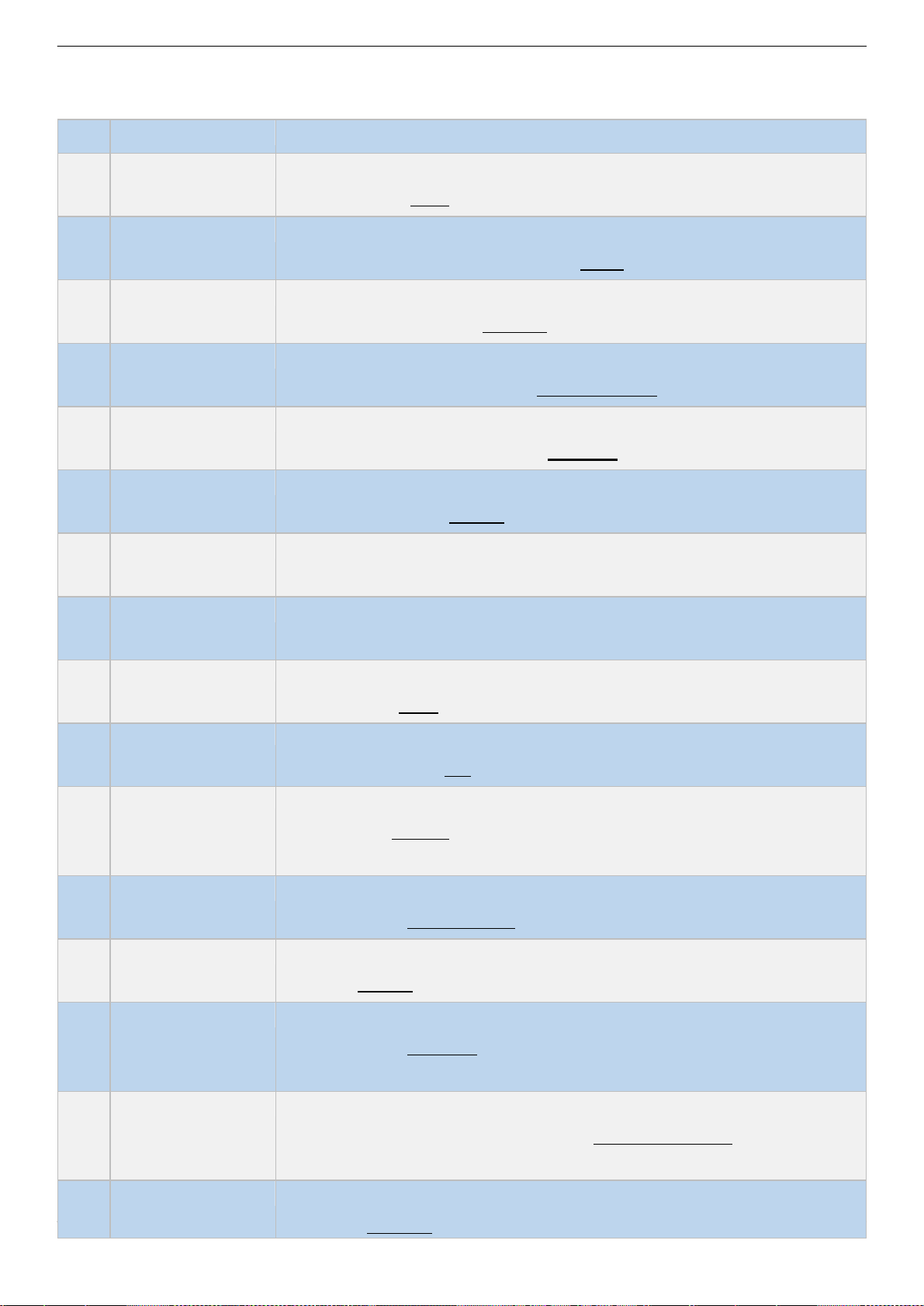
Trang
396
0.
1.
2.
3.
4.
5.
6.
Exercise 2. Choose the the word(s) which is/are CLOSEST in meaning to the underlined word(s) in
each of the following questions.
Câu
Đáp án
Giải thích
1.
D. take care of
Look after
trông
2.
A. take after
Look like
giống
3.
C. pass away
4.
D. bring about
Cause
5.
A. disappear
Wear off
biến mất thôi.
6.
A. turn down
Refuse:
từ chối.
7.
C. talk over
Discuss
8.
B. wear off
Disappear
9.
A. put off
Postpone: hoãn
hoãn
1
B. arrive
Turn up:
1
C. delay
Put off: Hoãn
trì hoãn
sau.
1
D. get over
Recover from
1
C. go off
Explode
1
D. take care of
Look after
ngày.
1
C. get on
Get along
mình.
1
A. turn down
reject
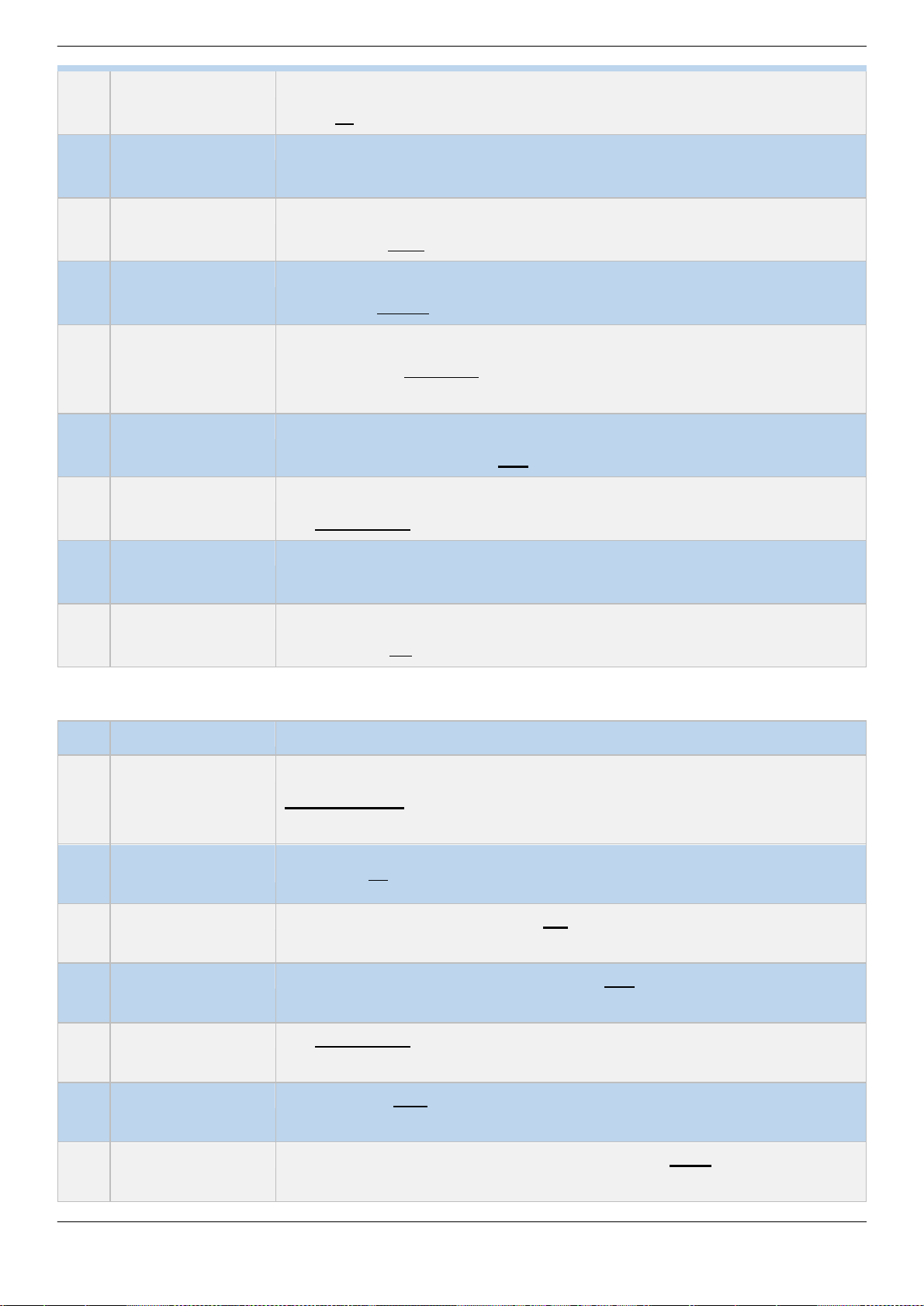
Trang
397
7.
8.
9.
0.
1.
2.
3.
4.
5.
1
C. stop
Give up:
1
D. call off
call off
1
A. put off
postpone: hoãn
Chúng ta hãy hoãn
2
C. bring up
raise:
2
A. tolerate
tolerate
2
D. take in
make sth smaller:
bóp/
2
A. came across
accidentally found
Tôi tình cờ thấy
2
D. look into
investigate
2
A. set up
establish: thành lập, lập
Exercise 3. Giải thích
Câu
Đáp án
Giải thích
1.
Putting up with
-Ing:
Việc chịu đựng
2.
Look up
tra
3.
Run out
hết
4.
Put out
dập
5.
Came across
Tôi tình cờ thấy
6.
Put up with
chịu
7.
Gave sth up
từ bỏ

Trang
398
8.
Looked up sth
tra

Trang
399
0.
1.
2.
3.
4.
5.
6.
7.
8.
9.
0.
1.
2.
3.
4.
5.
6.
7.
8.
9.
Find out
tìm
1
Gave up
tôi từ bỏ.
1
Put up with
chịu đựng
tô này.
1
Look up sth)
tra
1
Came across
Tôi tình cờ thấy
1
Put up with
chịu đựng
1
Find out
tìm ra
Meek.
1
Give up
từ bỏ
1
Put up with
chịu nổi
1
Make up
viện ra
1
Pick up sb
đón
2
Try sth on
mặc thử
2
Came (across)
Julie tình cờ
2
put (out)
dập tắt
2
Made (up)
Louise bịa ra
2
Turned (up)
xuất hiện
2
End (up)
dừng chân
2
Turn (on)
bật đèn
2
Give (up)
bỏ
2
Ran (out of)
Chúng ta hết

Trang
400
9.
0.
1.
2.
3.
4.
5.
0.
1.
2
Find (out)
biết
3
Come (up with)
nghĩ ra
3
Run (out of)
hết sạch
3
Put (out)
tắt
3
Made (up)
bịa
3
Gave (up)
bỏ
3
Turn (off)
tắt
Exercise 4. Trích đề thi Đại học các năm
Câu
Đáp án
Giải thích
1.
B. keep up with
duy trì
2.
A. run out
hết sạch vào
3.
D. get rid it
4.
B. get over
vượt
qua
5.
A. take off
6.
D. fly into
Bay vào
7.
A. be bored with
Chán
8.
C. be fed up with
9.
D. be worried
about
1
C. take care of
Trông nom
1
D. break out

Trang
401
3.
4.
5.
6.
7.
8.
9.
0.
1.
2.
3.
4.
5.
6.
7.
8.
9.
0.
1.
C. give up
1
C. good at
1
D. grow up
1
A. be afraid of
1
A. be tired of
mệt mỏi
1
A. come down with
1
A. take up
1
A. look for
2
C. take part in
2
B. give up
2
B. run out of
2
C. bring about
2
D. go into detail
2
C. go off
2
C. be worried about
2
D. come across
2
C. attend to sth
2
C. catch up with
3
C. out of work
3
B. be in favour of

Trang
402
2.
3.
4.
5.
6.
7.
8.
9.
0.
1.
2.
3.
4.
5.
6.
7.
8.
9.
3
B. bring in
3
B. make room for
3
C. reject
3
A. get over
3
C.take over
3
D. make full use of
3
A. carry out
3
C.take on
4
D. give sb a hand
4
A. develop
4
B. hold up
4
A. keep up with
4
C. show off
Khoe khoang
4
A. look up
4
B. put off
4
C. put on
4
B. get on
4
C. put on:

Trang
403
PHẦN 5:
CÁC TỪ/CỤM TỪ ĐỒNG NGHĨA – TRÁI NGHĨA
Từ/ cụm từ đồng nghĩa và trái nghĩa đôi lúc cũng tạo ra chút rắc rối cho các em trong quá
trình học tiếng Anh. Hy vọng, những bài tập dưới đây sẽ giúp các em tự tin hơn.

Trang
404
UNIT 1: MỘT SỐ BÀI TẬP TỪ/ CỤM TỪ
ĐỒNG NGHĨA
Mark the letter A, B, c, or D to indicate the word or phrase that is CLOSEST in meaning to the
underlined part in each of the following questions.
1. The huge
A. rectangular B. new C. enormous D. tiny
2. Some of the spectators were holding bright banners to cheer the athletes.
A. light B. large C. colorful D. beautiful
3. Slim sportsmen climbed a memory tower (a tall scaffolding) placed in the middle of the field of The
A. brave B. young C. slender D. strong
4. International Olympic Committee President Jacques Rogge gave a delightful speech at the closing
ceremony of the Olympic Games in Beijing.
A. pleasing B. thankful C. wonderful D. satisfied
5. received the Olympic flag.
A. gave B. took C. waved D. kept
6. When the gold medal winner Usain Bolt saw his 200-
is fast.”
A. first B. swift C. excellent D. slow
7. The Bulgarian rhythmic gymnasts were stunned by the Olympic Village in Beijing.
A. happy B. stupefied C. welcomed D. terrified
8. She speaks excellent French.
A. good B. extremely good C. merry D. cool
9. excited about her
victory on August 16.
A. grateful B. very happy C. appreciative D. nervous
10. The overall aim of the book is to help bridge the gap between theory and practice, particularly in
language teaching.
A. increase the understanding B. construct a bridge
C. minimise the limitations D. reduce the differences
11. Thankful athletes, coaches and tourists gave a big hand at the closing ceremony of the 2018 AFC Cup
in China.
A. grateful B. greatful C. gratuitous D. cheerful
Các câu từ 12-36 trích từ các đề thi ĐH các năm trước 2018.
12. Environmentalists appeal to the government to enact laws to stop factories from discharging toxic
chemicals into the sea.
A. releasing B. dismissing C. obtaining D. producing
13. His new work has enjoyed a very good review from critics and readers.
A. viewing B. regard C. opinion D. look
14. Such problems as haste and inexperience are a universal feature of youth.
A. marked B. separated C. shared D. hidden

Trang
405
15. We have lived there for years and grown fond of the surroundings. That is why we do not want to
leave.
A. possessed by the surroundings B. planted many trees in the surroundings
C. loved the surroundings D. haunted by the surroundings
16. As tourism is more developed, people worry about the damage to the flora and fauna of the island.
A. mountains and forests B. flowers and trees
C. fruits and vegetables D. plants and animals
17. It is such a prestigious university that only excellent students are entitled are entitled Jo a full
scholarship each year.
A. are given the right to B. are refused the right to
C. have the right to refuse D. have the obligation to
18. The repeated commercials on TV distract many viewers from watching their favourite films.
A. businesses B. economics C. advertisements D. contests
19. The works of such men as the English philosophers John Locke and Thomas Hobbes helped pave the
way for academic freedom in the modem sense.
A. terminate B. prevent C. initiate D. lighten
20. E-cash cards are the main means of all transactions in a cashless society.
A. cash-starved B. cash-strapped C. cash-in-hand D. cash-free
21. Many scientists agree that global warming poses great threats to all species on Earth.
A. risks B. annoyances C. fears D. irritations
22. Although they hold similar political views, their religious beliefs present a striking contrast.
A. minor comparison B. interesting resemblance
C. significant difference D. complete coincidence
23. These were the people who advocated using force to stop school violence.
A. openly criticised B. publicly said
C. publicly supported D. strongly condemned
24. Within a week on display at the exhibition, the painting was hailed as a masterpiece.
A. an expensive work of art B. a down-to-earth work of art
C. an excellent work of art D. a large work of art
25. Many parents may fail to recognize and respond to their needs until frustration explodes
into difficult or uncooperative behavior.
A. slowly reaches the boiling point B. suddenly becomes uncontrollable
C. stays under pressure D. remains at an unchanged level
26. Those children who stay longer hours at school than at home tend to spend their formative years in the
company of others with similar aims and interests.
A. forming a new business company B. being separated from peers
C. enjoying the care of parents D. being together with friends
27. friend in need is a friend Our friends have voiced their strong criticism of
escalation of tension on our continental shelf.
A. easing the tension B. improving the condition

Trang
406
C. facing the reality D. worsening the situation
28. Now many people who shop at a health food store instead of a local supermarket are much more
likely to find a healthy, sugar-free beverage.
A. full of preservatives B. harmful to heath
C. convenient to prepare D. beneficial to heath
29. Even though the mountain was very steep and the climb was hazardous, several adventurous tourists
managed to reach the top.
A. causing a lot of risks B. bringing excitement
C. resulting in depression D. costing a lot of money
30. Dozens of applicants showed up for the vacant position, but only a handful of them were shortlisted
for the interview.
A. class B. hand C. small number D. small amount
31. Just like hearing infants who start first with simple syllable babbling, then put more syllables together
to sound like real sentences and questions, deaf babies follow the same pattern.
A. able to hear B. physically abnormal
C. obedient to patterns D. hard of hearing
32. Thanks to the invention of the microscope, biologists can now gain insights into the nature of the
human cell.
A. far-sighted views B. spectacular sightings
C. deep understanding D. in-depth studies
33. When Susan invited us to dinner, she really showed off her culinary talents. She prepared a feast - a
huge selection of dishes that were simply mouth-watering.
A. concerning nutrition and health B. involving hygienic conditions and diseases
C. relating to medical knowledge D. having to do with food and cooking
34. Suddenly, it began to rain heavily, so all the summer hikers got drenched all over.
A. very tired B. refreshed C. completely wet D. cleansed
35. a closed book to me.”
A. an object that I really love B. a book that is never opened
D. a theme that I like to discuss
36. You have to weigh up all the pros and cons of the matter before you make a decision.
A. similarities and differences B. benefits and losses
C. finance and health D. advantages and disadvantages
37. My cousin tends to look on the dark side in any circumstance.
A. be optimistic B. be pessimistic C. be confident D. be smart
38. tighten our belt to avoid getting into debt.
A. earn money B. save money C. sit still D. use up
39. out of stock at the moment.
A. available B. not available C. in process D. unfashionable
40. Please give us prior notice if you need an evening meal.
A. in front of B. before C. subsequent D. at the time of

Trang
407
41. There is convincing evidence of a link between exposure to sun and skin cancer.
A. clue B. dispute C. exhibit D. proof
42. annually in an ASEAN summit to discuss and resolve
regional issues.
A. yearly B. weekly C. monthly D. daily
43. During the 1970s, the U.S. forged trade links with China.
A work B. commerce C. economy D. development
44. We should join hands to save endangered animals from extinction.
A. work together B. take action C. put together D. make decisions
45. Mobile houses have become more popular in recent years.
A. staying in one place B. being bent easily and quickly
C. being moved easily and quickly D. changing shape
46. This article is extracted from his new book.
A taken B. resulted C. differed D. referred
47 People of diverse backgrounds now go to different places for entertainment, business and education.
A. isolated B. distant C. various D. same
48. Disability is a physical limitation on your life.
A. possibility B. difference C. disadvantage D. benefit
49. The scene was one of breath-taking beauty.
A. spoilt B. impressive C. adorned D. touched
50. Is now an appropriate time to make a speech?
A. urgent B. correct C. healthy D. suitable
51. He finally fulfilled his dream of being a teacher.
A. researched B. donated C. achieved D. preserved
52. job to clean the class at weekends.
A. duty B. order C. exercise D. action
53. My sister has been out of work for 3 years.
A. unemployed B. outgoing C. hard-working D. reliable
54. Drinking water each morning may help get rid of toxic substances in the stomach.
A. eliminate B. create C. include D. pollute
55. Fish are abundant in the river flowing through the village.
A. having less amounts B. giving a lot of choices
C. causing congestion D. existing in large quantities
56. The student was broke at the weekend and had to go home.
A. having no lesson B. having no food
C. having no money D. having no accommodation.
57. The accident is thought to have occurred at midnight.
A. cancelled B. vanished C. happened D. collapsed
58. Do you know when this museum was constructed?
A. repaired B. begun C. heightened D. built

Trang
408
59. The catastrophic earthquake destroyed the whole city.
A. disastrous B. courageous C. simultaneous D. jealous
60. There is growing concern about school violence.
A. answer B. worry C. relation D. memory
61. The odour
A. image B. origin C. quality D. smell
62a. His bad behaviour stemmed from his lack of early education.
A. recovered from B. retired from C. resulted from D. graduated from
62b. Her talent for music was really an unparalleled ability; she won most music prizes in the city.
A. incomparable B. compatible C. comprehensive D. inconclusive
63. make out what he was saying as his speech was unclear.
A. retell B. precede C. understand D. conserve
64. This theory is a synthesis of some old concepts and some modem ones.
A. movement B. combination C. elimination D. development
65. Most citizens show that they uphold the new law completely.
A. support B. disapprove C. increase D. reverse
66. A team will be penalized if its players commit fouls.
A. awarded B. punished C. defeated D. destroyed
67. Shops always prefer wholesale products as they are cheaper.
A. selling step by step B. selling only to some people
C. selling continuously D. selling in large quantities
68. This is quite a hard mission for young soldiers to complete.
A. task B. game C. chance D. situation
69. We have just received some urgent messages from the Supreme Court.
A. great B. dependent C. very important D. advanced
70. This is only a temporary solution to that problem.
A. slow B. compulsory C. limited D. serious
71. She has decided that there will be no wedding though they have been engaged for a long time.
A. very busy with preparation B. affected by traditional values
C. formally agreeing to get married D. sharing the same interest
72 A new hydroelectric power station will be built near the village.
A. using water power to produce electricity
B. using hydrogen and carbon to produce electricity
C. using heat to produce electricity
D. using nuclear energy to produce electricity
73. The pirates prefer attacking luxury liners around some islands on the Atlantic Ocean.
A. houses B. sharks C. coasts D. ships
74. It is such a big corporation that it has thousands of employees.
A. company B. factory C. programme D. club
75. There are some hard-to-pick-up-again

Trang
409
A. good B. scary C. useful D. bad
76. Looking after a naughty child is an uphill task for her.
A. well-paid B. difficult C. normal D. wonderful
77. The secrets about his private life have been disclosed to the press.
A. revealed B. returned C. stimulated D. raised
78. He is a miserly man who seldom spends money to buy things.
A. mean B. deaf C. fat D. rich
79. The teacher gave the students a hint so that they could find the answer.
A key B. scold C. suggestion D. condition
80. He was such a diligent student that he studied all day.
A. hard-working B. obedient C. punctual D. witty
81. They substituted the original painting with some copies and sold them to customers.
A. provided B. replaced C. considered D. distributed
82. I am not sure whether those mushrooms are edible.
A. unable to be picked up B. suitable to be eaten
C. able to be researched D. likely to cause harm
83. He tried a lot to get the hang of skiing, and finally succeeded.
A. start to research B. hang the equipment of
C. give up quickly D. learn how to do
84. My niece is the apple of my eve: I always want to be her side.
A. the person I love the most B. the person I fear a lot
85. He left home at the drop of a hat without saying a word.
A. thoroughly B. visually C. securely D. immediately
86. Thanks to the housemaid, their house is always spick and span.
A. clean and tidy B. high and large
C. cheap and convenient D. bright and clear
87. The new worker was reprimanded for his serious mistakes.
A. required B. blamed C. praised D. exchanged
88. ad for his death; she is just putting an act.
A. waiting B. disappointing C. defending D. pretending
89. Those animals are susceptible
A. vulnerable B. incredible C. inaccessible D. inevitable
90. The woman rushed to cook lunch after she had gone home from the market.
A. decided B. hurried C. learnt D. agreed
91. Most of them all felt exhausted after a day on the farm.
A. irritated B. excited C. convinced D. tired
92. My friend and I work in different cities, so I only see him once in a blue moon.
A. rarely B. often C. never D. always
93. The unusual weather had an effect on our crops a lot.

Trang
410
A. infected B. affected C. defected D. rejected
94. hazardous.
A. exciting B. beneficial C. messy D. unsafe
95. This hall is for exclusive room of guests. Only rich people can enter it.
A. visible B. economic C. decorative D. limited
96. The trip to the village was fantastic. The local people were really hospitable.
A. dynamic B. strange C. controversial D. wonderful
97. When crops failed, a lot of people had to face famine.
A. crisis B. revolution C. starvation D. epidemic
98. After the sudden shower. a rainbow appeared in the sky.
A. storm B. wind C. rain D. flood
99. Some non-governmental organizations did some voluntary activities in Africa last month.
A. controlled by a government B. affected by a government
C. not belonging to a government D. not protecting a government
100. implemented in the near future.
A. preserved B. executed C. insured D. rescued
101. splendid waterfalls.
A. popular B. circular C. regular D. spectacular
102. The new policies really stimulate investment in some rural areas.
A. reflect B. encourage C. transmit D. guarantee
103. Could we have an alternative? This room is too small.
A. a choice B. an excuse C. a measure D. an order
104. They spent a lot of time making this enormous birthday cake
A. small B. low C. big D. soft
105. The heavy machines torn down the house in just some minutes.
A. demolished B. repaired C. polished D. elevated
106. It is customary to give children lucky money during the Lunar New Year in Vietnam.
A. strange B. traditional C. possible D. essential
107. He gave an outstanding speech about future jobs for high school students.
A. competitive B. impressive C. communicative D. extensive
108. You should not use your phone once the plane is airborne.
A. with our the air B. outside the air C. in the air D. off the air
109. Some comtemporary laws should be adjusted for an advanced society.
A. appropriate B. imperative C. current D. habitual
110. The lecture was so dull that most of the audience fell asleep.
A. frightening B. boring C. surprising D. amusing
111. She has a bee in her bonnet about jogging and it is the subject of most of her conversations.
A. keeps talking about it again and again B. has no idea about it
C. has intention of doing it soon D. gives others advice about it
112. We had unforgettable experiences during our tour of the museum.

Trang
411
A. forgetful B. memorable C. fortunate D. measurable
113. The tiger reached its prey so swiftly that the prey could not recognise it.
A. greatly B. fairly C. lately D. quickly
114. The millionaire possessed most of the houses around the lake.
A. owned B. sold C. lost D. founded
115. Each day, a lot of infants are born in hospitals.
A. adults B. teenagers C. elders D. babies
116. In place of those bulbs, you could buy energy-saving ones.
A. In front of B. Instead of C. In search of D. In respect of
117. Customers who will receive gifts have been chosen arbitrarily,
A. selectively B. randomly C. controversially D. comically
118. We are trying to console some sorrowful people whose beloved ones were killed in the earthquake.
A. sad B. poor C. bald D. kind
119. It is a big sporting event with a lot of professional participants.
A. conditional B. skillful C. eager D. adventurous
120. It was a red-letter day for the team as they won the first prize.
A. a boring day B. a happy day C. a uneasy day D. a tiring day
121. Some countries in this area were accused of providing the terroists with weapons.
A. cultivating B. alternating C. supplying D. dismissing
122. Why do you have to argue over such trivial matter?
A. adorable B. fabulous C. unimportant D. envious
123. We had a happy time at the amusement park and the gifts we recived from a game were just the icing
on the cake.
A. something that causes confusion to something else
B. something that is suitable for a specific purpose
C. something that has a lot of potential
D. something that makes a good situation even better
124. cash with US.
A. money B. luggage C. furniture D. knowledge
125. She looked terrific in her new dress, which made her stand out in the party.
A. terrible B. wonderful C. tedious D. showy
126. Our teachers advise us to hit the books for the coming exam.
A. read more reference books B. arrange the bookshelf
C. stop playing sports D. study intensively
127. My teacher laid stress on the importance of textbooks in
A. ignored B. criticized C. emphasized D. inflict
128. frequently drinks.
A. never B. seldom C. often D. little
129. Please ring me when you arrive in the city.
A. ask B. lift C. hold D. phone

Trang
412
130. He was so annoyed with his daughter that he prevented her from entering their house.
A. amazed B. excited C. cheerful D. angry
131. We must verify her confession before leading her to the police.
A. delay B. check C. swap D. form
132. My grandfather said he was as right as rain after the time in hospital.
A. felt healthy again B. was protected from weather
C. did the right thing D. looked as young as teenagers
133. The soldiers overcame their fright and moved forward.
A. guess B. fear C. hope D. dream
134. Frogs are amphibians which can be easily found in wet fields.
A. animals that live both on land and in water
B. animals that can jump quite high
C. animals that like deep water
D. animals that eat smaller animals
135. Just take it easy
A. return B. resist C. relax D. reload
136. The new policy by the government face a lot of protests.
A. ageements B. concepts C. objections D. rumours
137. They formed a massive army to invade their neighbours.
A. extensive B. aggressive C. defensive D. comprehensive
138. He used to burn the midnight oil whenever he had an exam.
A. sleep through the night B. cook a midnight meal
C. work until very late at night D. wait for the night to pass
139. The man who joined the club last week is very good-looking.
A. sporty B. intelligent C. active D. handsome
140. She finally got married to a well-off man.
A. rich B. poor C. strong D. weak
141. It is hard to estimate how much money we should invest in the project.
A. propose B. calculate C. develop D. separate
142. hit the sack
A. stop working B. do exercise C. go to bed D. have supper
143. The children used clay to create some objects around them.
A. toy B. pen C. book D. soil
144. He has made progress in his study recently.
A. got up B. got off C. got along D. got away
145. I used play computer game for recreation.
A. amusement B. situation C. endurance D. ornament
146. We had a triumph over our neighbours in a friendly football match.
A. escape B. victory C. force D. battle
147. The mudslide obstructed the road to the town.

Trang
413
A. loosened B. condensed C. blocked D. detached
148. Mr. John kicked the bucket last night and we are going to his funeral.
A. flew B. died C. jumped D. breathed
149. The villagers always showed their esteem for the old man who gave them good advice.
A. donation B. adjustment C. sympathy D. respect
150. He held her hand and put a blank sheet of paper on it.
A. empty B. colourful C. thin D. dry

Trang
414
0.
1.
2.
3.
4.
5.
6.
7.
1. Một số bài tập từ vựng đồng nghĩa
Câu
Đáp án
Giải thích
1.
C
Huge = enormous: rộng lớn
2.
C
Bright = colorful: nhiều màu sắc
3.
C
4.
A
Delightful = pleasing: hài lòng, vui sướng
5.
B
Receive = took: nhận;
6.
B
Fast = swift: nhanh
7.
B
Stun = stupefy: kinh ngạc, sửng sốt
8.
B
Excellent = extremely good: xuất sắc
9.
B
Excited = very happy
1
D
Bridge the gap = reduce the differences:
1
A
Thankful = grateful
1
A
Discharge = release
1
C
Opinion = review: ý kiến đánh giá
1
C
Shared:
1
C
To be/ become/ grow fond of sth
grow + tính từ
1
D
Plants and animals:
1
A
To be entitled to sth =

Trang
415
8.
9.
0.
1.
2.
3.
4.
5.
6.
7.
8.
1
C
Commercials =
1
C
Pave the way for:
2
D
Cashless: không dùng tiền mặt = cash-free; Danh từ + hậu tố Free:
Cash--
-in-
2
A
Threats = risks
2
C
2
C
Advocate (tán thành, ủng hộ)
khai)
2
C
A masterpiece:
-to-earth work
2
B
Explode (bùng nổ) = suddenly become uncontrollable
câu này dựa vào tình huống ta dịch cụm từ:
frustration explodes: nổi giận đùng đùng
2
D
In the company of (gắn bó với bạn bè) = being together with friends
being
2
D
Escalation of tension worsening the situation
2
D
Health food store beneficial to
health

Trang
416
9.
0.
1.
2.
3.
4.
5.
6.
7.
8.
9.
0.
1.
2.
3.
4.
2
A
Hazardous = Causing a lof of risk
3
C
Handful = small number
3
A
Hearing
Physical abnormaltheo
hard of hearing
Dịch
3
C
Insights into sth = deep understanding
Far--depts
3
D
Culinary = having to do with food and cooking
mouth-
3
C
Drenched (ướt sũng) = completely wet
3
C
A closed book to me
= a subject that I don’t understand: Môn học mà mình không hiểu gì.
3
D
Pros and cons = advantages and disadvantages = benefits and drawbacks:
3
B
Look on the dark side = be pessimistic:
quan
3
B
Tighten our belt = save money:
3
B
Out of stock = not available
4
B
Prior = before
4
D
Evidence = proof
4
A
Annually = yearly
4
B
4
A
Joind hands = work together

Trang
417
5.
6.
7.
8.
9.
0.
1.
2.
3.
4.
5.
6.
7.
8.
9.
0.
1.
2.
4
C
Mobile = being moved easily and quickly
chóng
hình dáng
4
A
Be extracted from = be taken from
4
C
Diverse = various
4
C
Limitations = disadvantages
4
B
Breath-taking = impressive
5
D
Appropriate = suitable
5
C
fulfil = achieve
5
A
duty = job =
5
A
out of work = unemployed
-
5
A
get rid of = eliminate
5
D
abundant = existing in large quantities
5
C
broke = having no money
5
C
occur = happen
5
D
construct = build
5
A
catastrophic = disastrous
6
B
concern = worry
6
D
odour = smell: mùi
6
C
stem from = result from

Trang
418
4.
5.
6.
7.
8.
9.
0.
1.
2.
3.
4.
5.
6.
7.
8.
9.
0.
C
make out - understand
6
B
synthesis = combination
6
A
uphold = support
6
B
penalize = punish
6
D
wholesale = selling in large quantities
6
A
mission = task
6
C
urgent ~ very important
7
C
temporary ~ limited
7
C
engaged (kết hôn) = formally agreeing to get married (chính thức đồng ý làm vợ
chồng)
thích
7
A
hydroelectric (thủy điện) = using water power to produce electricity
7
D
liner ~ ship (tàu)
7
A
Corporation ~ company (công ty)
7
A
hard-to-pick-up-again ~ bad
7
B
uphill = difficult
well-
7
A
disclose = reveal
7
A
miserly = mean
7
C
hint = suggestion
8
A
diligent = hard-working

Trang
419
1.
2.
3.
4.
5.
6.
7.
8.
9.
0.
1.
2.
3.
4.
5.
6.
7.
8.
9.
8
B
substitute = replace
8
B
edible = suitable to be eaten
8
D
get the hang of sth = learn to do sth
8
A
the apple of my eye ~ the person I love the most
8
D
at the drop of a hat = immediately: ngay lập tức, rất nhanh.
8
A
spick and span = clean and tidy
bright and clear: sáng và rõ ràng
8
B
reprimand = blame:
8
D
put an act = pretend
8
A
susceptible - vulnerable
9
B
rush to do = hurry to do
9
D
exhausted ~ tired
9
A
once in a blue moon ~ rarely
9
B
have an effect on = affect
9
D
hazardous = unsafe
9
D
exclusive ~ limited
9
C
fantastic = wonderful:
9
C
famine = starvation
9
C
shower ~ rain
9
C
non-governmental not belonging to a government

Trang
420
00.
01.
02.
03.
04.
05.
06.
07.
08.
09.
10.
11.
12.
13.
14.
15.
16.
17.
1
B
implement = execute:
1
D
splendid = spectacular:
1
B
stimulate = encourgae
1
A
alternative = choice:
1
C
enormous ~ big
1
A
tear down = demolish
1
B
customary = traditional
1
B
outstanding = impressive
quát
1
C
airborne - in the air:
1
C
contemporary = current:
1
B
dull = boring
1
A
have a bee in one's bonnet about sth:
1
B
unforgettable = memorable: đáng nhớ
1
D
swiftly = quickly: nhanh
1
A
possess = own
1
D
infant = baby
1
B
in place of = instead of: thay vì
1
B
arbitrarily = randomly
cách khôi hài

Trang
421
19.
20.
21.
22.
23.
24.
25.
26.
27.
28.
29.
30.
31.
32.
33.
34.
35.
36.
37.
A
sorrowful = sad
1
B
professional = skilful
1
B
a red-letter day ~ a happy day
1
C
provide = supply
1
C
trivial = unimportant
1
D
the icing on the cake
1
A
cash = money
1
B
terrific = wonderful
1
D
hit the books = study intensively:
1
C
lay stress on = emphasize
1
C
frequently = often
1
D
ring = phone:
1
D
annoyed = angry
1
B
verify check
1
A
be as right as rain
1
B
fright = fear
1
A
amphibian
1
C
take it easy = relax
1
C
protest = objection
1
A
massive = extensive

Trang
422
38.
39.
40.
41.
42.
43.
44.
45.
46.
47.
48.
49.
50.
1
C
burn the midnight oil
1
D
good-looking ~ handsome
1
A
well-off = rich: giàu có
1
B
estimate ~ calculate (tính toán)
1
C
hit the sack = go to bed
1
D
clay soil
1
C
make progress = get along
1
A
recreation = amusement
1
B
triumph = victory
1
C
obstruct = block
1
B
kick the bucket = die
1
D
esteem = respect
1
A
blank = empty

Trang
423
UNIT 2: MỘT SỐ BÀI TẬP TỪ/ CỤM TỪ TRÁI NGHĨA
Mark letter A, B, C, or D on your answer sheet to indicate the word or phrase that is OPPOSITE in
meaning to the underlined word(s) in each of the following questions.
1. Strongly advocating
A. denying B. impugning C. supporting D. advising
2. Unless the two signatures arc identical
A. different B. genuine C. fake D. similar
3. Pure water is often a fairly rare commodity that requires significant energy to produce.
A. Contaminated B. Clean C. Unadulterated D. Flawless
4. Why are being so arrogant?
A. humble B. Cuming C. naive D. snooty
5. The soldiers were told to commence firing in the mock battle.
A. continue B. stop C. begin D. evoke
6. The consequences of the typhoon were disastrous due to the lack of precautionary measures.
A. severe B. beneficial C. physical D. damaging
7. In big cities, animals should be kept under control.
A. out of dispute B. out of discipline C. out of hand D. out of order
8. We ought to keep these proposals secret from the chairman for the time being.
A. accessible B. revealed C. lively D. frequented
9. We left New York when I was six; so my recollections of it are rather faint.
A. misunderstood B. clear C. ambiguous D. explanatory
10. Phosphorus is used in paints for highway signs and markers because it is luminous. at night.
A. dim B. adequate C. bright D. attractive
11. Lugwig van Beethoven was one of the great composers in the history of music.
A. influential B. outstanding C. reliable D. unknown
12. His policies were beneficial to the economy on a whole.
A. innocent B. harmless C. crude D. detrimental
13. It was apparent from her face that she was really upset.
A. indistinct B. evident C. obvious D. transparent
14. The loss of his journals had caused him even more sorrow than his retirement from the military six
years earlier.
A. grief B. joy C. comfort D. sympathy
15. whisper to you, otherwise he will hear.
A. shout B. whistle C. talk D. say
16. The company is very successful in releasing a new customer driven product, which contains no
artificial colors.
A. natural B. false C. artful D. factual
17. Now when so many frogs were killed, there were more and more insects.
A. fewer and fewer B. less and less C. lesser and lesser D. lesser and fewer
18. Asa newspaper reporter she always wanted to get information at first hand.

Trang
424
A. indirectly B. directly C. easily D. slowly
19. In the 1980 census, New Jersey was the most densely populated state.
A. rigorously B. heavily C. wantonly D. sparsely
20. The ship went down although strenuous efforts were made to save it.
A. energetic B. forceful C. half-hearted D. exhausting
21. Do you know of any actual cases of this happening?
A. false B. untrue C. hypothetical D. imitate
22. One by one, the stars appeared in the sky.
A vanished B. blossomed C. broke out D. performed
23. My cousin tends to look on the bright side in any circumstance.
A. be confident B. be optimistic C. be pessimistic D. be smart
24. Their wedding party caused great disappointment but at least there was sufficient food for everyone.
A. worthless B. inadequate C. satisfying D. unpleasant
25. In many countries, military service is obligatory.
A. encouraged B. compulsory C. voluntary D. mandatory
26. Henry has found a temporary job in a factory.
A. genuine B. permanent C. eternal D. satisfactory
27. Primary education in the United States is compulsory.
A. selective B. optional C. free of charge D. required
28. I prefer secure
A. challenging B. demanding C. safe D. stable
29. -skate or skateboard on the road because it was too rough.
A. far B. bumpy C. cold D. smooth
30. Unless you water your indoor
them to look healthy.
A. front-door B. outdoor C. side-door D. door
31. Travel insurance is sometimes mistaken for temporary health insurance, but the two are actually
different.
A. transitory B. passing C. mutable D. permanent
32. Although they hold similar political views, their religious beliefs present a striking contrast.
A. interesting resemblance B. complete coincidence
C. significant difference D. minor comparison
33. very friendly.
A. hostile B. nice C. aware D. popular
34. You can certainly set up a partnership with him as he is trustworthy.
A. unreliable B. indispensable C. unfavourable D. independent
35. Inadequate supply of oxygen to the blood can cause death within minutes.
A. Non-existent B. Sufficient C. Rich D. Useful
36. I would be happy to go along with the idea.
A. disagree with the idea B. agree with the idea

Trang
425
C. support the idea D. approve with the idea
37. The thieves hid their precious possession in the well.
A. priceless B. worthless C. valuable D. invaluable
38. well-behaved
A. behaving nice B. behaving cleverly
C. good behaviour D. behaving improperly
39. Last year, the rush hour delayed our trip to the airport and as a result, we had to change our flight.
A.
B. an hour in the afternoon when people do not travel on the road
C. an hour in the morning when the traffic is easy
D. a time during each day when traffic is at its easiest
40. Names of people in the book were changed to preserve anonymity.
A. cover B. conserve C. presume D. reveal
41. However, how to make full use of these sources of energy is a question for researchers all over the
world.
A. complete B. imperfect C. partial D. hungry
42. My little daughter would spend an inordinate amount of time in the shop, deciding which goods she
was going to buy.
A. excessive B. limited C. required D. abundant
43. This new magazine is known for its comprehensive coverage of news.
A. casual B. superficial C. indifferent D. inadequate
44. During the five-decade history the Asian Games have been advancing in all aspects.
A. holding at B. holding back C. encouraging D. pushing up
45. Their classmates are writing letters of acceptance,
A. agreement B. admission C. refusal D. confirmation
46. He was not afraid to pet the gentle dog, even though it was very big.
A. dirty B. cold C. calm D. fierce
47. cruelly.
A. cleverly B. gently C. reasonably D. brutally
48. Harry displays enthusiasm whenever he is posed with a problem.
A. eagerness B. weakness C. indifference D. softness
49. innocent of the crime. We do not think that he did it.
A. crimeless B. skillful C. clean D. guilty
50. Chinese and French have been made optional second foreign languages at some language universities
in Vietnam.
A. compulsory B. important C. comfortable D. necessary
51. Her health has improved dramatically since she met that doctor.
A. become quicker B. become better C. become slower D. become worse
52. Computer games are a source of pleasure to some young people.
A. sadness B. truth C. happiness D. belief

Trang
426
53. Young birds are quite vulnerable when their predators attack them.
A. safe B. gentle C. aware D. frightened
54. The new policy has brought about substantial changes to the country.
A. essential B. dangerous C. fast D. small
55. The drainage of wetlands may lead to natural habitat destruction.
A. exploration B. damage C. water filling D. change
56. diversity that makes it unique.
A. beauty B. abundance C. movement D. similarity
57. The most energetic athletes participated in the westling competition last month.
A. weak B. cheerful C. enthusiastic D. worried
58. Those goods are imported directly from Thailand, so their prices are cheaper.
A. reported B. exported C. deported D. comported
59. The soldiers stood solemnly when the president passed by them.
A. cheerfully B. impressively C. carefully D. passively
60. This sentence has some figurative meanings and it is hard to understand it fully.
A. integral B. literal C. external D. federal
61. The coming exams caused her a lot of distress and exhaustion.
A. worry B. action C. ease D. doubt
62. The doctors try their best to save the wounded man. Unfortunately. he could not survive.
A. Ultimately B. Definitely C. Unbelievably D. Luckily
63. You should not wear casual clothes when coming to a job interview.
A. vital B. normal C. formal D. total
64. All characters in his novel were imaginary and they were created by himself.
A. scary B. real C. ugly D. illusory
65. stale bread. You may have a stomach ache.
A. bad B. fresh C. old D. mild
66. The little girl used to feel carefree with her family before moving to the new place.
A. relaxed B. tired C. happy D. worried
67. discord among the students in the class.
A. harmony B. disagreement C. noise D. uncertainty
68. Some young people had a discourteous attitude towards the MC at the party, which made him
unhappy.
A. indifferent B. sociable C. impolite D. respectful
69. The hero had united all the people around him, and then they headed for the battlefield.
A. divided B. gathered C. altered D. displayed
70. A lot of young people were standing outside the hall waiting for their idol to come out.
A. someone they loved B. someone they hated
C. someone they feared D. someone they left
71. I would rather you stopped childish behaviour.
A. silly B. active C. sensible D. abstract

Trang
427
72. The singer refused to tell the reporters about her past.
A. denied B. regretted C. hoped D. agreed
73. The lady still keeps her old- fashioned purse as it was a present from her grandmother.
A. ancient B. modem C. realistic D. vital
74. Infinite crowds of people followed the procession to the square.
A. Limited B. Successive C. Chaotic D. Substantial
75. How could you make a reckless comment on her post?
A. thoughtful B. thoughtless C. helpful D. helpless
76. Do you believe in eternal friendship in which the friends never betray one another?
A. temporary B. lasting C. potential D. suitable
77. He is a broad-minded
A. lively B. faithful C. nervous D. stubborn
78. City life always creates an unpleasant feeling of noise and pollution.
A. fuss B. cry C. silence D. image
79. The truck gradually vanished in the dense fog.
A. departed B. disappeared C. revolved D. appeared
80. We received a convivial welcome from the villagers, which made us feel at home.
A. cheerful B. unfriendly C. hospitable D. comfortable
81. How much will it be if we subtract the transport costs?
A. enter B. exclude C. add D. find
82. He was a brave man who fought against the gangsters to protect the girl.
A. lively B. lonely C. friendly D. cowardly
83. The decline in the national economy led to the recession in the country that year.
A. transmission B. improvement C. attrition D. exchange
84. He was once a benevolent man who gave a lot to charities.
A. selfish B. generous C. innocent D. knowledgeable
85. The captain ordered the soldiers to gather on the double, even though they were sleeping.
A. intensively B. increasingly C. hesitantly D. immediately
86. Some volunteers go to remote areas to teach illiterate people.
A. knowing how to read and write B. not knowing how to read or write
C. not knowing how to find the ways D. not knowing how to drive a car
87. Do you know where the entrance to this building?
A. exit B. gate C. balcony D. hall
88. I find it incomprehensible
A. impossible B. irritable C. understandable D. accessible
89. The heavy traffic prevented me from going to work on time this morning.
A. quick B. much C. light D. high
90. The old lady suffered a mental health problem after her illness.
A. physical B. digital C. central D. cultural
91. She made a futile attempt to escape from the kidnappers and was captured again.

Trang
428
A. thoughtless B. defensive C. unexpected D. successful
92. The more crowded a population is, the more energy they consume.
A. save B. use C. spend D. grow
93. There is a shallow lake near the village where the children can swim.
A. dirty B. large C. long D. deep
94. deceitful.
A. honest B. clever C. grateful D. hostile
95. During the Lunar New Year, people always wish their friends or relatives health, happiness, and
prosperity.
A. richness B. poverty C. danger D. anxiety
96. The main drawback of the project is its expense.
A. potential B. advantage C. velocity D. durability
97. His debts have been accumulating for the last few years.
A. increasing B. strengthening C. decreasing D. celebrating
98. Optimists always look on the bright side of a problem.
A. Socialists B. Novelists C. Artists D. Pessimists
99. This complicated
A. complex B. simple C. unimportant D. secret
100. They were determined to resist without surrendering until the end.
A. limit B. submit C. struggle D. promise
101. They are launching a campaign to promote awareness of environmental issues.
A. encourage B. publicize C. hinder D. strengthen
102. Allow me to fill your glass.
A. remake B. empty C. refill D. repeat
103. He is over the moon about his examination result.
A. stressed B. very sad C. very happy D. satisfied
104. The only means of access to the station is through a dark subway.
A. arrival B. admission C. outlet D. output
105. They protested about the inhumane treatment of the prisoners.
A. vicious B. warm-hearted C. callous D. cold-blooded
106. She performed all her duties conscientiously.
A. irresponsibly B. liberally C. responsibly D. insensitively
107. Their classmates are writing letters of acceptance.
A. agree B. confirmation C. refusal D. admission
108. This boy is poorly-educated
A. ignorant B. uneducated C. knowledgeable D. rude
109. Urbanization is the shift of people moving from rural to urban areas, and the result is the growth of
cities.
A. transposition B. maintenance C. variation D. movement
110. The Vietnamese consider it rude to interrupt a person while he is talking.

Trang
429
A. bad mannered B. polite C. uneducated D. ignorant
111. After their long-standing conflict had been resolved, the two families decided to bury the hatchet.
A. become enemies B. become friends C. give up weapons D. reach an agreement
112. Remember not to show your nervousness during a job interview.
A. confidence B. anxiety C. challenge D. creativeness
113. She was unhappy that she lost contact with a lot of her old friends when she went abroad to study.
A. lost control of B. put in charge of C. made room for D. got in touch with
114. The people at the party were busy playing some games.
A. doing something B. free C. eager D. making something
115. But what the most prevents women from reaching the boardroom, say bosses and head-hunters, is
lack of hands-on
A. unavailable B. untested C. impractical D. insignificant
116. Nowadays, it was rather easy to buy a modem TV, and it does pack a punch to bring to life some
really awesome visuals.
A. have little effect on something.
B. make bad things happen.
C. prevent something from coming into use
D.
117. The Red Cross is an international humanitarian agency dedicated to reducing the sufferings of
wounded soldiers, civilians and prisoners of war.
A. happiness B. loss C. sadness D. pain and sorrow
118. He had never experienced such discourtesy towards the president as it occurred at the annual
meeting in May.
A. rudeness B. measurement C. encouragement D. politeness
119. John was so insubordinate that he lost his job in one week.
A. understanding B. fresh C. obedient D. disobedient
120. Hundreds of people have become jobless when the foreign president of the company left the country
secretly.
A. employed B. busy C. unemployed D. highly-paid
121. A mediocre student who gets low grades will have trouble getting into an Ivy League College.
A. excellent B. lazy C. average D. moronic
122. The shop assistant has to break off the conversation to serve a customer.
A. interrupt B. hurry C. continue D. begin
123. Population growth rates vary among regions and even among countries within the same region.
A. restrain B. stay unchanged C. remain unstable D. fluctuate
124. All children can attend without paying fees at state schools.
A. primary schools B. secondary schools
C. high schools D. independent schools
125. The doctor asked John to exhale slowly.
A. imhale B. move in C. enter D. breathe in

Trang
430
126. A chronic lack of sleep may make us irritable and reduce our motivation to work.
A. calm B. uncomfortable C. miserable D. responsive
127 He found the course difficult so he had to spend most of his time on study.
A. memorable B. easy C. interesting D. hard
128. Because Jack defaulted on his loan, the bank took him to court
A. failed to pay B. paid in full
C. had a bad personality D. was paid much money
129. In the final match between Liverpool and Manchester United, viewers witnessed the deadly
11th goal of the season.
A. mortal B. unhealthy C. lethal D. immortal
130. His career in the illicit drug trade ended with the police raid this morning.
A. elicited B. irregular C. secret D. legal
131. Your experience with oil well fires will be invaluable to the company in case of trouble
A. precious B. priceless C. important D. worthless
132. A thrifty buyer chases fruits and vegetables in season.
A. professional B. economical C. careful D. extravagant
133 An employer must be very careful in dealing with subordinates and documenting their files in order
to avoid complaints.
A. bosses B. coordinators C. outside help D. employees
134. My friend and his soccer coach are incompatible. They are always arguing.
A. too different to work together B. almost exactly the same type
C. really disliking each other D. getting on very well
135. The motorist felt that the ticket for infraction was unwarranted.
A. conscientious B. justified C. inadvertent D. inevitable
136. sustain life.
A. prolong B. obstruct C. support D. destroy
137. replenish stocks before the winter sets in.
A. remake B. empty C. refill D. repeat
138. There has been no discernible improvement in the noise levels since lorries were banned.
A. clear B. obvious C. thin D. insignificant
139. The guests at the party last night refused to eat the raw fish.
A. fresh B. cooked C. rotten D. well- done
140. She decided to remain celibate and devote her life to helping the homeless and orphans.
A. divorced B. single C. separated D. married
141. She came for Christmas laden with gifts for everyone.
A. later B. provided C. unloaded D. lifted
142. The town is built on a tainted swamp.
A. sweet B. odorous C. ugly D. delicious
143. There has been a significant shortage of new homes in the region.
A. lack B. poverty C. abundance D. fall

Trang
431
144. People in Vietnam nod their head to show that they agree with something.
A. blink B. shake C. wave D. slump
145. The distinction between schooling and education implied by this remark is very important.
A. odd B. implicit C. obscure D. explicit
146. This kind of dress is becoming outmoded.
A. fashionable B. realistic C. unfashionable D. attractive
147. The soldier was demoted for improper behavior.
A. promoted B. lowered C. resigned D. let off
148. His replies were inconsistent with his previous testimony.
A. contradicted B. compatible C. enhanced D. incorporated
149. We were all in a good mood because the weather was good and we were going on holiday the next
day.
A. relaxed and comfortable B. at ease and refreshed
C. upset and disappointed D. sad and depressed
150. eliminate
progress.
A. stop B. extinguish C. continue D. organize

Trang
432
0.
1.
2.
3.
4.
5.
1. Các từ/ Cụm từ Trái nghĩa
Câu
Đáp án
Giải thích
1.
B
> < (to) impugn: công kích
2.
A
identical (adj)> < different (adj): khác nhau
3.
A
pure (adj)> < contaminated(adj)
4.
A
arrogant(adj)> < humble (adj)
5.
B
(to) commence> < (to) stop
6.
B
Disastrous (adj)> < beneficial (adj)
7.
C
under control> < out of hand
8.
B
secret(adj)revealed(adj)
9.
B
faint(adj)> < clear(adj)
1
A
luminous(adj): phát sáng > < dim(adj)
1
D
one of the great composers> < unknown (adj):
vô danh
1
D
beneficial(adj)> < detrimental (adj)
1
A
apparent(adj)> < indistinct(adj)
1
B
Sorrow (n)> < joy(n)
1
A
Whisper (n)>< shout(n)

Trang
433
6.
7.
8.
9.
0.
1.
2.
3.
4.
5.
6.
7.
8.
9.
0.
1.
1
A
Artificial (adj)> < natural (adj)
1
A
more and more> < fewer and fewer
1
A
at first hand> < indirectly (adv)
1
D
Densely (adv)> < sparsely(adv)
2
C
Strenuous (adj)> < half-hearted (adj)
2
C
Actual (adj)> < hypothetical(adj)
2
A
(to) appear> < (to) vanish
2
C
look on the bright side = be optimistic> < be pessimistic: bi quan
2
B
Sufficient (adj)> < inadequate(adj)
2
C
Obligatory (adj) = compulsory (adj)> < voluntary (adj)
2
B
Temporary (adj)> < permanent(adj)
2
B
compulsory/required (adj): > < optional (adj):
2
A
secure jobs> < challenging jobs
2
D
Rough (adj)> < smooth (adj)
3
B
Indoor (n): trong nhà > < outdoor (n)
A. front--
3
D
Temparory (adj)> < permanent (adj): lâu dài

Trang
434
2.
3.
4.
5.
6.
7.
8.
9.
0.
1.
2.
3.
4.
5.
6.
7.
3
B
a striking constrast (n)> < complete coincidence
hoàn toàn
3
A
Friendly (adj)> < hostile(adj)
3
A
Trustworthy (adj)> < unreliable (adj)
3
B
Inadequate (adj)> < sufficient (adj)
3
A
go along with the idea> < disagree with the idea
3
B
Precious (adj): quý giá > < worthless (adj)
D. invaluable(adj) = priceless(adj): vô giá
3
D
well-behaved> < behaving improperly
3
D
Rush hour> < a time
during each day when traffic is at its easiest
D. soak (n,v): ngâm, chìm
4
D
(to) preserve> < (to) reveal
4
C
Full (adj)> < partial (adj)
4
B
Inordinate (adj)> < limited(adj)
4
B
Comprehensive (adj): superficial (adj):
4
B
Advance (n)> < hold back
4
C
Acceptance (n)> < refusal(n)
4
D
Gentle (adj> < fierce (adj)
4
B
Cruelly (adv)> < gently (adv)

Trang
435
9.
0.
1.
2.
3.
4.
5.
6.
7.
8.
9.
0.
1.
2.
3.
4.
5.
C
Enthusiasm (n)> < indifference (n)
4
D
innocent(adj)> < guilty (adj)
5
A
Optional (adj> < compulsory (adj)
5
D
improve (v)> < become worse
5
A
pleasure (n)> < sadness
5
A
vulnerable (adj)> < safe (adj): an toàn
5
D
substantial (adj)> < small (adj)
5
C
drainage (n)> < water filling
5
D
diversity (n)> < similarity (n)
5
A
energetic (adj)> < weak (adj)
5
B
import (v)> < export (v)
5
A
solemnly (adv)> < cheerfully
6
B
figurative (adj)> < literal (adj)
liên
bang
6
C
distress (n)> < ease (n)
6
D
unfortunately (adv)> < luckily (adv)
6
C
casual (adj)> < formal (adj)
6
B
imaginary (adj)> < real (adj)
6
B
stale (adj)> < fresh

Trang
436
6.
7.
8.
9.
0.
1.
2.
3.
4.
5.
6.
7.
8.
9.
0.
1.
2.
6
D
carefree (adj)> < worried (adj)
A. relaxed; B. tired; C. happy
6
A
discord (n)> < harmony (n)
6
D
discourteous (adj)> < respectful (adj)
A. indifferent; B. sociable; C. impolite
6
A
unite (v)> < divide (v)
7
B
idol (n): someone you hate:
7
C
childish (adj)> < sensible (adj): khôn ngoan
7
D
refuse (v)> < agree (v)
7
B
old-fashioned (adj)> < modern (adj)
7
A
infinite (adj)> < limited (adj)
7
A
reckless (adj)> < thoughtful (adj)
7
A
eternal (adj)> < temporary (adj
7
D
open-minded (adj)> < stubborn
7
C
noise (n)> < silence (n)
7
D
vanish (v)> < appear (v)
8
B
convivial (adj)> < unfriendly (adj)
8
C
subtract (v)> < add (v)
8
D
brave (adj)> < cowardly: hèn nhát

Trang
437
3.
4.
5.
6.
7.
8.
9.
0.
1.
2.
3.
4.
5.
6.
7.
8.
8
B
decline (n)> < improvement (n)
8
A
benevolent (adj)> < selfish (adj)
8
C
on the spot> < hesitantly (adv)
A.
B.
8
A
illiterate (adj)> < knowing how to read or write
B.
C.
D.
8
A
entrance (n)> < exit (n)
8
C
incomprehensible (adj)> < understandable (adj)
8
C
heavy (adj)> < light (adj)
9
A
mental (adj)> < physical (adj)
9
D
futile (adj> < successful (adj): thành công
9
A
consume (v)> < save (v)
9
D
shallow (adj): nông > < deep (adj): sâu
9
A
deceitful> < honest (adj)
9
B
prosperity (n)> < poverty (n)
9
B
drawback (n)> < advantage (n)
9
C
accumulate (v)> < decrease (v)
9
D
optimist (n)> < pessimist (n)

Trang
438
9.
00.
01.
02.
03.
04.
05.
06.
07.
08.
09.
10.
11.
12.
13.
9
B
complicated (adj)> < simple (adj)
1
B
resist (v)> < submit (v)
1
C
promote (v)> < hinder (v)
1
B
(to) fill> < (to) empty
1
B
Thành ngữ: over the moon (rất vui, rất phấn khởi) > < very sad: rất buồn
1
C
access (n)> < outlet (n)
1
B
inhumane (adj)> < warm-hearted (adj)
D. cold-
1
A
conscientiously (adv)> < irresponsibly (adv)cách
1
C
acceptance (n)> < refusal (n)
1
C
poorly-educated (adj)> < knowledgeable (adj): am
A.
B. uneducated (adj) = poorly-
1
B
shift (n)> < maintenance (n)
D. movement (n)
1
B
rude (adj)> < polite (adj)
1
A
bury the hatchet > < become enemies
-
1
A
nervousness (n) = anxiety (n)>< confidence (n)
1
D
(to) lost contact with: > < (to) get in touch with:

Trang
439
14.
15.
16.
17.
18.
19.
20.
21.
22.
23.
24.
25.
26.
27.
1
B
busy (adj)> < free (adj)
1
C
hands-on (adj)> < impractical (adj)
1
A
thành ngữ: (to) pack a punch> < have little
effect on something
B.
C.
D.
1
A
suffering (n)> < happiness (n)
1
D
discourtesy(n)> < politeness(n)
1
C
insubordinate (adj) = disobedient> < obedient(adj)
1
A
Jobless: employed (adj/PII):
-
1
A
mediocre (adj): excellent (adj):
1
C
(to) break off> < continue (v)
1
B
vary (v)> < stay unchanged
1
D
state school> < independent school
chính.
A.
B.
C.
1
D
exhale (v): breathe in (v): hít vào
1
A
irritable (adj): cáu kình > < calm (adj)
1
B
difficult (a): khó > < easy (a)

Trang
440
28.
29.
30.
31.
32.
33.
34.
35.
36.
37.
38.
39.
40.
41.
42.
43.
1
B
(to) default> < paid in full
1
D
Deadly (adj> < immortal (adj)
1
D
Illicit (adj)> < legal (adj)
1
D
Invaluable (adj): vô cùng quý giá > < worthless (adj)
1
D
thrifty (adjbạc > < Extravagant(adj): hoang phí
1
A
Subordinate (n)> < boss(n)
D. employee (n): nhân viên
1
D
incompatible(adj)> < get on very well
A.
B.
C.
1
B
unwarranted(adj)> < justified(adj)
1
D
(to) sustain: > < (to) destroy
1
B
(to) replenish> < (to) empty
1
D
discernible (adj)> < insignificant (adj)
1
B
raw (adj)> < cooked (adj)
-
1
D
celibate (adj) = single> < married (adj)
1
C
(to) lade> < (to) unload
1
B
tainted (adj)> < odorous (adj)
1
C
shortage (n)> < abundance (n)

Trang
441
45.
46.
47.
48.
49.
50.
B
(to) nod> < (to) shake
1
D
implied (adj)> < explicit (adj)
1
A
outmoded (adj)> < fashionable =
trang,
1
A
demote (v)> < promote (v)
1
B
inconsistent (a)>< Compatible (a)
1
D
in a good mood> < sad and depressed
A.
B.
1
C
eliminate (v): continue:
PHẦN 6
TRỌNG ÂM
Đối với những từ trong tiếng Anh có từ có hai âm tiết trở lên, có một âm tiết được nhấn
mạnh với cao độ và trường độ lớn hơn những âm tiết còn lại. Đó chính là âm tiết mang
trọng âm (stress) của từ đó.
Những từ có ba âm tiết trở lên thường có thêm trọng âm phụ (secondary stress) (,) được
nhấn nhẹ hơn so với trọng âm chính (primary stress) (').
Ta thường gặp bài tập tìm từ có trọng âm chính nhấn vào âm tiết có vị trí khác với ba từ
còn lại. Ngoài ra, có thể có bài tập tìm từ có trọng âm rơi vào âm tiết đầu, thứ hai… hoặc
âm tiết cuối trong mỗi từ.
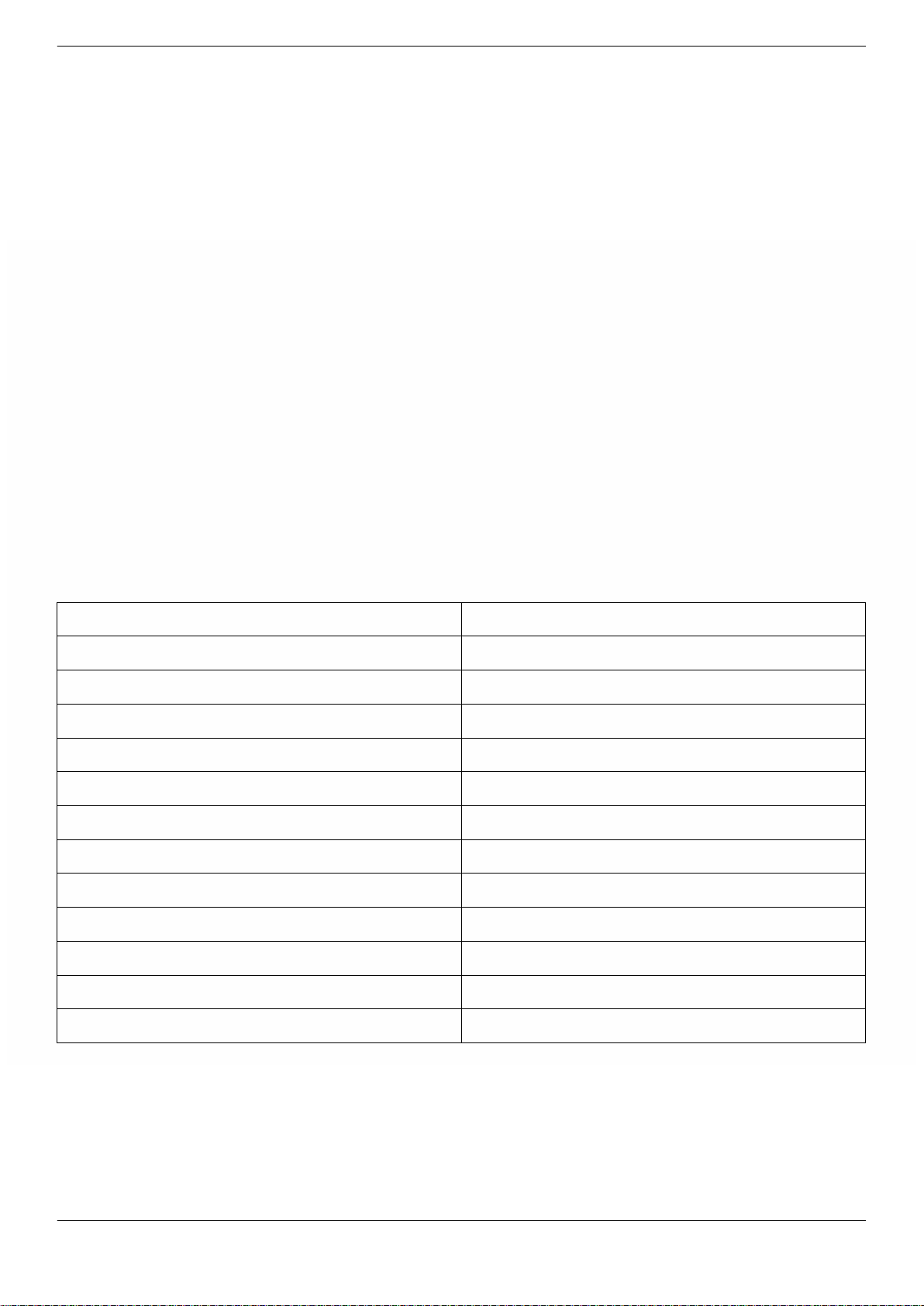
Trang
442
1. Đa số các động từ hai âm tiết có trọng âm rơi vào
âm tiết thứ hai:
attract, begin, deny, forget, enjoy, pollute, relax...
Ngoại lệ: answer, enter, happen, offer, open...
2. Đa số các danh từ và tính từ hai âm tiết có trọng âm
rơi vào âm tiết thứ nhất:
children, hobby, habit, labour, trouble, standard...
basic, busy, handsome, lucky, pretty, silly...
Ngoại lệ:
advice, reply, machine, mistake...
alone, abrupt, absorbed,
amazed...
DANH TỪ
ĐỘNG TỪ
'present (món quà)
pre'sent (trình bày)
re'
- câu trả lời/ trả lời
- lời đề nghị/ đề nghị
- ức tranh/ vẽ một bức tranh
- lời hứa/ hứa

Trang
443
- du lịch/ đi du lịch
- cuộc viếng thăm/ viếng thăm
- lời khuyên/ khuyên bảo
- lời đáp/ trả lời
i vi các danh t c vit lin nhau thì trt th nht. airport,
birthday, bookshop, gateway, guidebook, filmmaker...

Trang
444
3. Danh từ ghép:
- -up: sự kiểm tra toàn bộ nhất là sức khỏe
- -in: sự đăng kí ở khách sạn, sự đăng kí đi máy bay
- người nghỉ học nửa chừng
- sự hỏng máy
- sự thử
- sự đình công đột ngột
4. Ngữ động từ: check ‘up, check ‘in, drop ‘out, break 'down, try 'out, walk 'out...
5 Một số tính từ ghép có trọng âm chính rơi vào
thành phần thứ nhất.
- say máy bay
- kín hơi
- nhớ nhà
- đáng khen
-
- không thấm nước...
Ngoại lệ:
- duty-miễn thuế
- snow-trắng như tuyết
6. Các tính từ ghép có thành phần đầu tiên là tính từ
hoặc trạng từ và thành phần thứ hai tận cùng là -ed
thì trọng âm chính rơi vào thành phần thứ hai.
bad-xấu tính, dễ nổi nóng
short-cận thị
ill-bị đối xử tệ
well-tốt, được nấu kỹ
well-thông thạo, có được thông tin
well-nổi tiếng
7. Đối với các từ có tiền tố thì nhìn chung trọng âm
không thay đổi so với từ gốc (nghĩa là trọng âm ít
khi rơi vào tiền tố).

Trang
445
UN-
im'portant
unim'portant
IM-
'perfect
IN-
com'plete
income'pletc
IR-
re'spectivc
ire'spective
DIS-
con'nect
NON-
'smokers
non'smokers
EN/EX-
'courage
en'courage

Trang
446
RE-
a'rrange
rea'rcange
OVER-
'populated
over'populated
UNDER-
de'veloped
underdeveloped
under-:
underlay [ndle]
understatement (n) underground (adj)
8. Đối với các từ có hậu tố thì hầu hết trọng âm
không thay đổi, và nếu có sự thay đổi về trọng âm
thì cũng có thể thay đổi về cách phát âm.
-ment
agree
agreement
-ship
relation
/
relationship
-ness
happy
happiness
-er/-or/-ant
manage
manager
-hood
neighbour
neighbourhood
-ing
excite
exciting
-ies/-ize
modern
/
modernize
-en
length
lengthen
-ful
success
successful
-less
meaning
meaningless
-able
rely
reliable
/
-ous
poison
/
poisonous
-al
tradition
/
traditional
/
Chú ý:
Nếu thay đổi cách phát âm thì hậu tố làm thay đổi trọng âm của từ đó:
/
9. Các danh từ có hậu tố là -sion, -tion, hoặc -cian thì trọng âm chính thường rơi vào âm tiết ngay
trước đó (chính là âm tiết thứ hai từ cuối lên).
/
communication
/
mathematician /
/
10. Các danh từ có hậu tố là -ity, -logy, hoặc -graphy thì trọng âm chính thường rơi vào âm tiết thứ

Trang
447
ba từ cuối lên.
ability /
technology /
geography /

Trang 5
11. Các tính từ có hậu tố là -ic thì trọng âm chính
thường rơi vào âm tiết ngay trước đó (chính là âm
tiết thứ hai từ cuối lên).
scientific
-ical
electrical /
/
mathematical:
/
-ee
-eer
-ese
-ique/-esque
-ain i vng t)
Ngoại
lệ:
BÀI TẬP PHẦN TRỌNG ÂM
1. A. Vietnamese
B. equipment
C. understand
D. volunteer
2. A. employment
B. diversity
C. dishonest
D. difference
3. A. acceptable
B. acquaintance
C. friendliness
D. suspicious
4. A. education
B. disciplines
C. influences
D. customers
5. A. requirements
B. applicants
C. admissions
D. financial
6. A. dangerous
B. endangered
C. pollution
D. extinction
7. A. achievement
B. beautiful
C. suitable
D. natural
8. A. excitement
B. impression
C. government
D. production
9. A. environmental
B. organization
C. international
D. communication
10. A. offer
B. deny
C. delay
D. apply
11. A. conduct
B. constant
C. return
D. dismay
12. A. habitat
B. selection
C. attention
D. collection
13. A. breakfast
B. pressure
C. garbage.
D. secure
14. A. supportive
B. volunteer
C. disabled
D. obedient
15. A. overcome
B. attitude
C. languages
D. decorate
16. A. secondary
B. kingdom
C. university
D. forest
17. A. agriculture
B. majority
C. curriculum
D. computers

Trang 6
18. A. society
B. disadvantage
C. informal
D. opponent
19. A. perfect
B. primary
C. behave
D. enter
20. A. reference
B. September
C. security
D. domestic
21. A. favorite
B. engineer
C. pessimist
D. operate
22. A. academic
B. technology
C. economic
D. conversation
23. A. handicapped
B. publicity
C. appropriate
D. advantage
24. A. photography
B. possibility
C. improvement
D. experience

Trang 7
25.
A. challenge
B. carry
C. active
D. because
26.
A. aquatic
B. attempting
C. diseases
D. interview
27.
A. establish
B. development
C. specializing
D. foundation
28.
A. individuals
B. significance
C. prediction
D. political
29.
A. currency
B. religion
C. potential
D. career
30.
A. benefit
B. establish
C. awareness
D. machines
31.
A. vegetables
B. policemen
C. compulsory
D. Americans
32.
A. position
B. concentrate
C. explained
D. existence
33.
A. scientists
B. romantic
C. secure
D. effect
34.
A. impossibly
B. surprisingly
C. unfortunately
D. mentally
35.
A. receive
B. product
C. retain
D. advise
36.
A. entertainment
B. gorilla
C. interaction
D. understand
37.
A. management
B. successful
C. example
D. important
38.
A. convenient
B. comfortable
C. incapable
D. essential
39.
A. cinema
B. linguistics
C. dependence
D. excitement
40.
A. tournament
B. competition
C. imagine
D. facial
41.
A. victory
B. finalist
C. continent
D. detective
42.
A. preference
B. prefer
C. solar
D. preferably
43.
A. industry
B. restaurant
C. industrial
D. forestry
44.
A. exhausted
B. energy
C. colorful
D. plentiful
45.
A. courteous
B. actively
C. available
D. popular
46.
A. identify
B. existence
C. scientist
D. appearance
47.
A. mutual
B. impolite
C. politics
D. forestry
48.
A. obliged
B. sacrifice
C. determine
D. enjoyable
49.
A. accidents
B. resources
C. restaurant
D. offspring
50.
A. alternative
B. electricity
C. potential
D. renewable
51.
A. politics
B. college
C. calendar
D. politician
52.
A. foreign
B. reduce
C. constant
D. shortage
53.
A. include
B. stagnant
C. reform
D. invest
54.
A. enterprise
B. fertilize
C. memorize
D. surprise
55.
A. species
B. special
C. specific
D. specimen
56.
A. resources
B. prevention
C. continue
D. irrigate
57.
A. abolish
B. circulate
C. envious
D. regularly
58.
A. athletic
B. conference
C. political
D. geometry
59.
A. epidemics
B. initiative
C. humanity
D. emergency
60.
A. humanitarian
B. durability
C. individual
D. economical
61.
A. official
B. athletics
C. intensive
D. synchronized
62.
A. biology
B. philosophy
C. biological
D. photography
63.
A. improve
B. believe
C. descend
D. recent

Trang 7
64.
A. primary
B. identify
C. chemical
D. benefit
65.
A. economy
B. economical
C. psychology
D. geography
66.
A. participate
B. enthusiast
C. enthusiastic
D. psychology
67.
A. pollution
B. contaminant
C. atmosphere
D. researcher
68.
A. unemployment
B. energetic
C. controversial
D. facilities
69.
A. temporary
B. opponent
C. delegate
D. dedicated
70.
A. referee
B. volunteer
C. refugee
D. committee
71.
A. adventure
B. mechanic
C. appointed
D. service
72.
A. president
B. different
C. enormous
D. document
73.
A. tolerate
B. principal
C. gymnasium
D. excellent
74.
A. compulsory
B. supportive
C. contractual
D. kindergarten
75.
A. abandonment
B. corporative
C. dependable
D. commercial
76.
A. artificial
B. pioneer
C. destination
D. essential
77.
A. dramatic
B. resemble
C. inconsistent
D. amazing
78.
A. departure
B. capitalism
C. monetary
D. contrary
79.
A. mysteriously
B. originally
C. necessarily
D. elaborately
80.
A. continuous
B. malicious
C. scandalous
D. delicious
81.
A. attractive
B. chocolate
C. decorate
D. balcony
82.
A. departure
B. temperature
C. centigrade
D. agriculture
83.
A. qualify
B. beautify
C. notify
D. solidify
84.
A. vacancy
B. passionate
C. malicious
D. furniture
85.
A. disappear
B. memorial
C. diplomatic
D. presidential
86.
A. interview
B. processor
C. essential
D. compliment
87.
A. salary
B. discrepancy
C. presidency
D. ecstasy
88.
A. consultant
B. descendant
C. redundant
D. relevant
89.
A. deficiency
B. reference
C. conference
D. delicacy
90.
A. ignorant
B. horizon
C. amazing
D. adjacent
91.
A. activate
B. terrify
C. discover
D. normally
92.
A. pollen
B. police
C. polite
D. pollute
93.
A. forget
B. comet
C. regret
D. direct
94.
A. longevity
B. photograph
C. consider
D. uncertainty
95.
A. definite
B. audience
C. entrance
D. suppress
96.
A. eventually
B. capacity
C. altogether
D. particular
97.
A. temptation
B. property
C. government
D. beautiful
98.
A. picturesque
B. extradite
C. interest
D. incident
99.
A. speculation
B. evolution
C. explosive
D. instrumental
100.
A. sensitive
B. constant
C. atmosphere
D. magnetic
101.
A. mountain
B. maintain
C. fountain
D. certain
102.
A. reply
B. appeal
C. offer
D. support

Trang 8
103.
A. answer
B. allow
C. agree
D. deny
104.
A compare
B. approve
C. enter
D. pollute
105.
A. mother
B. relax
C. father
D. garden
106.
A decide
B. combine
C. apply
D. happen
107.
A promise
B. picture
C. listen
D. accept
108.
A apple
B. England
C. shampoo
D. grammar
109.
A open
B. provide
C. complete
D. prefer
110.
A become
B. promise
C. suggest
D. disorder
111.
A flower
B. exclude
C. husband
D. farmer
112.
A. doctor
B. simple
C. castle
D. enlarge
113.
A. decide
B. behave
C. offer
D. occur
114.
A. exciting
B. telephone
C. tomorrow
D. November
115.
A. policeman
B. cinema
C. yesterday
D. politics
116.
A. hospital
B. mischievous
C. supportive
D. special
117.
A. family
B. whenever
C. obedient
D. solution
118.
A. biologist
B. generally
C. responsible
D. security
119.
A. confident
B. important
C. together
D. exciting
120.
A. possible
B. university
C. secondary
D. suitable
121.
A. partnership
B. romantic
C. actually
D. attitude
122.
A. believe
B. marriage
C. response
D. maintain
123.
A. summary
B. different
C. physical
D. decision
124.
A. attractiveness
B. traditional
C. generation
D. American
125.
A. certain
B. couple
C. decide
D. equal
126.
A. attract
B. person
C. signal
D. instance
127.
A. verbal
B. suppose
C. even
D. either
128.
A. example
B. consider
C. several
D. attention
129.
A. situation
B. appropriate
C. informality
D. entertainment
130.
A. across
B. simply
C. common
D. brother
131.
A. social
B. meter
C. notice
D. begin
132.
A. whistle
B. table
C. someone
D. receive
133.
A. discuss
B. waving
C. airport
D. often
134.
A. sentence
B. pointing
C. verbal
D. attract
135.
A. problem
B. minute
C. suppose
D. dinner
136.
A. noisy
B. party
C. social
D. polite
137.
A. restaurant
B. assistance
C. usually
D. compliment
138.
A. impolite
B. exciting
C. attention
D. attracting
139.
A. obvious
B. probably
C. finally
D. approaching
140.
A. waiter
B. teacher
C. slightly
D. toward
141.
A. general
B. applicant
C. usually
D. October

Trang 9
142.
A. parallel
B. dependent
C. educate
D. primary
143.
A. physical
B. achievement
C. government
D. national
144.
A. eleven
B. history
C. nursery
D. different
145.
A. expression
B. easily
C. depression
D. disruptive
146.
A. algebra
B. musical
C. politics
D. apartment
147.
A. mechanic
B. chemistry
C. cinema
D. finally
148.
A. typical
B. favorite
C. division
D. organize
149.
A. computer
B. establish
C. business
D. remember
150.
A. conference
B. lecturer
C. reference
D. researcher

Trang 10
ĐÁP ÁN PHẦN TRỌNG ÂM
Câu
Đáp án
Giải thích
1.
B
Equipment Vietnamese,
understand và volunteer
2.
D
Difference employment, diversity
và dishonest
3.
C
Friendlines acceptable,
acquaintance và suspicou
4.
A
5.
B
Applicants requirements,
admissions và financial
6.
A
Dangerous endangered, pollution
và extinction
7.
A
Achievement beautiful, suitable và
natural
8.
C
Government excitement,
impression và production
9.
C
International có âm vào âm ba, các còn environmental,
organization và communication
10.
A
Offer deny, delay và apply
11.
B
Constant conduct, return và
dismay
12.
A
Habitat selection, attention và
13.
D
Secure breakfast, pressure và
garbage
14.
B
Volunteesupportive, disabled và
15.
A
Overcome attitude, languages và
decorate
16.
C
University secondary, kingdom và
forest

Trang 11
17.
A
Agriculture majority, curriculum
và computers
18.
B
Disadvantage society, informal và
opponent
19.
C
Behave perfect, primary và enter có
20.
A
Reference
21.
B
Engineer favorite, pessimist và
operate
22.
B
Technology academic, economic và
conversation
23.
A
Handicapped publicity,
appropriate
24.
B
Possibility photography,
improvement
25.
D
Because challenge, carry và active
26.
D
Interview aquatic, attempting và
diseases
27.
C
Specializing establish,
development và foundation
28.
A
Individuals significance, prediction
và political
29.
A
Currency religion, potential và
career
30.
A
Benefit establish, awareness và
machines
31.
A
Vegetables policemen, compulsory
và Americans
32.
B
Concentrate position, explained và
existence
33.
A
Scientists romatic, secure và effect

Trang 12
34.
D
Mentally impossibly, surprisingly
và unfortunately
35.
B
Product receive, retain và advise
36.
B
Gorilla entertainment, interaction
và understand
37.
A
Management sucessful, example
và important
38.
B
Comfortablcovenient, incapable
và essentia
39.
A
Cinema linguistics, dependence và
excitement
40.
B
Competition tournament, imagine
và facial
41.
D
Detective victory, finalist và
continent
42.
B
Prefer preference, solar và
preferably
43.
C
Industrial industry, restaurant và
forestry
44.
A
Exhausted energy,colorful và
plentiful
45.
C
Available courteous,actively và
popular
46.
C
Scientist identify,existence và
appearance
47.
B
Impolite mutual, politics và forestry
48.
B
Sacrifice obliged, determine và
enjoyable
49.
B
Resources accidents, restaurant và
offspring
50.
B
Electricity alternative, potential và
renewable

Trang 13
51.
D
Politician có âm vào âm ba, các còn politics, college và
calendar
52.
B
Reduce có foreign, constant và
shortage
53.
B
Stagnant include, reform và invest
54.
D
Surprise enterprise, fertilize và
memorize
55.
C
Specific species, special và
specimen
56.
D
Irrigate resources, prevention và
continue
57.
A
Abolish circulate, envious và
regularly
58.
B
Conference athletic, political và
geometry
59.
A
Epidemics initiative, humanity và
emergency
60.
A
Humanitarian durability, individual
và economical
61.
D
Synchronized official, athletics và
intensive
62.
C
Biological biology, philosophy và
photography
63.
D
Recent improve, believe và
descend
64.
B
Identify primary,chemical và
benefit
65.
B
Economical economy, psychology và
geography
66.
C
Enthusiastic participate, enthusiast
và psychology
67.
C
Atmosphere pollution,
contaminant và researcher

Trang 14
68.
D
Facilities unemployment, energetic
và controversial
69.
B
Opponent temporary, delegate và
dedicated
70.
D
Committee referee, volunteer và
refugee
71.
D
Service adventure, mechanic và
appointed
72.
C
Enormous president, different và
document
73.
C
Gymnasium tolerate, principal và
excellent
74.
D
Kindergarten compulsory,
supportive và contractual
75.
B
Corporative có âm vào âm các còn abandonment,
dependable và commercial
76.
D
Essential artificial, pioneer và
destination
77.
C
Inconsistendramatic, resemble và
amazing
78.
A
Departure capitalism, monetary và
contrary
79.
C
Necessarily mysteriously, originally
và elaboratel
80.
C
Scandalous continuous, malicious
và delicious
81.
A
Attractive chocolate,decorate và
balcony
82.
A
Departure temperature, centigrade
và agriculture
83.
D
Solidify qualify, beautify và notify
84.
C
Malicious vacancy, passionate và
furniture

Trang 15
85.
B
Memorial disappear, diplomatic và
presidential
86.
C
Essential : interview, processor và
compliment
87.
B
Discrepancy salary, presidency và
ecstasy
88.
D
Relevant consultant, descendant
và redundant
89.
A
Deficiency reference, conference và
delicac
90.
A
Ignorant horizon, amazing và
adjacent
91.
C
Discover vào âm hai, các activate, terrify và
normally
92.
A
Pollen police, polite và pollute có
93.
B
Comet forget, regret và direct có
94.
B
Photograph longevity, consider và
uncertainty
95.
D
Suppress definite, audience và
entrance
96.
C
Altogether eventually, capacity và
particular
97.
A
Temptation property, government
và beautiful
98.
A
Picturesque extradite, interest và
incident
99.
C
Explosive speculation, evolution và
instrumental
100.
D
Magnetic sensitive, constant và
atmosphere
101.
B
Maintain : mountain, fountain và
certain

Trang 16
102.
C
Offer reply, appeal và support có
103.
A
Answer allow, agree và deny có
104.
C
Enter compare, approve và
pollute
105.
B
Relamother, father và garden có
106.
D
Happen decide, combine và
apply
107.
D
Accept promise, picture và
listen
108.
C
Shampoo apple, England và
grammar
109.
A
Open provide, complete và
prefer
110.
B
Promise become, suggest và
disorder
111.
B
Excludflower, husband và
farmer
112.
D
Enlargdoctor, simple và
castle
113.
C
Offer decide, behave và occur
114.
B
Telephone exciting, tomorrow
và November
115.
A
Policeman cinema, yesterday
và politics
116.
C
Supportive hospital,
mischievous
117.
A
Family whenever, obedient và
solution
118.
B
Generally biologist,
responsible và security

Trang 17
119.
A
Confident important,
together và exciting
120.
B
University possible, secondary
và suitable
121.
B
Romantic partnership,
actually và attitude
122.
B
Marriage believe, response và
maintain
123.
D
Decision summary, different và
physical
124.
C
Generation attractiveness,
traditional và American
125.
C
Decide certain, couple và equal
126.
A
Attract person, signal và instance
127.
B
Suppose verbal, even và either
128.
c
Several example, consider và
attention
129.
B
Appropriate situation,
informality và entertainment
130.
A
Across simply, common và
brother
131.
D
Begin social, meter và notice có
132.
D
Receive whistle, table và
someone
133.
A
Discuss waving, airport và
often
134.
D
Attract sentence, pointing và
135.
c
Suppose problem, minute và
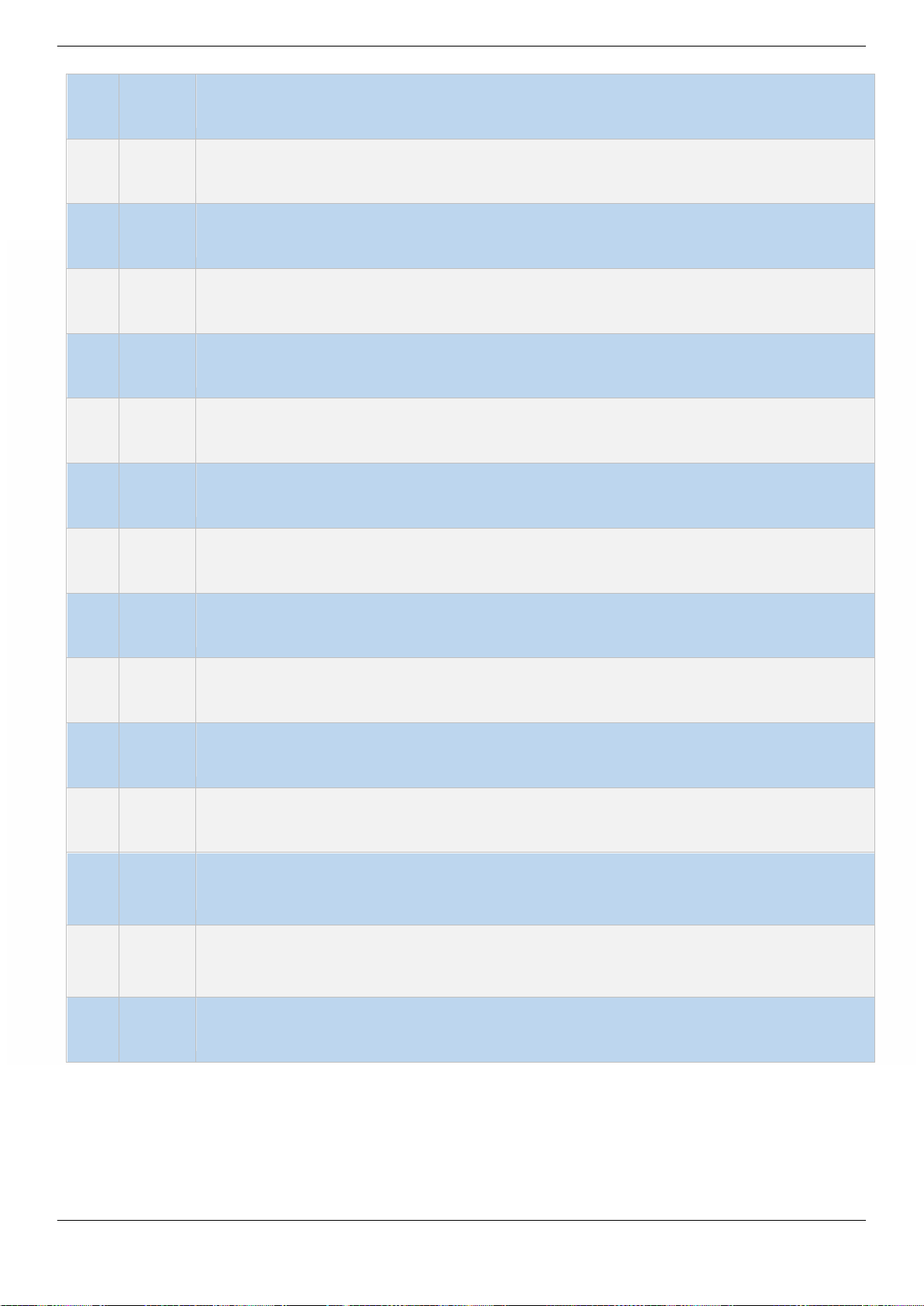
Trang 18
136.
D
Polite party và social có
137.
B
Assistance restaurant, usually
và compliment
138.
A
Impolite exciting, attention và
attracting
139.
D
Approaching obvious, probably và
finally
140.
D
Toward waiter, teacher và
slightly
141.
D
October general, applicant và
usually
142.
B
Dependent parallel, educate và
primary
143.
B
Achievement physical,
government và national
144.
A
Eleven history, nursery và
different
145.
B
Easily expression, depression
và disruptive
146.
D
Apartment algebra, musical và
politics
147.
A
Mechanic chemistry, cinema
và finally
148.
C
Division typical, favorite và
organize
149.
C
Business computer, establish và
150.
D
Researcher có âm vào âm hai, các án còn conference,
lecturer và reference

Trang 19
PHẦN 7:
NGỮ ÂM
Phần này các em sẽ làm quen với các âm nguyên âm đơn, âm nguyên âm đôi, các
phụ âm đặc biệt trong tiếng Anh mà người Việt chúng ta thường gặp khó khăn khi
phát âm. Ngoài ra, các em cùng ôn lại các chữ cái không được phát âm hay còn
được gọi là âm câm.
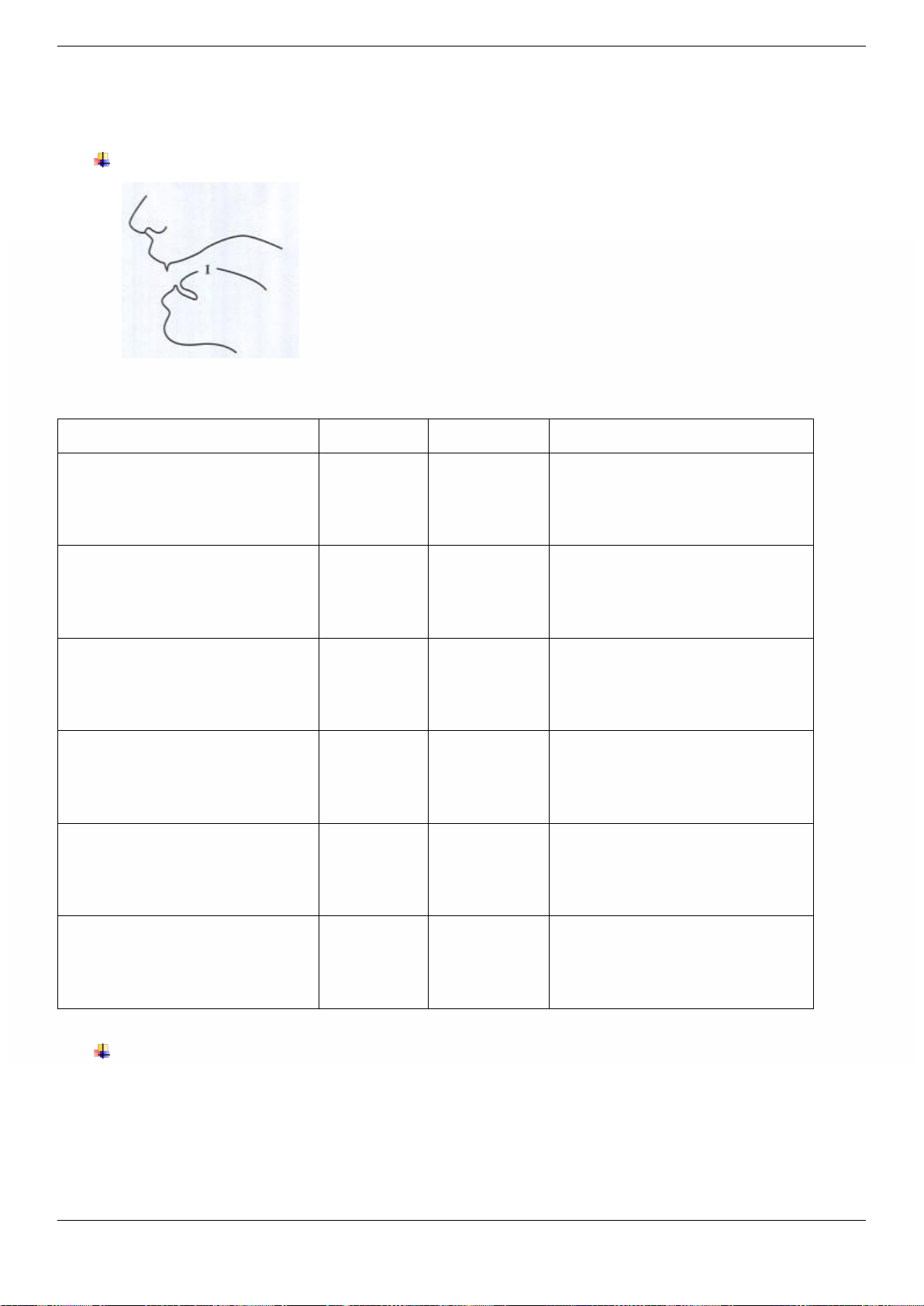
Trang 20
UNIT 1: CÁCH PHÁT ÂM MỘT SỐ NGUYÊN
ÂM ĐƠN
NGUYÊN ÂM /i:/
Các nhóm chữ cái thường được phát âm là /i:/
Cách phát âm: lưỡi đưa hướng lên trên và ra phía
trước, khoảng cách môi trên và dưới hẹp, mở rộng
miệng sang hai bên, nhìn hình vẽ dưới đây.
QUY TẮC
VÍ DỤ
PHIÊN ÂM
NGOẠI LỆ
EE hoặc EE + phụ
âm
/i:/
Free
Cheese
Speed
/
Beer, cheer, deer
EER đọc là /iə/
EA hoặc EA + phụ
âm
/i:/
East
Sea
Meat
Great, weather, death, pleasure,
deaf, break, breakfast, measure,
breath
E-E
phát âm là /i:/.
Cede
Scence
Complete
/si:n/
EI
âm là /i:/.
Ceiling
Seize
Receive
IE nhóm
VE F
phát âm là /i:/.
Believe
Relieve
Grief
ESE
âm là /i:/.
Vietnamese
Chinese
Japanese
NGUYÊN ÂM /ɪ/
Cách phát âm:
dài.
- Các nhóm chữ cái được phát âm là /ɪ/
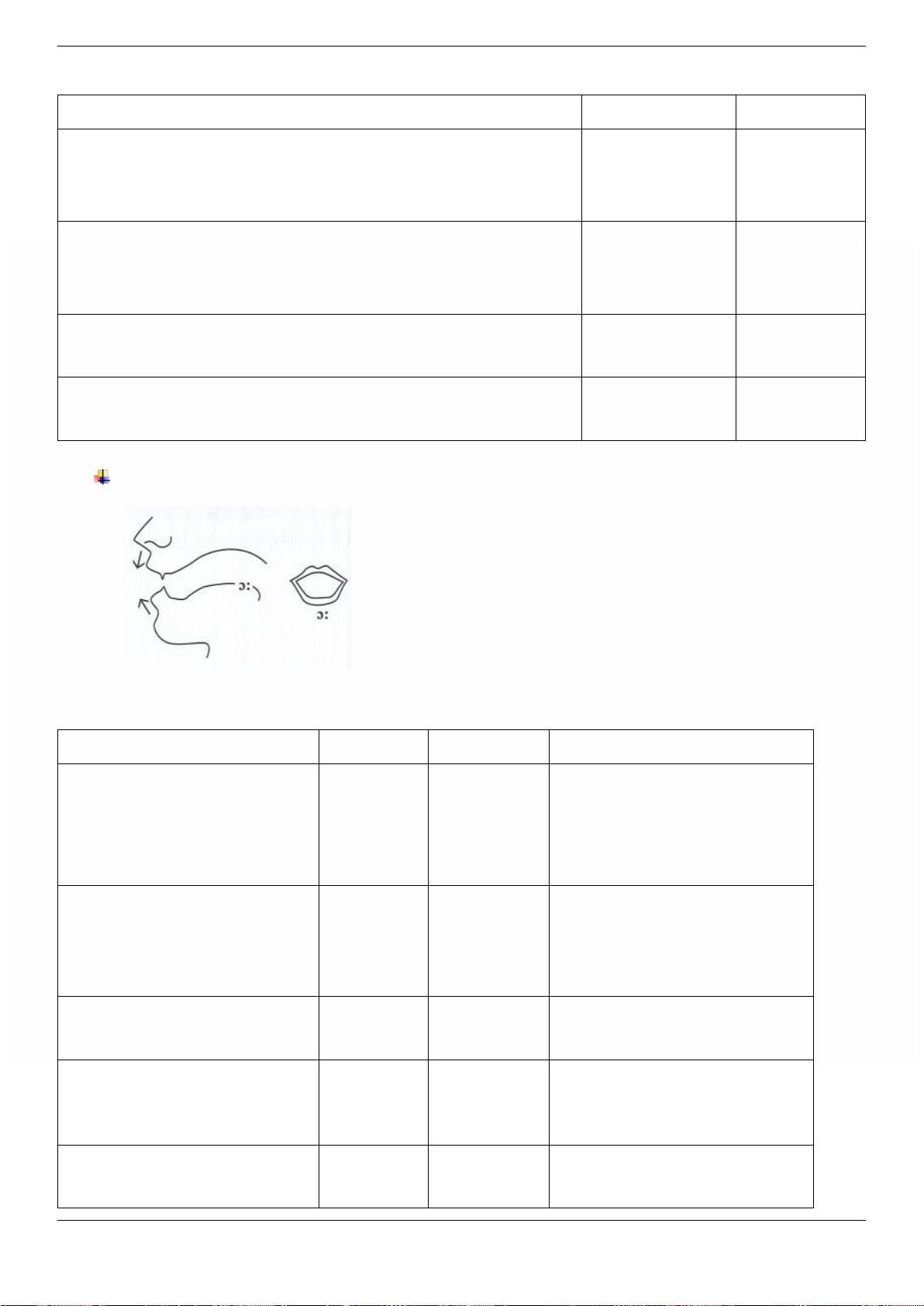
Trang 21
NGUYÊN ÂM
VÍ DỤ
PHIÊN ÂM
I
i/
Bit
Sit
Twin
A “be”, “de” và “re”
Begin
Defrost
remind
A “-
age” i/
Damage
Passage
UI
Build
Guitar
NGUYÊN ÂM /ɔː/
Cách phát âm: lưỡi di chuyển về phía sau, phần lưỡi
phía sau nâng lên, môi tròn và mở rộng, nhìn hình vẽ
dưới đây.
Các nhóm chữ cái thường được phát âm là /ɔː/
QUY TẮC
VÍ DỤ
PHIÊN ÂM
NGOẠI LỆ
/ɔː/
For
Horn
Pork
Mentor
doctor, translator, visitor
A
là
/ɔː/.
Call
Tall
Football
Shall
AU
Fault
Audience
aunt, laugh
AW
phát âm là /ɔː/
“aw” + Phụ âm
Draw
Awful
OA
là /ɔː/ r
Board
Soar
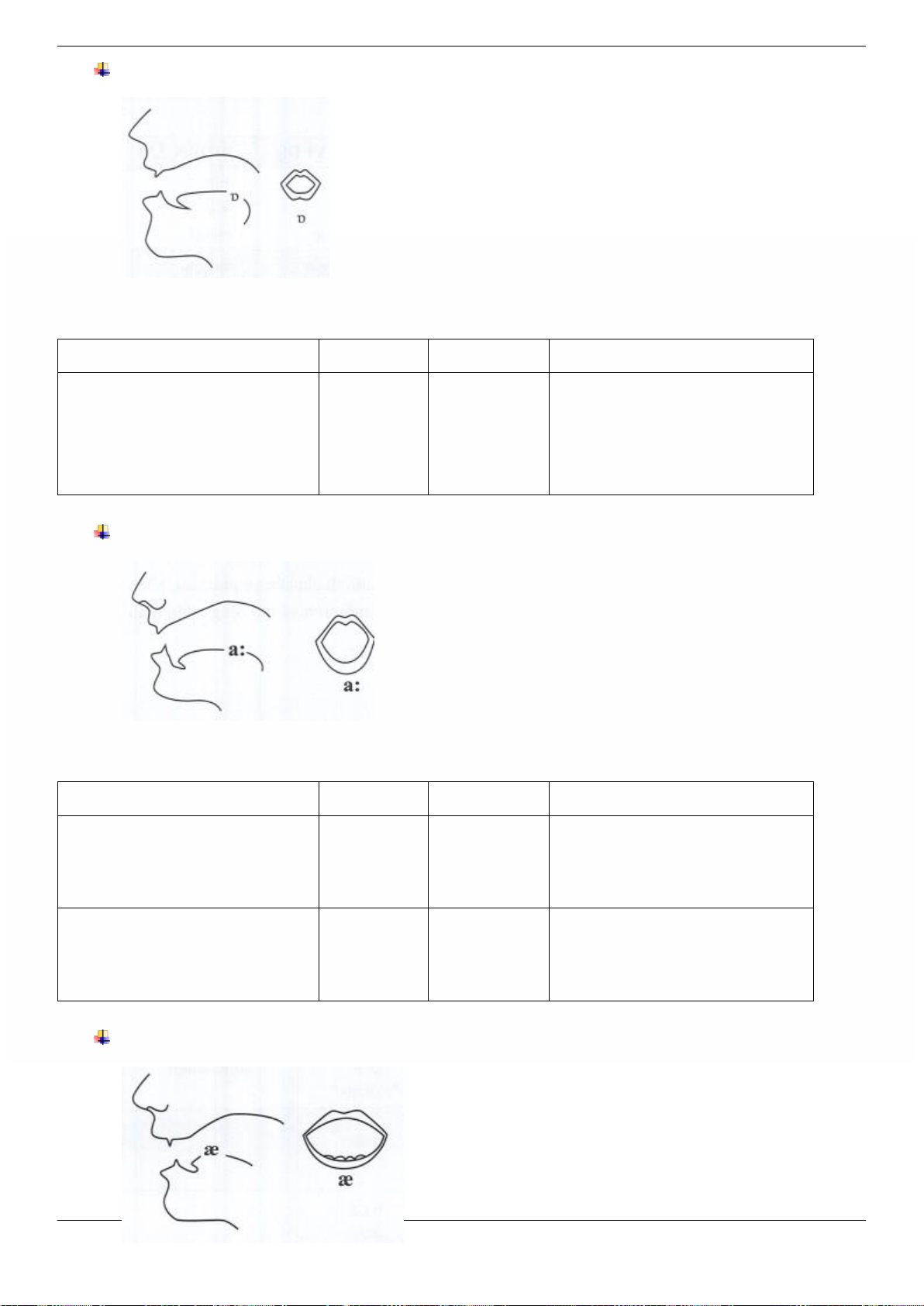
Trang 22
NGUYÊN ÂM / ɒ /
Cách phát âm: Nguyên âm này ở giữa âm nửa mở và
âm mở đối với vị trí của lưỡi, phát âm tròn môi, nhìn
hình dưới đây.
Các nhóm chữ cái thường được phát âm là /ɒ/
QUY TẮC
VÍ DỤ
PHIÊN ÂM
NGOẠI LỆ
O
là /ɒ/
Dog
Stop
Bottle
Bother
NGUYÊN ÂM /ɑː/
Cách phát âm: đưa lưỡi xuống thấp và về phía sau,
miệng mở không rộng cũng không hẹp quá, nhìn hình
vẽ dưới đây.
Các nhóm chữ cái thường được phát âm là /ɑ:/
QUY TẮC
VÍ DỤ
PHIÊN ÂM
NGOẠI LỆ
AR + phụ âm hoặc
âm là /ɑ:/
Bar
Hard
Smart
/
Nhóm AU + phụ âm hoặc
“UA” là
/ɑ:/
Guard
Aunt
Draught
/
NGUYÊN ÂM /æ/
Cách phát âm: Vị trí lưỡi thấp, chuyển động theo
hướng đi xuống, miệng mở rộng, nhìn hình vẽ dưới đây

Trang 23
Các nhóm chữ cái thường được phát âm là /æ/
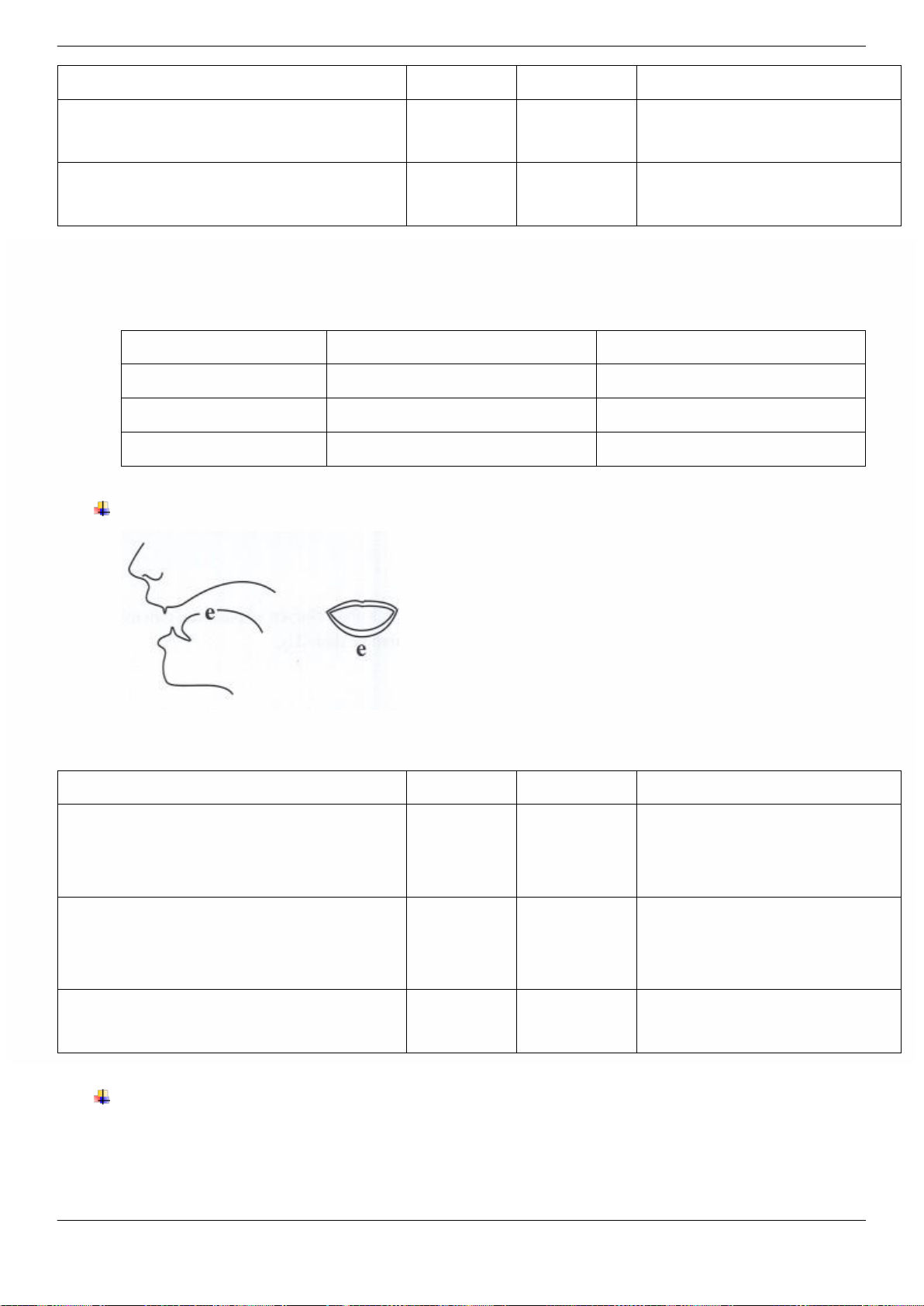
Trang 24
QUY TẮC
VÍ DỤ
PHIÊN ÂM
NGOẠI LỆ
A
Fan
Have
/ fæn /
/hæv /
/a:/.
/æ/
Candle
Narrow
LƯU Ý
a:/æ/
BRITISH ENGLISH
AMERICAN ENGLISH
ask
commander
NGUYÊN ÂM /e/
Cách phát âm: gần giống như phát âm /i/, nhưng
khoảng cách môi trên – dưới mở rộng hơn, vị trí lưỡi
thấp hơn
Các nhóm chữ cái thường được phát âm là /e/
QUY TẮC
VÍ DỤ
PHIÊN ÂM
NGOẠI LỆ
E + một hay nhiều phụ âm
/e/.
Send
Debt
Pen
/ send /
/det /
/pen /
EA /e/.
Bread
Heavy
Leather
/bred /
/
/
A /e/.
Many
Anyone
NGUYÊN ÂM /ʌ/
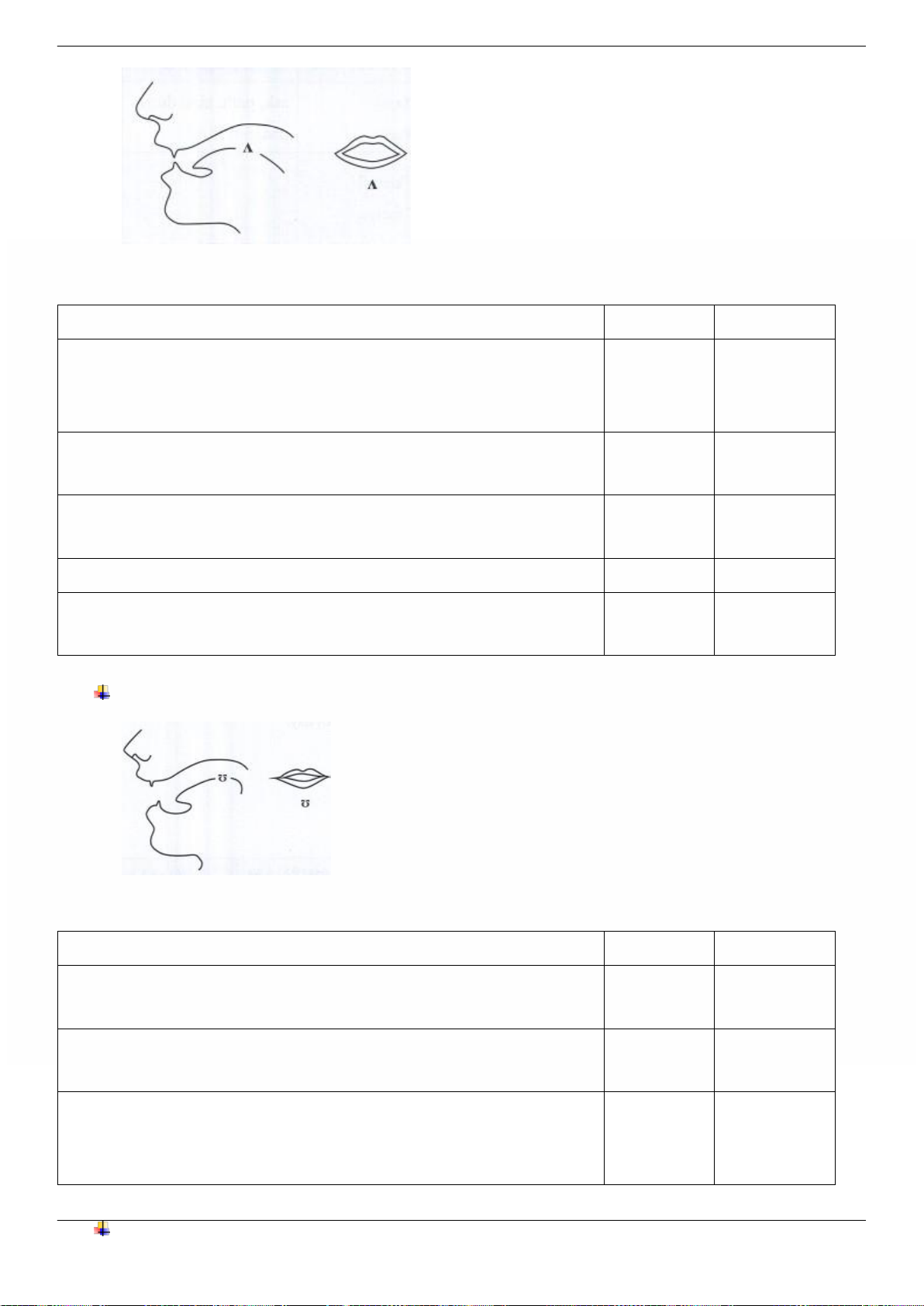
Trang 25
Các nhóm chữ cái thường được phát âm là /ʌ/
Cách phát âm:
QUY TẮC
VÍ DỤ
PHIÊN ÂM
O /ʌ/
Come
Among
Company
/ʌ/ u +
phụ âm
But
Skull
un, um
Uneasy
Unhappy
OO /ʌ/
Blood
OU /ʌ/
Country
Flourish
NGUYÊN ÂM /ʊ/
Cách phát âm: i di chuyn v phía sau, môi m hp
Các nhóm chữ cái thường được phát âm là /ʊ/
QUY TẮC
VÍ DỤ
PHIÊN ÂM
/ʊ/
Wolf
Woman
/ʊ/
Book
Look
/ʊ/
Could
Should
Would
NGUYÊN ÂM /u:/
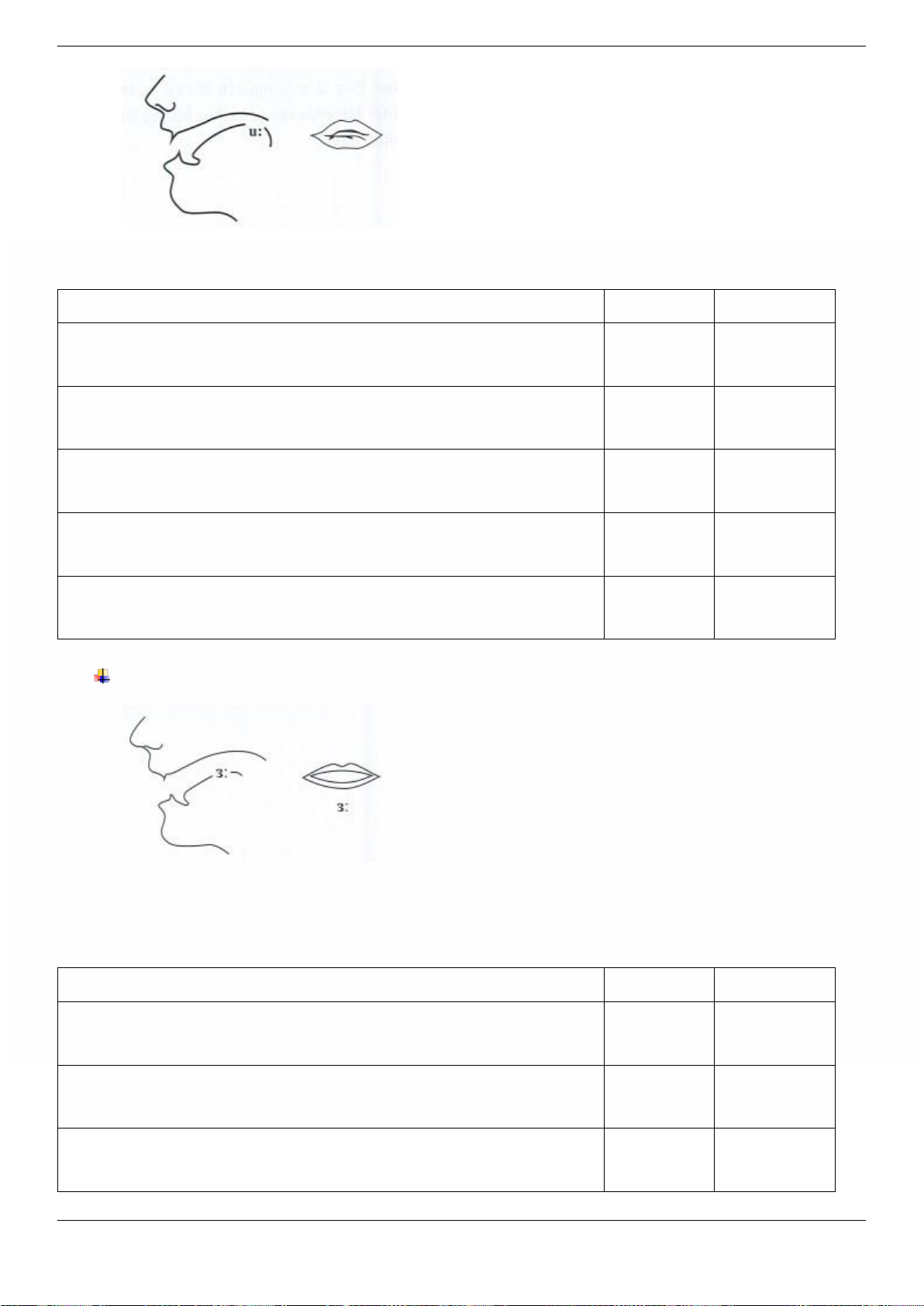
Trang 26
Các nhóm chữ cái thường được phát âm là /u:/
Cách phát âm:
/ʊ/,
QUY TẮC
VÍ DỤ
PHIÊN ÂM
O /u:/
Do
Move
U /u:/
Blue
Lunar
OO /u:/
Food
Tooth
OU /u:/
Group
Wounded
UI /u:/
Fruit
Bruise
NGUYÊN ÂM /ʊ/
Cách phát âm: đây là nguyên âm dài, khi phát âm
miệng mở vừa, vị trí lưỡi thấp, nhìn hình vẽ sau đây.
LƯU Ý
/ɜː/ /ɜː/
QUY TẮC
VÍ DỤ
PHIÊN ÂM
/ɜː/
Bird
Girl
/
/ɜː/
Her
Herd
/ɜː/
Hurt
Curtain

Trang 27
/ɜː/
Work
World
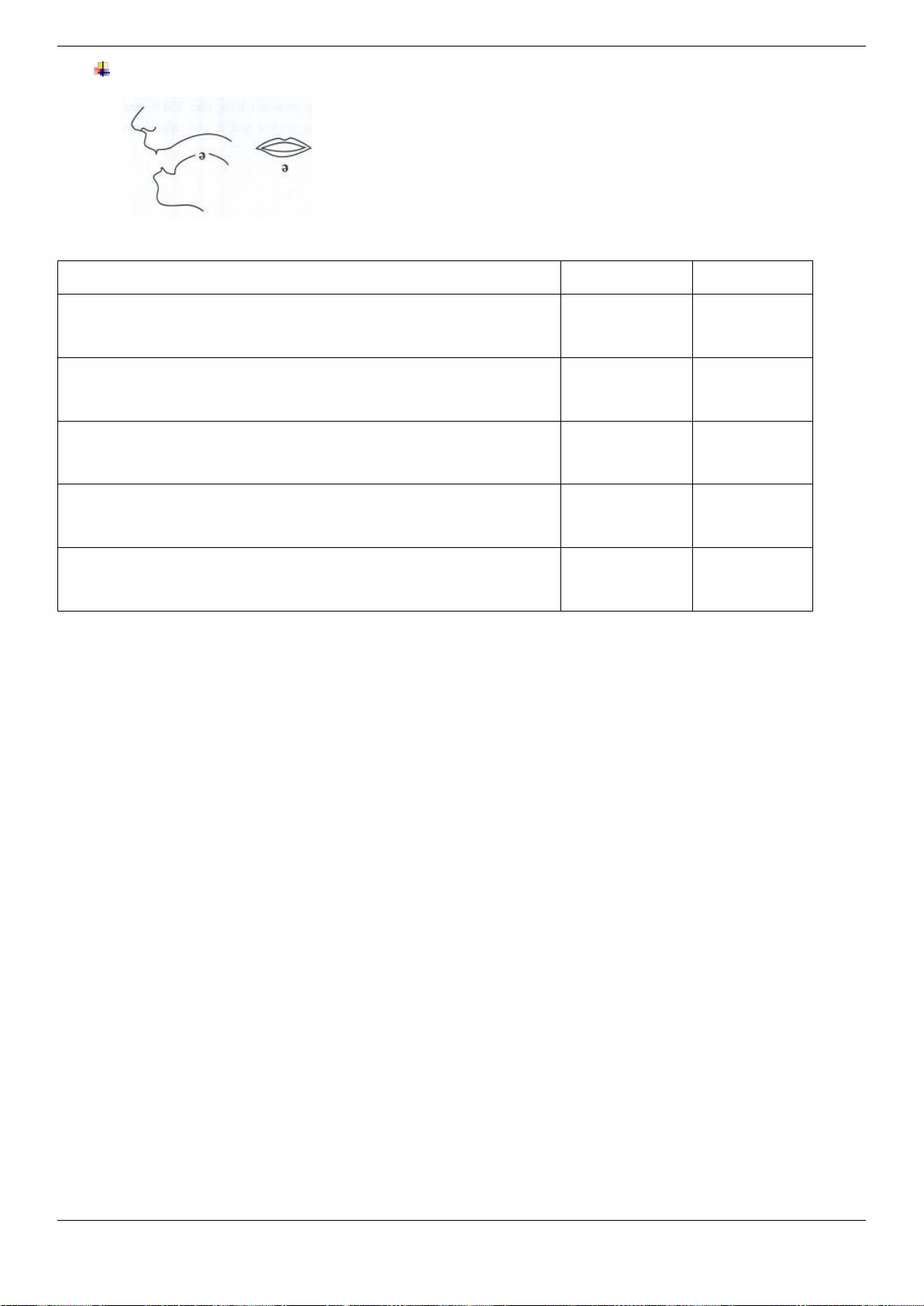
Trang 28
NGUYÊN ÂM / ə /
Cách phát âm:
Các nhóm chữ cái được phát âm là /ə/
QUY TẮC
VÍ DỤ
PHIÊN ÂM
A /ə/
Answer
Separate
E /ə/
Silent
Different
/
/
O /ə/
Compare
Random
/
U /ə/
Suggest
Survey
OU /ə/
Famous
Dangerous

Trang 29
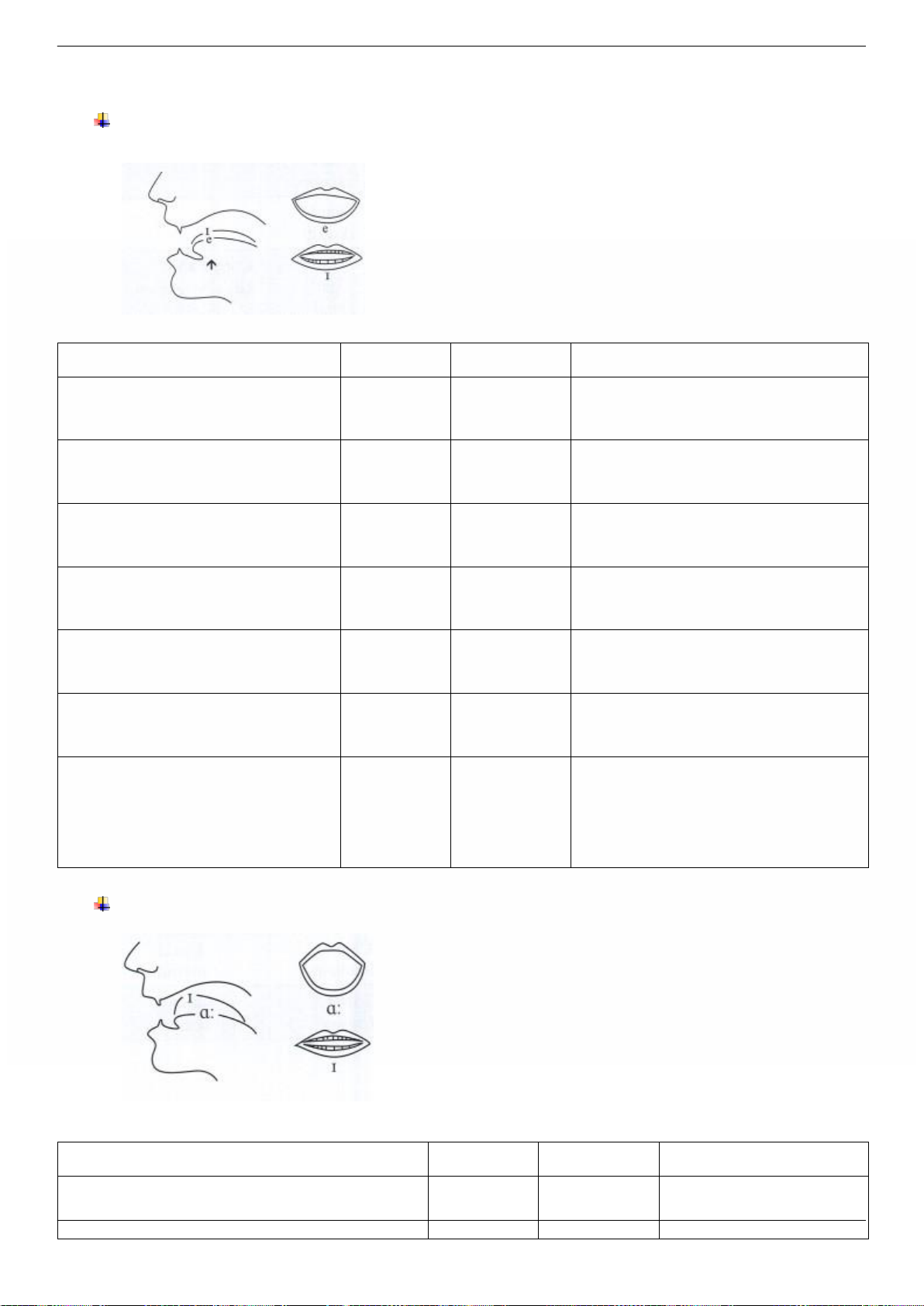
Trang 30
UNIT 2: CÁCH PHÁT ÂM MỘT SỐ NGUYÊN ÂM ĐÔI
NGUYÊN ÂM /ei/
Cách phát âm:
Các nhóm chữ cái thường được phát âm là /ei/.
QUY TẮC
VÍ DỤ
PHIÊN ÂM
NGOẠI LỆ
A-E
âm là /ei/.
Gate
Late
AY
/ei/.
Day
Play
EA
âm là /ei/.
Great
Break
AI + phụ âm
/ei/.
Mail
Wait
EI + phụ âm
/ei/.
Eight
Weight
EY
/ei/.
Obey
Grey
ion
ian
/ei/.
Nation
Asian
Invasion
Vegetarian ,
Companion
Italian
NGUYÊN ÂM /ai/
Cách phát âm:
Các nhóm chữ cái thường được phát âm là /ai/.
QUY TẮC
VÍ DỤ
PHIÊN ÂM
NGOẠI LỆ
IE I-E
là /ai/
Like
Bike
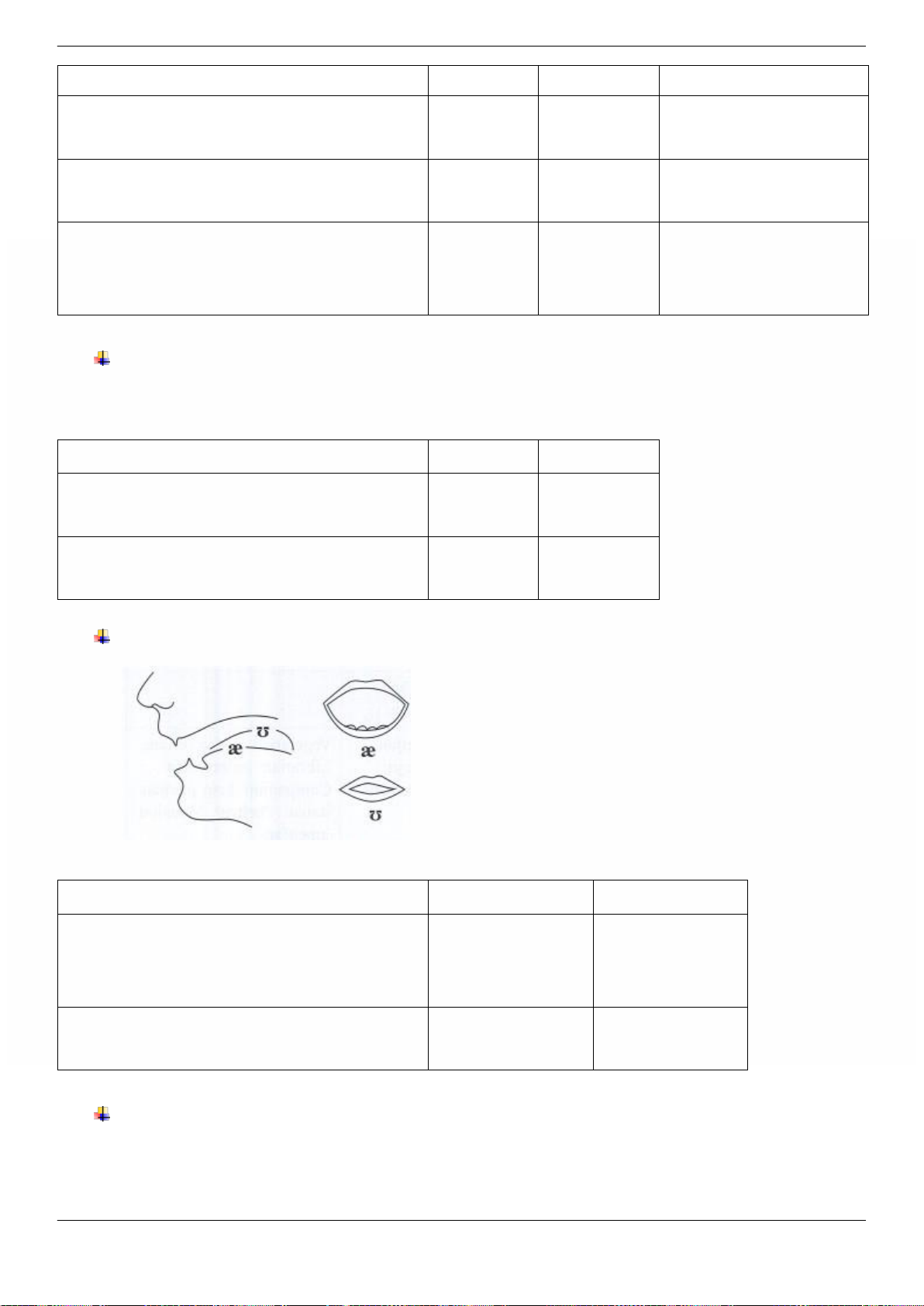
Trang 31
Tide
EI /ai/.
Height
Seismic
UI /ai/.
Guide
Quite
UY hay Y
phát âm là /ai/.
Buy
Guy
Shy
NGUYÊN ÂM /ɔɪ/
Các nhóm chữ cái thường được phát âm là /ɔɪ/.
QUY TẮC
VÍ DỤ
PHIÊN ÂM
OW /ɔɪ/.
Boy
Joy
OI /ɔɪ/.
Oil
Voice
NGUYÊN ÂM /aʊ/
Cách phát âm: æ/
khi
Các nhóm chữ cái thường được phát âm là /aʊ/.
QUY TẮC
VÍ DỤ
PHIÊN ÂM
OU /aʊ/.
Doubt
Cloud
Mountain
OW /aʊ/.
Tower
Crown
NGUYÊN ÂM /əʊ/
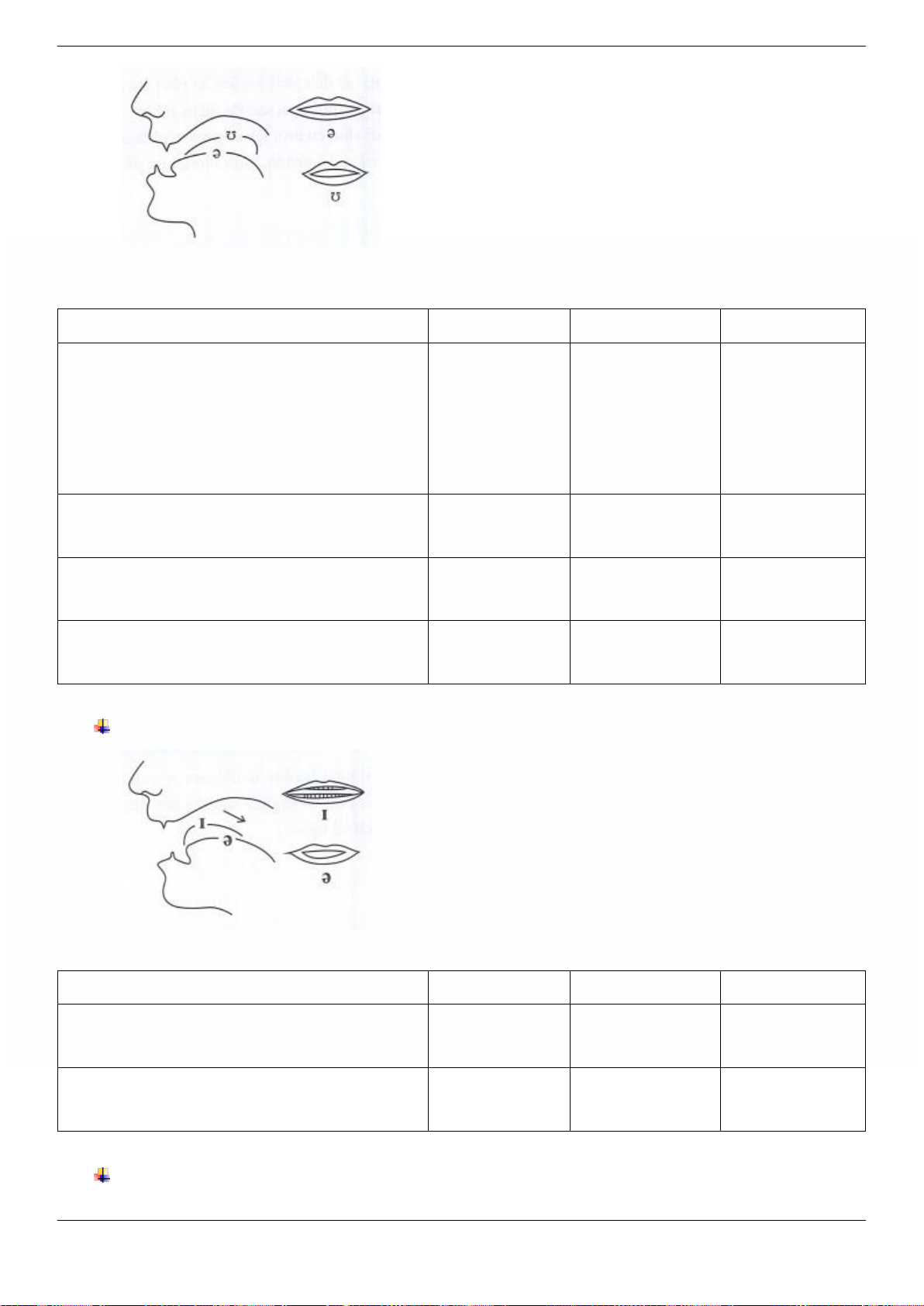
Trang 32
Các nhóm chữ được phát âm là /əʊ/.
Cách phát âm: i v trí phát âm âm /ə/
ng tròn d phát âm /ʊ/, phát âm /ə/ dài,
/ʊ/
QUY TẮC
VÍ DỤ
PHIÊN ÂM
Ngoại lệ
O
phát
âm là /əʊ/.
No
Mode
Tomato
Mosquito
Potato
OA /əʊ/.
Coat
Moan
OU /əʊ/.
Shoulder
Poultry
OW /əʊ/.
Grow
Tomorrow
NGUYÊN ÂM /ɪə/
Cách phát âm:
Các nhóm chữ được phát âm là /ɪə/.
QUY TẮC
VÍ DỤ
PHIÊN ÂM
Ngoại lệ
/ɪə/
ear
Tear
Fear
EE phát âm /ɪə/ r
Beer
Deer
NGUYÊN ÂM /eə/
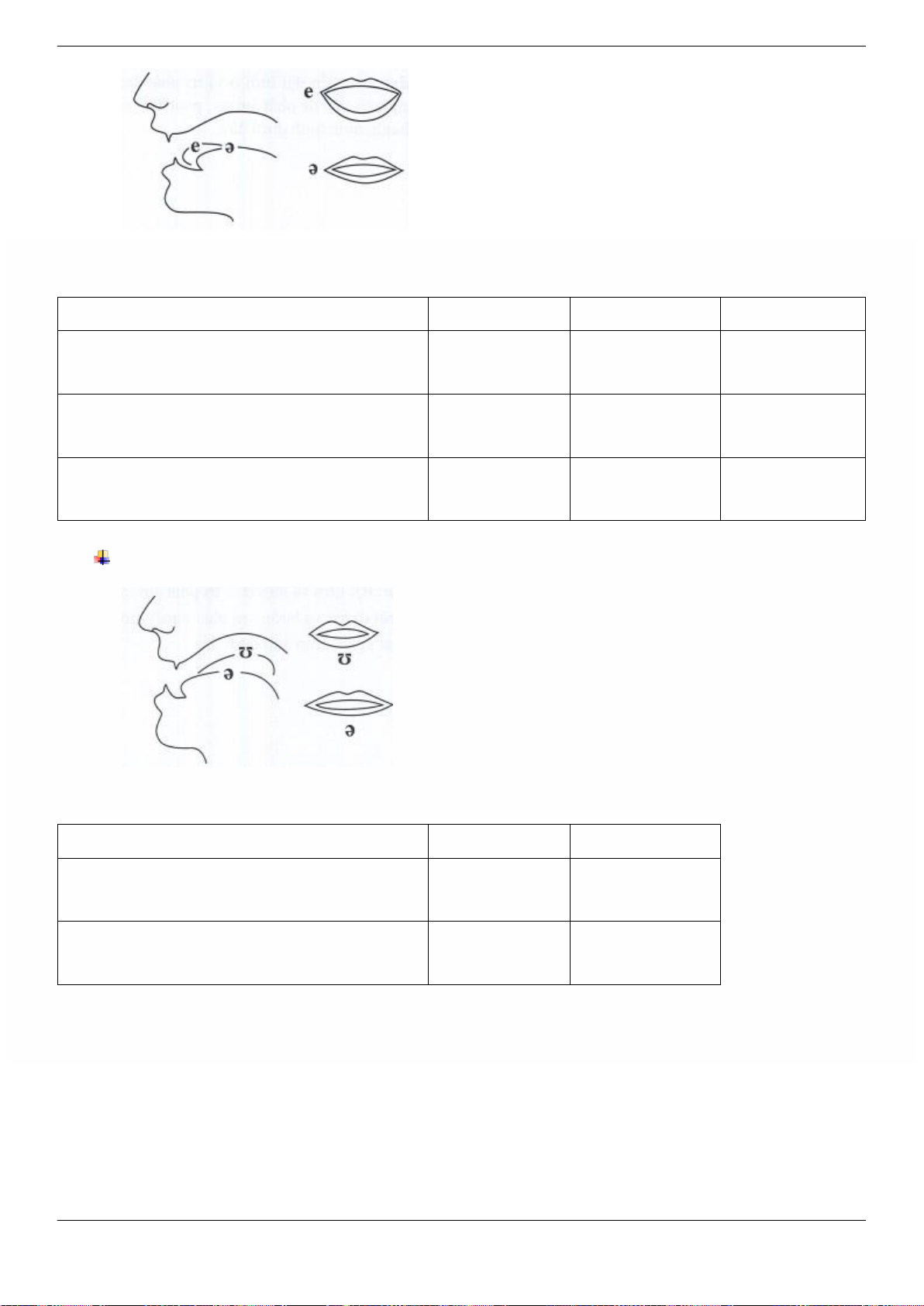
Trang 33
Cách phát âm: /e/
ra
LƯU Ý:
QUY TẮC
VÍ DỤ
PHIÊN ÂM
Ngoại lệ
EA eə/
Bear
Wear
A
cùng là -ARE eə/
Care
Fare
Are /a:(r)/
AI R
phát âm là /eə/
Air
Dairy
NGUYÊN ÂM /ʊə/
Cách phát âm: phát âm âm // dài mt chút và sau
nâng lên trên và ra phía sau nên âm âm
Các nhóm chữ được phát âm là /ʊə/.
QUY TẮC
VÍ DỤ
PHIÊN ÂM
OO /ʊə/
Poor
Spoor
OU /ʊə/.
Tourist
Tournament
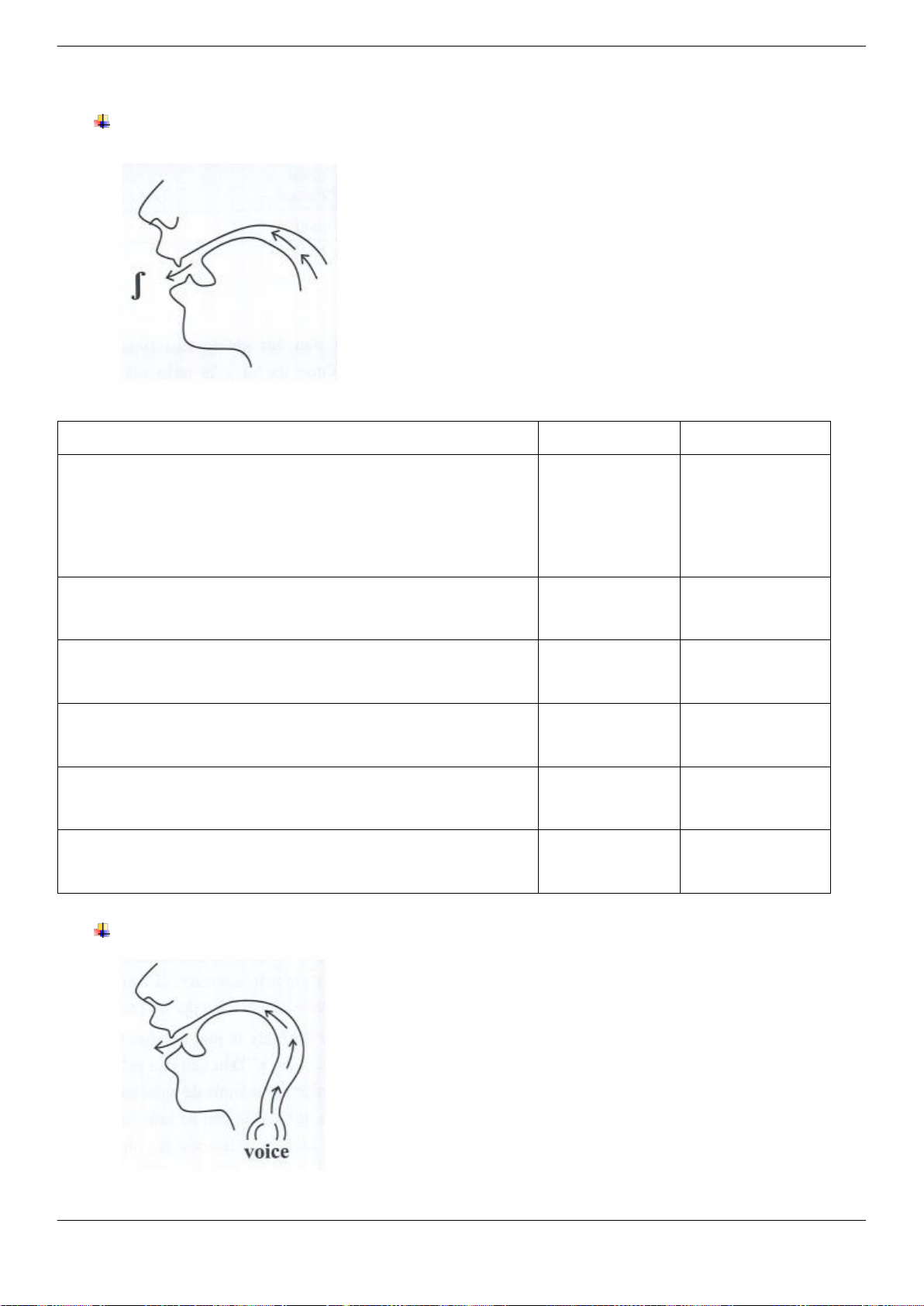
Trang 34
UNIT 3: CÁC PHỤ ÂM ĐẶC BIỆT TRONG TIẾNG ANH HỌC SINH VIỆT NAM HAY MẮC LỖI
PHỤ ÂM /ʃ/
Các nhóm chữ cái được phát âm là /ʃ/.
Đặc tính:
(blade-aveolar), âm xát (fricative).
Cách phát âm:
vòm
qua.
PHỤ ÂM
VÍ DỤ
PHIÊN ÂM
C /ʃ/ ia, ie, io, iu, ea
Special
Ancient
Conscious
Ocean
C phát âm là /ʃ/
Ensure
Tension
T phát âm là /ʃ/ ia,
io
Nation
Intention
X /kʃ/
Anxious
Luxury
CH /ʃ/
Machine
Champagne
SH /ʃ/
Shake
Sheet
PHỤ ÂM /ʒ/
Đặc tính:
(blade-aveolar), âm xát (fricative).
Cách phát âm: cách
Các nhóm chữ cái được phát âm là /ʒ/.
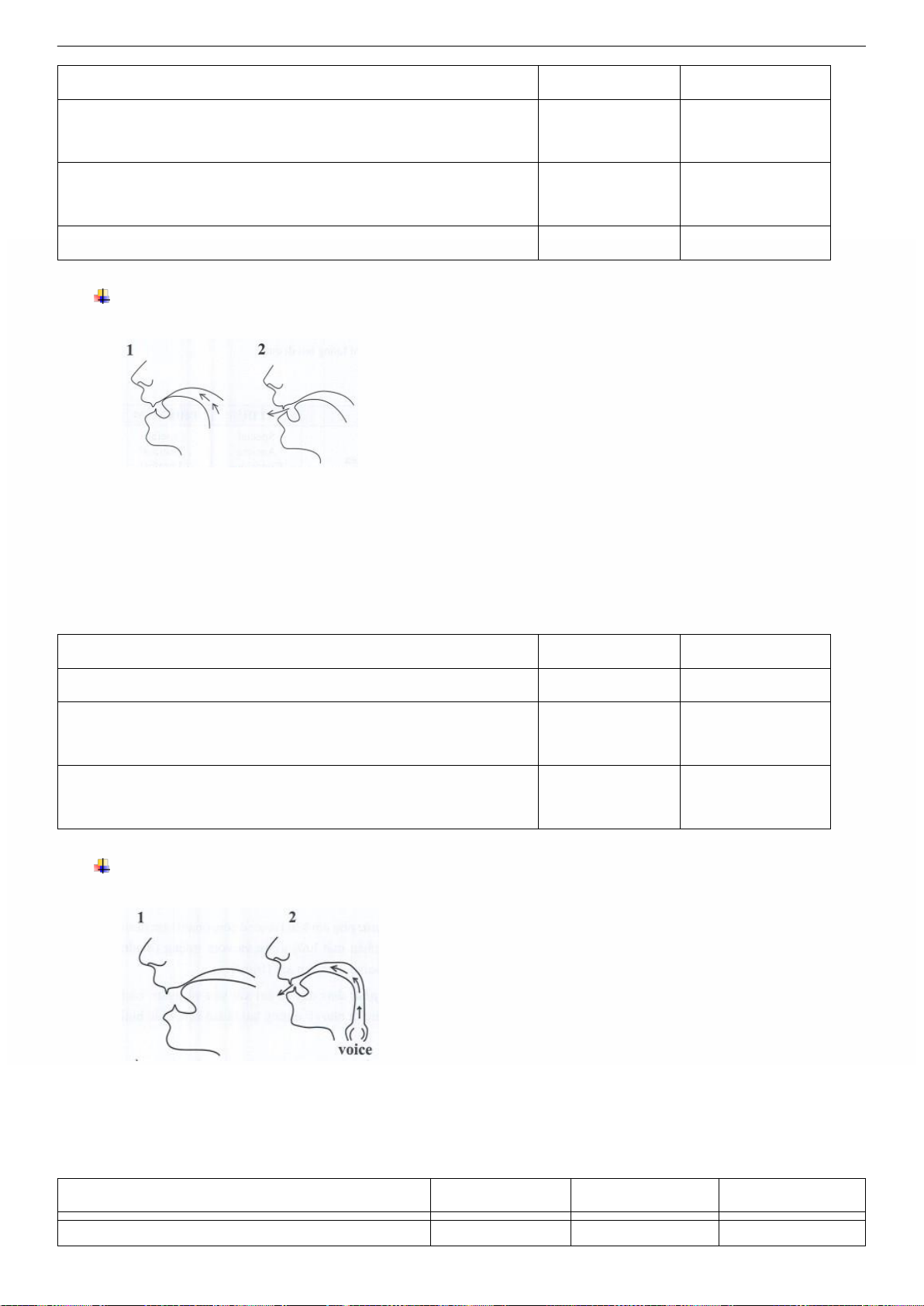
Trang 35
PHỤ ÂM
VÍ DỤ
PHIÊN ÂM
G /ʒ/
Massage
Collage
S /ʒ/
u, ia, io
Usual
Pleasure
T /ʒ/
Equation
PHỤ ÂM /tʃ/
Các nhóm chữ cái được phát âm là /tʃ/.
Đặc tính:
(blade/front-paloto-
Cách phát âm: /t/
hình
PHỤ ÂM
VÍ DỤ
PHIÊN ÂM
C /tʃ/
Cello
Tphát âm là /tʃ/
Century
Natural
CH /tʃ/
Chicken
Chimney
PHỤ ÂM /dʒ/
Các nhóm chữ cái được phát âm là /dʒ/.
Đặc tính:
(blade/front-paloto- (africative).
Cách phát âm:
sa
PHỤ ÂM
VÍ DỤ
PHIÊN ÂM
NGOẠI LỆ
/dʒ/
Soldier
Get /get/
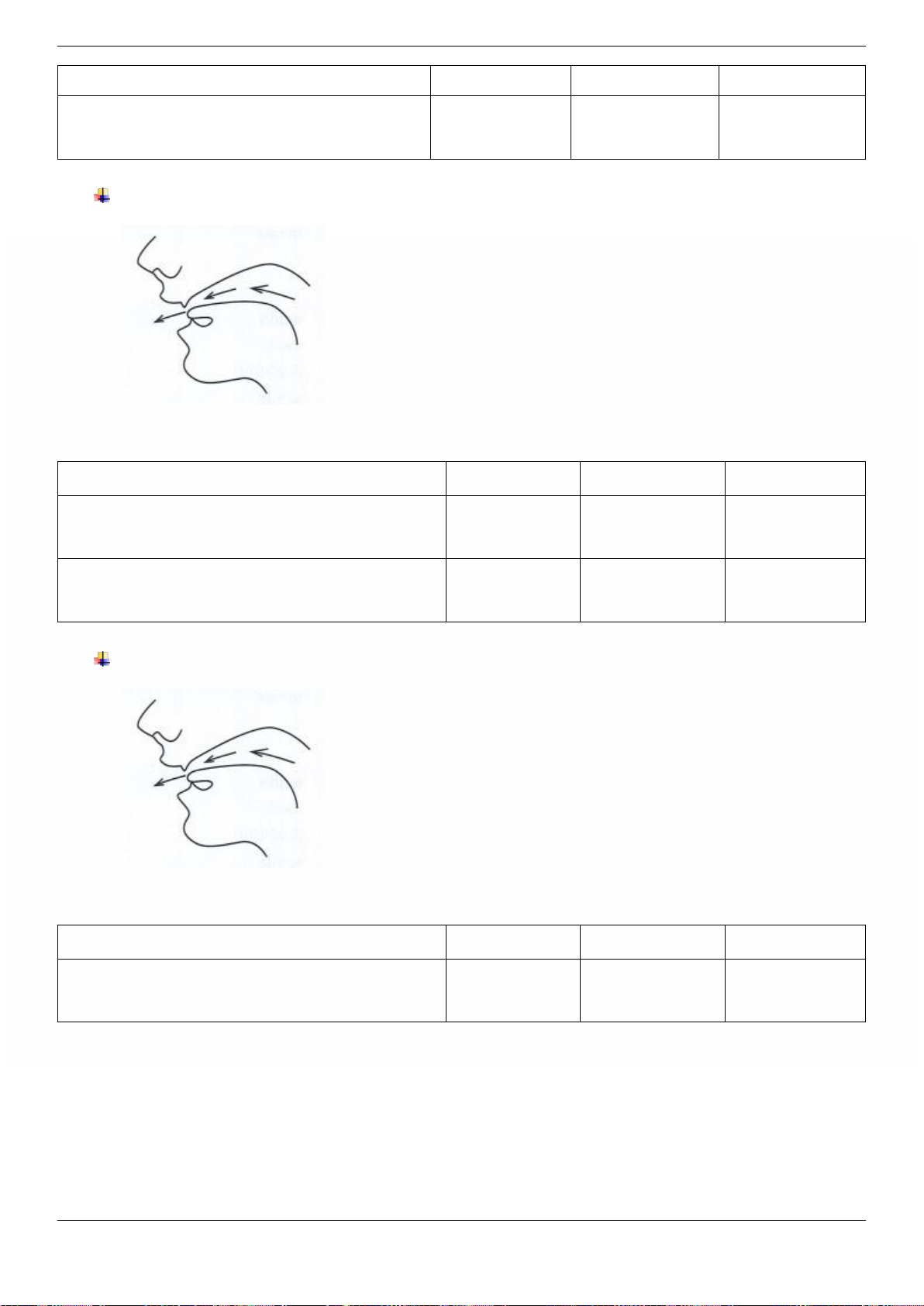
Trang 36
Schedule
Gesse /gi:s/
G /dʒ/ e, i, y và
Village
Geology
PHỤ ÂM /θ/
Đặc tính:
-
Cách phát âm: i gi
Các nhóm chữ cái được phát âm là /θ/.
PHỤ ÂM
VÍ DỤ
PHIÊN ÂM
NGOẠI LỆ
/θ/ khi:
-
Think
Thing
Khi TH
Width
Depth
PHỤ ÂM /ð/
Đặc tính:
-
Cách phát âm:
Các nhóm chữ cái được phát âm là /ð/.
PHỤ ÂM
VÍ DỤ
PHIÊN ÂM
NGOẠI LỆ
/ð/
They
Smooth

Trang 37

Trang 38
UNIT 4: ÂM CÂM TRONG TIẾNG ANH
âm.
Chữ cái A câm - ...ally
musically logically dramatically marriage
head bread deaf meant
board
Chữ cái B câm - mb, bt
climb
crumb
dumb
numb
plumb
thumb
comb
tomb
lamb
limb
doubt
doubtful
plumber
bomb
debt
subtle
Chữ cái C câm - sc-
muscle
scissors
scene
scent
science
Chữ cái D câm
acquaintance
badge
edge, hedge
handkerchief Wednesday
handsome
grandson
landscape
sandwich
Windsor
Chữ cái E câm - ...e.
make
hope
love
code
stage
fate
site
rite
write
drive
gave
more
bridge
vehicle
fame
serve
clue
asked
phoned
hoped
careful
lonely
every
evening
perhaps
literature
interesting
Chữ cái G câm - gn, gh (t)
champagne
foreign
foreigner
sign
sigh
feign
reign
resign
design
gnome
gnat
gnaw
gnu
high
thought
through
weigh
daughter
light
might
right
fight
night
ought
taught
Chữ cái H câm - wh
what
when
where
whether
why
which
while
hour

Trang 39
honest
honour
heir
herb
ghost
white
heir
Thames

Trang 40
Birmingham
might
exhibition
exhausting
khaki
cheetah
Sarah
Messiah
vehicle
vehement
rhino
rhyme
rhubarb
rhythm
chemistry
Chữ cái I câm
parliament
business
fashion
cushion
Chữ cái K câm - kn....
knife
knight
knickers
knee
know
knock
knot
knob
knit
knee
knowledge
knuckle
knick-knack
Chữ cái L câm -l+m/d/f/k
calm
palm
half
calf
salmon
almond
talk
balk
walk
folk
yolk
would
could
should
Chữ cái M câm
mnemonic
Chữ cái N câm - mn
autumn hymn column damn
chimney government
Chữ cái O câm
leopard jeopardy
Chữ cái P câm - ps, pn
psychiatrist pneumonia psychotherapy psychotic
psalm psalter pshaw pseudo
receipt Thompson raspberry
Chữ cái R câm - r+con,r.
diarrhoea card
Chữ cái S câm - si
island isle aisle
Chữ cái T câm
Christmas
fasten
soften
often
listen
match
scratch
butcher
witch
whistle
thistle
castle
ballet
thistle
tsunami
asthma
Chữ cái U câm - gu, u+vowel
guess
guest
guide
guitar

Trang 41
guest
guard
building
biscuit
tongue
dialogue
colleague
catalogue

Trang 42
Chữ cái W câm - wr, wh-
wrap
wreck
wrestling
write
writing
wrist
wrinkle
wrong
two
who
whose
whom
whole
whore
sword
answer
Chữ cái X, Y câm
faux pas
Sioux
mayor
Chữ cái Z câm
rendezvous
chez
laissez-faire

Trang 43
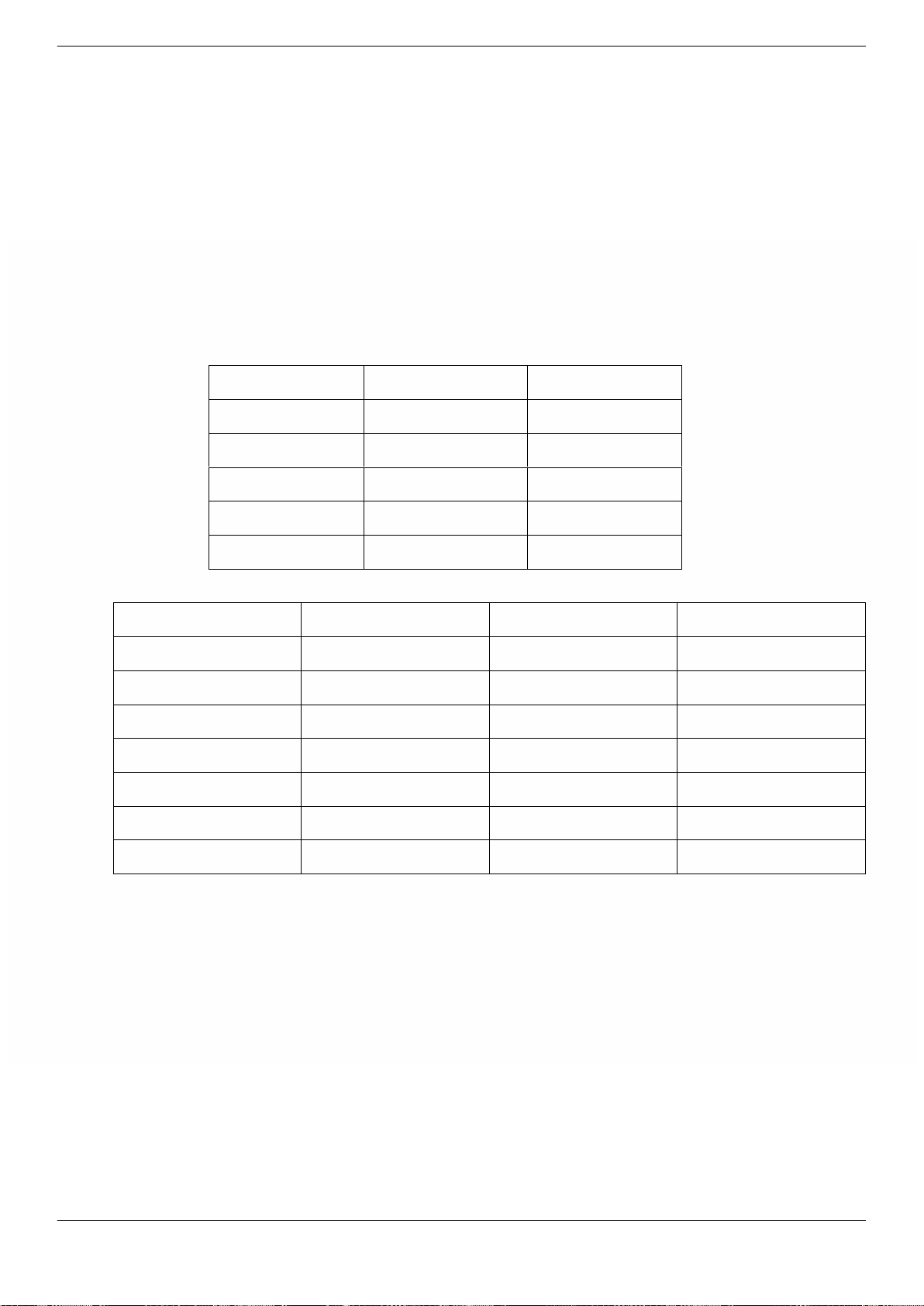
Trang 44
UNIT 5: CÁCH PHÁT ÂM ĐUÔI “ED”
A. Phát âm là /t/ : /p/, /f/, /k/, /s/, /∫/, /t∫/
B. Phát âm là /id/ d /t/.
C. Phát âm là /d/ âm.
LƯU Ý:
Xét âm
faxxslikee
/k/.
/id/
/t/
/d/
- dedicated
- stopped
- opened
- devoted
- laughed
- arrived
- pretended
- liked
- discovered
- needed
- washed
- interviewed
- mended
- sentenced
- played
ed-
Naked
ɪd/
Blessed
/blesɪd/
Learned
ɪd/
Dogged
ɪd/
Beloved
ɪd/
Crooked
ɪd/
Aged
ɪd/
Ragged
ɪd/
Sacred
ɪd/
Rugged
ɪd/
Wicked
ɪd/
Cursed
ɪd/
Three-legged
ɪd/
Wretched
ɪd/
Supposedly
ɪdli/

Trang 45

Trang 46
UNIT 6: CÁCH PHÁT ÂM ĐUÔI “-S/ -ES”
A. Phát âm là /s/ /θ/, /p/, /k/, /f/, /t/.
Cách dễ nhớ là phụ âm đầu trong câu tiếng Việt sau: θời phong kiến fương tây
B. Phát âm là /z/ âm.
C. Phát âm là /iz/ -s, -ss, -ch, -sh, -x, -z (hoặc -ze), -ge, -
ce
izSang Sung S
ZCHXe SH.
LƯU Ý:
Xét âm
Exlaughghla:f/ - f/ nên khi
s là /sz/.
/s/
/iz/
/z/
s/
ɪz/
z/
s/
ɪz/
z/
s/
ɪz/
z/
s/
ɪz/
z/
s/
ɪz/
z/
ɪz/
ɪz/
ɪz/
Sự thay đổi cách phát âm ở một số từ khi thêm “s” hoặc “es”, thêm một trường hợp là:
Say /sei/
says /sez/
Do /du:/
does /dʌz/
House s/
ziz/
Go ʊ/
ʊz/
BÀI TẬP LUYỆN TẬP PHẦN NGỮ ÂM
Exercise 1: Choose the word which has the underlined part pronounced differently from the
others.
1. A. pump
B. stupid
C. sum
D. sun
2. A. shark
B. large
C. math
D. park
3. A. stream
B. head
C. heavy
D. ready
4. A. passenger
B. several
C. begin
D. repair
5. A. send
B. bed
C. pen
D. severe
6. A. husband
B. another
C. traffic
D. mature
7. A. tragic
B. humane
C. ambitious
D. background

Trang 47
8. A. chemistry
9. A. shot
B. degree
B. short
C. receive
C. talk
D. prepare
D. warn
10. A. lead
B. deed
C. dead
D. read
11. A. robber
B. rob
C. drop
D. sport
12. A. read
B. deep
C. seat
D. keen
13. A. course
B. force
C. proper
D. talk
14. A. job
B. geography
C. follow
D. develop
15. A. second
B. police
C. wonder
D. compare
16. A. know
B. town
C. flower
D. cow
17. A. eradicate
B. astronaut
C. standard
D. fatal
18. A. bowl
B. sorrow
C. low
D. how
19. A. ought
B. group
C. soup
D. through
20. A. popularize
B. wild
C. climb
D. magazine
Exrcise 2: Choose the word which has the underlined part pronounced differently from the others.
1. A. floor
B. cartoon
C. door
D. corner
2. A. burn
B. shirt
C. answer
D. working
3. A. dominate
B. biology
C. college
D. atmosphere
4. A. education
B. way
C. documentary
D. stay
5. A. health
B. speak
C. each
D. seat
6. A. already
B. want
C. awful
D. although
7. A. allow
B. however
C. power
D. flow
8. A. officer
B. anger
C. chapter
D. fertilize
9. A. personal
B. matter
C.persuade
D. oversea
10. A. choice
B. coincide
C.join
D. voice
11. A. deny
B. rely
C. happy
D. supply
12. A. mail
B. paint
C. rain
D. said
13. A. button
B. funny
C. circus
D. husband
14. A. connector
B. inventor
C. visitor
D. work
15. A. above
B. globe
C. glove
D. love
16. A. above
B. son
C. wonderful
D. convenience
17. A. package
B. marvel
C. lastly
D. farther
18. A. card
B. hard
C. warm
D. mark
19. A. heat
B. head
C. meet
D. field
20. A. cheese
B. feed
C. beer
D. asleep
Exercise 3: Choose the word which has the underlined part pronounced differently from the others.
1. A. satisfaction B. facsimile C. punctuality D. spacious
2. A. subscribe
B. noisy
C. graphics
D. service

Trang 48
3. A. transfer
B. newspaper
C. thousand
D. relatives

Trang 49
4. A. stop
B. post
C. offer
D. from
5. A. transferred
B. delivered
C. equipped
D. received
6. A. helps
B. texts
C. documents
D. provides
7. A. busy
B. swim
C. spacious
D. post
8. A. best
B. text
C. exist
D. letter
9. A. communication
B. distribution
C. commune
D. punctuality
10. A. recipient
B. express
C. messenger
D. secure
11. A. meat
B. dead
C. heat
D. scream
12. A. east
B. teacher
C. Breakfast
D. please
13. A. something
B. other
C. through
D. thrilling
14. A. will
B. going
C. idea
D. trip
15. A. face
B. place
C. prepared
D. days
16. A. garden
B. Germany
C. gate
D. gas
17. A. school
B. Christ
C. scholarship
D. chicken
18. A. hour
B. harm
C. house
D. husband
19. A. heat
B. however
C. exhausted
D. hundred
20. A. weather
B. mean
C. head
D. ready
Exercise 5: Circle the word which has the underlined part pronounced as:
1. /s/
A. chores
B. brothers
C. shifts
2. /z/
A. halves
B. dates
C. kits
3. /s/
A. speaks
B. bags
C. days
4. /s/
A. activities
B. parents
C. teelings
5. /z/
A. pets
B. loves
C. laughs
6. /s/
A. photographs
B. stays
C. questions
7. /z/
A. weekends
B. bats
C. months
8. /iz/
A. problems
B. shares
C. produces
9. /iz/
A. physics
B. sandwiches
C. nights
10. /iz/
A. jobs
B. joins
C. judges
Exrcise 6: Choose the word which has the underlined part pronounced differently from the others.
1. A. question
B. mention
C. motion
D. fiction
2. A. again
B. gather
C. good
D. large
3. A. children
B. machine
C. church
D. change
4. A. written
B. writing
C. write
D. writer
5. A. rare
B. are
C. declare
D. share
6. A. university
B. identity
C. apply
D. early
7. A. chemistry
B. choice
C. each
D. achieve
8. A. choir
B. cheap
C. child
D. chair

Trang 50
9. A. champagne
B. teacher
C. child
D. charge

Trang 51
10. A. each
11. A. against
12. A. psychology
13. A. variety
B. clear
B. maneuver
B. activity
B. exercise
C. reason
C. aquatic
C. carry
C. diving
D. Mean
D. integral
D. synchronized
D. physics
14. A. water
B. throwing
C. swimming
D. switch
15. A. movement
B. improve
C. lose
D. oppose
16. A. uniform
B. curriculum
C. universal
D. university
17. A. garage
B. paperwork
C. stationery
D. vacancy
18. A. match
B. chair
C. church
D. character
19. A. habitat
B. campus
C. danger
D. cactus
20. A. question
B. celebration
C. education
D. collection
Exercise 7: Choose the word which has the underlined part pronounced differently from the others.
1. A. female
2. A. civilization
B. women
B. discriminated
C. legal
C. enlightenment
D. equal
D. recognition
3. A. struggle
B. public
C. cultural
D. human
4. A. civilization
B. century
D. society
D. culture
5. A. doubt
B. establish
C. public
D. basic
6. A. won
B. gone
C. none
D. son
7. A. bear
B. hear
C. tear (v)
D. pear
8. A. comfortable
B. come
C. some
D. comb
9. A. transfer
B. station
C. cable
D. stable
10. A. hit
B. sting
C. bite
D. ship
11. A. summer
B. include
C. instruction
D. compulsory
12. A. healthy
B. grocery
C. nearby
D. energy
13. A. mount
B. country
C. ground
D. found
14. A. good
B. book
C. foot
D. school
15. A. seat
B. beat
C. creature
D. widespread
16. A. intellectual
B. natural
C. righteous
D. potential.
17. A. symbol
B. emergency
C. poverty
D. qualify
18. A. promise
B. realise
C. surprise
D. devise
19. A. delicate
B. celebrate
C. private
D. communicate
20. A. foot
B. wood
C. flood
D. book
Exercise 8: Choose the word underlined that are pronounced differently from the others.
1. A. neighbors
B. friends
C. relatives
D. photographs
2. A. snacks
B. follows
C. titles
D. writers
3. A. streets
B. phones
C. books
D. makes
4. A. cities
B. satellites
C. series
D. workers

Trang 52
5. A. develops
B. takes.
C. laughs
D. volumes

Trang 53
6. A. explains
B. wakes
C. phones.
D. names
7. A. phones
B. streets
C. books
D. makes
8. A. proofs
B. regions
C. lifts
D. rocks
9. A. involves
B. believes
C. suggests
D. steals
10. A. serves
B. blocks
C. banks
D. tourists
11. A. remembers
B. cooks
C. walls
D. pyramids
12. A. miles
B. words
C. accidents
D. names
13. A. sports
B. plays
C. households.
D. minds
14. A. makes
B. views
C. reads
D. decides
15. A. albums
B. tanks
C. shops
D. plants
16. A. gets
B. loves
C. sings
D. buys
17. A. collects
B. cooks
C. swims
D. claps
18. A. stamps
B. friends
C. relatives
D. guitars
19. A. envelops
B. tunes
C. books
D. guitarists
20. A. athletics
B. participants
C. efforts
D. skills
Exercisc 9: Silent letters
1. Which word do you not pronounce one consonant?
A. pencil B. window C. paint D. pink
2. Choose the word which has the underlined part pronounced differently from the rest.
A. kind B. phone C. known D. column
3. Which word you do not pronounce one consonant?
A. hundred B. green C. brown D. white
4. Choose ONE word that HAS silent letter B?
A. boy B. book C. lamb D. boat
5 Which word you do not pronounce one consonant?
A. science B. cave C. wall D. like
6. Which letter is silent in the word MORTGAGE?
A. E B. R C.T D.G
7. Which consonant is silent in the word KNOWLEDGE?
A. K B.N C. G D. O
8. Choose ONE word that HAS silent letter D.
A. Window B. Wednesday D. Midnight
9. Choose the word which has the underlined part pronounced differently from the rest.
A. kneel B. knock C. know D. kite
10. Pick out the word which has the underlined part pronounced differently from the rest.
A. home B. hand C. holiday D. honor
11. Pick out the word whose underlined part is pronounced differently from that of the other words.
A. pneumonia B. piece C. page D. cup
12. Choose the word which has the underlined part pronounced differently from the rest.

Trang 54
A. half B. colourful C. label D. chemical
13 Choose the word which has the underlined part pronounced differently from the rest.
A. hat B. ten C. cat D. whistle
14. Choose the letters which is NOT pronounced in the word VEHICLE.
A. V B. E C. H D. E
15. Choose the word which has the underlined part pronounced differently from the rest.
A. kind B. autumn C. known D. phone
16. Which letter is silent in the word ANSWER?
A. W B. E C. N D. S
17. Choose the word which has the underlined part pronounced differently from the rest.
A. girl B. sign C. go D. got
18. Choose the word which has the underlined part pronounced differently from the rest.
A. thumb B. lamb C. blue D. bomb
19. Choose the word whose underlined part is pronounced different from the others
A half B. milk C. folk D. walk
20. Choose the word whose underlined part is pronounced different from the others
A. knight B. know C. kilogram D. knife
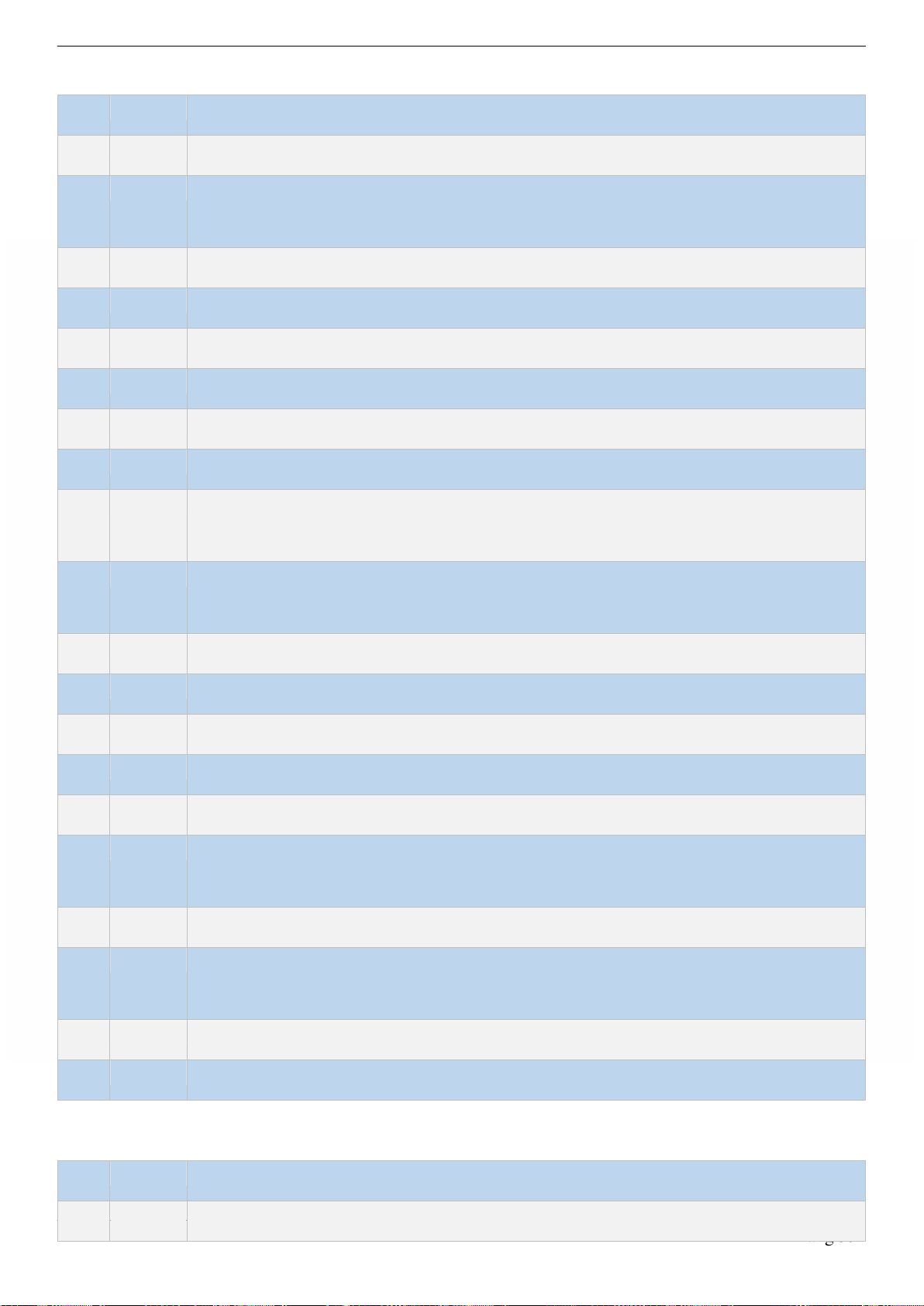
Trang 55
Exercise 1:
Câu
Đáp án
Giải thích
1.
B
“U” “U”
2.
C
“AR” maths /ae/, “AR”
3.
A
“EA” stream “EA”
4.
B
“E” severals “E”
5.
D
“E” severe “E”
6.
C
“A” traffic “A”
7.
B
“A” humance “A”
8.
A
“E” chemistry “E”
9.
A
“O” shot talk, short và warn
10.
B
“EE” deed lead, dead và read (quá khứ)
11.
D
“O” sport
12.
A
“EA” read
13.
C
“O” course
14.
D
“O” develop “O”
15.
C
“O” wonder //, “O”
16.
A
“OW” know “OW”
17.
D
“A” fatal “A”
18.
D
“OW” how “OW”
19.
A
“OU” ought “OU”
20.
D
“I” magazine “I” /.
Exercise 2:
Câu
Đáp án
Giải thích
1.
B
“OO” cartoon “OO”

Trang 56
2.
C
“ER” answer “ER”
3.
D
“O” atmosphere “O”
4.
C
“A” documentary “A”
/ei/.
5.
A
“EA” healthy “EA”
/i:/.
6.
B
“A” want “A”
7.
D
“OW” flow “OW”
8.
D
“ER” fertilize “ER”
9.
A
“ER” personal “ER” là
10.
B
“OI” coincide “OI” là
11.
C
“Y” happy “Y”
12.
D
“AI” said “AI”
13.
C
“U” circus “U” //.
14.
D
“OR” work “OR”
15.
B
“O” globe O”
16.
D
“O” convenience “O”
17.
A
“A” package /.“A”
18.
C
“AR” warm :/. “AR”
19.
B
“EA” head “EA” /i:/.
20.
C
“EE” trong từ beer “EE”
Exercise 3:
Câu
Đáp án
Giải thích
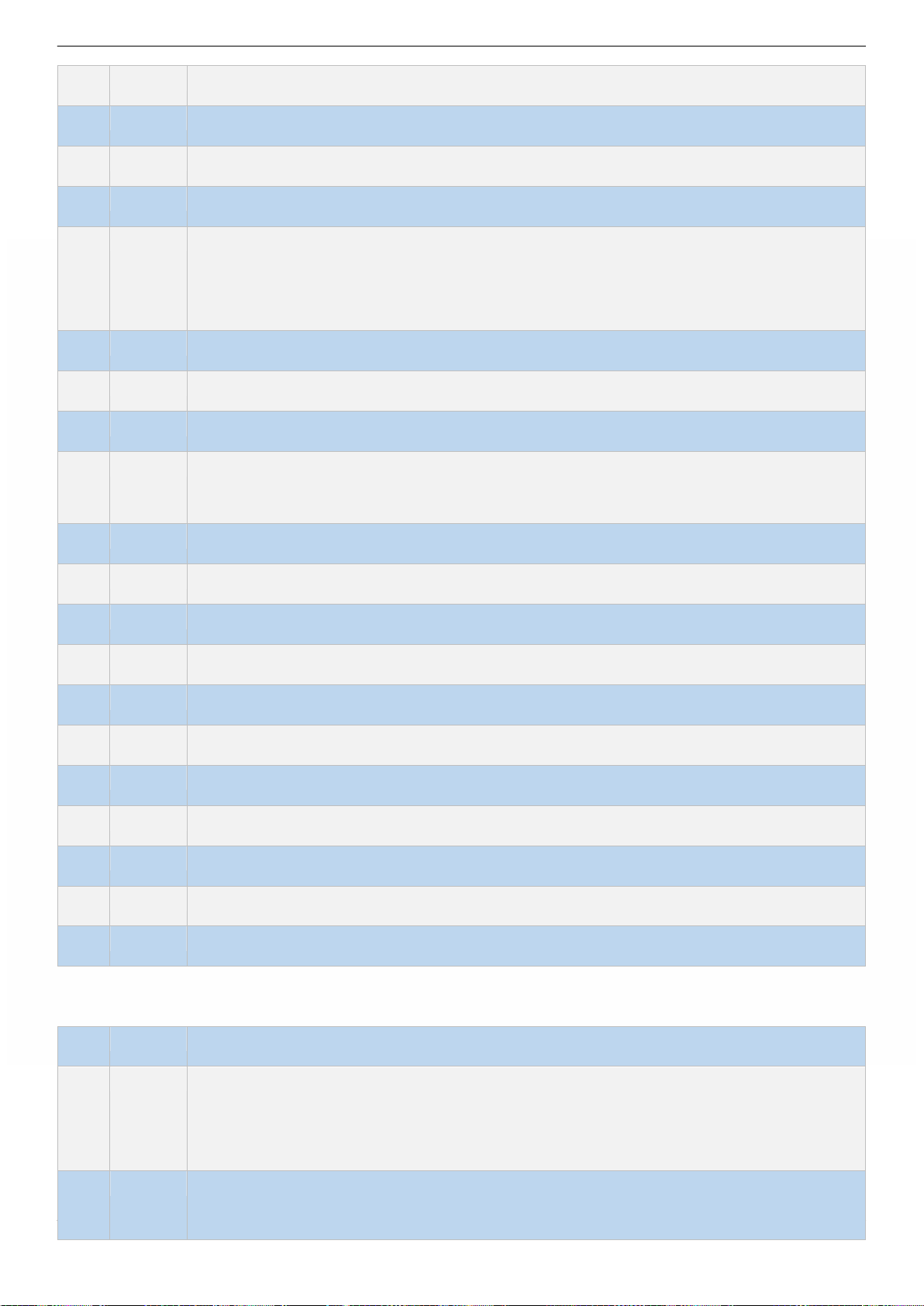
Trang 57
1.
D
“A” spacious “A”
2.
B
“S” noisy “S”
3.
A
“S” transfer “S” /z/.
4.
B
“O” post “O”
5.
C
6.
D
“S” provides “S”
7.
A
“S” busy “S”
8.
C
“E” exist “E”
9.
D
“U” punctuality //, “U
/ju:/.
10.
B
“E” express “E”
11.
B
“EA” dead “EA”
12.
C
“EA” breakfast /e/,“EA”
13.
B
“TH” othe“TH”
14.
C
I” idea “I”
15.
C
“A” prepare“A"
16.
B
“G” “G”
17.
D
“CH” chicken “CH
18.
A
“H” trong từ hour là âm câm, “H”
19.
C
“H” exhausted “H”
20.
B
“EA” mean “I”
Exercise 4:
Câu
Đáp án
Giải thích
1.
C
2.
B
có âm là /1/ là âm thanh, khi thêm ta phát âm
là âm thanh /d/, trong các còn có âm là /t/ và /d/ khi thêm ta

Trang 58
3.
D
4.
A
/t/
5.
C
ed
t
/d/.
6.
A
-sseses
esesz
7.
D
8.
A
tss/,
là /z/.
9.
B
ies
s
10.
D
s
11.
B
edt/.
ededɪd/
12.
D
eded
khác /tededt/.
13.
A
/p/ “ed” ta phát âm “ed” là
/t
ededd/.
14.
B
/v/ “ed” ta phát âm “ed”
là /d/. /t/ /d/, khi thêm “ed” ta phát
âm “ed” là
15.
C
seded
là /ttdeded

Trang 59
16.
A
eded
là /t
eded /d/.
17.
C
seded
/t
ededd/.
18.
B
/z/ “ed” ta phát âm “ed”
là /d/. (khác /V), khi thêm “ed” ta
phát âm “ed” là /t/.
19.
C
/d/, khi thêm “ed” ta phát âm “ed”
(khác /t/), khi thêm “ed” ta phát âm “ed” là /t/.
20.
B
/d/, khi thêm “ed” ta phát âm “ed”
(khác /t/), khi thêm “ed” ta phát âm “ed” là /t/.
Exercise 5:
Câu
Đáp án
Giải thích
1.
C
ts/.
z/.
2.
A
z/.
s/.
3.
A
ks/.
z/.
4.
B
ts/.
z/.
5.
A
vz/. Các
s/.
6.
A
/f /
z/.
7.
A
dz/. Các
/s/.
8.
C
-ceiz

Trang 60
z/.
9.
B
“-ch”, /iz/.
s/.
10.
C
-geiz âm
z/.
Exercise 6:
Câu
Đáp án
Giải thích
1.
A
“T” question “T”
2.
D
“G” large “G”
3.
B
“CH” machine “CH”
4.
A
“I” written “I”
5.
B
“ARE” are a:(r)/, “ARE”
6.
C
“Y” apply “Y”
7.
A
“CH” chemistry “CH” âm
8.
A
“CH” choir “CH”
9.
A
“CH” champagne “CH”
10.
B
“EA” clear “EA”
11.
C
“A” aquatic “A”
12.
A
“Y” psychology “T”
13.
D
“I” physics “I”
14.
B
“W” throwing “W”
/w/.
15.
D
“O” oppose “O”
16.
B
“U” curriculum “U”
/ju:/.

Trang 61
17.
A
“A” garage “A”

Trang 62
18.
D
“CH” character “CH” âm
19.
C
“A” danger “A” /æ/.
20.
A
“TION” question “TION”
Exercise 5:
Câu
Đáp án
Giải thích
1.
B
“I” women “I”
2.
C
“I” enlightenment “I”
3.
D
“U” human “U” //.
4.
D
“C” culture “C”
5.
A
“B” doubt “B”
6.
B
“O” gone “O” //.
7.
B
“EA” hear “EA”
8.
D
“O” comb “O” //.
9.
A
“A” transfer “A”
10.
C
“I” bite “I”
11.
B
“U” include “U” //.
12.
C
“Y” nearby “Y”
13.
B
“OU” country //. “OU”
14.
D
“OO” school “I”
15.
D
“EA” widespread /e/. “EA”
là /i:/.
16.
D
“T” potential “T”
17.
D
“Y” qualify “Y”
18.
A
“ISE” promise “ISE”

Trang 63
19.
C
“ATE” widespread “ATE”
20.
C
“OO” flood //. “OO”
Exercise 8:
Câu
Đáp án
Giải thích
1.
D
/f/ /s/.
/z/.
2.
A
/k/ s/. Các
z/.
3.
B
/n/ /z/.
/s/.
4.
B
s/.
/z/.
5.
D
z/.
/s/.
6.
B
/k/ /s/. Các
z/.
7.
A
/n/ /z/.
/s/.
8.
B
nz/.
s/.
9.
C
/t/ /s/.
z/.
10.
A
/v/ /z/. Các
s/.
11.
B
/k/ /s/. Các
z/.
12.
C
ts/.
z/.
13.
A
/t/ s/. Các
z/.
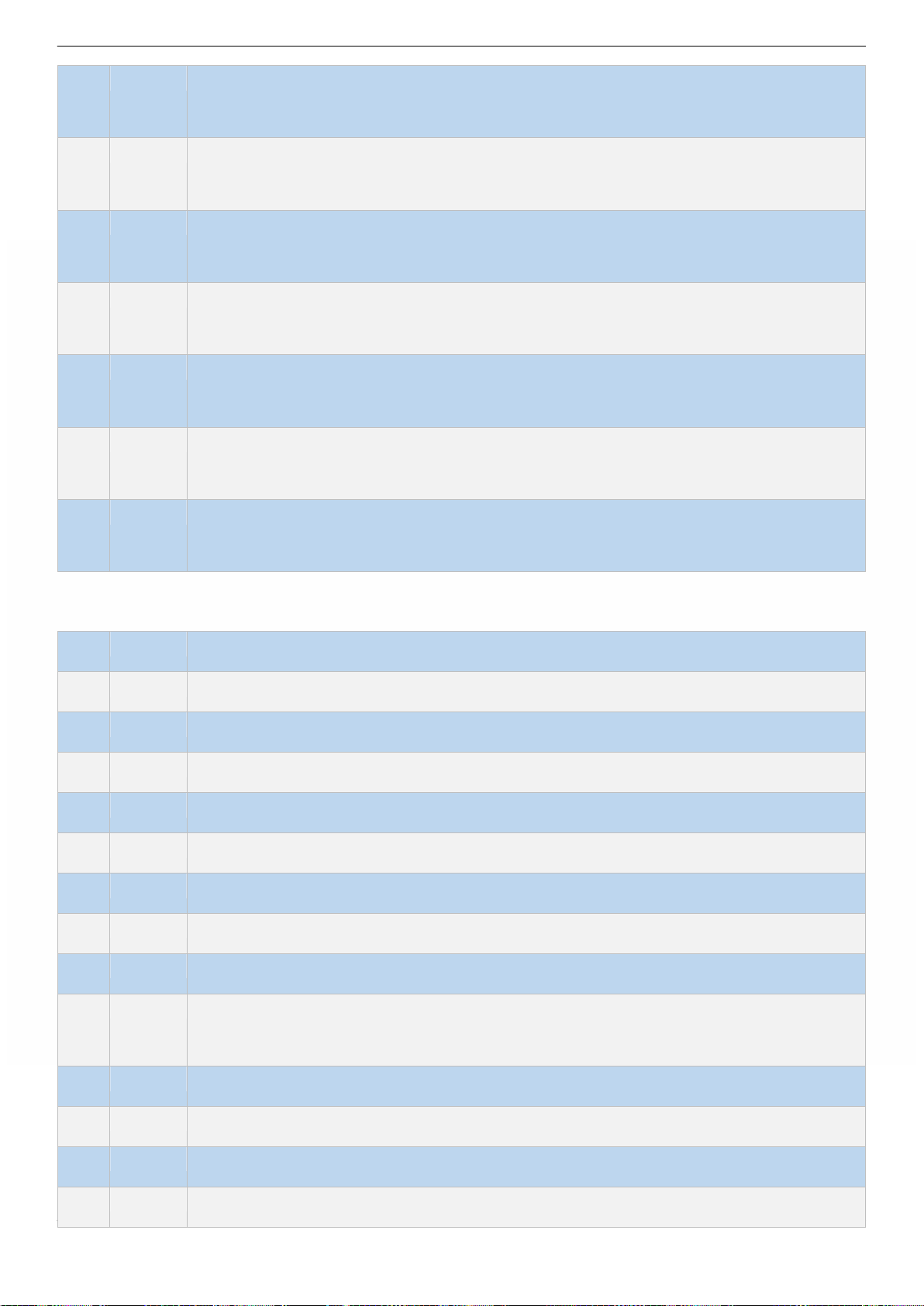
Trang 64
14.
A
/k/ s/. Các
z/.
15.
A
mz/.
/s/.
16.
A
t/s/.
còn lại có z/.
17.
C
mz/.
s/.
18.
A
ps/. Các
z/.
19.
B
nz/. Các
s/.
20.
D
lz/. Các
s/.
Exercise 9:
Câu
Đáp án
Giải thích
1.
B
“W”
2.
D
“N” column
3.
C
“W”
4.
C
“B” lamb
5.
A
“C” science
6.
C
“T” mortgate
7.
A
“K” knowledge
8.
B
“D” Wednesday
9.
D
“K” kite - kneel, knock, và know thì
“K”
10.
D
“H” honor
11.
A
“P” pneumonia
12.
A
“L” half
13.
D
“T” whistle

Trang 65
14.
C
“H” vehicle
15.
B
“N” autumn
16.
A
“W” answer
17.
B
“G” sign
18.
C
“B” trong từ Blue - “B” L
19.
B
“L” milk - /milk/, “L”
20.
C
“K” kilogram - “K”
ĐỀ THAM KHẢO KỲ THI THPTQG – ĐỀ THI SỐ 1
Mark the letter A, B, c or D on your answer sheet to indicate the sentence that is closest in meaning
to each of the following questions.
Question 1.
consistent for years.
A The standard of education is not high in this school, but at least all the students are at the same level.
B. Not only are the standards of education good in this school, but it has maintained those standards
over the years.
C.
years now.
D. The level of education in this school, which is usually quite high, shows only slight variations
from year to year.
Question 2. She tried very hard to pass the driving test. She could hardly pass it.
A. it.
B. No matter how hard she tried, she could hardly pass the driving test.
C. She tried very hard, so she passed the driving test satisfactorily.
D. it.
Question 3.
A. She ordered me to see a doctor if the sore throat did not clear up.
B. She insisted that I see a doctor unless the sore throat did not clear up.
C. She suggested that I see a doctor if the sore throat did not clear up.
D. She reminded me of seeing a doctor if the sore throat did not clear up.
Question 4.
A. essay.
B. She wrote a good essay as her teacher gave her some advice.
C. If her teach essay.

Trang 66
D. essay.
Question 5.
A. He had a birthday which his wife forgot.
B. was.
C. birthday.
D. His wife forgot her own birthday.
Mark the letter A, B, C or D on your answer sheet to indicate the word(s) CLOSEST in meaning
to the underlined word(s) in each of the following questions.
Question 6. think it twice.
A. to think it over B. to make it better
C. to make up for it D. to think out of time
Question 7. sted on listening to the entire
A. part B. funny C. whole D. interesting
Trang 1

Trang 67
Mark the letter A, B, C or D on your answer sheet to indicate the word(s) OPPOSITE in meaning
to the underlined word(s) in each of the following questions.
Question 8. The news has been greeted with dismay by local business leaders.
A. disappointment B. depression C. happiness D. pessimism
Question 9. Allow me to fill your glass.
A. remake B. empty C. refill D. repeat
Read the following passage and mark the letter A, B, C, or D on your answer sheet to indicate the
correct word or phrases that best fits each of the numbered blanks.
Most Americans eat three meals (10) the day: breakfast, lunch, and dinner. Breakfast begins
between 7:00 and 8:00am, lunch between 11:00 am and noon, and dinner between 6:00 and 8:00 pm. On
a (11) of breakfast and lunch, typically beginning at 11:00 am. Students
light meals, with only one course. Dinner is the main meal.
For breakfast Americans will eat cereal with milk which are often mixed (12) in a bowl, a
glass of orange juice, and toasted bread or muffin with jam, butter, or margarine. Another common
breakfast meal is scrambled eggs or an omelet with potatoes and breakfast meat (bacon or sausage).
People who are on a diet eat just a cup of yogurt. Lunch and dinner are more (13) . When eating at
a formal dinner, you may be overwhelmed by the number of utensils. How do you (14) the
difference between a salad fork, a butter fork, and a dessert fork? Most Americans do not know the
answer. But knowing which fork or spoon to use first is simple: use the outermost utensils first and the
utensils closest to the plate last.
Question 10.
A. in
B. say
C. on
D. during
Question 11.
A. addition
B. say
C. combination
D. attachment
Question 12.
A. each other
B. together
C. one another
D. others
Question 13.
A. vary
B. variety
C. varied
D. various
Question 14.
A. say
B. talk
C. speak
D. tell
Mark the letter A, B, C or D on your answer sheet to indicate the word w hose underlined part
differs from the other three in pronunciation in each of the following questions.
Question 15. A. condition
B. option
C. suggestion
D. relation
Question 16. A. acquaintance
B. acquire
C. admirable
D. arrival
Mark the letter A, B, C or D on your answer sheet to indicate the word that differs from the three in
the position of primary stress in each of the following questions.
Question 17. A. economics
B. regulation
C. individual
D. inspection
Question 18. A. evolution
B. comprehend
C. speculation
D. explosive
Mark the letter A, B, C or D on your answer sheet to indicate the correct answer to each of the following
questions.
Question 19. Tom looks so frightened and upset. He something terrible.
A. must experience B. can have experienced
C. should have experienced D. must have experienced

Trang 68
Trang 2

Trang 69
Question 20. The job requires certain . You have to be good at operating computers and
dealing with people.
A. qualifications B. knowledge C. techniques D. skills
Question 21. Hana and Jenifer are talking about a book they have just read.
-
- Jenifer:
love it so
you more it
Question 22. is the office of UNICEF Vietnam
A. leading B. head C. summit D. central
Question 23. He really deserved the award because he performed what was expected of him.
A. much better which B. the most that
C. much more as D. much better than
Question 24. If you less last night, you so bad today.
A. had drunk - would not have felt B. drank - would not felt
C. had drunk - would not feel it
Question 25. After his illness, Robert had to work hard to his classmates.
A. catch sight of B. keep pace with C. get in touch with D. make allowance for
Question 26. Do you know the woman who is wearing the ?
A. gold watch very old valuable B. very valuable old gold watch
C. old gold watch very valuable D. very old gold valuable watch
Question 27. The accident is believed 2 years ago.
A. to be investigated B. to have investigated
C. to investigate D. to have been investigated
Question 28. our children may be, we cannot go picnic in this weather
A. Though excited B. Excited as
C. Because of excitement D. Exciting
Question 29. It is essential that every student to learn English at university.
A. had B. have C. has D. to have
Question 30. We went away on holiday last week, but it rained .
A. every other day B. every single day C. every two days D. every second day
Question 31.1 felt over when I was riding and my sister had to a doctor.
A. call on B. bring C. take D. fetch
Question 32. Long lost his job no fault of his own.
A. through B. by C. it D. over
Question 33. that she stormed out of the house.
A. Such was angry girl B. So angry was she

Trang 70
C. She was angry so D. Her anger was so
Question 34. over long distances is a fact that everyone knows.
Trang 3

Trang 71
A. That electricity transmitting B. That electricity can be transmitted
C. That electricity D. That can be transmitted
Read the following passage and mark the letter A, B, C, or D on your answer sheet to indicate the
correct answer to each of the questions.
Stars have been significant features in the design of many United States coins and their number has
varied from one to forty-eight stars. Most of the coins issued from about 1799 to the early years of the
twentieth century bore thirteen stars representing the thirteen original colonies.
Curiously enough, the first American silver coins, issued in 1794, had fifteen stars because by that
time Vermont and Kentucky has joined the Union. At that time, it was apparently the intention of mint
officials to add a star for each new state. Following the admission of Tennessee in 1796, for example,
some varieties of half dimes, dimes, and half-dollars were produced with sixteen stars.
As more states were admitted to the Union, however, it quickly became apparent that this scheme
would not prove practical and the coins from A798 on were issued with only thirteen stars-one for each of
the original colonies. Due to an error at the mint, one variety of the A828 half cent was issued with only
twelve stars. There is also a variety of the large cent with only A2 stars, but this is the result of a die break
and is not a true error.
Question 35. What is the main topic of the passage?
A. Stars on American coins.
B. The teaching of astronomy in state universities
C. The star as national symbol of the United States.
D. Colonial stamps and coins.
Question 36. their refers to .
A. coins B. features C. colonies D. stars
Question 37. bore meaning to .
A. carried B. drilled C. symbolized D. cost
Question 38.
.
A. Silver coins with fifteen stars appeared before coins with thirteen.
B. Vermont and Kentucky joined the Union in 1794.
C. Tennessee was the first state to use half dimes.
D. No silver coins were issued until 1794.
Question 39. Which of the following can be inferred about the order in which Kentucky, Tennessee, and
Vermont joined the Union?
A. Vermont joined after Tennessee and Kentucky.
B. Kentucky joined before Tennessee and Vermont.
C. Tennessee joined Vermont and Kentucky.
D. Vermont and Kentucky joined at the same time.
Question 40. Why was a coin produced in 1828 with only twelve stars?
A. There was a change in design policy.
B. There were twelve states at the time.

Trang 72
Trang 4

Trang 73
C. The mint made a mistake.
D. Tennessee had left the Union.
Mark the letter A, B, C or D on your answer sheet to indicate the underlined part that needs
correction in each of the following questions.
Question 41. Alike (A) other forms of energy, natural gas may be used (B) to heat homes (C), cook
food, and even run (D) automobiles.
Question 42. The federal government recommends that (A) all expectant (B) women will avoid (C)
place where other people smoke (D).
Question 43. The United States come (A) top of the list (B) of countries ranked (C) by
(D) performances.
Question 44. The man, of whom the (A) red car is parked (B) in front of our house (C), is a (D)
prominent physician in this town.
Question 45. Almost (A) poetry is more enjoyable (B) when it is (C) read aloud (D).
Read the following passage and mark the letter A, B, C, or D on your answer sheet to indicate the
correct answer to each of the questions.
In the past, both men and women were expected to be married at quite young ages. Marriages were
generally arranged by parents and family, with their children having little chance to say no in the matter.
In the past, it was not surprising to find that a bride and groom had only just met on the day of their
engagement or marriage.
In modern Vietnam, this has changed completely as people choose their own marriage-partners
based on love, and in consideration primarily to their own needs and wants. More over early marriage is
quite illegal.
The traditional Vietnamese wedding is one of the most important of traditional Vietnamese
occasions. Regardless of westernization, many of the age-old customs practiced in a traditional
Vietnamese wedding continue to be celebrated by both Vietnamese in Vietnam and overseas, often
combining both western and eastern elements. Besides the wedding ceremony, there is also an
engagement ceremony which takes place usually half a year or so before the wedding. The number of
guests in attendance at these banquets is huge, usually in the hundreds. Several special dishes are served.
Guests are expected to bring gifts, often money, which the groom and bride at one point in the banquet
will go from table to table collecting.
Question 46. In the past, .
A. Vietnamese couples were free to make a decision on the marriage
B. Vietnamese marriage was decided by parents and family
C. getting married at an early age was not allowed
D. marriage
Question 47. In former days, the fact that a bride and groom had only first met just on the day of
their engagement or marriage was .
A. surprising B. popular C. uncommon D. strange
Question 48. Which sentence is referred Vietnamese modem marriage?
A. Most young people do not have their marriage based on love.
B. All marriages are arranged by parents and family.

Trang 74
Trang 5

Trang 75
C. Marriage is quite westernization.
D. Couples do not get married at quite young ages.
Question 49. According to the passage, .
A. oversea Vietnamese people do not like to organize a traditional wedding
B. there is an engagement ceremony which takes place usually half a year or so before the wedding
C. many of the age-old customs practiced in a traditional Vietnamese wedding do not exist
nowadays
D. Vietnamese people never ask a fortune teller the date and time of the marriage ceremony
Question 50. Which does not exist in a Vietnamese wedding party?
A. dishes B. firecrackers C. guests D. gifts
ĐÁP ÁN
Question 1
B
Question 11
C
Question 21
C
Question 31
D
Question 41
C
Question 2
B
Question 12
B
Question 22
B
Question 32
A
Question 42
C
Question 3
C
Question 13
C
Question 23
D
Question 33
B
Question 43
A
Question 4
C
Question 14
D
Question 24
C
Question 34
B
Question 44
A
Question 5
C
Question 15
C
Question 25
B
Question 35
A
Question 45
A
Question 6
A
Question 16
C
Question 26
B
Question 36
D
Question 46
B
Question 7
C
Question 17
D
Question 27
D
Question 37
B
Question 47
A
Question 8
C
Question 18
D
Question 28
B
Question 38
A
Question 48
D
Question 9
B
Question 19
D
Question 29
B
Question 39
D
Question 49
B
Question 10
D
Question 20
D
Question 30
B
Question 40
C
Question 50
B
Câu
Đáp án
Giải thích
1.
B
C. không công khi này thành công, vì nó có
D. Trình giáo này, là khá cao, cho có thay

Trang 76
Trang 6

Trang 77
2.
B
3.
C
-
4.
C
5.
C
6.
A
7.
C
8.
C
9.
B
10.
D
11.
C
12.
B
cách dùng khác nhau:

Trang 78
Trang 7

Trang 79
-
- One another: Cách dùng dùng khi có 3
lên.
- Together: dùng khi các cùng hành nào mà không có tác
13.
C
14.
D
- ra.
-
-
-
Làm nào ra khác cái xiên salad, cái và
15.
C
16.
C
17.
D

Trang 80
Trang 8

Trang 81
cá nhân; tra
18.
D
19.
D
A.
B. ra;
C. nên
20.
D
C. technique (n):
21.
C
A.
B. khen.
22.
B
23.
D
-er + than + S2
24.
C
-inf
25.
B
C.
D.
26.
B
- Size - Age - Shape - Color - Origin - Material - Purpose
valuable Opinion; old Age; gold Material

Trang 82
Trang 9

Trang 83
27.
D
- Vinf
- V(P2)
28.
B
V: dù. ...
29.
B
It is important/ necessary that + S + V-inf.
30.
B
31.
D
32.
A
33.
B
- So + adjective + be + N + that + clause
- Such + be + adj + N + that + clause
34.
B
-
câu:
Where/ when/ why/ what/ that... + clause + V
35.
A
A.
B. bang.
C.
D.
many United States coins and their number has varied from one to forty-

Trang 84
Trang 10

Trang 85
36.
D
.
States coins and their number has varied from one to forty-
37.
B
.
38.
A
A. ngôi.
B. 1794.
C. hào.
D. 1794.
ssued from about 1799 to the early years of the
twentieth century bore thirteen stars representing the thirteen original colonies.
sao...)
39.
D
bang Kentucky, Tennessee và Vermont?
A. Vermont tham gia sau Tennessee và Kentucky;
B. Vermont,

Trang 86
Trang 11

Trang 87
C. Kentucky.;
D.
minh.)
40.
C
minh.
41.
C
Like
42.
C
should avoid
43.
A
comes
44.
A
-
-
whose the
45.
A
Most
46.
B
.
A. nhân
B.
C. phép

Trang 88
Trang 12

Trang 89
này.)
47.
A
là .
y
48.
D
A. yêu.
B.
C. Hôn nhân khá là Tây hóa.
D.
their own marriage-partners based on love, and in consideration primarily to their own
pháp.)
49.
B
Theo .
A.
B.
C. phong quán lâu ra trong
D. N

Trang 90
Trang 13

Trang 91
50.
B
usually in the hundreds. Several special dishes are served. Guests are expected to bring
gifts, often money, which the groom and bride at one point in the banquet will go from
bàn

Trang 92
Trang 14

Trang 93
ĐỀ THAM KHẢO KỲ THI THPTQG – ĐỀ THI SỐ 2
Mark the letter A, B, C or D on your answer sheet to indicate the word whose underlined part differs from
the other three in pronunciation in each of the following questions.
Mark the letter A, B, C or D on your answer sheet to indicate the word that differs from the other three in
the position of primary stress in each of the following questions.
Question 3: A. media B. belief C. culture D. newspaper
Question 4: A. preservation B. development C. computer D. communicate
Mark the letter A, B, C or D on your answer sheet to indicate the correct answer to each of the following
question.
Question 15: Water pollution occurs when chemicals or substances that make water contaminated are
discharged directly or indirectly into water bodies without enough to get rid of harmful compounds
A. treatable B. treated C. treating D. treatment
Question 6: They have lived next door to us for years we hardly ever see them.
A. yet B. although C. so D. and
Question 7: Violence on TV can have a bad on children.
A. affect B. consequence C. influence D. result
Question 8: people in cities now choose to get married later than previous generations.
A. More and more B. Little by little C. Less and less D. Many and many
Question 9: Deforestation increases the evaporation of water from the ground can lead to extensive
droughts
A. which B. who C. that D. whose
Question 10: liked ao dai, kimono, hanbok
about their history.
A. National costumes B. Tradition food
C. Traditions and customs D. Folktales
Question 11: People are encouraged to take bottles to bottle-banks, and only shops in supermarkets which use
packing.
A. environment-friendly B. environmental-friendly
C. environmentally-friendly D. friendly-environment

Trang 94
Question 12: John message when you saw him?
A. Did you give B. Were you giving C. Have you given D. Had you given

Trang 95
Question 13: Three flights over Pacific due to the poor weather conditions.
A. has been canceled B. have been canceled C. canceled D. was canceled
Question 14: I to contact you for days but you seem to be elusive.
A. had been trying B. was trying C. have been trying D. have tried
Question 15: The of modern technologies has undeniably brought so much comfort to the lives of
people.
A. interaction B. advent C. emergency D. identity
Question 16: A lack of numerical skills prevents people applying for better paid job or retraining.
A. with B. in C. for D. from
Question 17: In developing centuries, many household depend the use of the natural resources to
ensure the food supply or the income required to purchase food.
A. with B. on C. in D. at
Question 18: Carbon-dioxide traps in the atmosphere and increases global warming.
A. dirt B. snow C. heat D. ice
Question 19: Sue a CD player last week and she to music ever since.
A. has bought/listened B. bought/listened
C. has bought/has listened D. bought/has listened
Question 20: builds strong school communities through class blogs, discussion forums and videos.
A. Networking society B. Social networking
C. Cyber bullying D. Internet addiction
Question 21: The burning of fossil fuels emits harmful gases, people still use them for heating and
cooking
A. for B. and C. so D. but
Question 22: Teen may have access to the Internet through personal like smart phone, but younger
children still use the family computer to get online.
A. information B. instruments C. devices D. document
Question 23: We are building the Internet to each other better, to share information, to collaborate, to
offer mutual support and so on.
A. connect with B. relate to C. search for D. consist of
Mark the letter A, B, C or D on your answer sheet to indicate the word(s) CLOSET in meaning to the
underlined word(s) in each of the following questions.
Question 24: In 2012, 9% of the energy consumed in the USA came from the renewable sources. Out of this,
hydro-power accounted for 16%.

Trang 96
A. produced B. utilized C. costumed D. recycled

Trang 97
Mark the letter A, B, C or D on your answer sheet to indicate the word(s) OPPOSITE in meaning to the
underlined word(s) in each of the following questions.
Question 25: A loss of social values means our society is deteriorating.
A. improving B. expanding C. existing D. changing
Mark the letter A, B, C or D in your answer sheet to indicate the underlined part that needs correction
in each of the following questions.
Question 26: Local people are advised to use economic boxes and reuse container such as glass jars and
cartons instead of wrapping food in plastic
A. economic B. and reuse C. cartons D. instead of
Question 27: When we arrived her house, I found she has been out with her new friend without leaving me a
note.
A. arrived B. has been C. leaving D. a note
Question 28: Clean Up Australia Day welcomes more than half a million volunteers who help to clear
thousand of tons garbage from beaches, parks, streets and waterway.
A. welcomes B. half a million C. garbage D. waterway
Mark the letter A, B, C or D on your answer sheet to indicate the most suitable response to complete
each of the following exchanges.
Question 29: Mum and Ron are in the living room
-Mum:
-
A. That would be lovely. B.
C. I could help you make it. D. tomorrow
Question 30: Debbie and Mary are in the canteen.
-
-
A. You are absent-minded but how can you know the gift I like?
B. So did you remember my birthday! Thank you so much!
C. much.
D. Unbelievable! How much did you pay for it?
Mark the letter A, B, C or D on your answer sheet to indicate the sentence that is closest in meaning to
each of the following questions.
Question 31: My sister and I dressed as quickly as we could, but we missed the school bus and we late for
school.
A. My sister and I could dress quickly but could not be in time for school.

Trang 98
B. My sister and I missed the school bus, so we were late for school.
C. My sister and I dressed quickly but we were late for school because we missed the school bus.
D. My sister and I were late for school because we dressed so quickly
Question 32: I last heard this song 10 years ago.
A. It has been 10 years when I have heard this song.
B. It was 10 years since I last heard this song.
C. It is 10 years since I last heard this song.
D. It is 10 years when I have heard this song.
Question 33: He now goes to work on his bicycle instead of by car.
A. Since he bought the car, he has never used the bicycle to go to work
B. He has now stopped driving to work and goes by bicycle.
C. He still goes to work by car but more often on his bicycle.
D. He has never gone to work in his car but always on his bicycle.
Question 34: Peter had very little money. He managed to make ends meet.
A. Peter found it hard to live on very little money.
B. meet.
C. Peter could hardly live on little money.
D. Peter got by on very little money.
Question 35: I have never seen such beautiful pictures before.
A. They are the most beautiful pictures that I have ever seen.
B. This is the first time I saw beautiful pictures.
C. This is the first time I have never seen beautiful pictures
D. These pictures are the most beautiful I have never seen.
Read the following passage and mark A, B, C, or D to indicate the correct answer to each of the blanks.
Global warming is the current increase in temperature of the surface (both land and water) as
well as its atmosphere. Average temperature around the world have risen by 0.75°C (1.4°F) (1) the
last 100 years. About two thirds of this increase has occured since 1975 in the past, when the Earth
experienced increases in temperature it was the result of natural causes, but today it is being caused by
accumulation of greenhouse gases in the atmosphere produced by human (2) .
The natural greenhouse effect maintains the temperature at a safe level making it (3)
for humans and many other life forms to exist. However, since The Industrial Revolution what benefits human
has significantly enhanced the greenhouse effect (4)
1°C. This is creating the global warming (5) we see today

Trang 99
Read the following passage and mark the letter A, B, C, or D on your answer sheet to indicate the
correct answer to each of the questions.
As a result of pollution, Lake Erie, on the borders of the USA and Canada, is now without any living things.
effects of pollution are not noticed for many months or years because the first organisms to be affected are
either plants or plankton. But these organisms are the food of fish and birds and other creatures. When this
food disappears, the fish and birds die in this way a whole food chain can be wiped out, and it is not until dead
Where do the substances which pollute the water come from? There are two main sources sewage and
industrial waste. As more detergent is used in the home, so more of it is finally put into our rivers, lakes and
seas.
Detergents harm water birds dissolving the natural substance which keep their feather waterproof. Sewage
itself, if it is not properly treated, makes the water dirty and prevents all forms of life in rivers and the sea
from receiving the oxygen they need. Industrial waste is even more harmful since there are many high
poisonous things in it, such as copper and lead. So, if we want to stop this pollution, the answer is simple,
sewage and industrial waste must be made clean before flowing into the water. It may already be too late to
save some rivers and lakes, but others can still be saved if the correct action is taken at once.
Question 41: According to the passage, the way to stop water pollution is .
A. to make the waste material harmless.
B. to realize the serious situation clearly.
C. to make special room in the sea for our rubbish.
D. to put oxygen into the river.
Question 42: Which of the following is harmful according to the passage?
A. industrial waste B. water for cleaning C. Chemicals D. All of the above
Question 43: Pollution in water is noticed .
A. when the first organisms is affected.
B. as soon as the balance of nature is destroyed.
C. when poisons are poured into water.

Trang
100
D. when a good many fish and birds die.
Question 44: The living things die because there is no in the lake or river.
A. water B. poison C. oxygen D. fish
Question 45: waterproof
A. not allowing water to go through B. covered with water
C. full of water D. cleaned by water
Read the following passage and mark the letter A, B, C, or D on your answer sheet to indicate the
correct answer to each of the questions.
How to protect children Web fans from unsuitable material online while encouraging them to use the
Internet has long been discussed in the US.
For some parents, the Internet can seem like a jungle, filled with danger for their children. But jungles
contain wonders as well as hazard and with good guides, some education, and a few precautions, the wilds of
engines. Many of them are great for finding tons of interesting Internet sites, and they can also locate places
where you might not want your kids to go. There are search engines designed just for kids. A certain software
contains only sites that have been selected as safe. The most popular way would be to use what is known as a
and let them know what is OK or not OK to see or do on the Internet. Another way is that mum or dad is
nearby when the child is surfing the Internet. A few other tips as follows:
That also makes the Internet more of a family activity.
Ask your child what he or she has been doing and about any friends they make online.
Tell your child not to give online strangers personal information, especially like address and phone
number.
And tell your children never to talk to anyone they meet on line over the phone, send them anything,
accept anything from them or agree to meet with them unless you go along.
Question 46: Which of the following is right according to the passage?
A. progress.
B. Searching engines can help children to select materials fit for them.
C. Using a content screener is most reliable for keeping children having access to Internet.
D. Surfing the Internet is the best method of educating children.
Question 47: The passage is mainly about the subject of .
A. Internet in America. B. appreciating Internet.
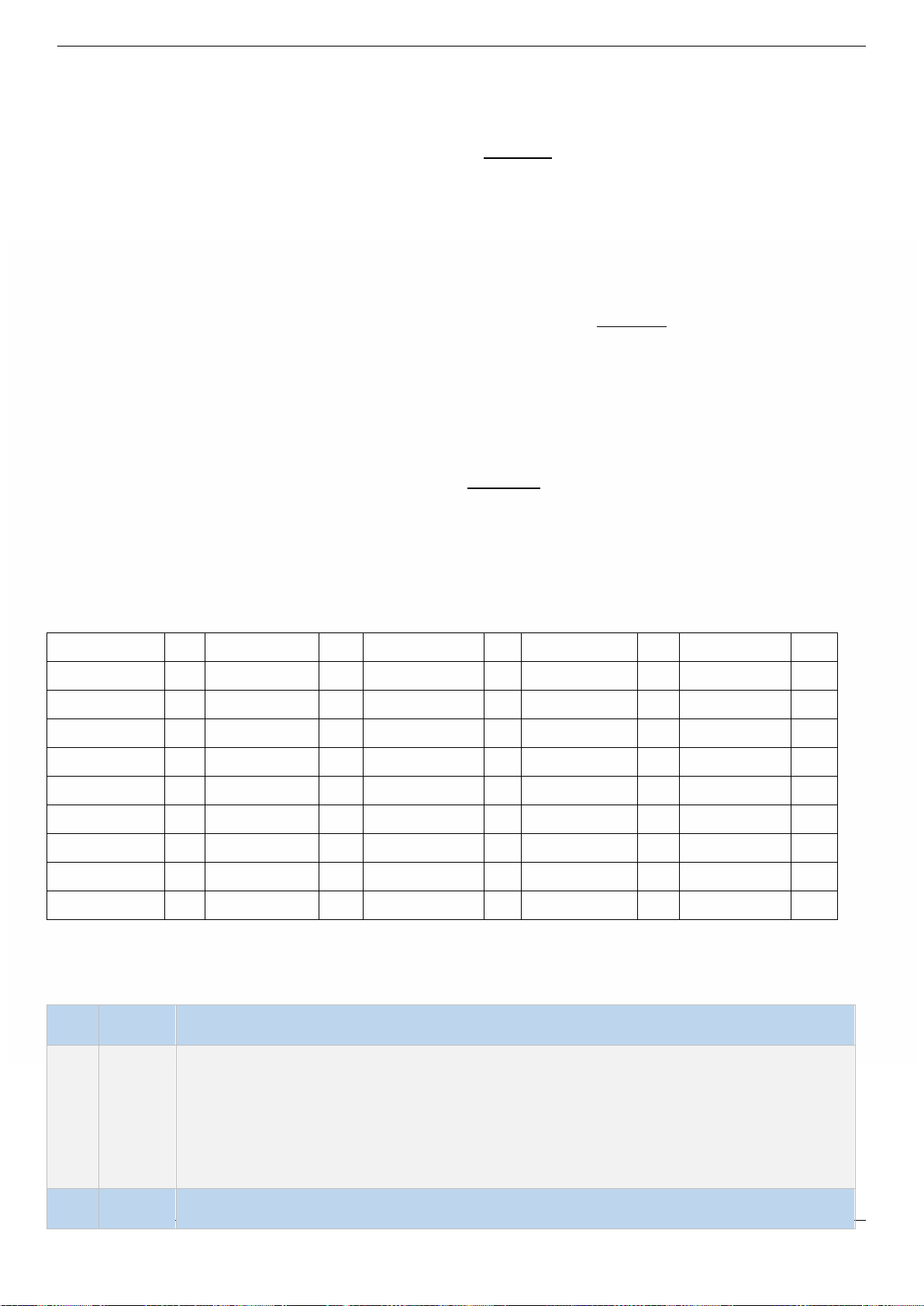
Trang
101
C. opposing on-line. D. American children going on-line.
Question 48: According to the passage, we can infer that .
A. Internet is a jungle full of danger
B. a child who is on-line is in danger
C. Internet contains a lot of harmful sites
D. soft wares fit for children want programming
Question 49: The best way to protect children from improper material is .
A. to buy some search engines for the children
B. to talk to the children and persuade them to tell right from wrong
C. to be nearby when they are surfing the Internet
D. to install a content screener on the computer
Question 50: hazard passage means .
A. peril B. loss C. luck D. instruction
ĐÁP ÁN
Question 1
D
Question 11
A
Question 21
D
Question 31
C
Question 41
A
Question 2
B
Question 12
A
Question 22
C
Question 32
C
Question 42
D
Question 3
B
Question 13
B
Question 23
A
Question 33
B
Question 43
D
Question 4
A
Question 14
C
Question 24
B
Question 34
D
Question 44
C
Question 5
D
Question 15
B
Question 25
A
Question 35
A
Question 45
A
Question 6
A
Question 16
D
Question 26
A
Question 36
B
Question 46
A
Question 7
C
Question 17
B
Question 27
B
Question 37
D
Question 47
D
Question 8
A
Question 18
C
Question 28
D
Question 38
C
Question 48
C
Question 9
A
Question 19
D
Question 29
A
Question 39
A
Question 49
B
Question 10
A
Question 20
B
Question 30
B
Question 40
B
Question 50
A
LỜI GIẢI CHI TIẾT
Câu
Đáp án
Giải thích
1.
D
2.
B

Trang
102
C.
D.
- /d/.
- ed phát âm là /t/: Khi có phát âm thúc là: /ch/, /p/, /f/, /s/, /k/,
-
3.
B
A. media /'
4.
A
5.
D
6.
A
-
7.
C
A.
B. result
8.
A
- So sánh kép.
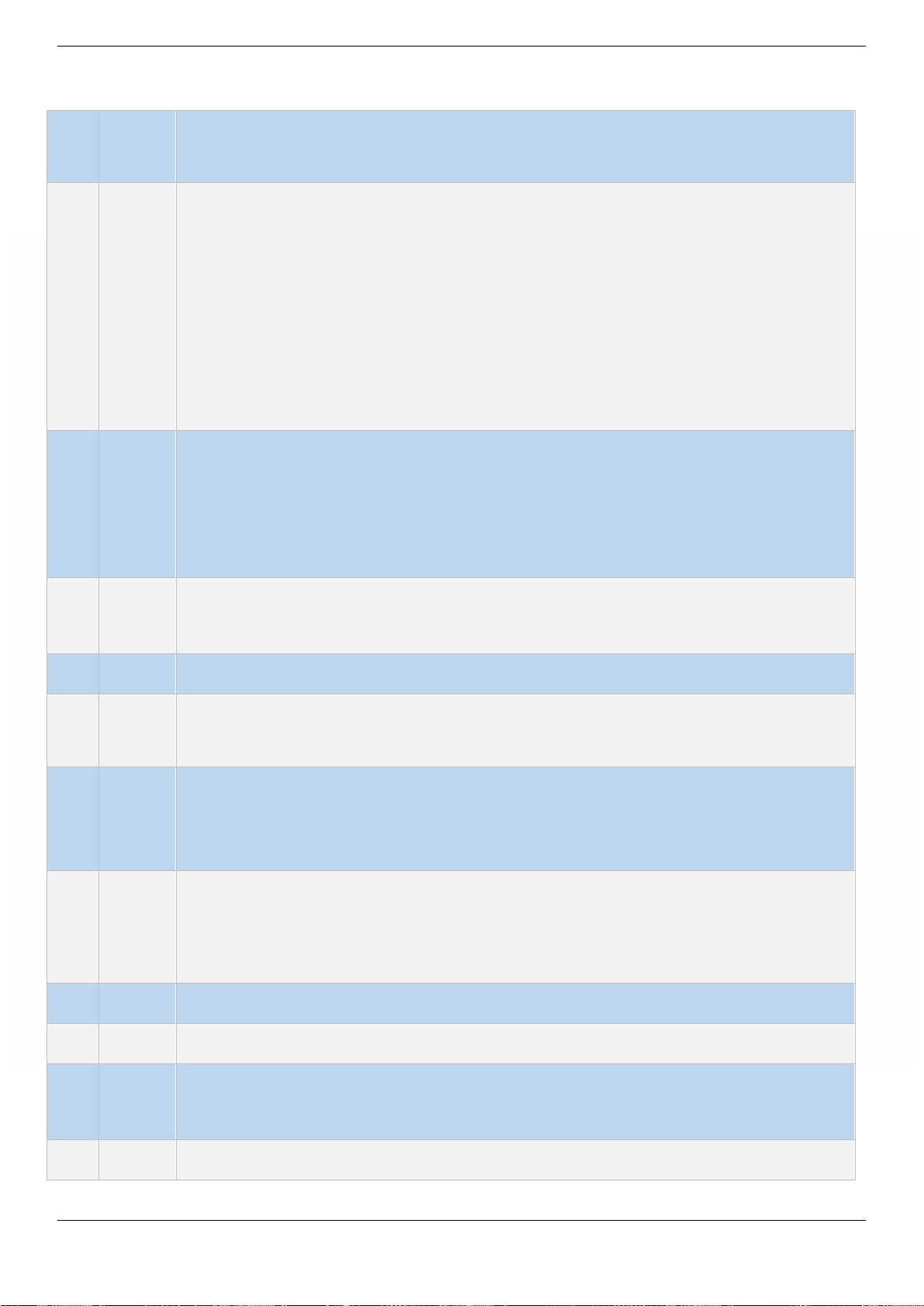
Trang
103
9.
A
-
B. who-
C. that-
D. whose-
10.
A
B.
C. gian.
11.
A
-
12.
A
13.
B
14.
C
-
quá trình).
15.
B
16.
D
17.
B
18.
C
A. B. snow(n): D. ice(n):
19.
D

Trang
104
20.
B
21.
D
-
A. for: vì; B. and: và; C. so: nên, do
22.
C
23.
A
B. relate to: liên C. search for: tìm D. consist of: bao
24.
B
A. produce (V): D. recycle (v): tái
25.
A
B. expanding(v): C. existing(v): D. changing(v): thay
26.
A
economically
27.
B
: has been
had been.
28.
D
streets.
waterway
waterway.
29.
A
-
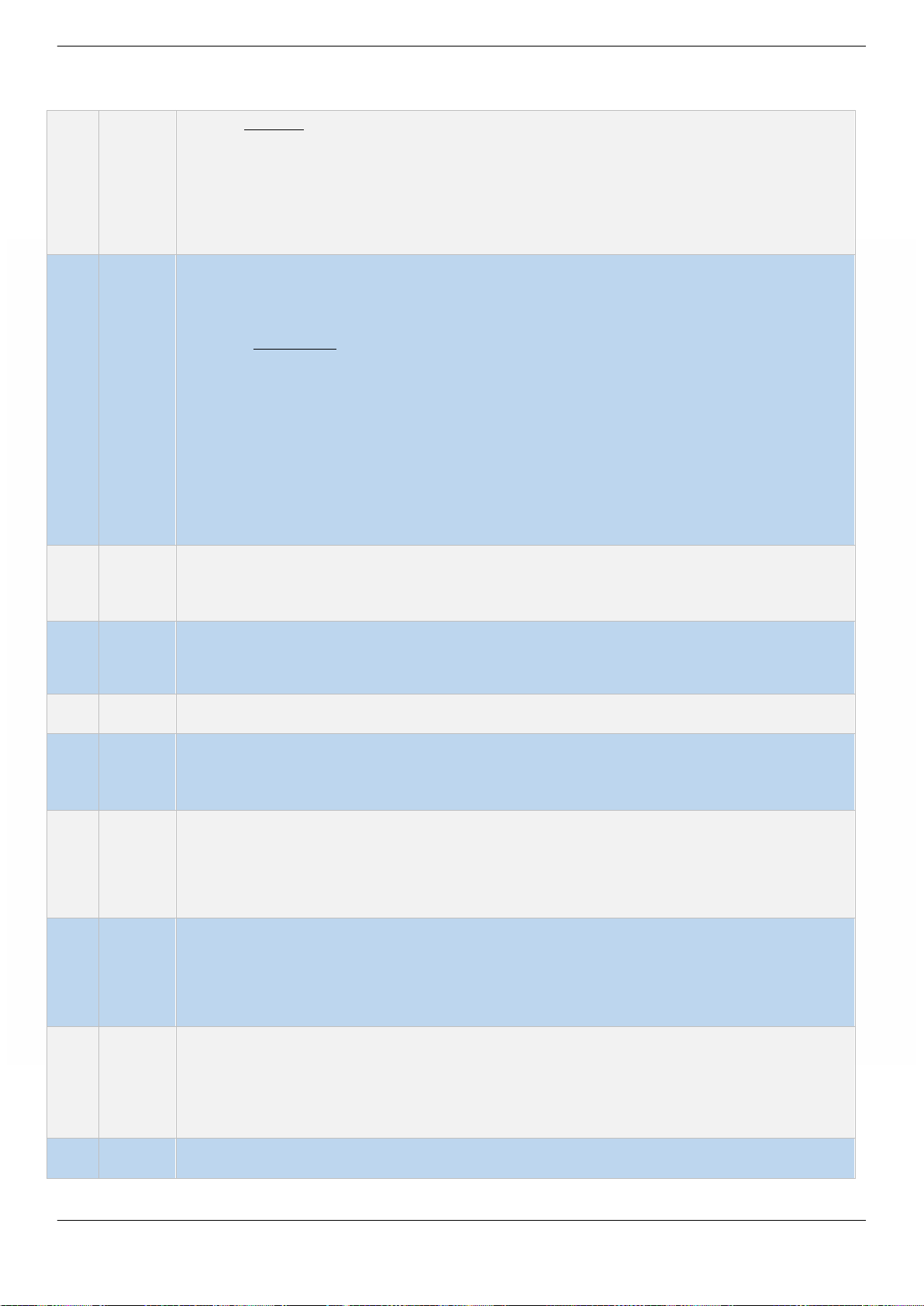
Trang
105
-
ngon tâm.
làm nó; mai.
30.
B
-tin
-
- Mary:
A. quà?
B. nhé!
C.
D.
31.
C
32.
C
--
làm gì)
33.
B
34.
D
35.
A
II
such/so Adj + N + before = S + tobe the
= This is the first time S + have/has + P
II
36.
B
37.
D
38.
C

Trang
106
39.
A
40.
B
-
41.
A
là .
vô
-xi vào các dòng sông.
-
và
42.
D
- sewage and industrial
waste. As more detergent is used in the home, so more of it is finally put into our rivers,
- Khi có
43.
D
.
C. k
-
months or years because the first organisms to be affected are either plants or plankton.
But these organisms are the food of fish and birds and other creatures. When this food
disappears, the fish and birds die in this way a whole food chain can be wiped out, and it
-

Trang
107
ra).
44.
C
trên các sông
A. C. khí ô-xi D. cá
-
dirty and prevents all forms of life in rivers and the sea from receiving the oxygen they
-
-
45.
A
46.
A
A.
B. chúng;
C. Internet;
D.
-
-
-
47.
D
.
Internet.
- Web fans from unsuitable material
online while encouraging them to use the Internet has lo-
-
Kì.)

Trang
108
- úng ta nói
-
- .
48.
C
A.
B.
C.
D. trình.
-
-
49.
B
.
A. chúng;
B. sai;
C.
D. tính.
-
their kids and let them know what is OK or not OK to see or do on the Internet" -
50.
A

Trang
109
ĐỀ THAM KHẢO KỲ THI THPTQG – ĐỀ THI SỐ 3
Choose a word in each line that has different stress pattern
Question 1. A. catastrophic B. preservation C. fertilizer D. electronic
Question 2. A. participant B. individual C. publicity D. competitive
Mark the letter A, B, C, or D on your answer sheet to indicate the underlined part that needs
correction in each of the following questions
Question 3. Vietnam exports (A) a lot of rice is grown (B) mainly in (C) the south of (D) the country.
Question 4. He passed (A) the exam with (B) high scores, that (C) made his parents happy (D).
Question 5. To attract can use (B) either verbal and non-verbal (C) forms
of communication (D).
Choose the word in each group that has the underlined part pronounced differrently from the
rest Question 6. A. fossil B. session C. discuss D. progress
Question 7. A. talked B. naked C. liked D. asked
Choose the best answer for each of the following sentences
Question 8. , no one was absent from the farewell party last night.
A. Heavily as it rained B. As it rained heavily
C. Though it rains heavily D. In spite of heavily rain
Question 9. He had changed so much since the last time we met that I him.
A. could recognize B. could hardly recognize
have recognized recognize
Question 10. Jane cooks well she hates washing up afterwards.
A. however B. therefore C. so D. but
Question 11. his brother, Petter is active and friendly.
A. Alike B. Unlike C. Dislike D. Liking
Question 12. were red he had been swimming in a chlorinated pool.
A. so B. but C. because D. in case
Question 13. Lucy was late for school this morning because the alarm ........... as usual.
A. ring off B. get off C. go off D. take off
Question 14. A sudden idea to the cyclist that he might try the new method.
A. occurred B. happened C. took place D. took part
Question 15. She asked me I was looking at.
A. when B. if C. what D. why
Question 16. We need to import from abroad.
A. a great deal of sports equipment B. many sports equipments
C. a sports equipment D. many pieces of sports equipment
Question 17. these books to the library, as they will soon overdue.

Trang
110
A. Bring B. Take C. Fetch D. Leave
Question 18. Larry was so in his novel that he forgot about his dinner cooking in the oven.
A. absorbed B. attracted C. drawn D. obliged
Question 19. I was in the traffic for more than an

Trang
111
A. carried on B. held up C. put off D. taken after
Mark the letter A, B, C, or D on your answer sheet to indicate the sentence that is CLOSEST in
meaning to each of the following questions
Question 20. I’m sure Luisa was very disappointed when she failed the exam
A. Luisa must be very disappointed when she failed the exam.
B. Luisa must have been very disappointed when she failed the exam.
C. Luisa may be very disappointed when she failed the exam.
D. Luisa could have been very disappointed when she failed the exam.
Question 21. “You had better see a doctor if the sore throat does not clear up.” she said to me.
A. She reminded me of seeing a doctor if the sore throat did not clear up.
B. She ordered me to see a doctor if the sore throat did not clear up.
C. She insisted that I see a doctor unless the sore throat did not clear up.
D. She suggested that I see a doctor if the sore throat did not clear up.
Question 22. Without her teacher’s advice, she would never have written such a good essay
A. Her teacher advised him and she didn't write a good essay.
B. Her teacher didn't advise her and she didn't write a good essay.
C. She wrote a good essay as her teacher gave her some advice.
D. essay.
Mark the letter A, B, C, or D on you answer sheet to indicate the sentence that best combines each
pair of sentences in the following questions.
Question 23. She tried very hard to pass the driving test. She could hardly pass it.
A. Although she didn't try hard to pass the driving test, she could pass it.
B. it.
C. No matter how hard she tried, she could hardly pass the driving test.
D. She tried very hard, so she passed the driving test satisfactorily.
Question 24. Mary loved her stuffed animal when she was young. She couldn’t sleep without it.
A. it.
B. When Mary was young, she loved her stuffed animal so as not to sleep without it.
C. it.
D. it.
Mark the letter A, B, C, or D on your answer sheet to indicate the most suitable response to complete
each of the following exchanges.
Question 25. - - .............
A. Why do you ask me? I know. B. Do you get lost? I do too.
that way D. You are going the wrong way. I here.
Question 26. Mary is talking to a porter in the hotel lobby.
- - Mary: ...........

Trang
112
A. Not a chance. you.
agree more. D. What a pity!
Mark the letter A, B, C or D on your answer sheet to indicate the word(s) CLOSEST in meaning to

Trang
113
the underlined word(s) in each of the following questions.
Question 27. Students are expected to always adhere to school regulations.
A. question B. violate C. disregard D. follow
Question 28. A number of programs have been initiated to provide food and shelter for the
underprivileged in the remote areas of the country.
A. rich citizens B. active members C. poor inhabitants D. enthusiastic people
Mark the letter A, B, C, or D on your answer sheet to indicate the word(s) OPPOSITE in meaning to
the underlined word(s) in each of the following questions.
Question 29. Driver are advised to get enough petrol because filling stations are few and far between
on the highway.
A. easy to find B. difficult to access C. unlikely to happen D. impossible to reach
Question 30. We managed to get to school in time despite the heavy rain.
A. earlier than a particular moment B. later than expected
C. early enough to do something D. as long as expected
Read the following passage and mark the letter A, B, C, or D on your answer sheet to indicate the
correct answer for each of the questions.
UNDERSTANDING INDIA'S CASTE SYSTEM
It has been said that life is what we make of it. In other words, if we work hard and focus on our
exist for everyone. In some places, the family you are born into will decide almost everything about
this.
The caste system is a major part of the Hindu religion that has existed for thousands of years. It
is a way of organizing and grouping people based on the occupation of the family. Castes will
supposed to be determined by their personality, but over time it has been linked to their job and family.
There are
Brahmin. People in this class have jobs in education and religion. These are seen as extremely
important functions for the society as they deal with the knowledge. The second highest level is the
Kshatriya, or ruling class. People from this group can be soldiers, landowners, or have jobs in politics.
The class beneath this is the Vaishya. These people often work in the commercial sector as merchants.
The fourth class level is the Shudra. Shudras typically work as unskilled labourers doing factory or
farm work, or they may also be employed as artists.
There is another group, the Harijan, that is at the bottom and considered to be outside of the
caste system. For many years, they were known as Untouchables, people from this caste held the most
public temples or drink water from the same wells as other classes. If someone from another caste
came into contact with an Untouchable, they were considered dirty and would be expected to bathe
vigorously to clean themselves.
Although the caste system still exists in India, the government is taking steps to improve the
living conditions and decrease unemployment rates for the Shudras and Harijan. This includes
providing better health care, offering literacy programmes, and making sure that people from higher
social classes do not exploit them. It seems unlikely that the caste system will disappear any time soon,

Trang
114
but the overall conditions for those at the bottom do seem to be improving.

Trang
115
Question 31. Which of the fo
A. The caste system has been used in India for a long time.
B. The Kshatriya is the second highest class.
C. Hard work helps people move up in the caste system.
D. It is possible that a Shudra would work on a farm.
Question 32. refers to .
A. the fact that your origin will mostly decide your future
B. the pleasure of life in India
C. years
D. the major part of the Hindu religion
Question 33. What is the caste system mainly based on?
A. What a person believes on B. When a person starts school
parents are D. Where a person was born
Question 34. What kind of job would a Brahmin likely have?
A. A priest B. A warrior C. An inventor D. A painter
Question 35.
A. defeating B. guessing C. delaying D. governing
Question 36. All of the following are true about the Harijan EXCEPT that .
A. they used to be known as Untouchables
B. they had to do undesirable jobs in society
C. any contact between someone from another caste with an Untouchable was considered
unacceptable
D. anyone from another caste coming to contact with an Untouchable is not allowed to pray at
temples
Question 37. What does the passage suggest about the future of the caste system?
A. India.
B. It is probably going to get worse before it gets better.
C. The bottom groups will rise to rule over the top classes.
D. It will likely continue to exist for a long time in India.
Read the following passage and mark the letter A, B, C, or D on your answer sheet to indicate the
correct answer for each of the questions.
Throughout the world there are different ways for people to greet each other. In much of the
world, a handshake is the (38) form of welcoming and greeting someone. In many
countries around the Mediterranean Sea a (39)
welcome friends and family. It can be a very (40)
get a kiss or a hug instead.
kiss on the cheek is the appropriate way to
surprise if you expect to shake hands and
At times, it is difficult to tell what sort of greeting (41) is followed. People may bow,
nothing.

Trang
116
wrong as long as the visitors are (42) . A big part of the delightfulness of world travel is

Trang
117
experiencing different customs.
Question 38. A. different B. unique C. common D. same
Question 39. A. light B. superficial C. fast D. heavy
Question 40. A. huge B. large C. big D. great
Question 41. A. habit B. routine C. custom D. tradition
Question 42. A. sincere B. truthful C. faithful D. hopeful
Read the following passage and mark the letter A, B, C, or D on your answer sheet to indicate the
correct answer for each of the questions
Humans have struggled against weeds since the beginnings of agriculture. Marring our gardens
is one of the milder effects of weeds any plants that thrive where they are unwanted. They clog
waterways, destroy wildlife habitats, and impede farming. Their spread eliminates grazing areas and
accounts for one-third of all crop loss. They compete for sunlight, nutrients, and water with useful
plants.
The global need for weed control had been answered mainly by the chemical industry. Its
herbicides are effective and sometimes necessary, but some pose serious problems, particularly if
misused. Toxic compounds threaten animal and public health when they accumulate in food plants,
groundwater, and drinking water. They also harm workers who apply them.
In recent years, the chemical industry has introduced several herbicides that are more
scientists are exploring the innate weed-killing powers of living organisms, primarily insects and
microorganisms.
The biological agents now in use are environmentally benign and are harmless to humans. They
can be chosen for their ability to attack selected targets and leave crops and other plants untouched. In
contrast, some of the most effective chemicals kill virtually all the plants they come in contact with,
sparing only those that are naturally resistant or have been genetically modified for resistance.
Furthermore, a number of biological agents can be administered only once, after which no added
applications are needed. Chemicals typically must be used several times per growing season.
Question 43. With what topic does this passage primarily deal?
A. The dangers of toxic chemicals.
B. A proposal to ban the use of all herbicides.
C. The importance of the chemical industry.
D. Advantages of biological agents over chemical ones.
Question 44. The word ‘marring’ in bold is closest in meaning to
A. planting B. spoiling C. dividing D. replacing
Question 45.
A. drain B. grow along C. obstruct D. float on
Question 46. Which of the following terms does the author define in the first paragraph?
A. grazing area B. weeds C. nutrients D. wildlife habitats
Question 47. Which of the following statements about the use of chemical agents as herbicides would

Trang
118
the author most likely agree?
A. It has become more dangerous recently. B. It is occasionally required.
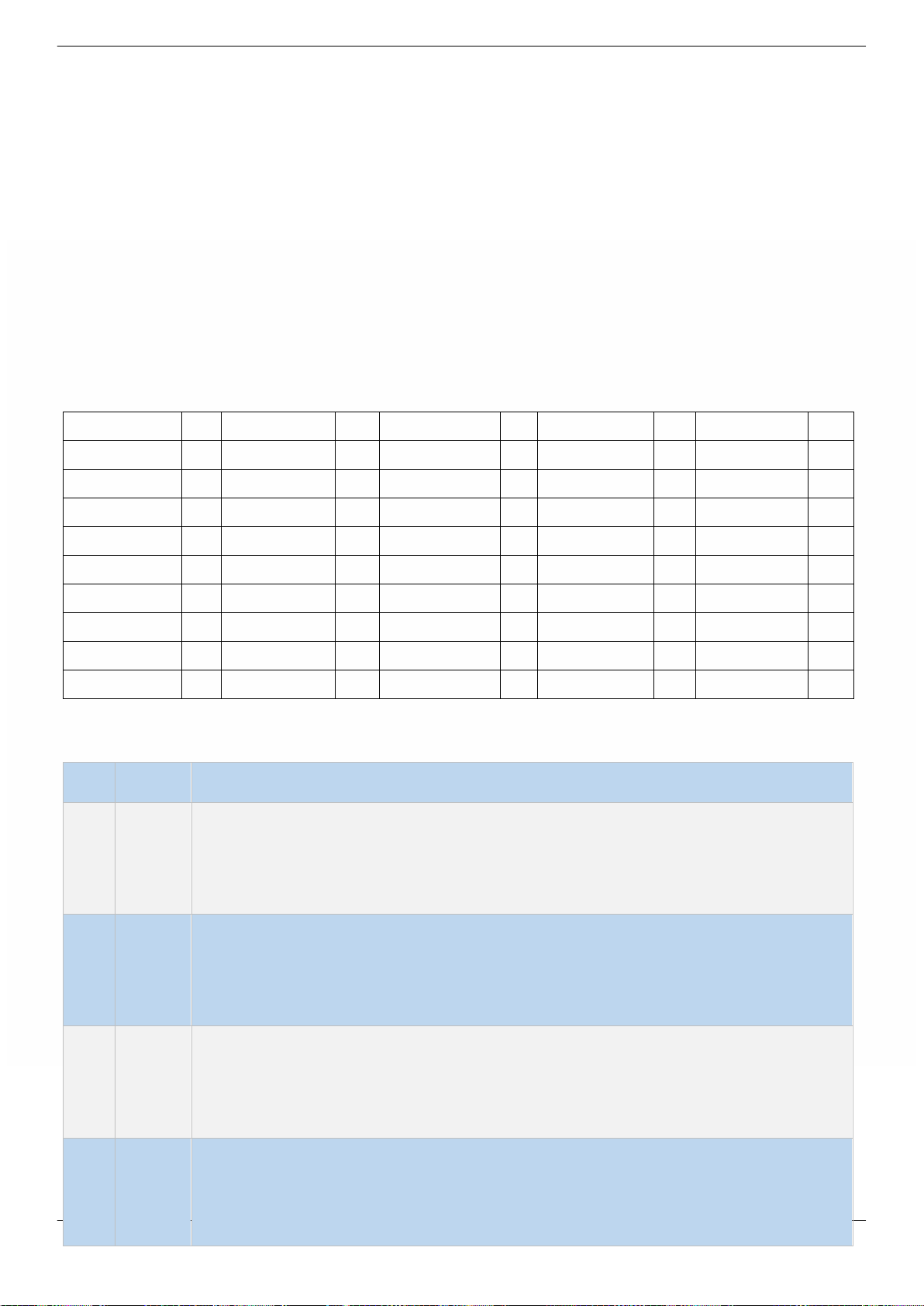
Trang
119
C. It is safe but inefficient. D. It should be increased.
Question 48.
A. effective B. natural C. active D. organic
Question 49.
B. treatments B. requests C. special purposes D. qualifications
Question 50. Which of the following best describes the organization of the passage?
A. Two possible causes of a phenomenon are compared.
B. A problem is described and possible solutions are discussed.
C. A general idea is introduced and several specific examples are given.
D. A recommendation is analyzed and rejected
Question 1
C
Question 11
B
Question 21
D
Question 31
C
Question 41
A
Question 2
B
Question 12
C
Question 22
C
Question 32
A
Question 42
A
Question 3
B
Question 13
C
Question 23
C
Question 33
C
Question 43
D
Question 4
C
Question 14
A
Question 24
A
Question 34
A
Question 44
B
Question 5
C
Question 15
C
Question 25
D
Question 35
D
Question 45
C
Question 6
B
Question 16
A
Question 26
B
Question 36
D
Question 46
B
Question 7
B
Question 17
A
Question 27
D
Question 37
D
Question 47
B
Question 8
A
Question 18
A
Question 28
C
Question 38
C
Question 48
B
Question 9
B
Question 19
B
Question 29
A
Question 39
A
Question 49
A
Question 10
D
Question 20
B
Question 30
B
Question 40
C
Question 50
C
Câu
Đáp án
Giải thích
1.
C
2.
B
A. participant
3.
B
which is grown
4.
C
which

Trang
120
5.
C
-verbal or non-verbal
6.
B
A. D. progress
7.
B
A. C. liked /laikt/ D. asked
8.
A
9.
B
ra;
10.
D
A.
B.
C. so: nên, do
11.
B
A. Alike (tính thích;
12.
C
A. so: nên,
13.
C
A. ring off: cúp dây B. get off: thoát D. take off:
14.
A
15.
C
A. when: khi nào; sao
16.
A
17.
A
mang theo;
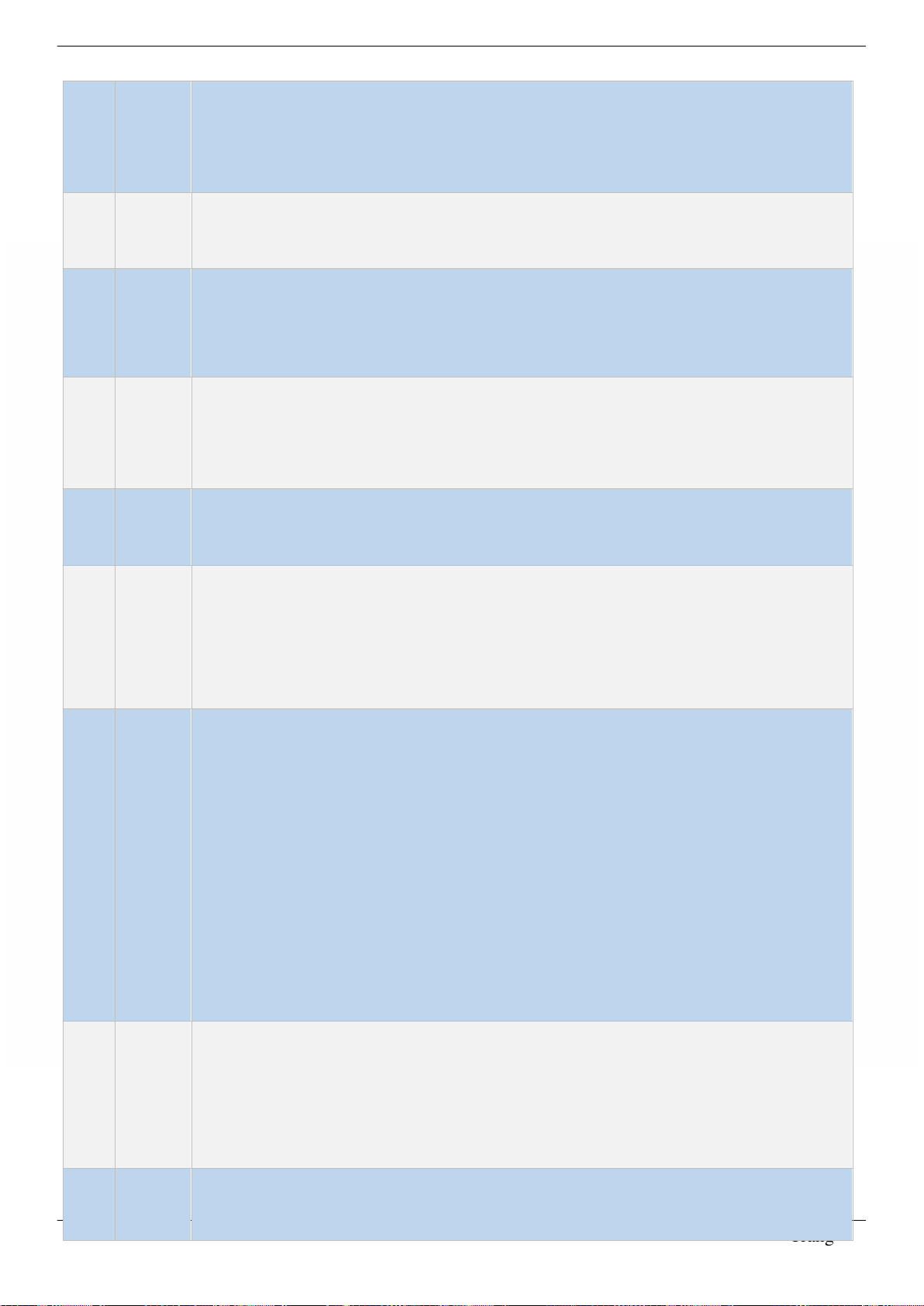
Trang
121
18.
A
B. attracted to: thu hút; C. drawn(adj):
19.
B
A. carry on: sóc
20.
B
21.
D
22.
C
23.
C
A. Although s + V, S + V: dù; dù;
24.
A
không có nó.
A.
có nó;
B. nó;
C.
không có nó;
D.
thích nó.
25.
D
không
C.
D.
26.
B

Trang
122
C.
D.
27.
D
28.
C
nghèo.
A. có;
B.
29.
A
B.
C. ra;
D.
30.
B
C.
D.
31.
C
A. dài.
B. hai.
C.
D.
32.
A
A.
B.
C.

Trang
123
33.
C
gì;
là ai; ra
quy
34.
A
này.
35.
D
A. (to) defeat: C. (to) delay: trì hoãn
36.
D
.
A. dân;
B.
C. liên nào khác dân
D.
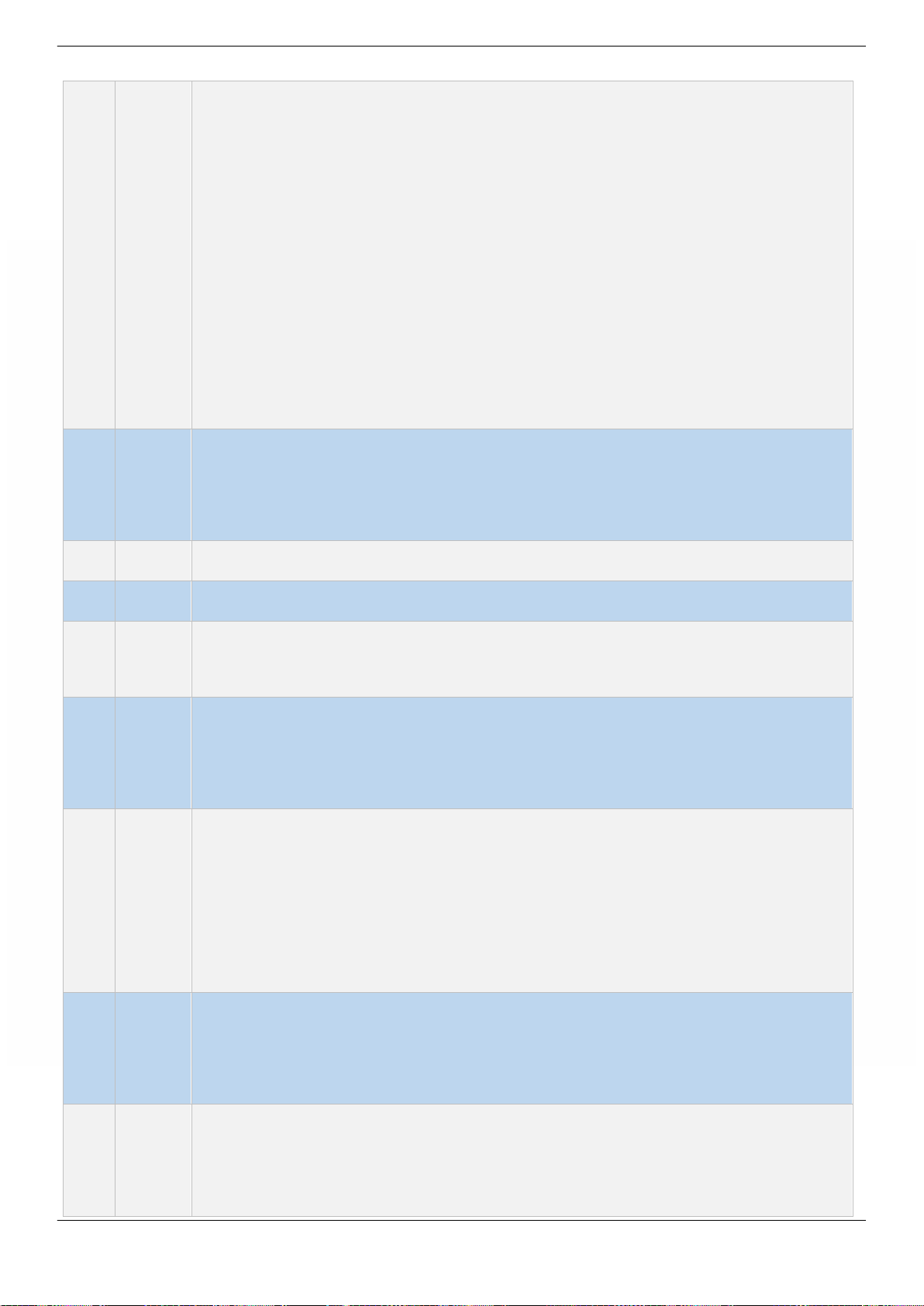
Trang
124
37.
D
A.
B.
C.
D.
system will disappear any time soon, but the overall conditions for those at the bottom
do seem to be impro
38.
C
39.
A
40.
C
41.
A
42.
A
43.
D
A.
B.
C.
D. chât.
44.
B
A. (to) plant: C. (to) devide: phân chia; D. (to) replace: thay
45.
C
A. trên

Trang
125
46.
B
- any plants that thrive where they are
unwanted.
47.
B
lên.
Thông tin: The global need for weed control had been answered mainly by the
48.
B
A. effective(adj):
49.
A
50.
C
A. sánh;
B.
C. ra;
D.
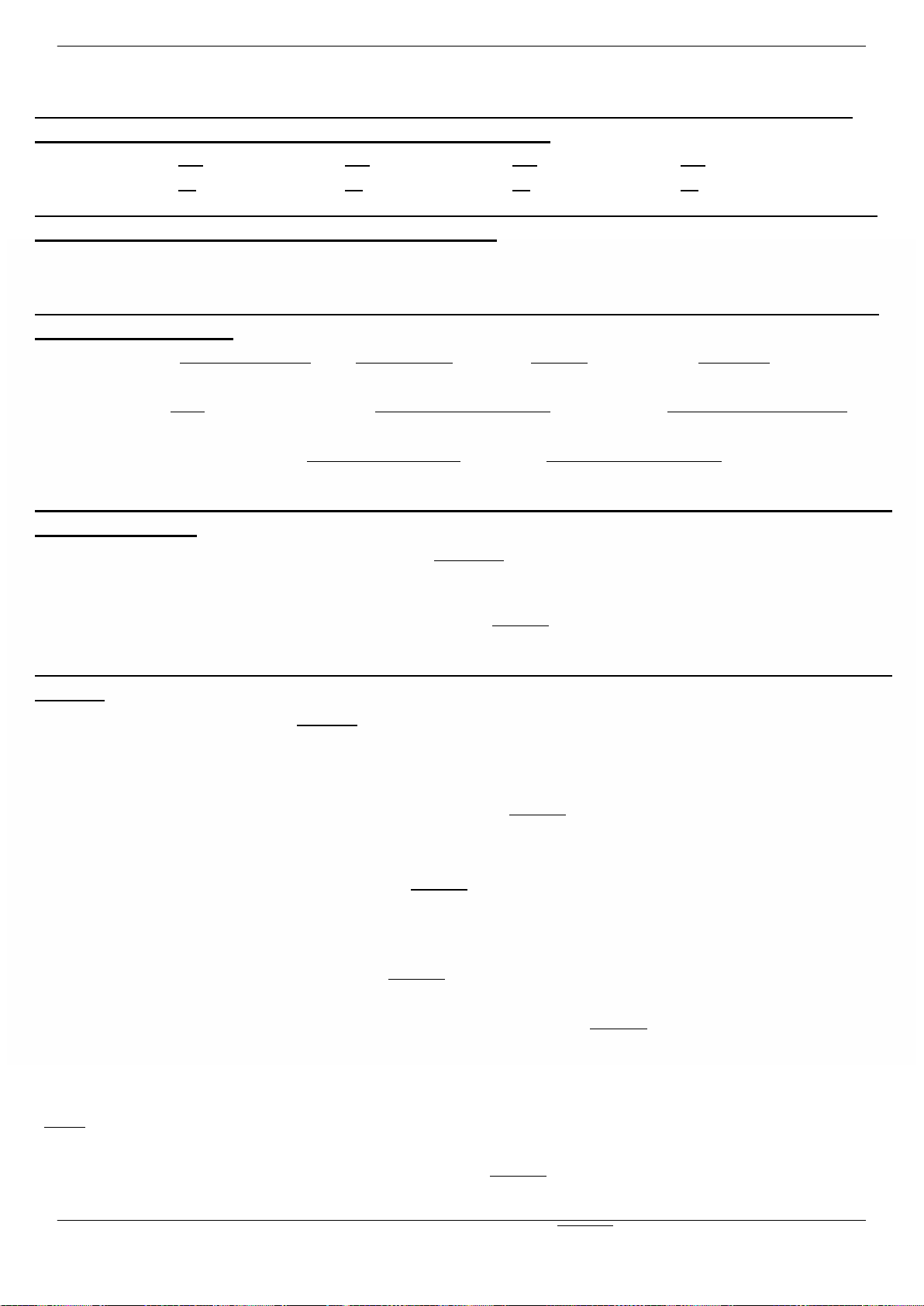
Trang
126
ĐỀ THAM KHẢO KỲ THI THPTQG – ĐỀ THI SỐ 4
Mark the letter A, B, C, or D on your answer sheet to indicate the word whose underlined part differs from
the other three in pronunciation in each of the following questions.
Question 1: A. production B. propaganda C. promotion D. proceed
Question 2: A. express B. exciting C. expensive D. exhibition
Mark the letter A, B, C, or D on your answer sheet to indicate the word that differs from the other three in the
position of primary stress in each of the following questions.
Question 3: A. geographical B. economics C. compulsory D. education
Question 4: A. comfortable B. excellent C. communicate D. confident
Mark the letter A, B,C or D on your answer sheet to indicate the underlined part that needs correction in each
of the following questions
Question 5: New sources of energy have been looking for as the number of fossil fuels continues to
decrease. A B C D
Question 6: For such a demanding job, you will need qualifications, soft skills and having full commitment.
A B C D
Question 7: Antarctic blue whales can be 100 foot long and weigh more than any dinosaur that ever lived.
A B C D
Mark the letter A, B, C, or D on your answer sheet to indicate the most suitable response to each of the
following exchanges.
Question 8: _
like it B. Very little C. Well done D. Very much
Question 9:
A. Never mind B. You don't mind C. You're welcome D. That's fine
Mark the letter A, B, C, or D on your answer sheet to indicate the correct answer in each of the following
question.
Question 10: Dr. Sales is a person .
much confidence him.
C. in whom I don much confidence confidence
Question 11: A quick look would reveal that France has twice computers.
A. more televisions than B. many as televisions as
C. as many televisions as D. as many as televisions
Question 12: The instructor blew his whistle and .
A. off the runners were running B. off ran the runners
C. off were running the runners D. the runners runs off
Question 13: People have used coal and oil to electricity for a long time.
A. bred B. raise C. cultivate D. generate
Question 14: In the early years of the 20th century, several rebellions in the northern parts of the
country.
A. turned out B. rose up C. broke out D. came up
Question 15: The festival has many attractions. It will include contemporary orchestra music and an opera.
, there will be poetry readings and theatrical presentations.
A. Otherwise B. Furthermore C. Nevertheless D. On the other hand
Question 16: When he started that company, he really went . It might have been a disaster.
A. out on the limb B. on and off C. over the odds D.once too often
Question 17: We regret to tell you that the materials you ordered are .

Trang
127
A. out of stock B. out of practice C. out of reach D. out of work
Question 18: My sister is a woman of age.

Trang
128
A. marriage B. married C. marrying D.marriageable
Question 19: The fire to have started in the furnace under the house.
A. is believed B. that is believed C. they believed D. that they believe
Question 20: This is the latest news from earthquake site. Two- thirds of the city in a fire.
A. has been destroyed B. have been destroyed
C. were destroyed D. was destroyed
Question 21: There are many in our library.
A. interesting American old history books B. old American interesting history books.
C. interesting old American history books D. American interesting old history books
Mark the letter A, B, C, or D on your answer sheet to indicate the word CLOSEST in meaning to the
under lined word in each of the following questions
Question 22: She was brought up in a well-off
A. poor B. broke C. wealthy D. kind
Question 23: The most important thing is to keep yourself occupied.
A. relaxed B. comfortable C. possessive D. busy
Mark letter A, B, C, or D on your answer sheet to indicate the word or phrase that is OPPOSITE in
meaning to the underlined word(s) in each of the following questions.
Question 24: There has been insufficient rainfall over the past two years, and fanners are having trouble.
A. abundant B. adequate C. unsatisfactory D. dominant
Question 25: We strongly believe that he's innocent of the crime. We do not think that he did it.
A. crimeless B. skillful C. clean D. guilty
Mark the letter A, B, C, or D on your answer sheet to indicate the sentence that is CLOSEST in meaning
to the sentence given in each of the following question.
Question 26: Only with careful environmental planning can we protect the world in which we live.
A. Careful environmental planning protects the world we live in.
B. Planning the environment carefully, we can protect the world in which we live.
C. Protecting the world we live in, we plan the environment carefully.
D. We can protect the world we live in only with careful environmental planning.
Question 27: You should take regular exercises instead of sitting in front of the television all day.
A. Taking regular exercises is better than sitting in front of the television all day.
B. Sitting in front of the television all day helps you take regular exercises.
C. Sitting in front of the television all day and taking exercises are advisable.
D. day.
Question 28: It was not until after I got home that I realized I had not set the burglar alarm in the office.
A. On the way home, I suddenly realized that I had forgotten to turn on the burglar alarm in the
office.
B. Fortunately, I realized that I hadn't set the burglar alarm just before I left for home; otherwise, I
would have had to travel all the way back to the office.
C.
arrived home.
D. I wish I had realized before I arrived home that I hadn't turned on the burglar alarm in the office,
then it would have been easier to go and set it.

Trang
129
Mark the letter A, B, C, or D on your answer sheet to indicate the sentence that best combines each pair
of sentences in the following questions.
Question 29: He did not remember the meeting. He went out for a coffee with his friends then.
A. Not remember the meeting, he went out for a coffee with his friends.
B. Not to remember the meeting, he went out for a coffee with his friends.
C. Not remembered the meeting, he went out for a coffee with his friends.

Trang
130
D. Not remembering the meeting, he went out for a coffee with his friends.
Question 30: They left their home early. They didn’t want to miss the first train.
A. They left their home early so as to not miss the first train.
B. train.
C. They left their home early so as not to miss the first train.
D. They left their home early in order that not to miss the first train.
Read the following passage and mark the letter A, B, C, or D on your answer sheet to choose the word or
phrase that bestfits each ofthe numbered blanks from 31 to 35
Left-handers are the odd ones out. Sure, lefties (31) up about 10 percent of the population -
but, frankly, it seems like society has forgotten about them. Just consider all of the right-handed gadgets,
awkwardly designed desks, and cooking tools that fit comfortably only in your right hand. What (32)
someone to become a lefthand? Scientists exactly sure, but research points to a complex (33)
who dominantly use their left hands do have more left-handed family members. And researchers have found
different brain wirings in righties vs. lefties. But no matter (34) it is that drives someone to use their
antipodal paw, science has also uncovered a particular set of personality traits that left-handed people tend to
have. So for all of you lefties, leftie-loving righties, and ambidextrous folks out there -
on your left-handed knowledge and help (35) an end to leftie discrimination once and for all.
Read the following passage and mark the letter A, B, C, or D on your answer sheet to indicate the correct
answer to each of the questions from 36 to 42.
Successful students often do the followings while studying. First, they have an overview before
reading. Next, they look for important information and pay greater attention to it (which often needs jumping
forward or backward to process information). They also relate important points to one another. Also, they
activate and use their prior knowledge. When they realize that their understanding is not good, they do not
wait to change strategies. Last, they can monitor understanding and take
mistakes in comprehension.
Conversely, students with low academic achievement often demonstrate ineffective study skills.
They tend to assume a passive role, in learning and rely on others (e.g., teachers, parents) to monitor their
studying, for example, low-achieving students often do not monitor their understanding of content; they may
-
ng problems. Students who struggle with learning new information seem to
be unaware that they must extent effort beyond simply reading the content to understand and remember it.
Children with learning disabilities do not plan and judge the quality of their studying. Their studying may be
disorganized. Students with learning problems face challenges with personal organization as well. They
often have difficulty keeping track of materials and assignments, following directions, and completing work
on time. Unlike good studiers who employ a variety of study skills in a flexible yet purposeful manner, low-
achieving students use a restricted range of study skills. They cannot explain why good study strategies are
important for learning; and they tend to use the same, often ineffective study approach for all learning tasks,
ignoring task content, structure or difficulty.
(Source: Adapted from Study Skills: Managing Your Learning — NUI Galway)
Question 36: What is the topic of the passage?
Question 31:
A. consist
B. account
C. hold
D. make
Question 32:
A. causes
B. makes
C. gets
D. does
Question 33:
A. collaborate
B. collaboration
C. collaborating
D. collaborated
Question 34:
A. which
B. who
C. what
D. that
Question 35:
A. put
B. bring
C. make
D. take

Trang
131
A. Successful and low-academic achieving students
B. Successful learners and their learning strategies

Trang
132
C. Study skills for high school students
D. Effective and ineffective ways of learning
Question 37: meaning to ?
A. important B. earlier C. forward D. good
Question 38: According to the passage, what can be learnt about passive students?
A. They depend on other people to organize their learning
B. They are slow in their studying
C. They monitor their understanding
D. They know the purpose of studying
Question 39: Which of the followings is NOT an evidence of monitoring studying?
A. Being aware of the purpose of studying B. Monitoring their understanding of content
C. Fixing up mistakes in understanding D. Looking at their backs
Question 40: According to the passage, to learn new information, low-achieving students do NOT .
A. just understand it B. relate it to what they have known
C. simply remember it D. read it
Question 41: In compared with low-achieving students, successful students use .
A. aimless study techniques B. various study skills
C. restricted strategies D. inflexible study ways
Question 42: refers to .
A. study strategies B. study skills
C. low-achieving students D. good studiers
Read the following passage and mark the letter A, B, c, or D on your answer sheet to indicate the correct
answer to each of the questions from 43 to 50
Pollution emitted in industrial areas represents a threat to human health and the surrounding natural
resources. We have a tendency to believe that the production processes are the only source of environmental
damage, and often forget about the possible long-term effects of harmful production practices. We may think
that the closure of these huge industrial areas would improve the quality of the environment. Unfortunately,
this ignores the threat of the remaining waste, which is abandoned and poorly stored. It represents an even
bigger danger because it stands neglected as it degrades and leaks into the earth without any control at all.
Changes in the water chemistry due to surface water contamination can affect all levels of an
ecosystem. It can affect the health of lower food chain organisms and, consequently, the availability of food
up through the food chain. It can damage the health of wetlands and damage their ability to support healthy
ecosystems, control flooding, and filter pollutants from storm water runoff. The health of animals and
humans are affected when they drink or bathe in contaminated water. In addition water-based organisms,
like fish and shellfish, can pile up and concentrate contaminants in their bodies. When other animals or
humans eat these organisms, they receive a much higher dose of contaminant than they would have if they
had been directly exposed to the original contamination.
Contaminated groundwater can badly affect animals, plants and humans if it is removed from the
ground by manmade or natural processes. Depending on the study of rocks of the area, groundwater may rise
to the surface through springs or seeps, flow sideways into nearby rivers, streams, or ponds, or sink deeper
into the earth. In many parts of the world, groundwater is pumped out of the ground to be used for drinking,
bathing, other household uses, agriculture, and industry.
Contaminants in the soil can harm plants when they take up the contamination through their roots.
Eating, breathing in, or touching contaminated soil, as well as eating plants or animals that have piled up soil
contaminants can badly affect the health of humans and animals.
Air pollution can cause breathing-related problems and other bad health effects as contaminants are
absorbed from the lungs into other parts of the body. Certain air contaminants can also harm animals and
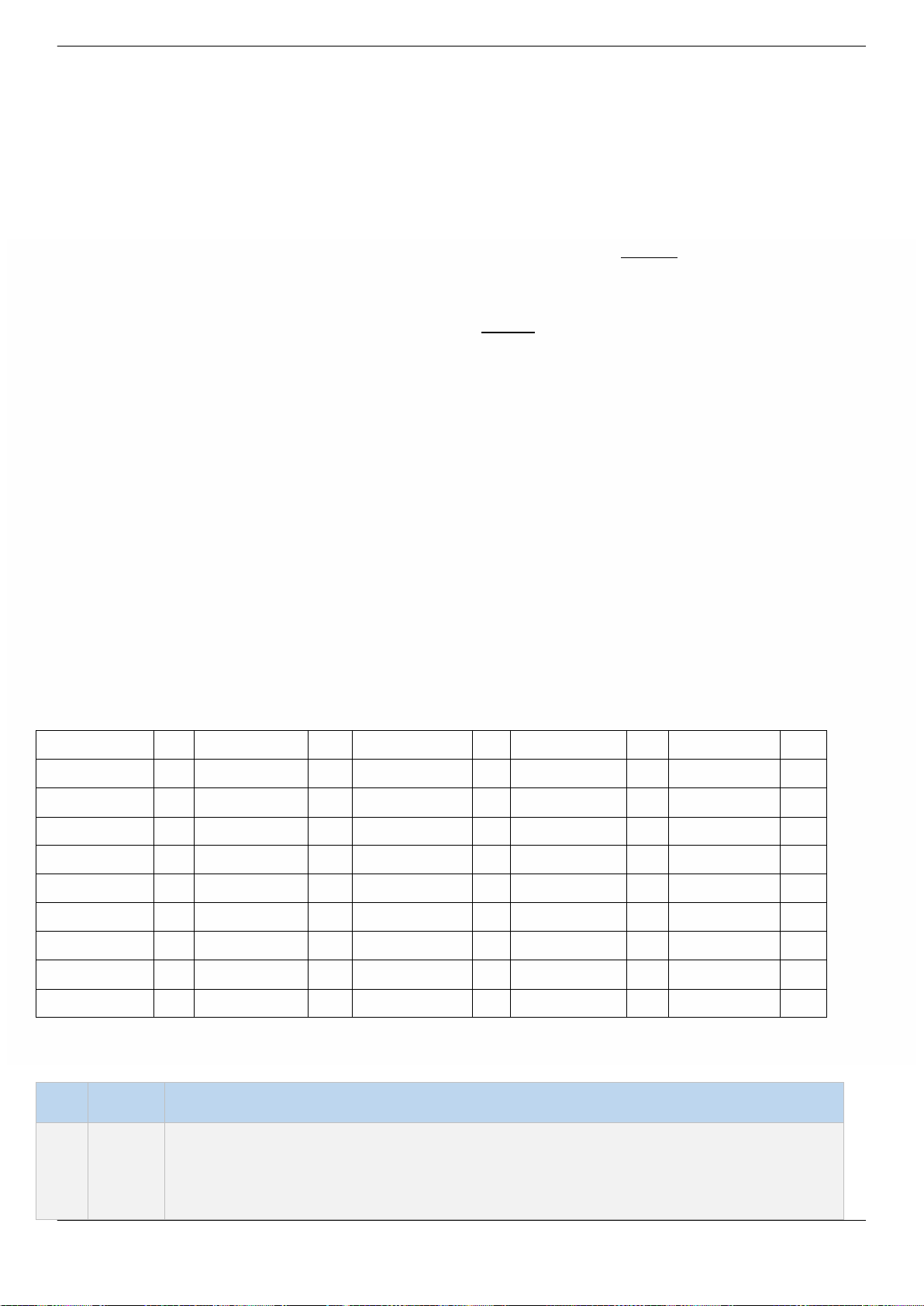
Trang
133
humans when they contact the skin. Plants rely on breathing for their growth and can also be affected by
exposure to contaminants moved in the air.
(Source: Adapted from http://www.grid.unep.ch/waste/download/waste1213.pdf)
Question 43: What is the topic of the passage?
A. Sources of environmental damage B. The pollution from the city
C. Bad effects of industrial waste D. The quality of the environment
Question 44: According to the passage, the industry is likely to be thought as .
A. a danger to the environment B. the only source of pollution
C. the utmost harmful activity D. a threat to human health
Question 45: refers to .
A. the remaining waste B. a danger
C. the environment D. the threat of the remaining waste
Question 46: Which of the followings affect an ecosystem as the whole?
A. Surface water contamination B. Soil contamination
C. Groundwater contamination D. Air contamination
Question 47: According to the passage, which of the followings supports healthy ecosystems?
A. Lower food chain organisms B. Animals C. Water-based organisms D. Wetlands
Question 48: Which of the followings is NOT badly affected by contaminated groundwater?
A. Human B. Plants C. Rocks D. Animals
Question 49: Which of the followings is the flow of water from the ground to the surface?
A. Streams B. Ponds C. Rivers D. Springs
Question 50:
A. Consumed B. Taken in C. Swallowed D. Piled up
-----------------
Đáp án
Question 1
B
Question 11
C
Question 21
C
Question 31
D
Question 41
B
Question 2
D
Question 12
B
Question 22
C
Question 32
A
Question 42
C
Question 3
C
Question 13
D
Question 23
D
Question 33
B
Question 43
C
Question 4
C
Question 14
C
Question 24
A
Question 34
C
Question 44
B
Question 5
B
Question 15
B
Question 25
D
Question 35
A
Question 45
A
Question 6
D
Question 16
D
Question 26
D
Question 36
D
Question 46
A
Question 7
B
Question 17
A
Question 27
A
Question 37
B
Question 47
D
Question 8
C
Question 18
D
Question 28
C
Question 38
A
Question 48
C
Question 9
A
Question 19
A
Question 29
D
Question 39
D
Question 49
D
Question 10
C
Question 20
A
Question 30
C
Question 40
B
Question 50
B
Câu
Đáp án
Giải thích
1.
B
A. production
C. D. proceed

Trang
134
2.
D
A.

Trang
135
c. expensive D. exhibition
3.
C
3
4.
C
A.
C. communicate D. confident
5.
B
been looked
6.
D
full commitment
7.
B
m.
100 feet long
8.
C
A. Tôi không thích nó.
9.
A
A. Không sao.
D. Nó
10.
C
11.
C
12.
B
câu.
13.
D
A.
B. lên
C.
14.
C

Trang
136
hoá ra lên
15.
B
không C. Nevertheless: tuy nhiên, dù
16.
D
17.
A
18.
D
19.
A
20.
A
21.
C
Opinion - --
22.
C
- off = wealth: giàu có
A. poor(adj): nghèo B. broke(adj): cháy túi,
23.
D
ung dung mái
24.
A
B.
C.
25.
D
26.
D

Trang
137
A.
B.
C.
D. Chúng ta có chúng ta duy
27.
A
A. ngày.
B. xuyên.
C. khích.
D. ngày.
28.
C
A. Trên nhà, tôi nhiên ra tôi quên báo
B. May thay, tôi ra tôi báo khi tôi
C.
D.
nó.
29.
D
30.
C
31.
D
A.
B. nhiêu
C. hoãn
32.
A
33.
B
34.
C
35.
A
36.
D

Trang
138
A. kém
B.
C.
D.
37.
B
?
A. D.
38.
A
A.
B.
C. mình
D.
teachers, parents) to monitor their studying
39.
D
-achieving students often do not monitor their
understanding of content; they may not be aware of the purpose of studying; and they
-
40.
B
kém KHÔNG .
nó
nó
unaware that they must extent effort beyond simply reading the content to understand
and remember it
41.
B
.
a variety of study skills in a flexible
yet purposeful manner, low-
42.
C
.

Trang
139
sinh kém
flexible yet purposeful manner, low-achieving students use a restricted range of study
skills. They cannot explain why good study strategies are important for learning; and
they tend to use the same, often ineffective study approach for all learning tasks,
ignoring task content, structure or
43.
C
industrial areas represents a threat to human
health and the surrounding natural
44.
B
.
môi
ction processes are the
only source of environmental
45.
A
.
có
C. có
the remaining waste, which is
abandoned and poorly stored. It represents an even bigger danger because it stands
46.
A
surface water contamination
can affect all levels of an
47.
D
It can damage the health of wetlands and damage their ability to
support healthy ecosystems, control flooding, and filter pollutants from storm water

Trang
140
runoff.
48.
C
A.
humans if it is removed from the ground by manmade or natural processes. Depending
on the study of rocks of the area, groundwater may rise to the surface through springs or
seeps, flow sideways into nearby rivers, streams, or ponds, or sink deeper into the
49.
D
A. dòng B. ao C. sông D.
the surface through springs or seeps, flow sideways into nearby rivers, streams, or
ponds, or sink deeper into the
50.
B
A. thu vào
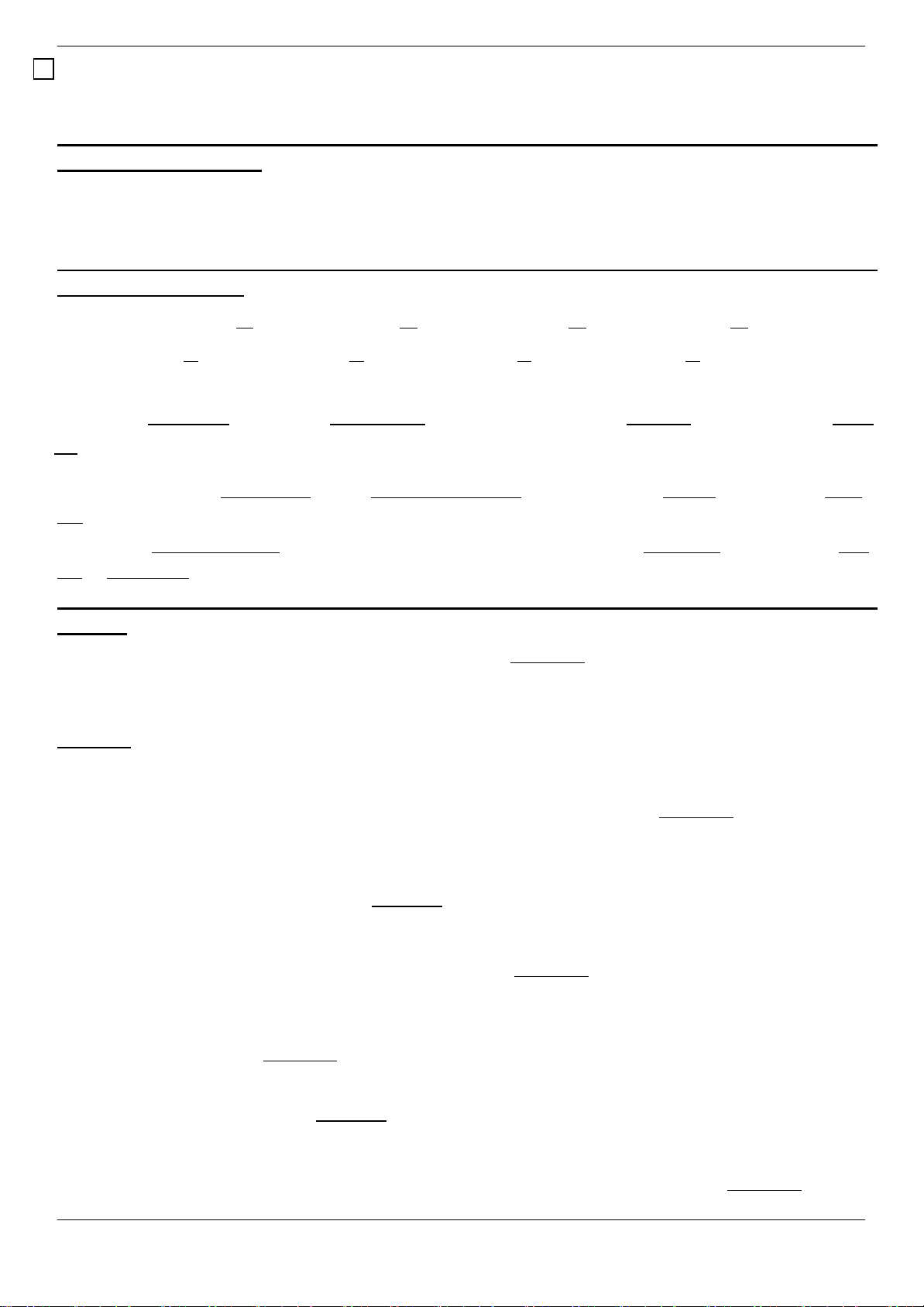
Trang
141
ĐỀ THAM KHẢO KỲ THI THPTQG – ĐỀ THI SỐ 5
Mark the letter A, B, C, D on your answer sheet to indicate the word that differs from the rest in the
position of the main stress.
Question 1. A. measurement B. information C. economic D. engineer
Question 2. A. facilities B. particular C. inhabitant D. governmental
Mark the letter A, B, C, D on your answer sheet to indicate the word whose underline is pronounced
differently from the rest.
Question 3. A. advanced B. surprised C. orphaned D. weighed
Question 4. A. thereupon B. thrill C. through D. throne
Mark the letter A, B, C, D on your answer sheet to show the underlined part that needs correction.
Question 5. Several (A) people have apparent (B) mind (C), but he refuses to listen
(D).
Question 6. Students suppose (A) to read all the questions (B) carefully and find out (C) the answer to them
(D).
Question 7. Public health (A) experts say that the money one spends avoiding illness (B) is less than the cost
(C) of to treat (D) sickness.
Mark the letter A, B, C, D on your answer sheet to indicate the correct answer to each of the following
question.
Question 8. Lack of sleep over the last few months is finally Jane.
A. catching up with B. getting on with C. coming over D. putting on
Question 9. to
this in their treatment of the patients.
A. make up for B. go in for C. put up with D. set in for
Question 10.Of all the factors affecting agricultural yields, the weather is the one the most.
A. that influences farmers B. farmers that is influences
C. why farmers influence it D. it influences farmers
Question 11.The passport she carried was .
A. artificial B. imitation C. untrue D. false
Question 12. ached. She at the computer for five straight hours.
Finally, she took a break.
A. has sat B. has been sitting C. had been sitting D. had sat
Question 13.He showed his for the TV program by switching it off.
A. distaste B. discontent C. annoyance D. boredom
Question 14.It is necessary that he of his old parents.
A. takes care B. to take care C. take care D. took care
Question 15.The two countries have reached an agreement through dialogues described as .
A. productive B. unproductive

Trang
142
C. productivity D. counterproductive
Question 16.People usually can get sufficient of the calcium their bodies need from the food they
consume.
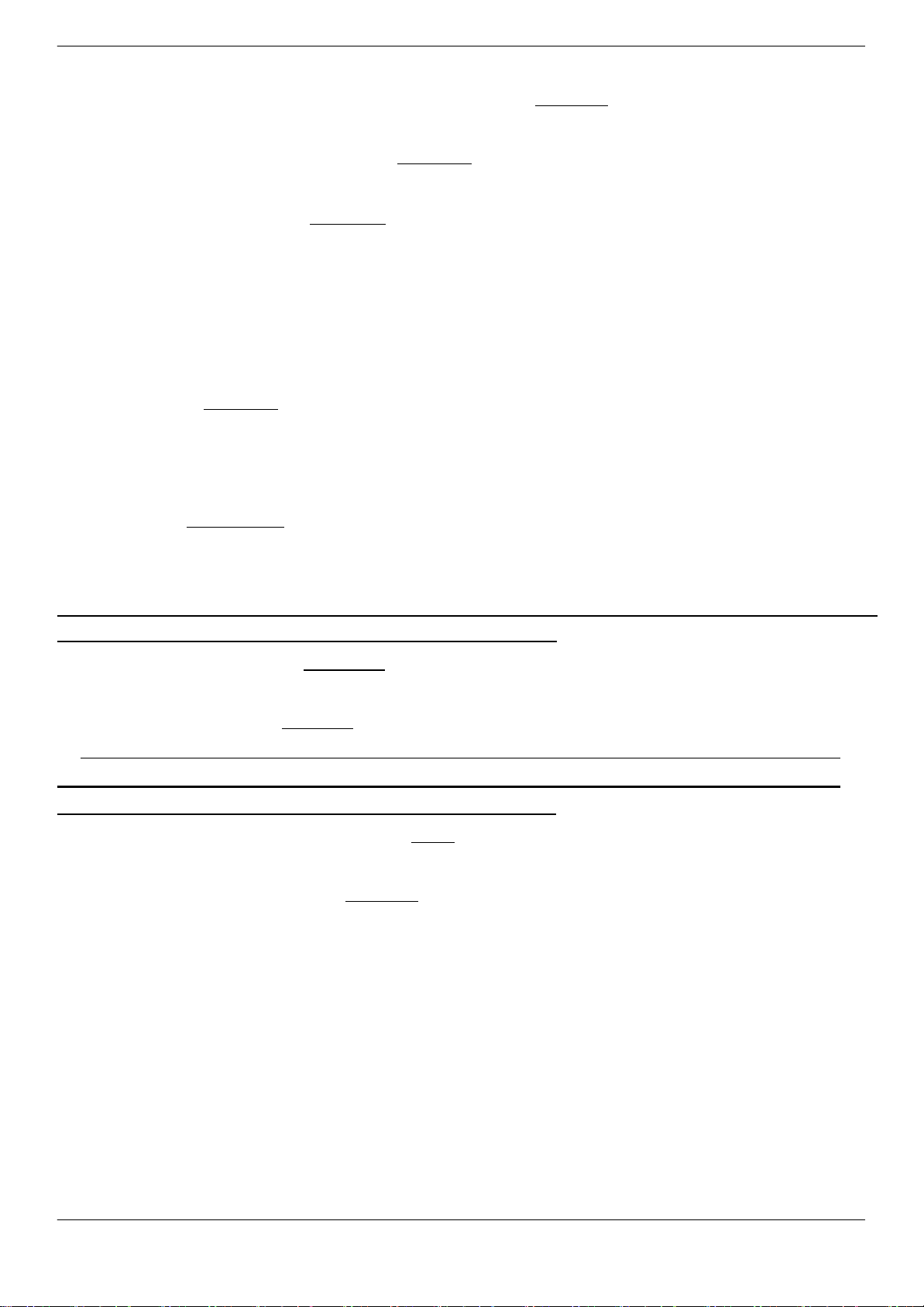
Trang
143
A. variety B. source C. amount D. number
Question 17.The weather is going to change soon; I feel it in my .
A. body B. legs C. skin D. bones
Question 18.Kelly wanted to have a live band at her wedding.
A. to be played B. played C. play D. been playing
Question 19.It is a top secret. You tell anyone about it.
A. B.
Mark the letter A, B, C or D n your answer sheet to indicate the most suitable response to complete
each of the following exchanges.
Question
20.
- John: about giving me a hand?
- Tom:
A. I promise. B. No, not yet.
to help. welcome!
Question 21. -
- Jennifer:
A. Alright. Do you know how much it costs? it.
like it. you.
Mark the letter A, B, C or D on your answer sheet to indicate the word of phrase that is CLOSEST in
meaning to the underlined part in each of the following question.
Question 22.Few businesses are flourishing in the present economic climate.
A. taking off B. setting up C. growing well D. closing down
Question 23.The dog saw his reflection in the pool of water.
A. imagination B. bone C. leash D. image
Mark the letter A, B, C or D on your answer sheet to indicate the word of phrase that is OPPOSITE in
meaning to the underlined part in each of the following question.
Question 24.We ought to keep these proposals secret from the chairman for the time being.
A. revealed B. frequented C. accessible D. lively
Question 25.They protested about the inhumane treatment of the prisoners.
A. vicious B. warmhearted C. callous D. cold blooded
Mark the letter A, B, C or D on your answer sheet to indicate the sentence that is closest in meaning to
each of the following questions.
Question 26. It is English pronunciation that puzzles me most.
A. Pronouncing English is not complicated.
B. I was not quick at English pronunciation at school.
C. Puzzling me most is how to pronounce English.
D. English pronunciation is difficult for me.
Question 27. The woman was too weak to lift the suitcase.
A. weak.

Trang
144
B. The woman, though weak, could lift the suitcase.

Trang
145
Question 28. “Would you like some more beer?” he asked.
A. He asked me if I liked some more beer.
B. He wanted to invite me for a glass of beer.
C. He offered me some more beer.
D. He asked me would I like some more beer.
Mark the letter A, B, C or D on your answer sheet to indicate the sentence that best combines each pair of
sentences in the following questions.
Question 29. My Tam is a pop star. She has many famous songs.
A. My Tam, who has many famous songs, is a pop star.
B. My Tam, that has many famous songs, is a pop star.
C. My Tam, whose has many famous songs, is a pop star.
D. My Tam, which has many famous songs, is a pop star.
Question 30. I’m not rich. I can’t help other people.
A. If I am rich, I can help other people.
B. If I were rich, I can help other people.
C. If I am rich, I could help other people.
D. If I were rich, I could help other people.
Read the following passage and mark the letter A, B, C or D on your answer sheet to indicate the correct
answer to each of the questions.
A pioneering study by Donald Appleyard made the astounding discovery that a sudden increase in the
volume of traffic through an area affects people in the way that a sudden increase in crime does. Appleyard
observed this by finding three blocks of houses in San Francisco that looked much alike and had the same
kind of middle-class and working-class residents, with approximately the same ethnic mix. The difference
Gough Street (MEDIUM street) was used by 8,000 cars daily, and Franklin Street (HEAVY street) had
around 16,000 cars a day. Franklin Street often had as many cars in an hour as Octavia had in a day.
Heavy traffic brought with it danger, noise, fumes and soot, directly, and trash secondarily. That is, the
Appleyard determined, reduced the amount of territory residents felt responsible for. Noise was a constant
intrusion into their homes. Many Franklin Street residents covered their doors and windows and spent most
of their time in the rear of their houses. Most families with children had already left.
Conditions on Octavia Street were much different. Residents picked up trash. They sat on their front steps
and chatted with neighbors. They had three times as many friends and twice as many acquaintances as the
people on Franklin.
On Gough Street, residents said that the old feeling of community was disappearing as traffic increased.
People were becoming more and more preoccupied with their own lives. A number of families had recently
moved and more were considering. Those who were staying expressed deep regret at the destruction of their
community.
Question
31.
The
word
astound
i
n
gin line 1
is
c
losest
in meaning to .
A. startling B. disappointing C. dubious D. alternative
Question 32.The three streets mentioned in this passage are different in that .

Trang
146
they are in different cities.
A.
the residents are of different ethnic backgrounds.

Trang
147
B.
they have varying amounts of traffic.
C.
the income levels of the residents vary considerably.
Question 33.Approximately how many cars used Franklin Street daily?
A. 2,000 B. 8,000 C. 16,000 D. 20,000
Question 34.All of the following are direct results of heavy traffic EXCEPT .
A. increased amount of trash B. greater danger to residents
C. more pollution D. more vibrations
Question 35.The main purpose in the second paragraph is to .
A. discuss the problem of trash disposal
B. point out the disadvantage of heavy traffic
C. propose an alternate system of transportation
D. suggest ways to cope with traffic problems
Question 36.Which of the following is NOT a statement you would expect from a resident of Gough Street?
A. People on this street are unhappy because the neighborhood is deteriorating.
B. People on this street think mostly of themselves.
C. People on this street have more and more space for which they feel responsible.
D. A number of people are preparing to leave this street.
Question 37.In what order does the author present detailed discussions of the three streets?
A. LIGHT, MEDIUM, HEAVY B. HEAVY, MEDIUM, LIGHT
C. HEAVY, LIGHT, MEDIUM D. LIGHT, HEAVY, MEDIUM
Question 38.
A. neutral B. favorable C. critical D. doubtful
Read the following passage and mark the letter A, B, C or D on your answer sheet to indicate the correct
answer to each of the questions.
known as the Age of Reptiles. The first dinosaurs appeared more than 200 million years ago. For many
millions of years, they dominated the land with their huge size and strength. Then about 65 million years
ago, they died out rather suddenly, never to reemerge.
The
word
dinosaur
comes
from
two
Greek
words
meaning
terrible lizar
d
.
Dinosa
ur
s
w
ere not lizar
ds
,
but their appearance could be truly terrifying. The biggest ones weighed more than ten times as much as a
mature elephant and nearly equaled the size of most modernday whales. The famous kinds of dinosaurs,
including the brontosaur and tyrannosaurus, reached 80 to 90 feet in length. Not all dinosaurs were giants,
however, some were actually no larger than a chicken.
Scientists still do not know what caused dinosaur to disappear. One theory involves a change in the
perature dropped significantly towards the end of the Cretaceous
Period. Too large to hibernate and not having fur or feathers for protection, it is possible that the climate
became too chilly for dinosaurs. In contrast, other species having protection, such as the mammals and birds,
were able to survive.
Question
39.
The
word
on
e
s
in the pa
ss
age refe
rs
to .
A. dinosaurs B. millions C. lizards D. whales
Question
40.
The
word
c
h
illy
in the pa
ss
age refe
rs
to .

Trang
148
A. very hot B. extremely cold C. very cold D. humid

Trang
149
Question 41. What is the best title for this passage?
A. The Domination of the Land B. The Metabolism of Dinosaurs
Largest Reptiles D. The History of Earth
Question 42.It can be inferred from the passage that the Age of Reptiles lasted about .
A. 200 million years B. 135 million years C. 80 million years D. 65 million years
Question 43.The author uses the phrase never to reemerge” to indicate the dinosaurs .
A. became extinct B. went into hiding C. never died out D. lost their way
Question 44.According to the passage, what is true about the size of dinosaurs?
A. It made them the largest creatures ever on earth. B. It varied quite greatly.
C. It guaranteed their survival. D. It was rather uniform.
Question 45.Which of the following can be inferred about mammals and birds?
A. Most have either fur or feathers over their bodies.
B. They preceded the dinosaurs.
C. They were too large to hibernate.
D. They could not survive the chilly temperatures.
Read the following passage and mark the letter A, B, C or D on your answer sheet to indicate the correct
word for each of the blanks from 46 to 50.
Vietnamese generally shake hands when greeting and parting. Using both hands shows respect as does a
(46) bow of the head. In rural areas, elderly people who do not extend their hand are greeted with a
slight bow. Women are more likely to bow the head than to shake hands. Vietnamese names begin with the
family name and are (47) by a given name. People address one another by their given names, but
add a title that indicates their perceived relationship to the other person. These titles are family related rather
than professional. Among colleagues, for example, the younger of the two might combine the given name
with thetitle of (Older Brother). A/n (48) greeting combined with the given name and title is
Xin
chao
(
He
llo). Classifier
s
for gender and familiarity are a
lso
combined with the greeting. In formal
meetings, business cards are sometimes exchanged on greeting.
Vietnamese have a strong (49) of hospitality and feel embarrassed if they cannot show their
guests full respect by preparing for their arrival. Therefore, it is (50) to visit someone without
having been invited. Gifts are not required, but are appreciated. Flowers, incense, or tea may be appropriate
gifts for the hosts. Hosts also appreciate a small gift for their children or elderly parents.
Question 46. A. light
B. slight
C. lightly
D. lighted
Question 47. A. continued
B. chased
C. followed
D. forwarded
Question 48. A. easy
B. basic
C. fundamental
D. elementary
Question 49. A. sense
B. sensation
C. sensitivity
D. sensibility
Question 50. A. inactive
B. inaccurate
C. inappropriate
D. inexact

Trang
150
ĐÁP ÁN
Question 1
A
Question 11
D
Question 21
B
Question 31
A
Question 41
B
Question 2
D
Question 12
C
Question 22
C
Question 32
C
Question 42
B
Question 3
A
Question 13
A
Question 23
D
Question 33
C
Question 43
A
Question 4
A
Question 14
C
Question 24
A
Question 34
D
Question 44
B
Question 5
B
Question 15
A
Question 25
B
Question 35
B
Question 45
A
Question 6
A
Question 16
C
Question 26
D
Question 36
C
Question 46
B
Question 7
D
Question 17
D
Question 27
C
Question 37
C
Question 47
C
Question 8
A
Question 18
C
Question 28
C
Question 38
C
Question 48
B
Question 9
A
Question 19
C
Question 29
A
Question 39
A
Question 49
A
Question 10
A
Question 20
C
Question 30
D
Question 40
C
Question 50
C
LỜI GIẢI CHI TIÉT
Câu
Đáp án
Giải thích
1.
A
2.
D
A.
B.
C.
3.
A
/d/
Chú ý: Cách phát âm “ed”
- /d/.
- ed phát âm là /t/: Khi có phát âm thúc là: /ch/, /p/, /f/, /s/, /k/,
-
4.
A

Trang
151
5.
B
apparently

Trang
152
6.
A
are supposed
7.
D
-ing: Of + V-ing
treating
8.
A
9.
A
B. go in for: C. put up with: trong
10.
A
11.
D
A. artificial (adj): nhân
12.
C
13.
A
B. bình
C.
D. chán
14.
C
-inf
recommended, urgent, important, obligatory, required, imperative, mandatory, proposed,
suggested,...
15.
A
A. productive (adj): ích ích
16.
C
phong phú B. source (n):
17.
D

Trang
153
18.
C
19.
C
không không không
20.
C
- - Tom:
A. I promise:
21.
B
-
- Jennifer:
C.
D.
22.
C
A.
B.
23.
D
A. imagination (n): xích
24.
A
B. frequent (adj):
25.
B
-
ác ý
D. cold-
26.
D
S + V + 0. = Ving + to be + Noun. = It + is + adj + N that S+ V.

Trang
154
27.
C
S + to be + too + adj + (for somebody) + to + V
S + V + too + adv + (for somebody) + to + V
lí.

Trang
155
A.
B. lí.
28.
C
offer.
29.
A
who.
Who-
That -
Whose -
Which -
30.
D
If + S + V-ed, S + would/could + V
31.
A
ràng
D. alternative(adj): luân phiên
32.
C
A.
B. nhau.
C. nhau.
D. nhau.
-
class and working-
33.
C
ngày?
A. 2,000 B. 8,000 0.16,000 D. 20,000
34.
D
lên dân
C. ô

Trang
156

Trang
157
35.
B
là
C.
D. thông.
36.
C
A.
B.
C.
D.
vui)...
37.
C
A. LIGHT, MEDIUM, HEAVY B. HEAVY, MEDIUM LIGHT
C. HEAVY, LIGHT, MEDIUM D. LIGHT, HEAVY MEDIUM
38.
C
Appleyard?
A. trích D. nghi
39.
A
A. D. cá voi

Trang
158
40.
C
.
A. D.
41.
B
long
42.
B
called the Mesozoic Era, which is known as the Age of Reptiles. The first dinosaurs
appeared more than 200 million years ago. For many millions of years, they dominated
the land with their huge size and strength. Then about 65 million years ago, they died
out rather suddenly, never to reemerqe
43.
A
long
44.
B
A.
B.
C. long
D.
more than ten times as much as a mature elephant and nearly equaled the size of most
modernday whales. The famous kinds of dinosaurs, including the brontosaur and
tyrannosaurus, reached 80 to 90 feet in length. Not all dinosaurs were giants, however,

Trang
159

Trang
160
-
45.
A
A.
B. long.
C.
D.
and not having fur or feathers for protection, it is possible that the climate became too
chilly for dinosaurs. In contrast, other species having protection, such as the mammals
and birds, were able to
46.
B
D. lighted (adj): cháy
47.
C
A. (to) continue: theo
48.
B
A. easy (adj): dàng C. fundamental(adj):
49.
A
50.
C
A. inactive(adj): toàn
D. inexact(adj): không chính xác

Trang
161
ĐỀ THAM KHẢO KỲ THI THPTQG – ĐỀ THI SỐ 6
Mark the letter A, B, C or D on your answer sheet to indicate the word(s) CLOSEST in meaning to the
underlined word(s) in each of the following questions.
Question 1: Everyone is hoping and praying that lasting peace will eventually come to the area.
A. Durable B. Ongoing C. Temporary D. Enduring
Question 2: Before you begin the exam paper, always read the instructions carefully.
A. Orders B. Answers C. Rules D. Directions
Mark the letter A, B, C or D on your answer sheet to indicate the correct answer to each of the
following questions.
Question 3: Last year, ABBA made a of several million crowns.
A. Win B. Gain C. Salary D. Profit
Question 4: a ski Madrid.
A. Resort B. Station C. Place D. Port
Question 5: very secrets.
A. Trustworthy B. Direct C. Open D. Sincere
Question 6: too to protest.
A. Apathetic B. Subdued C. Quiet D. Outgoing
Question 7: -one, there was nothing I
could do to it.
A. Hinder B. Resist C. Prevent D. Cease
Question 8: She noticed away from the house.
A. Him to run B. Him running C. His running D. Him ran
Question 9: George has ; he loves cakes, chocolate, ice-cream anything which is sweet.
A. A sweet mouth B. Sweet lips C. A sweet tooth D. A sweet tongue
Question 10: so ; room.
A. High and dry B. Prim and proper C. Rough and ready D. Sick and tired
Question 11: all the point. The film itself is not racist it simply tries to make us
question our own often racist attitude.
A. Mistaken B. Misunderstood C. Missed D. Lost
Question 12: one or more units of living substance called protoplasm.
A. Although all living things that consist of B. All living things consisting of
C. All living things consist of D. In all living things consisting of
Question 13: The production of tin ore in the United States is relatively insignificant, less than
one hundred tons annually.
A. Amount to B. In the amount C. Amount to it D. To the amount of
Question 14: It all happened so quickly, one minute I was making chips and the next the whole kitchen
was fire!

Trang
162
A. At B. On C. By D. In
Read the following passage and mark the letter A, B, C or D on your answer sheet to indicate the
word or phrase that best fits each of the numbered blanks from 15 to 19.
About 50 or so kinds of modern plastic are made from oil, gas, or coal non-renewable natural
resources. We (15) well over three million tons of the stuff in Japan each year and, sooner or
later, mist of it is thrown away. A high proportion of our annual consumption is in the (16) of
packaging and this constitutes about seven percent by weight of our domestic (17) . Almost

Trang
163
all of it can be recycled, but very little of it, though the plastic recycling industry is growing fast.
The plastics themselves are extremely energy-rich they have a higher calorific (18) than
by plastic manufactures if the conversion of waste
plastic into a fuel.
Question 15: A. Consign B. Import C. Consume D. Remove
Question 16: A. Form B. Way C. Type D. Kind
Question 17: A. Goods B. Refuse C. Rubble D. Requirements
Question 18: A. Effect B. Degree C. Value D. Dema
Question 19: A. Argued B. Presented C. Desired D. Favored
Read the following passage and mark the letter A, B, C or D on your answer sheet to indicate the
correct answer to each to each of the questions from 20 to 25.
FIRST TIME IN THE AIR
When John Mills was going to fly in an aeroplane for the first time, he was frightened. He did not like
e car. When somebody else is driving, I tell them what to do. It
it would also be tiring for the children -hours
he says.
To get ready for the flying, John did lots of reading about aeroplanes. When he booked hos seat, he
as much as possible before getting on that plane. I suppose it was a way of making myself feel better. The
Boeing 747 is the largest passenger aircraft in the world at the moment. The first one flew on February
9th 1969 in the USA. It can carry up to 524 passengers and 3,400 pieces of luggage. The fuel for the
had discovered all this very interesting information about the jumbo, when I saw it for the first time, just
to
get up in the air and fly. I was even more impressed when I saw how big it was inside hundreds of
-off itself was much smoother, than I
expected although I was still quite scare until we were in the air. In the end, I managed to relax, enjoy the
food and watch one of the movies and the view from the window was spectacular. I even managed to
saw my son and his family, particularly my beautiful grandchildren. Suddenly, I felt so silly about the
Question 20: Why did John Mills fly in an aeroplane?
A. He wanted to go on holiday. B. He wanted to try it.
C. He wanted to see his family. D. He had to travel on business.
Question 21: Why did John read about aeroplane?

Trang
164
A. He wanted to know how they work. B. It was his hobby.
C. It guaranteed his safety. D. He had found a book on them.
Question 22: What happened when he saw the jumbo jet for the first time?

Trang
165
A. He felt much safer. B. He liked the shape of it.
C. He was surprised at how it was. D. He thought the wings were very small.
Question 23: How did John feel when the aeroplane was taking off?
A. Excited B. Happy C. Sad D. Frightened
Question 24: What surprised John most about the flight?
A. That he liked the food B. That he was able to sleep
C. That there was a movie being shown D. That the view was good
Question 25: How did John feel about his fears in the end?
A. He thought he had wasted time being afraid.
B. He realized it was okay to be afraid.
C. flying.
D. He realized that being afraid kept him safe.
Read the following passage and mark the letter A, B, C or D on your answer sheet to indicate the
correct answer to each of the questions from 26 to 34.
Although noise, commonly defined as unwanted sound, is a widely recognized form of pollution, it is
very difficult to measure because the discomfort experienced by different individuals is highly exposure
to higher levels may actually cause hearing loss. Particularly in congested urban areas, the noise
produced as a byproduct of our advancing technology causes physical and psychological harm but it also
detracts from the quality of life for those exposed to it.
Unlike the eyes, which can be covered by the eyelids against strong light, the car has no lid, and
is, therefore, always open and vulnerable, noise penetrates without protection.
Noise causes effects that the hearer cannot control and to which the body never becomes accustomed.
Loud noises instinctively signal danger to any organism with a hearing mechanism, including human
beings. In response, heartbeat and respiration accelerate, blood vessels constrict, the skin pales, and
muscles tense. In fact, there is a general increase in functioning brought about by the flow of adrenaline
released in response to fear, and some of these responses persist even longer than the noise, occasionally
as long as thirty minutes after the sound has ceased.
Because noise is unavoidable in a complex, industrial society, we are constantly responding in the
same ways that we would respond to danger. Recently, researchers have concluded that noise and our
response may be much more than an annoyance. It may be a serious threat to physical and psychological
health and well-being, causing damage not only to the ear ad brain but also to the heart and stomach. We
learning that some of us with heart disease and ulcers may be victims of noise. Investigations on human
subjects have demonstrated that babies are affected by noise even before they are born. Fetuses exposed
to noise tend to be overactive, they cry easily, and they are more sensitive to gastrointestinal problems
after birth. In addition, the psychological effect of noise is very important. Nervousness, irritability,
tension, and anxiety increase, affecting the quality of rest during sleep, and the efficiency of activities
during walking hours, as well as the way that we interact with one another.
Question 26: Which of the following is th
A.
problem.
B.
Loud noise signal danger.
C.
Noise may pose a serious threat to our physical and psychological health.
D.
The car is not like the eye.
Question 27: According to the passage, what is noise?

Trang
166
A. A byproduct of technology B. Physical and psychological harm.
C. Congestion. D. Unwanted sound.

Trang
167
Question 28: Why is noise difficult to measure?
A. All people do not respond to it in the same away.
B. It causes hearing loss
C. It is unwanted
D. People become accustomed to it
Question 29: The word congested in paragraph 1 could be best replaced by
A. Hazardous B. crowded C. polluted D. rushed
Question 30: The word it in paragraph 1 refers to .
A. the quality of life B. our advancing technology
C. the noise D. physical and psychological harm
Question 31: According to the passage, people respond to loud noises in the same way that they respond
to
A. annoyance B. danger C. damage D. disease
Question 32: Look at the verb accelerate in paragraph 3. Which of the following is the closest in
meaning to .
A. cease B. rise C. swell D. increase
Question 33: The phrase as well as in paragraph 4 is the closest in meaning to
A. after all B. instead C. also D. regardless
Question 34: It can be inferred from this passage that the eye .
A. responds to fear B. enjoys greater protection than the ear
C. increases functions D. is damaged by noise
Mark the letter A, B, C, or D on your answer sheet to indicate the sentence that is closest in
meaning to each of the following questions.
Question 35:
A. out the new development?
B. changed?
C. plan?
D. we?
Question 36:
him.
A. healthy.
B. Try to avoid the subject of his health as I am tired of hearing all about his complaints.
C. subject.
D. If you let him, he would talk only about his ill-health though actually he is quite healthy.
Question 37: We had planned to walk right round the lake, but the heavy rain made this impossible.
A. In spite of the heavy rain we managed to walk half way round the lake as planned.
B. The heavy rain nearly prevented us from walking right round the lake.
C. We would have walked right round the lake even if it had rained heavily.
D. lake.
Mark the letter A, B, C, or D on your answer sheet to indicate the underlined part that needs
correction in each of the following questions.
Question 38: thorough and (B) neatly (C) so as to insure (D) good

Trang
168
book-keeping.
Question 39: Rabbits and hares (A) look much (B) like and are often (C) mistaken for (D) each other.
Question 40: In the United States (A) among 60 percent (B) of the space on the pages of newspapers (C)
is reserved for (D) advertising.

Trang
169
Mark the letter A, B, C, or D on your answer sheet to indicate the sentence that best combines each pair
of sentences in the following question.
Question 41: The traffic is so heavy. It will take us at least an hour to get there.
A. Unless the traffic is heavy, it will take us at least an hour to get there.
B. As the traffic is so heavy, it will take us at least an hour to get there.
C. The traffic was so heavy that it took us an hour to get there.
D. We will spend more than an hour to get there to avoid heavy traffic.
Question 42: There were no poor performances. Moreover, that of the Russian dancers was certainly the
best.
A. The best performance was the one of the one ò the Russians while some of the others were poor.
B. The Russian dancers were well-worth watching but the others
C. All the dancers but the Russian performed poorly.
D. They all danced well, but the Russian did the best.
Mark the letter A, B, C, or D on your answer sheet to indicate the word that differs from the other
three in the position of primary stress in each of the following questions.
Question 43: A. rhetoric B. dynamic C. climatic D. phonetic
Question 44: A. medieval B. malarial C. mediocre D. magnificent
Mark the letter A, B, C, or D on your answer sheet to indicate the word whose underlined part
differs from the other three in pronunciation In each of the following questions.
Mark the letter A, B, C, or D on your answer sheet to indicate the most suitable answer to complete each
of the following exchanges.
Question 47:
Barbara:
A. had some. B. something.
C. very thirsty. D. up.
Question 48:
come to Mrs.
A. see B. visit C. do business with D. hold a talk with
Mark the letter A, B, C, or D on your answer sheet to indicate the word(s) OPPOSITE in meaning to
the underlined word(s) in each of the following questions.
Question 49: He is over the moon about his examination result.
A. stressed B. very sad C. very happy D. satisfied
Question 50: The only means of access to the station is through a dark subway.
A. arrival B. admission C. outlet D. output
ĐÁP ÁN
Question 1
D
Question 11
C
Question 21
A
Question 31
B
Question 41
B
Question 2
D
Question 12
C
Question 22
C
Question 32
D
Question 42
D
Question 3
D
Question 13
D
Question 23
D
Question 33
C
Question 43
A
Question 45:
A. moment
B. monument
C. slogan.
D. quotient
Question 46:
A. bother
B. worthy
C. weather
D. wealthy

Trang
170
Question 4
A
Question 14
B
Question 24
B
Question 34
B
Question 44
C
Question 5
C
Question 15
B
Question 25
A
Question 35
C
Question 45
B
Question 6
A
Question 16
A
Question 26
C
Question 36
A
Question 46
D
Question 7
C
Question 17
B
Question 27
D
Question 37
D
Question 47
C
Question 8
B
Question 18
C
Question 28
A
Question 38
B
Question 48
B
Question 9
C
Question 19
D
Question 29
B
Question 39
B
Question 49
B
Question 10
B
Question 20
C
Question 30
C
Question 40
A
Question 50
C

Trang
171
LỜI GIẢI CHI TIẾT
Câu
Đáp án
Giải thích
1.
D
A. durable (a):
2.
D
3.
D
C. salary (n):
4.
A
5.
C
B. direct (adj): D. sincere (adj): chân thành
6.
A
chinh
7.
C
A. hinder (V): D. cease (V):
8.
B
S + notice/ see/ hear/ feel/ touch/... + O + V:
S + notice/ see/ hear/ feel/ touch/... + O + V-ing
ra
9.
C
10.
B
A. high and dry = in a difficult situation, without help or mone
khó k
C. rough and ready = simple and prepared quickly but good enough for a
particular situation
D. sick and tired
11.
C
12.
C

Trang
172
13.
D
14.
B
15.
B
16.
A
B. way (n): cách C. type D. kind (n):
17.
B
A. goods (n): hàng hóa C. rubble (n): D. requirement (n); nhu
18.
C
A. effect (n): B. degree (n): D. demand (n): nhu
19.
D
A. cãi
B.
20.
C
tác.
up my mind that I was going to do it, I couldn't let my son, his wife and their three
children travel all the way here to visit me. It would be so expensive for them and I
know Tom's business isn't doing so well at the moment - it would also be tiring for the
children - it's a nine- says.
21.
A
ông.
cho ông. bay.
he booked his seat, he was told that he would be flying on a Boeing 747, which is better
that
plane.
22.
C
jumbo, when I saw it for the first time, just before I was going to travel to Canada, I still
couldn't believe that something so enormous was going to get up in the air and fly. I was

Trang
173
23.
D
A. B. vui hãi
-off itself was much smoother than I expected although I was still
quite scared until we were in the air.
24.
B
and the view from the window was spectacular. I even managed to sleep for a while! Of
25.
A
A. hãi
B. hãi
C. bay
D. toàn.
getting on a plane. I had let my fear of living stop me from seeing the people I love most
26.
C
A.
B.
C.
ta.
D.
27.
D
công
D. Âm thanh không mong
28.
A
A. nhau.
B. giác.
C. mong nó.

Trang
174
29.
B
A. vàng,
congested -
30.
C
?
C. âm thanh
-product
of our advancing technology causes physical and psychological harm, and detracts from
the quality of life for those who are exposed to
31.
B
khó
32.
D
thúc lên
33.
C
thay vì and
34.
B
the ear has no lid, and is, therefore, always open and vulnerable; noise penetrates
35.
C
B. à?
C. à?
D.
36.
A

Trang
175
B. tránh nói anh vì tôi khi nghe kêu ca
C.
D. anh
37.
D
B.
C. to.
D.
38.
B
neat (a)
39.
B
alike
40.
A
about
41.
B
A.
B.
C. Câu C vì sai thì. bài thì án C thì quá
D.
42.
D

Trang
176
B. không.
C.
D.
43.
A
A. rhetoric
C. climatic D. phonetic
44.
C
A. medieval / medi'i:vl/
45.
B
là /ou/
A. moment /'moumant/, B. monument /'manjumant/,
C. slogan /'slougan/, D. quotient /'kwoujant/
46.
D
là /ð/
A. B. worthy
C. weather D. wealthy
47.
C
Barbara:
A.
B.
C.
D.
48.
B
A. see (v): nhìn
C. do business with: kinh doanh D. hold a talk with: nói
49.
B

Trang
177
50.
C
A. arrival (n):

Trang
178
ĐỀ THAM KHẢO KỲ THI THPTQG – ĐỀ THI SỐ 7
Mark the letter A, B, C, or D on your answer sheet to indicate the word that differs from the other
three in the position of primary stress in each of the following questions.
Question 1. A. teacher B. lesson C. action D. police
Question 2. A. importance B. happiness C. employment D. relation
Mark the letter A, B, C, or D on your answer sheet to indicate the word whose underlined part
differs from the other three in pronunciation in each of the following questions.
Question 3. A. date B. face C. page D. map
Question 4. A. played B. planned C. cooked D. lived Mark
the letter A, B, C, or D on your answer sheet to indicate the most suitable response to complete
each of the following exchanges.
Question 5. Liz is telling Andrew about her first novel.
Liz: "Guess what? My first novel has just been published."
Andrew: " "
A. It's my pleasure. B. Congratulations!
C. Better luck next time! D. It's very kind of you.
Question 6. Jenny and her teacher are meeting at the bus stop.
Jenny: "Good afternoon, Miss. How are you?"
Teacher: " . And you?"
A. I'm going home B. I'm leaving now C. I'm thirty years old D. Fine, thank you
Mark the letter A, B, C, or D on your answer sheet to indicate the word(s) OPPOSITE in meaning to
the underlined word(s) in each of the following questions.
Question 7. As a sociable boy, Jack enjoys spending his free time going out with friends.
A. mischievous B. outgoing C. caring D. shy
Question 8. It's not a pleasant feeling to discover you've been taken for a ride by a close friend.
A. driven away B. deceived deliberately
C. given a lift D. treated with sincerity
Mark the letter A, B, C, or D on your answer sheet to indicate the word(s) CLOSEST in meaning to
the underlined word(s) in each of the following questions.
Question 9. Heavy rain makes driving on the road very difficult.
A. hard B. easy C. interesting D. simple
Question 10. A series of programs have been broadcast to raise public awareness of healthy living.
A. experience B. understanding C. confidence D. assistance
Mark the letter A, B, C, or D on your answer sheet to indicate the correct answer to each of the
following questions.

Trang
179
Question 11. It is not always easy to make a good at the last minute.
A. decide B. decision C. decisive D. decisively
Question 12. Mr Brown has kindly agreed to spare us some of his time to answer our
questions.

Trang
180
A. valuable B. worthy C. costly D. beneficial
Question 13. More and more investors are pouring money into food and beverage start-ups.
A. an B. the C. Ø D. a
Question 14. A survey was to study the effects of smoking on young adults.
A. commented B. filled C. conducted D. carried
Question 15. The better the weather is, .
A. the most crowded the beaches get B. the most the beaches get crowded
C. the more crowded the beaches get D. the more the beaches get crowded
Question 16. The book you gave me is very interesting.
A. when B. which C. who D. where
Question 17. The of the Internet has played an important part in the development of
communication.
A. research B. occurrence C. invention D. display
Question 18. When the manager of our company retires, the deputy manager will that
position.
A. stand for B. take over C. catch on D. hold on
Question 19. I my old school teacher last week.
A. visited B. visit C. am visiting D. have visited
Question 20. Paul has just sold his car and intends to buy a new one.
A. black old Japanese B. Japanese old black C. old black Japanese D. old Japanese black
Question 21. You use your mobile phone during the test. It's against the rules.
A. mightn't B. mustn't C. oughtn't D. needn't
Question 22. A university degree is considered to be a for entry into most professions.
A. demand B. requisite C. claim D. request
Read the following passage and mark the letter A, B, C, or D on your answer sheet to indicate the
correct word or phrase that best fits each of the numbered blanks from 23 to 27.
In the early twentieth century, an American woman named Emily Post wrote a book on etiquette. This
book explained the proper behavior Americans should follow in many different social (23) ,
from birthday parties to funerals. But in modern society, it is not simply to know the proper rules for
behavior in your own country. It is necessary for people (24) work or travel abroad to
understand the rules of etiquette in other cultures as well.
Cultural (25) can be found in such simple processes as giving or receiving a gift. In Western
cultures, a gift can be given to the receiver with relatively little ceremony. When a gift is offered, the
receiver usually takes the gift and expresses his or her thanks. (26) , in some Asian countries, the
act of gift-giving may appear confusing to Westerners. In Chinese culture, both the giver and receiver
understand that the receiver will typically refuse to take the gift several times before he or she finally
accepts it. In addition, to (27) respect for the receiver, it is common in several Asian cultures to
use both hands when offering a gift to another person.
(Source: Reading Advantage by Casey Malarcher)

Trang
181
Question 23. A. positions B. conditions C. situations D. locations

Trang
182
Question 24.
A. who
B. which
C. where
D. whose
Question 25.
A. differences
B. different
C. differently
D. differ
Question 26.
A. Moreover
B. Therefore
C. However
D. Otherwise
Question 27.
A. show
B. get
C. feel
D. take
Read the following passage and mark the letter A, B, C, or D on your answer sheet to indicate the
correct answer to each of the questions from 28 to 34.
Different cultures follow their own special customs when a child's baby teeth fall out. In Korea,
for example, they have the custom of throwing lost teeth up on the roof of a house. According to
tradition, a magpie will come and take the tooth. Later, the magpie will return with a new tooth for the
child. In other Asian countries, such as Japan and Vietnam, children follow a similar tradition of
throwing their lost teeth onto the roofs of houses.
Birds aren't the only animals thought to take lost teeth. In Mexico and Spain, tradition says a
mouse takes a lost tooth and leaves some money. However, in Mongolia, dogs are responsible for
taking teeth away. Dogs are highly respected in Mongolian culture and are considered guardian angels
of the people. Tradition says that the new tooth will grow good and strong if the baby tooth is fed to a
guardian angel. Accordingly, parents in Mongolia will put their child's lost tooth in a piece of meat
and feed it to a dog.
The idea of giving lost teeth to an angel or fairy is also a tradition in the West. Many children in
Western countries count on the Tooth Fairy to leave money or presents in exchange for a tooth. The
exact origins of the Tooth Fairy are a mystery, although the story probably began in England or
Ireland centuries ago. According to tradition, a child puts a lost tooth under his or her pillow before
going to bed. In the wee hours, while the child is sleeping, the Tooth Fairy takes the tooth and leaves
something else under the pillow. In France, the Tooth Fairy leaves a small gift. In the United States,
however, the Tooth Fairy usually leaves money. These days, the rate is $1 to $5 per tooth, adding up
to a lot of money from the Tooth Fairy!
(Source: Reading Challenge 2 by Casey Malarcher & Andrea Janzen)
Question 28. What is the passage mainly about?
A. Traditions concerning children's lost teeth B. Presents for young children's lost teeth
C. Animals eating children's lost teeth D. Customs concerning children's new teeth
Question 29. The word "their" in paragraph 1 refers to .
A. houses' B. roofs' C. children's D. countries'
Question 30. According to the passage, where is a child's lost tooth thought to be taken away by a
mouse?
A. In Mexico and Spain B. In Mongolia C. In Japan and Vietnam D. In Korea
Question 31. According to paragraph 2, parents in Mongolia feed their child's lost tooth to a dog
because .
A. they know that dogs are very responsible animals
B. they believe that this will make their child's new tooth good and strong
C. they think dogs like eating children's teeth
D. they hope that their child will get some gifts for his or her tooth
Question 32. The word "origins" in paragraph 3 is closest in meaning to .

Trang
183
A. countries B. families C. beginnings D. stories
Question 33. According to the passage, which of the following is NOT true about the tradition of
tooth giving in the West?
A. Children give money to the Tooth Fairy.
B. Children put their lost teeth under their pillows.
C. Children hope to get money or gifts from the Tooth Fairy.
D. Lost teeth are traditionally given to an angel or fairy.
Question 34. The phrase "the wee hours" in paragraph 3 probably refers to the period of time .
A. early in the evening B. soon after midnight
C. late in the morning D. long before bedtime
Read the following passage and mark the letter A, B, C, or D on your answer sheet to indicate the
correct answer to each of the questions from 35 to 42.
Earth is richly supplied with different types of living organisms which co-exist in their
environments, forming complex, interrelated communities. Living organisms depend on one another
for nutrients, shelter, and other benefits. The extinction of one species can set off a chain reaction that
affects many other species, particularly if the loss occurs near the bottom of the food chain. For
example, the extinction of a particular insect or plant might seem inconsequential. However, there
may be fish or small animals that depend on that resource for foodstuffs. The loss can threaten the
survival of these creatures and larger predators that prey upon them. Extinction can have a ripple
effect that spreads throughout nature.
In addition to its biological consequences, extinction poses a moral dilemma for humans, the
only species capable of saving the others. The presence of humans on the planet has affected all other
life forms, particularly plants and animals. Human lifestyles have proven to be incompatible with the
survival of some other species. Purposeful efforts have been made to eliminate animals that prey on
people, livestock, crops, or pose any threat to human livelihoods. Some wild animals have been
decimated by human desire for meat, hides, fur, or other body parts with commercial value. Likewise,
demand for land, water, and other natural resources has left many wild plants and animals with little
to no suitable habitat. Humans have also affected nature by introducing non-native species to local
areas and producing pollutants having a negative impact on the environment. The combination of
these human-related effects and natural obstacles such as disease or low birthrates has proven to be
too much for some species to overcome. They have no chance of survival without human help.
As a result, societies have difficult choices to make about the amount of effort and money they
are willing to spend to save imperiled species. Will people accept limits on their property rights,
recreational activities, and means of livelihood to save a plant or an animal? Should saving such
popular species as whales and dolphins take priority over saving obscure, annoying, or fearful species?
Is it the responsibility of humans to save every kind of life form from disappearing, or is extinction an
inevitable part of nature, in which the strong survive and the weak perish? These are some difficult
questions that people face as they ponder the fate of other species living on this planet.
(Source: http://www.encyclopedia.com)
Question 35. What does the passage mainly discuss?
A. The importance of living organisms B. Causes of animal extinction

Trang
184
C. Humans and endangered species D. Measures to protect endangered species
Question 36. The word "inconsequential" in paragraph 1 is closest in meaning to .
A. unimportant B. unavoidable C. unexpected D. unrecognizable
Question 37. Which of the following can result from the loss of one species in a food chain?
A. There might be a lack of food resources for some other species.
B. Animals will shift to another food chain in the community.
C. Larger predators will look for other types of prey.
D. The connections among the creatures in the food chain become closer.
Question 38. The word "They" in paragraph 2 refers to .
A. natural obstacles B. low birthrates
C. some species D. human-related effects
Question 39. In paragraph 2, non-native species are mentioned as .
A. an achievement of human beings B. a harmful factor to the environment
C. a kind of useful plants D. a kind of harmless animals
Question 40. The word "perish" in paragraph 3 is closest in meaning to .
A. disappear B. complete C. remain D. develop
Question 41. According to the passage, which of the following statements is NOT true?
A. Some animals and plants cannot survive without human help.
B. No other species can threaten the survival of humans on Earth.
C. The existence of humans is at the expense of some other species.
D. Humans have difficult choices to make about saving endangered species.
Question 42. Which of the following can be inferred from the passage?
A. Animal and plant species which pose threats to humans will die out soon.
B. Humans will make changes in their lifestyles to save other species.
C. The dilemma humans face between maintaining their lives and saving other species remains.
D. Saving popular animal and plant species should be given a high priority.
Mark the letter A, B, C, or D on your answer sheet to indicate the sentence that is closest in
meaning to each of the following questions.
Question 43. I haven't met my grandparents for five years.
A. I often met my grandparents five years ago.
B. I last met my grandparents five years ago.
C. I have met my grandparents for five years.
D. I didn't meet my grandparents five years ago.
Question 44. We survived that accident because we were wearing our seat belts.
A. But for our seat belts, we would have survived that accident.
B. Had we not been wearing our seat belts, we wouldn't have survived that accident.
C. Without our seat belts, we could have survived that accident.
D. If we weren't wearing our seat belts, we couldn't have survived that accident.
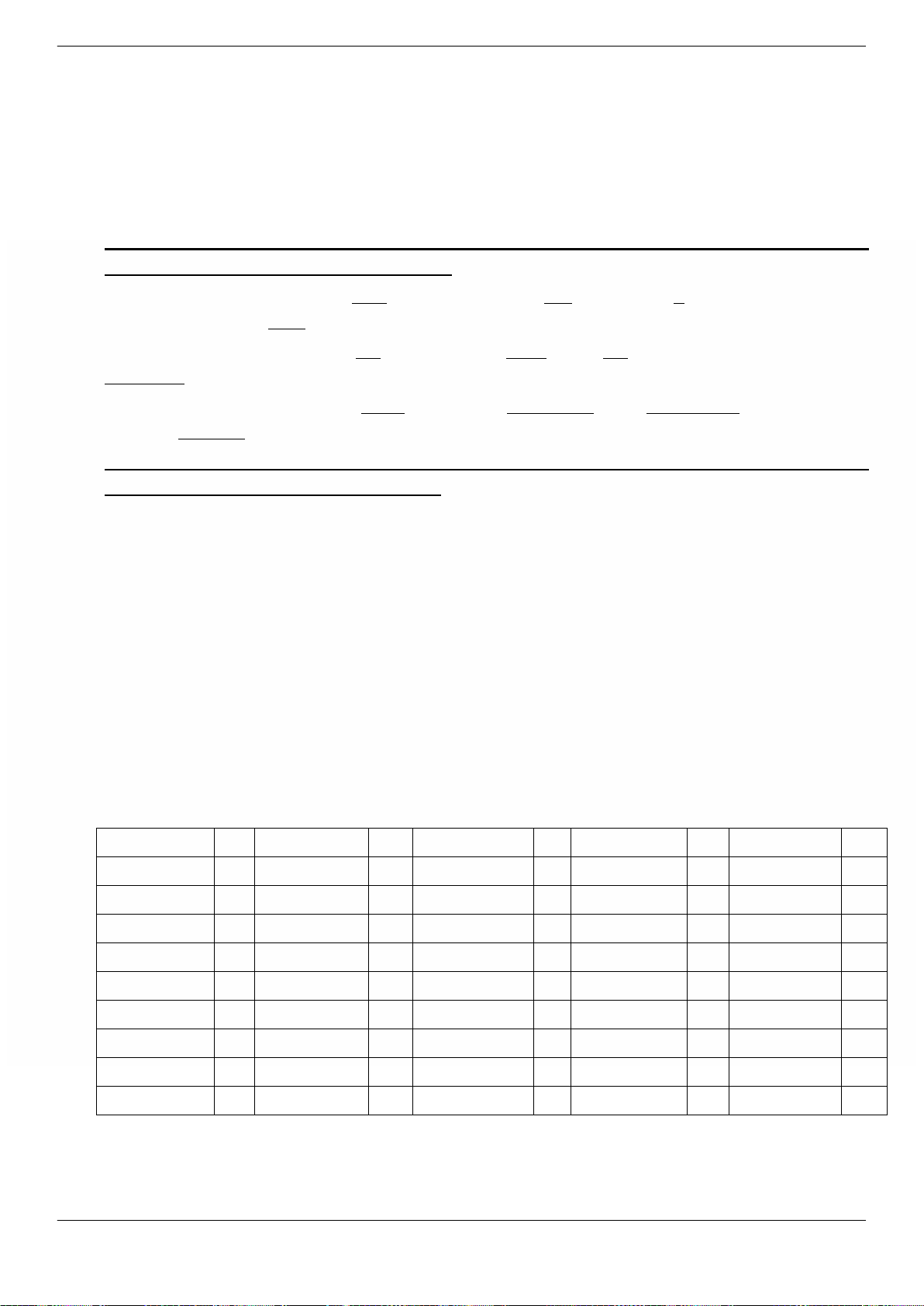
Trang
185
Question 45. "No, I won't go to work at the weekend," said Sally.
A. Sally refused to go to work at the weekend.
B. Sally promised to go to work at the weekend.
C. Sally apologized for not going to work at the weekend.
D. Sally regretted not going to work at the weekend.
Mark the letter A, B, C, or D on your answer sheet to indicate the underlined part that needs
correction in each of the following questions.
Question 46. Animals like frogs have (A) waterproof skin that (B) prevents it (C) from drying out
quickly in air, sun, or wind (D).
Question 47. My brother usually ask (A) me for help when (B) he has (C) difficulty with his
homework (D).
Question 48. Many people object to use (A) physical punishment (B) in dealing with (C) discipline
problems at school (D).
Mark the letter A, B, C, or D on your answer sheet to indicate the sentence that best combines each
pair of sentences in the following questions.
Question 49. Some kinds of fish live in fresh water. Others live in sea water.
A. Some kinds of fish live in fresh water, for others live in sea water.
B. Some kinds of fish live in fresh water, and others live in sea water.
C. Some kinds of fish live in fresh water, or others live in sea water.
D. Some kinds of fish live in fresh water, so others live in sea water.
Question 50. My mother is very busy with her work at the office. She still takes good care of us.
A. In spite of being very busy with her work at the office, my mother takes good care of us.
B. Because my mother is very busy with her work at the office, she takes good care of us.
C. My mother is so busy with her work at the office that she cannot take good care of us.
D. My mother is too busy with her work at the office to take good care of us.
ĐÁP ÁN
Question 1
D
Question 11
B
Question 21
B
Question 31
B
Question 41
B
Question 2
B
Question 12
A
Question 22
B
Question 32
C
Question 42
C
Question 3
D
Question 13
C
Question 23
C
Question 33
A
Question 43
B
Question 4
C
Question 14
C
Question 24
A
Question 34
B
Question 44
B
Question 5
B
Question 15
C
Question 25
A
Question 35
C
Question 45
A
Question 6
D
Question 16
B
Question 26
C
Question 36
A
Question 46
C
Question 7
D
Question 17
C
Question 27
A
Question 37
A
Question 47
A
Question 8
D
Question 18
B
Question 28
A
Question 38
C
Question 48
A
Question 9
A
Question 19
A
Question 29
C
Question 39
B
Question 49
B
Question 10
B
Question 20
C
Question 30
A
Question 40
A
Question 50
A
LỜI GIẢI CHI TIẾT
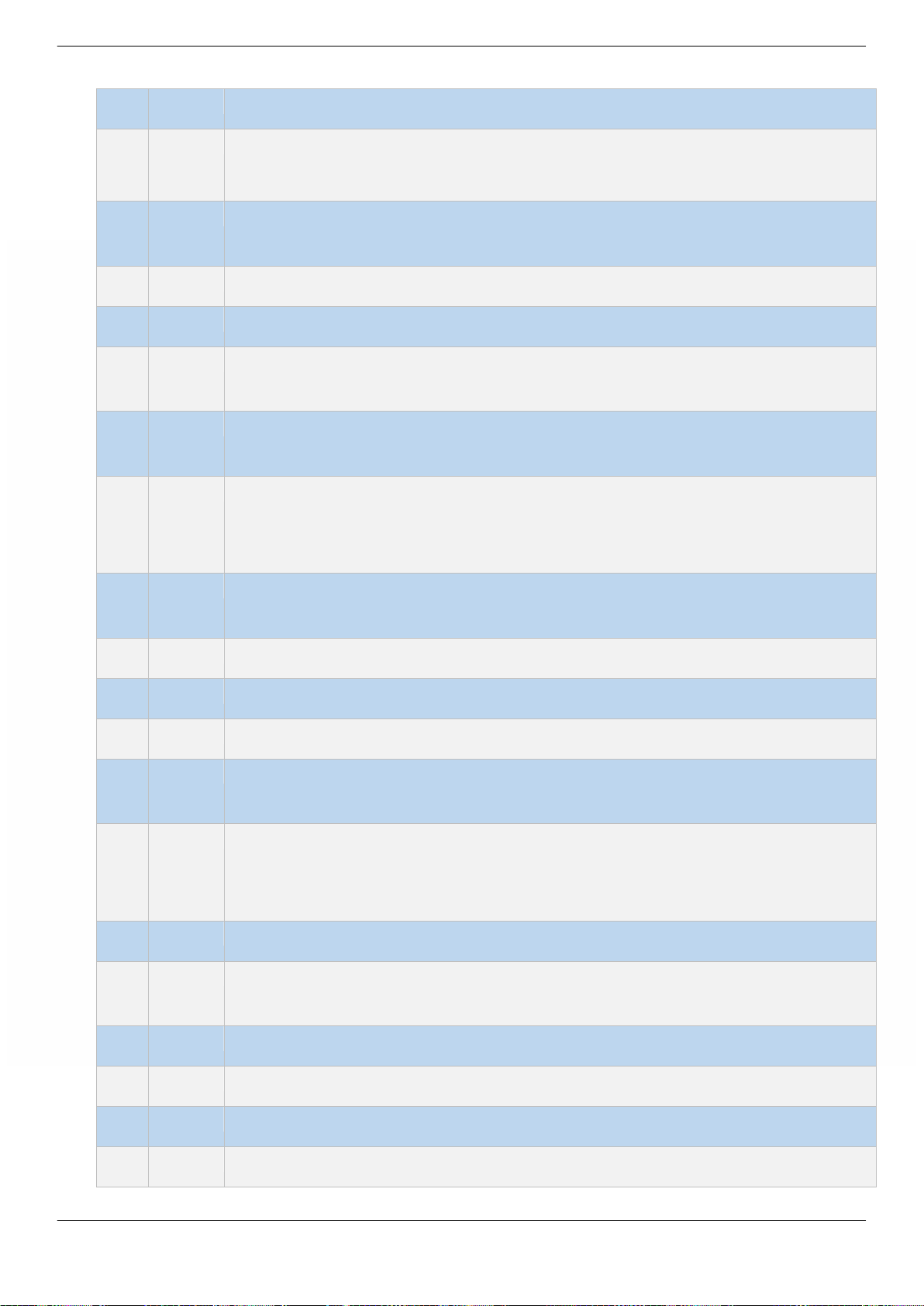
Trang
186
Câu
Đáp án
Giải thích
1.
D
2.
B
3.
D
4.
C
5.
B
6.
D
-
7.
D
8.
D
9.
A
10.
B
11.
B
12.
A
13.
C
14.
C
15.
C
16.
B
17.
C
18.
B
19.
A
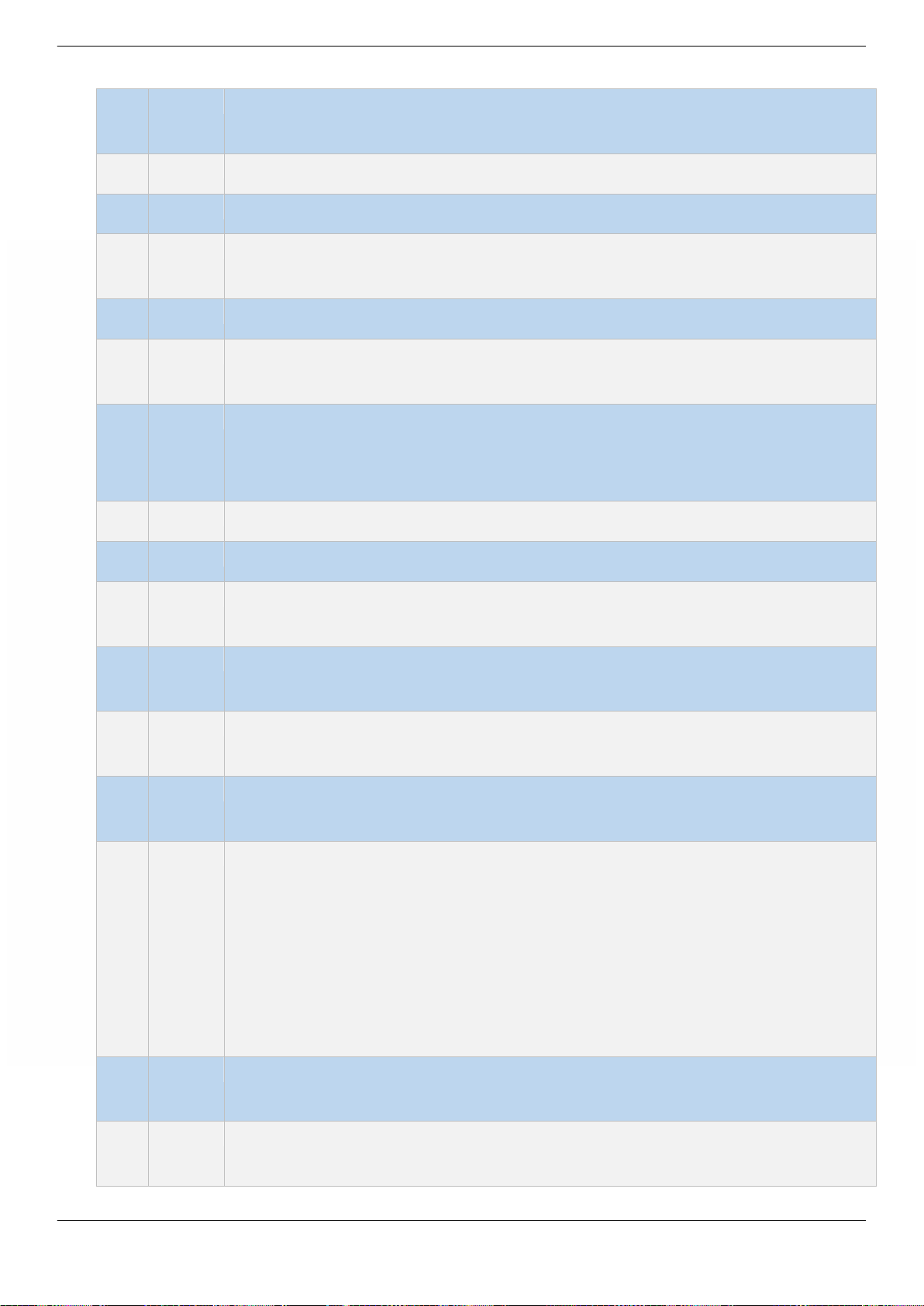
Trang
187
20.
C
- size - age - shape - color - origin - material
- purpose: old (age) black (color) Japanese (origin)
21.
B
22.
B
23.
C
giao
24.
A
25.
A
26.
C
27.
A
28.
A
29.
C
-
30.
A
31.
B
32.
C
33.
A
B. 3)
C. Children hope to get money or gifts from the Tooth Fairy. (câu 3- 3)
D. 3)
Tooth Fairy.
34.
B
35.
C
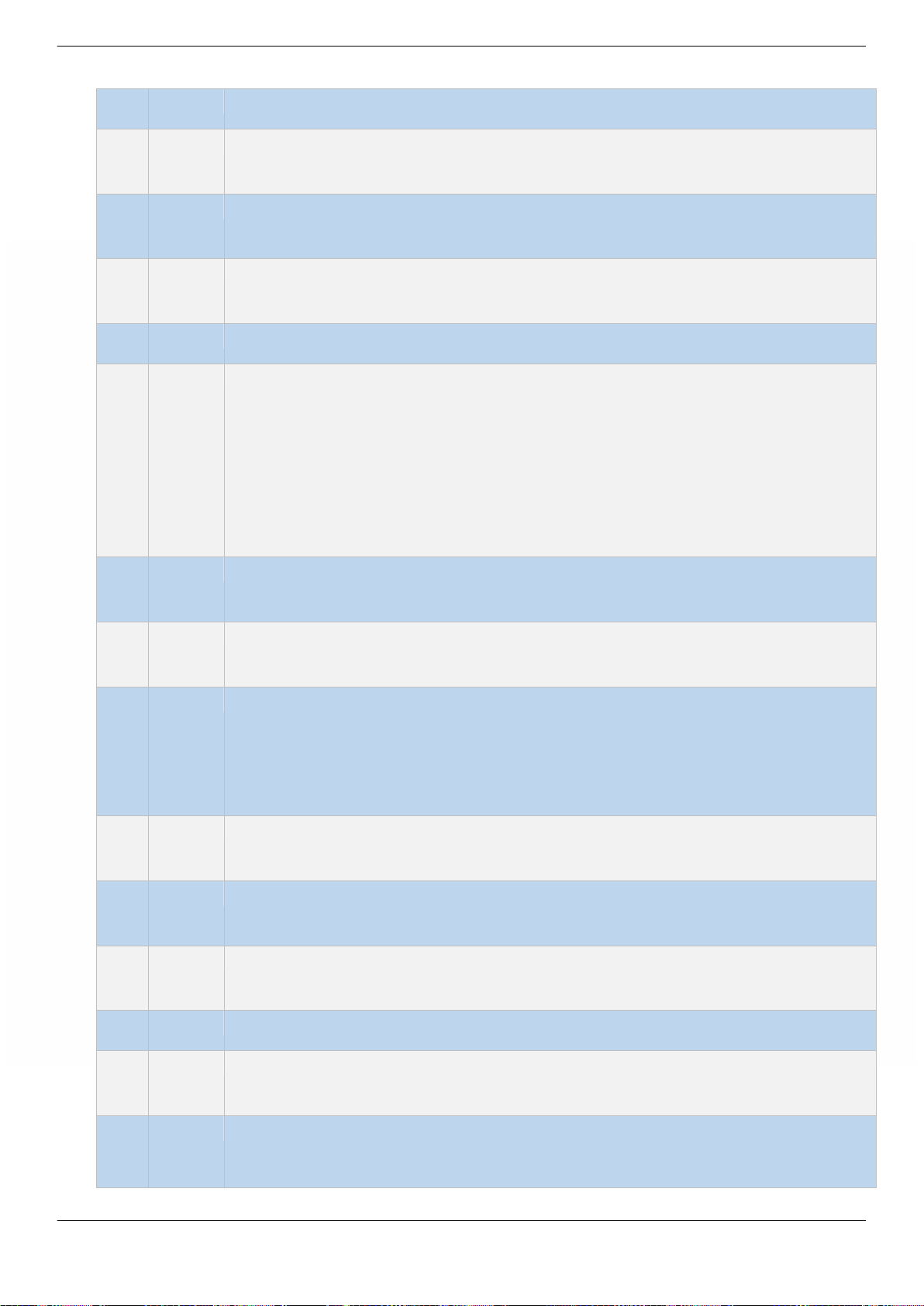
Trang
188
36.
A
37.
A
38.
C
species.
39.
B
40.
A
41.
B
spreads throughout nature.
42.
C
43.
B
44.
B
dây an toàn.
45.
A
46.
C
them.
47.
A
thành asks.
48.
A
49.
B
50.
A
-

Trang
189
-

Trang
190
ĐỀ THAM KHẢO KỲ THI THPTQG – ĐỀ THI SỐ 8
Mark the letter A, B, C, or D on your answer sheet to indicate the correct answer to each of the
following questions.
Question 1. I'm not sure, but Tony probably get that demanding job.
A. must B. need C. ought D.
might Question 2. They were among the first companies to exploit the of
the Internet.
A. potential B. prospect C. possibility D. ability
Question 3. Thanks to her father's encouragement, she has made great in her
study.
A. standard B. development C. contribution D. progress
Question 4. I all of my homework last night.
A. finish B. will finish C. have finished D. finished
Question 5. The people live in this village are very friendly.
A. who B. where C. which D. when
Question 6. Jim didn't break the vase on , but he was still punished for his carelessness.
A. occasion B. chance C. intention D. purpose
Question 7. Domestic appliances like washing machines and dishwashers have made life
much easier.
A. the B. a C. Ø D. an
Question 8. Travelling to countries in the world enables me to learn many interesting
things.
A. differ B. difference C. differently D. different
Question 9. Peter is disappointed at not getting the job, but he will it soon.
A. take on B. get over C. go through D. come over
Question 10. I am not used to the cold weather here, so I need to have a heating system .
A. installed B. serviced C. developed D. repaired
Question 11. The only thing he bought on his trip to Italy was a watch.
A. nice Italian new B. nice new Italian C. new Italian nice D. new nice Italian
Question 12. The more you practise speaking English, .
A. the more fluently you can speak it B. the more fluent you can speak it
C. the more you can speak it fluent D. the more you can speak it fluently
Mark the letter A, B, C, or D on your answer sheet to indicate the most suitable response to
complete each of the following exchanges.
Question 13. Linda is thanking Daniel for his birthday present.
Linda: "Thanks for the book. I've been looking for it for months."
Daniel: " ."
A. You can say that again B. Thank you for looking for it
C. I like reading books D. I'm glad you like it
Question 14. David and his teacher are meeting at the school gate.
David: "Good morning, Mr Deakin. How are you?"

Trang
191
Mr Deakin: " . And you?"

Trang
192
A. I'm busy now B. I'm fine. Thank you
C. I'm going home D. I'm having a class now
Mark the letter A, B, C, or D on your answer sheet to indicate the word that differs from the other
three in the position of primary stress in each of the following questions.
Mark the letter A, B, C, or D on your answer sheet to indicate the word whose underlined part
differs from the other three in pronunciation in each of the following questions.
Mark the letter A, B, C, or D on your answer sheet to indicate the word(s) OPPOSITE in meaning to
the underlined word(s) in each of the following questions.
Question 19. Today students are under a lot of pressure due to the high expectations from their
parents and teachers.
A. nervousness B. emotion C. stress D. relaxation Question 20. Don't tell Jane anything about
the surprise party for Jack. She has got a big mouth.
A. can't eat a lot B. hates parties C. talks too much D. can keep secrets
Mark the letter A, B, C, or D on your answer sheet to indicate the word(s) CLOSEST in meaning to
the underlined word(s) in each of the following questions.
Question 21. The place has rapidly evolved from a small fishing community into a thriving tourist
resort.
A. developed B. generated C. created D. increased
Question 22. Many people left early because the film was uninteresting.
A. exciting B. informative C. attractive D. boring
Read the following passage and mark the letter A, B, C, or D on your answer sheet to indicate the
correct word or phrase that best fits each of the numbered blanks from 23 to 27.
As teenagers approach university level, a decision has to be made on what course to pursue. In
this world of diversity, (23) such a choice is not easy for both children and parents. In the old
days, it was not much a problem to do the task because there were not so many diverse learning areas
to choose from. Besides, there were only a few distinctive professional careers like doctor, engineer,
accountant, nurse, teacher, etc. to think about. Most higher learning usually led to a financially
successful life. (24) , the cost of education was not so high.
Today's world is entirely different from the things (25) have just been described. The job
market is constantly changing due to innovative technology and new (26) . Meanwhile, most
teenagers have difficulty in identifying their own interests. There are a variety of well-organized career
talks and student counseling workshops to guide and help teenagers (27) what course to take.
Furthermore, psychological tests are also used. Certain instruments such as surveys, interviews and
computer software can help to find out preferences, interests, or learning styles of the students.
(Source: Essential Reading for IELTS by Humin & John A. Gordon)
Question 23. A. making
B. taking
C. giving
D. having
Question 24. A. In addition
B. Otherwise
C. For example
D. Therefore
Question 17. A. dressed
B. dropped
C. matched
D. joined
Question 18. A. walk
B. call
C. take
D. talk

Trang
193
Question 25. A. when
B. that
C. what
D. where

Trang
194
Question 26. A. competition
B. competitively
C. competitive
D. compete
Question 27. A. apply
B. study
C. decide
D. employ
Read the following passage and mark the letter A, B, C, or D on your answer sheet to indicate the
correct answer to each of the questions from 28 to 34.
Children all around the world love to read comic books. Maybe they like to read the kind of
comic books that come out once a month, like Spiderman or Batman, or maybe they like manga-style
comic books. That means that publishers who make comic books need to keep in touch with the things
young people like to do. One thing that many young people today are interested in is technology, so of
course kids want to read digital comic books on electronic devices.
Let's take Japanese manga as an example. There are lots of people around the world who enjoy
reading manga. However, in the past, it was difficult to find translated versions of manga in comic
bookstores. But that did not stop manga fans. Some fans who could translate Japanese into their own
language started translating manga themselves. Then they scanned the pages of manga books and
uploaded the scanned pages to the Internet with their translation. This practice has become so popular.
People in the comic book industry made up a name for it. By combining the words scan and
translation, they call it "scanlation", and it is a big problem today. The people who do scanlation
usually share their manga for free, so readers do not buy manga books. Writers, artists, and publishers
all end up losing money because of scanlation. Another problem is piracy in the comic book industry.
Illegal copies of old and brand new comics alike have been hurting comic book sales.
Despite the progress made in converting comics to digital formats, hardcopy comic books are
still by far the most popular format among fans. In the meantime, comic book publishers and stores
will just have to keep an eye on their buyers' habits. As the popularity of digital books for e-readers
and tablets grows, the popularity of digital comic books will grow as well.
(Source: Reading Advantage by Casey Malarcher)
Question 28. What is the passage mainly about?
A. The need for digital comic books
B. Children's most favourite type of books
C. Problems in the book industry
D. The manga industry in Japan
Question 29. The word "they" in paragraph 1 refers to .
A. children B. comic books C. publishers D. things
Question 30. According to paragraph 1, Spiderman is the name of .
A. a TV programme B. a comic book C. an electronic device D. a child
Question 31. According to paragraph 2, the practice of "scanlation" mostly involves .
A. selling translated manga books
B. scanning and translating manga books
C. scanning uploaded manga books
D. translating uploaded manga books
Question 32. According to the passage, in the past, some manga fans who knew Japanese
translated manga because .

Trang
195
A. it was enjoyable to translate Japanese books
B. they wanted to make a name for themselves

Trang
196
C. it was difficult to buy translated manga books
D. they wanted to read manga for free
Question 33. According to paragraph 2, who could benefit from scanlation?
A. Readers B. Publishers C. Writers D. Artists
Question 34. The word "piracy" in paragraph 2 probably means the act of .
A. controlling the production of a book B. hurting the sale of illegal comic books
C. copying and using a book illegally D. advertising a book without permission
Read the following passage and mark the letter A, B, C, or D on your answer sheet to indicate the
correct answer to each of the questions from 35 to 42.
The oceans are so vast and deep that until fairly recently, it was widely assumed that no matter
how much trash and chemicals humans dumped into them, the effects would be negligible. Proponents
of dumping in the oceans even had a catchphrase: "The solution to pollution is dilution."
Today, we need look no further than the New Jersey-size dead zone that forms each summer in
the Mississippi River Delta, or the thousand-mile-wide swath of decomposing plastic in the northern
Pacific Ocean to see that this "dilution" policy has helped place a once flourishing ocean ecosystem on
the brink of collapse.
There is evidence that the oceans have suffered at the hands of mankind for millennia. But recent
studies show that degradation, particularly of shoreline areas, has accelerated dramatically in the past
three centuries as industrial discharge and run-off from farms and coastal cities have increased.
Pollution is the introduction of harmful contaminants that are outside the norm for a given
ecosystem. Common man-made pollutants reaching the oceans include pesticides, herbicides, chemical
fertilizers, detergents, oil, sewage, plastics, and other solids. Many of these pollutants collect at the
ocean's depths, where they are consumed by small marine organisms and introduced into the global
food chain.
Many ocean pollutants are released into the environment far upstream from coastlines. Nitrogen-
rich fertilizers applied by farmers inland, for example, end up in local streams, rivers, and groundwater
and are eventually deposited in estuaries, bays, and deltas. These excess nutrients can spawn massive
blooms of algae that rob the water of oxygen, leaving areas where little or no marine life can exist.
Solid wastes like bags, foam, and other items dumped into the oceans from land or by ships at
sea are frequently consumed, with often fatal effects, by marine mammals, fish, and birds that mistake
them for food. Discarded fishing nets drift for many years, ensnaring fish and mammals. In certain
regions, ocean currents corral trillions of decomposing plastic items and other trash into gigantic,
swirling garbage patches. One in the North Pacific, known as the Pacific Trash Vortex, is estimated to
be the size of Texas.
Pollution is not always physical. In large bodies of water, sound waves can carry undiminished for
miles. The increased presence of loud or persistent sounds from ships, sonar devices, oil rigs, and even
from natural sources like earthquakes can disrupt the migration, communication, and reproduction
patterns of many marine animals, particularly aquatic mammals like whales and dolphins.
(Source: Reading Advantage by Casey Malarcher)
Question 35. What does the passage mainly discuss?
A. Marine pollution and its many forms
B. Noise and its disruptive effects on marine life
C. Various kinds of harmful pollutants

Trang
197
D. The end of the "dilution" era
Question 36. The word "negligible" in paragraph 1 is closest in meaning to .
A. serious B. insignificant C. unpredictable D. positive
Question 37. It can be inferred from paragraph 2 that the "dilution" policy is related to .
A. dealing with the problems of water pollution
B. helping the ecosystem of the oceans flourish
C. neglecting the effects of dumping trash into the oceans
D. treating harmful materials in the oceans properly
Question 38. The word "they" in paragraph 4 refers to .
A. ocean's depths B. man-made pollutants
C. marine organisms D. the oceans
Question 39. The word "spawn" in paragraph 5 can be best replaced by .
A. appear B. prevent C. produce D. limit
Question 40. According to the passage, nitrogen-rich fertilizers .
A. are created by massive blooms of algae
B. cause a shortage of oxygen in the ocean water
C. do not relate to the disappearance of marine life
D. cannot be found inland
Question 41. Which of the following statements is NOT supported in the passage?
A. Many pollutants deposited in the oceans finally become part of the global food chain.
B. It is apparent that the oceans have been polluted for a long time.
C. Industrial wastes and agricultural run-off are blamed for the degradation of the oceans.
D. The oceans in the past were more contaminated than they are now.
Question 42. Whales and dolphins are mentioned in the final paragraph as an example of marine
creatures that .
A. can communicate with each other via sound waves
B. can survive earthquakes because of their large bodies
C. suffer from loud or persistent sounds at sea
D. are forced to migrate because of water pollution
Mark the letter A, B, C, or D on your answer sheet to indicate the underlined part that needs
correction in each of the following questions.
Question 43. All the judges paid the dancer compliments on their excellent performance in the
A B C D
competition.
Question 44. The policeman warned the tourists not walking alone in empty streets at night.
A B C D
Question 45. My mother always get up early to prepare breakfast for everyone in the family.
A B C D
Mark the letter A, B, C, or D on your answer sheet to indicate the sentence that is closest in
meaning to each of the following questions.
Question 46. He last visited London three years ago.

Trang
198
A. He has been in London for three years. B. He hasn't visited London for three years.
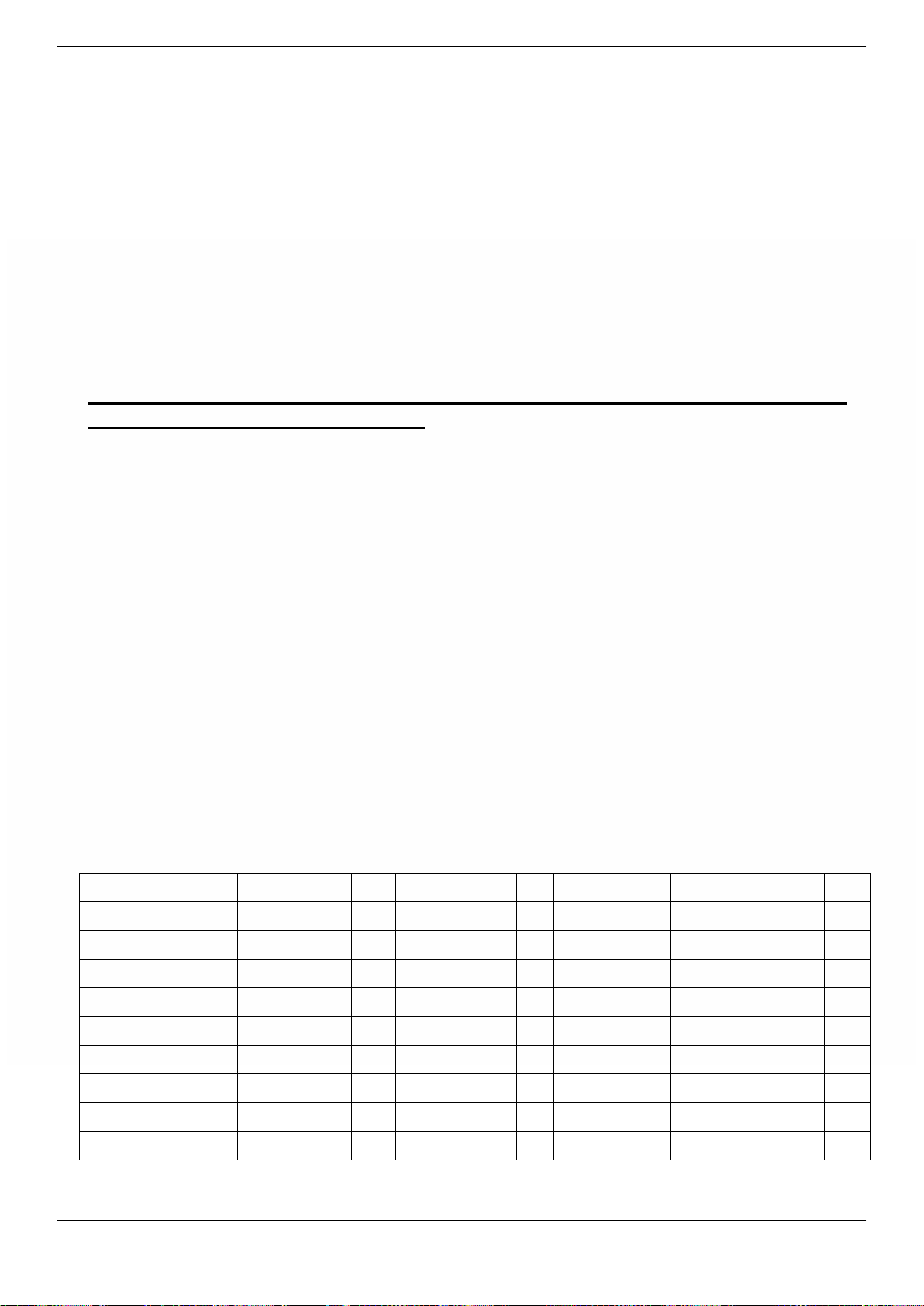
Trang
199
C. He didn't visit London three years ago. D. He was in London for three years.
Question 47. They were late for the meeting because of the heavy snow.
A. If it snowed heavily, they would be late for the meeting.
B. Had it not snowed heavily, they would have been late for the meeting.
C. But for the heavy snow, they wouldn't have been late for the meeting.
D. If it didn't snow heavily, they wouldn't be late for the meeting.
Question 48. "We will not leave until we see the manager," said the customers.
A. The customers promised to leave before they saw the manager.
B. The customers refused to leave until they saw the manager.
C. The customers agreed to leave before they saw the manager.
D. The customers decided to leave because they did not see the manager.
Mark the letter A, B, C, or D on your answer sheet to indicate the sentence that best combines each
pair of sentences in the following questions.
Question 49. The government have established some wildlife reserves. They want to protect
endangered species.
A. Whether the government have established some wildlife reserves or not, endangered species are
still protected.
B. Endangered species can't be protected although the government have established some wildlife
reserves.
C. The government have established some wildlife reserves so that endangered species can be
protected.
D. If the government established some wildlife reserves, they would be able to protect endangered
species.
Question 50. My sister is good at cooking. My brother is bad at it.
A. My sister is good at cooking, or my brother is bad at it.
B. My sister is good at cooking, for my brother is bad at it.
C. My sister is good at cooking, but my brother is bad at it.
D. My sister is good at cooking, so my brother is bad at it.
Question 1
D
Question 11
B
Question 21
A
Question 31
B
Question 41
D
Question 2
A
Question 12
A
Question 22
D
Question 32
C
Question 42
C
Question 3
D
Question 13
D
Question 23
A
Question 33
A
Question 43
C
Question 4
D
Question 14
B
Question 24
A
Question 34
C
Question 44
B
Question 5
A
Question 15
D
Question 25
B
Question 35
A
Question 45
A
Question 6
D
Question 16
C
Question 26
A
Question 36
B
Question 46
B
Question 7
C
Question 17
D
Question 27
C
Question 37
C
Question 47
C
Question 8
D
Question 18
C
Question 28
A
Question 38
B
Question 48
B
Question 9
B
Question 19
D
Question 29
A
Question 39
C
Question 49
C
Question 10
A
Question 20
D
Question 30
B
Question 40
B
Question 50
C

Trang
200
Câu
Đáp án
Giải thích
1.
D
2.
A
3.
D
4.
D
5.
A
6.
D
7.
C
8.
D
9.
B
10.
A
11.
B
tính OSAShCOMP: Opinion - Size - Age - Shape - Color - Origin-
Material - Purpose: nice (opinion) new (Age) Italian (origin)
12.
A
13.
D
khi ai mình gì, ta có nói
14.
B
15.
D
16.
C
17.
D
18.
C
19.
D
20.
D
21.
A

Trang
201
22.
D
23.
A
24.
A
25.
B
26.
A
27.
C
28.
A
29.
A
Children.
30.
B
31.
B
32.
C
33.
A
34.
C
35.
A
36.
B
37.
C
38.
B

Trang
202
39.
C
40.
B
Nitrogen-
or no
41.
D
42.
C
communication, and reproduction patterns of many marine animals, particularly
aquatic mammals like wh
43.
C
44.
B
45.
A
46.
B
47.
C
48.
B
49.
C
50.
C

Trang
203
câu ghép.
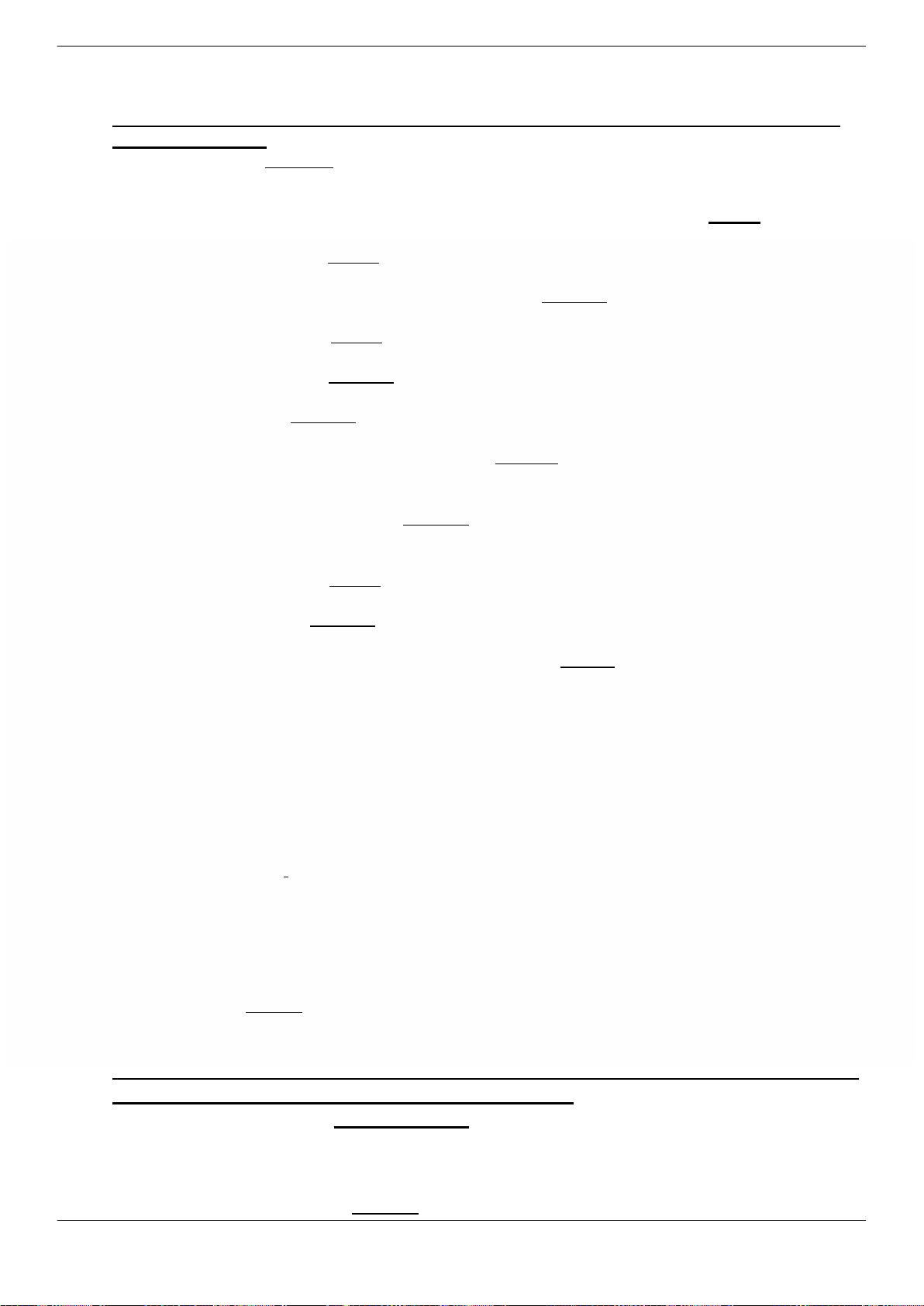
Trang
204
ĐỀ THAM KHẢO KỲ THI THPTQG – ĐỀ THI SỐ 9
Mark the letter A, B, C, or D on your answer sheet to indicate the correct answer to each of the
following questions.
Question 1. Lan learning English a few years ago.
A. starts B. will start C. started D. is starting
Question 2. We moved to the countryside because we wanted to be close to nature.
A. a B. the C. an D. Ø
Question 3. The water _ in the area has resulted in poor crop production.
A. absence B. shortage C. lack D. deficiency
Question 4. In Vietnam, children begin their primary at the age of six.
A. educational B. educationally C. educate D. education
Question 5. Could you _ me a hand with the washing-up, Kent?
A. join B. shake C. give D. hold
Question 6. All students hand in their assignments by Friday at the latest.
A. ought B. might C. must D. may
Question 7. I met a girl at my friend's birthday party last Sunday.
A. pretty American tall B. tall pretty American C. tall American pretty D. pretty tall American
Question 8. The company management decided to more workers to meet the production
schedule.
A. take on B. make out C. take over D. make up
Question 9. I will phone Vivian to her to buy some sugar; otherwise, she will
forget.
A. remind B. encourage C. allow D. advise
Question 10. We were _ by the spectacular scenery of the countryside.
A. overwhelmed B. bewildered C. preoccupied D. overjoyed
Question 11. The boy sits in front of me in the class studies very hard.
A. who B. where C. which D. when
Question 12. The larger the area of forest is destroyed, .
A. the most frequent natural disasters are B. the most frequently natural disasters occur
C. the more frequent are natural disasters D. the more frequently natural disasters
occur Mark the letter A, B, C, or D on your answer sheet to indicate the most suitable response
to complete each of the following exchanges.
Question 13. Mary and John are meeting at the cinema.
Mary: "Hi, John. How are
you?" John: " . And you?"
A. Fine, thanks B. I'm thirty-five years old
C. I'm free today D. I'm not working today
Question 14. Mrs Smith and her students are visiting the zoo.
Mike: "Can I feed the gorilla, Mrs Smith?"
Mrs Smith: " . The sign says 'No feeding the animals'."
A. Of course you can B. I don't think it works
C. I'm sure about that D. I'm afraid not
Mark the letter A, B, C, or D on your answer sheet to indicate the word(s) OPPOSITE in meaning
to the underlined word(s) in each of the following questions.
Question 15. I'm sure he will be home and dry in the interview because he has good
qualifications and wide experience.
A. be successful B. be satisfied C. be unsuccessful D. be unsatisfied
Question 16. Many people feel nervous when they first make a speech in public.

Trang
205
A. impressed B. fearful C. confident D. upset
Mark the letter A, B, C, or D on your answer sheet to indicate the word(s) CLOSEST in
meaning to the underlined word(s) in each of the following questions.
Question 17. Tim and Tom look similar although they are not brothers.
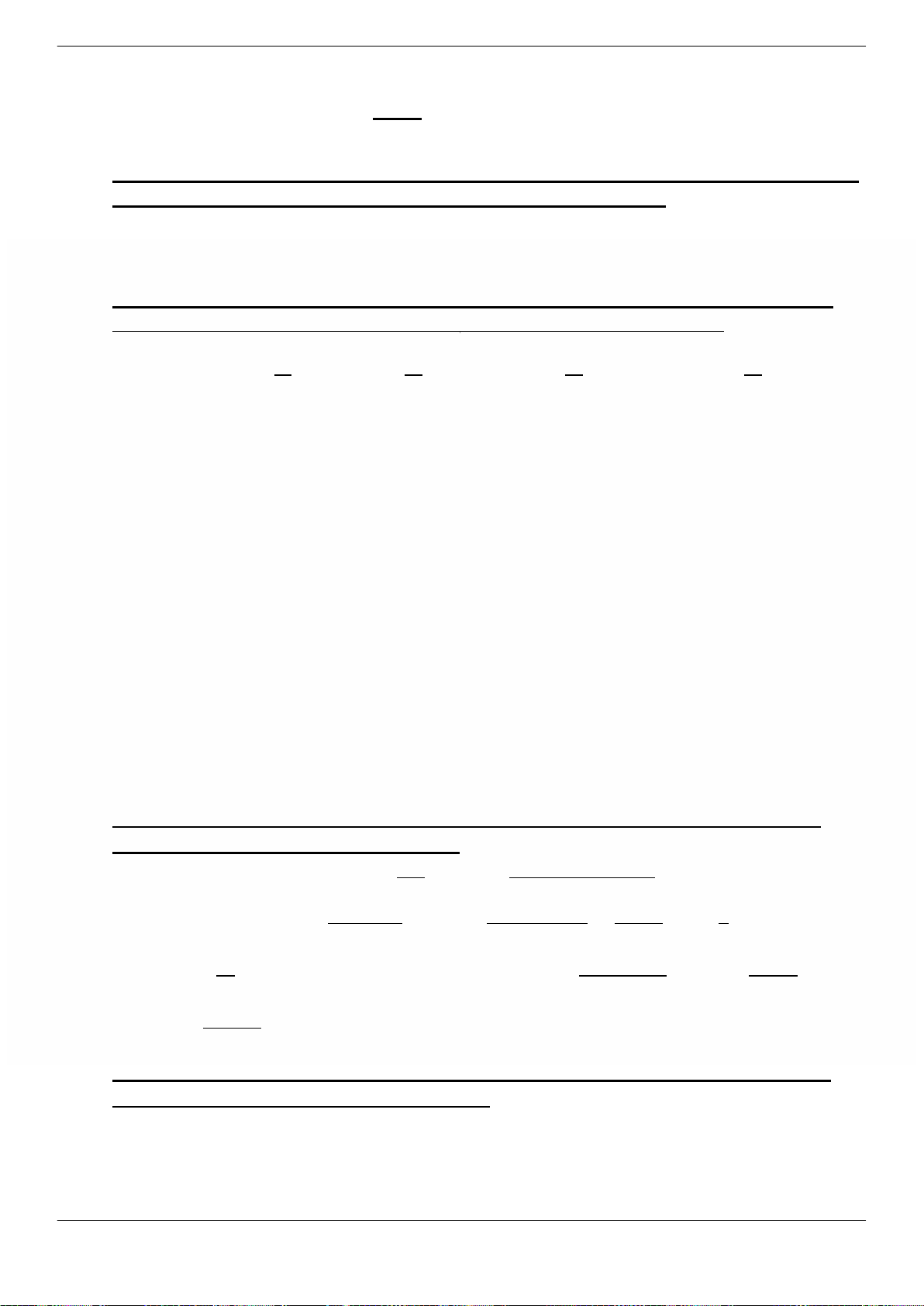
Trang
206
A. different B. alike C. familiar D. strange
Question 18. There weren't many tough questions in the exam, so I could answer most of them.
A. simple B. difficult C. important D. interesting
Mark the letter A, B, C, or D on your answer sheet to indicate the word that differs from the other
three in the position of primary stress in each of the following questions.
Question 19. A. difficult B. popular C. effective D. national
Question 20. A. answer B. reply C. singer D. future
Mark the letter A, B, C, or D on your answer sheet to indicate the word whose underlined part
differs from the other three in pronunciation in each of the following questions.
Mark the letter A, B, C, or D on your answer sheet to indicate the sentence that is closest in
meaning to each of the following questions.
Question 23. "Why don't we go camping at the weekend?" he said.
A.
He denied going camping at the weekend.
B.
He suggested going camping at the weekend.
C.
He objected to going camping at the weekend.
D.
He apologized for going camping at the weekend.
Question 24. He was successful in his career thanks to his parents' support.
A.
Had it not been for his parents' support, he wouldn't be successful in his career.
B.
If his parents hadn't supported him, he wouldn't have been successful in his career.
C.
But for his parents' support, he wouldn't be successful in his career.
D.
Without his parents' support, he would have been successful in his career.
Question 25. I haven't visited my hometown for a few years.
A.
I have been in my hometown for a few years.
B.
I last visited my hometown a few years ago.
C.
I didn't visit my hometown a few years ago.
D.
I was in my hometown for a few years.
Mark the letter A, B, C, or D on your answer sheet to indicate the underlined part that needs
correction in each of the following questions.
Question 26. She always try to finish her homework before going to bed.
A B C D
Question 27. Children learn primarily by directly experiencing the world around it.
A B C D
Question 28. A number of wildlife habitat reserves have been established in order to saving
A B C
endangered species from extinction.
D
Mark the letter A, B, C, or D on your answer sheet to indicate the sentence that best combines
each pair of sentences in the following questions.
Question 29. Mai usually helps her classmates with their studies. Her classmates appreciate her.
A.
Mai usually helps her classmates with their studies, but they appreciate her.
B.
Mai usually helps her classmates with their studies, for they appreciate her.
C.
Mai usually helps her classmates with their studies, so they appreciate her.
D.
Mai usually helps her classmates with their studies, or they appreciate her.
Question 30. We cannot completely avoid stress in our lives. We need to find ways to cope with it.
Question 21. A. find
B. think
C. drive
D. mind
Question 22. A. missed
B. talked
C. watched
D. cleaned

Trang
207
A.
As long as we can completely avoid stress in our lives, we need to find ways to cope with it.
B.
After we can completely avoid stress in our lives, we need to find ways to cope with it.
C.
Since we cannot completely avoid stress in our lives, we need to find ways to cope with it.
D.
Because stress can completely be avoided in our lives, we need to find ways to cope with it.

Trang
208
Read the following passage and mark the letter A, B, C, or D on your answer sheet to indicate the
correct word or phrase that best fits each of the numbered blanks from 31 to 35.
Graphic novels, as the name suggests, are books written and illustrated in the style of a
comic book. Adults may feel that graphic novels do not help children become good readers. They
believe that this type of reading material somehow prevents "real" reading. (31) ,
many quality graphic novels are now being seen as a method of storytelling on the same level as
novels, films or audiobooks. Many librarians and teachers are now accepting graphic novels as
proper literature for children as they (32) young people and motivate them to read. This
has been especially true with children who are not (33) to read, especially boys.
Language learners are also motivated by graphic novels because the pictures provide clues
to the meaning of the words. Therefore, they will (34) new vocabulary more quickly.
Many teachers have reported great success when they used graphic novels with their students,
especially in the areas of English, social studies and art. The idea that graphic novels are too
simple to be regarded as serious reading is no longer valid. Reading them can, undoubtedly, help
students develop the skills (35) are necessary to read more challenging works.
(Source: Complete IELTS by Rawdon Wyatt)
Question 31.
A. Otherwise
B. Therefore
C. However
D. In addition
Question 32.
A. attract
B. attractively
C. attraction
D. attractive
Question 33.
A. active
B. willing
C. careful
D. able
Question 34.
A. learn
B. take
C. know
D. accept
Question 35.
A. where
B. that
C. who
D. when
Read the following passage and mark the letter A, B, C, or D on your answer sheet to indicate the
correct answer to each of the questions from 36 to 42.
Most weddings in Japan start with a religious ceremony in which usually only family members
attend. Afterwards, a banquet is customarily held to which many people, including friends and
colleagues, are invited. To celebrate the happy occasion, guests give the bride and groom goshuugi
gift money in special envelopes. Goshuugi from friends is usually 20,000 yen or 30,000 yen.
A typical Japanese wedding party starts when the bride and groom enter the banquet hall
together, and take their seats on a slightly raised platform facing their guests. Invited guests are
seated closer to the bride and groom, with family and relatives seated further in back. The bride's
and groom's bosses usually give congratulatory speeches then their friends sing in celebration. Other
wedding highlights include a candle ceremony where the couple holds a candle while greeting their
guests at each table, and the cutting of the wedding cake. Afterwards, the bride and groom thank
their parents with a speech, then leave to end the party.
In the past, dishes that supposedly brought good fortune, such as prawns and sea breams, were
served in abundance. So much of the food was ordered that guests ended up taking the surplus home.
Today, the majority of the weddings serve just enough for everyone. Additionally, before leaving,
guests would traditionally receive souvenir gifts called hikidemono.
Many wedding ceremonies take place at wedding halls or hotels. Rough estimates show that it
costs about 3 million yen to host a wedding party for 80 guests. During Japan's economic bubble,
overseas weddings and flamboyant receptions with special effects, such as smoke machines and
having the bride and groom fly in on gondolas, were very popular. But these days, couples choose to

Trang
209
tie the knot in various ways, from not having any ceremony to having a modest affair, or still going
all out.
(Source: http://www.hiraganatimes.com)
Question 36. What is the main idea of this passage?
A.
Dishes served at Japan's wedding parties in the past
B.
Wedding ceremonies in Japan's economic bubble
C.
Popular wedding gifts in Japan
D.
Wedding ceremonies in Japan
Question 37. According to the passage, goshuugi is .
A. an important guest B. a happy occasion C. a type of food D. a kind of gift
Question 38. The word "their" in paragraph 2 refers to .
A. the couple's B. the parents' C. the relatives' D. the friends'
Question 39. According to paragraph 2, which of the following do the bride and groom do at their
wedding party?
A.
They deliver a speech to thank their parents.
B.
They sit on a platform at the back of the stage.
C.
They hold a candle and sing in celebration.
D.
They give a speech to thank their bosses.
Question 40. The word "fortune" in paragraph 3 is closest in meaning to _ .
A. excitement B. luck C. money D. benefit
Question 41. How were the wedding dishes in the past different from those of today?
A. They were more delicious. B. They were less delicious.
C. They were served in smaller amounts. D. They were served in larger amounts.
Question 42. The phrase "tie the knot" in paragraph 4 could be best replaced by .
A. get engaged B. get married
C. fasten the rope D. loosen the tie
Read the following passage and mark the letter A, B, C, or D on your answer sheet to indicate the
correct answer to each of the questions from 43 to 50.
Humans are bringing about another global-scale change in the atmosphere: the increase in
what are called greenhouse gases. Like glass in a greenhouse, these gases admit the Sun's light but
tend to reflect back downward the heat that is radiated from the ground below, trapping heat in the
Earth's atmosphere. This process is known as the greenhouse effect. Carbon dioxide is the most
significant of these gases there is 25 percent more carbon dioxide in the atmosphere today than
there was a century ago, the result of our burning coal and fuels derived from oil. Methane, nitrous
oxide, and CFCs are greenhouse gases as well.
Scientists predict that increases in these gases in the atmosphere will make the Earth a warmer
place. They expect a global rise in average temperature somewhere between 1.0 and 3.5 degrees
Celsius in the next century. Average temperatures have in fact been rising and the years from 1987
to 1997 were the warmest years on record. Some scientists are reluctant to say that global warming
has actually begun because climate naturally varies from year to year and decade to decade, and it
takes many years of records to be sure of a fundamental change. There is little disagreement, though,
that global warming is looming.
Global warming will have different effects in different regions. A warmed world is expected
to have more extreme weather, with more rain during wet periods, longer droughts, and more

Trang
210
powerful storms. Although the effects of future climate changes are unknown, some predict that
exaggerated weather conditions may translate into better agricultural yields in areas such as the

Trang
211
western United States, where temperature and rainfall are expected to increase, while dramatic
decreases in rainfall may lead to severe droughts and plunging agricultural yields in parts of Africa,
for example.
Warmer temperatures are expected to partially melt the polar ice caps, leading to a projected
sea level rise of 50 centimeters by the year 2050. A sea level rise of this magnitude would flood
coastal cities, force people to abandon low-lying islands, and completely inundate coastal wetlands.
Diseases like malaria, which at present are primarily found in the tropics, may become more
common in the regions of the globe between the tropics and the polar regions, called the temperate
zones. For many of the world's plant species, and for animal species that are not easily able to shift
their territories as their habitat grows warmer, climate change may bring extinction.
(Source: Microsoft ® Encarta ® 2009. © 1993-2008 Microsoft Corporation)
Question 43. Which of the following could be the best title of the passage?
A.
Global Warming: Problems and Solutions
B.
Global Warming: Advantages and Disadvantages
C.
Global Warming: Future Reactions
D.
Global Warming: Possible Causes and Effects
Question 44. According to paragraph 1, which of the following factors causes an increase in
greenhouse gases?
A. Glass in a greenhouse B. Humans
C. Carbon dioxide D. Solar radiation
Question 45. The word "They" in paragraph 2 refers to .
A. scientists B. temperatures C. gases D. increases
Question 46. The word "looming" in paragraph 2 probably means .
A. fading B. showing C. ending D. appearing
Question 47. According to the passage, which of the following is NOT true?
A.
Few scientists agree that global warming is looming.
B.
Global climate naturally changes over time.
C.
Changes in climate are not easy to be documented.
D.
Some scientists are not sure that global warming has begun.
Question 48. The word "plunging" in paragraph 3 probably means .
A. improving B. increasing C. preventing D. decreasing
Question 49. What may be the benefit of exaggerated weather conditions for the western United States?
A. Minimal natural disasters B. Higher agricultural production
C. Decrease in rainfall during wet periods D. Favourable weather conditions
Question 50. Which of the following best describes the tone of the passage?
A. Sarcastic B. Informative C. Ironic D. Argumentative

Trang
212
ÁN
Question 1
C
Question 11
A
Question 21
B
Question 31
C
Question 41
D
Question 2
D
Question 12
D
Question 22
D
Question 32
A
Question 42
B
Question 3
B
Question 13
A
Question 23
B
Question 33
B
Question 43
C
Question 4
D
Question 14
D
Question 24
B
Question 34
A
Question 44
B
Question 5
C
Question 15
C
Question 25
B
Question 35
B
Question 45
A
Question 6
C
Question 16
C
Question 26
A
Question 36
D
Question 46
D
Question 7
D
Question 17
B
Question 27
D
Question 37
D
Question 47
A
Question 8
A
Question 18
B
Question 28
C
Question 38
A
Question 48
D
Question 9
A
Question 19
C
Question 29
C
Question 39
A
Question 49
B
Question 10
A
Question 20
B
Question 30
C
Question 40
B
Question 50
B
Câu
Đáp án
Giải thích
1.
C
Started: a few years ago.
2.
D
Nature: tự nhiên a/an/
the
3.
B
Shortageof
shortage water shortage
4.
D
Educationprimary
Ở Việt Nam, trẻ em bắt đầu học tiểu học lúc 6 tuổi.
5.
C
Give: give sb a hand
6.
C
MusTất cả các học
sinh phải nộp bài muộn nhất là thứ 6
7.
D
Pretty tall American: opinion-size-shape-age-color-
origin
8.
A
Take onCông ty quẩn lý đã quyết định tiếp nhận thêm
nhiều công nhân để đáp ứng kế hoạch sản xuất
9.
A
Remind: Remind sb to do st
10.
A
Overwhemed: were/was
+ P
II
,
11.
A
Who: who sits in front of me
the boy
12.
D
The more frequently natural disasters occurThe + từ dạng
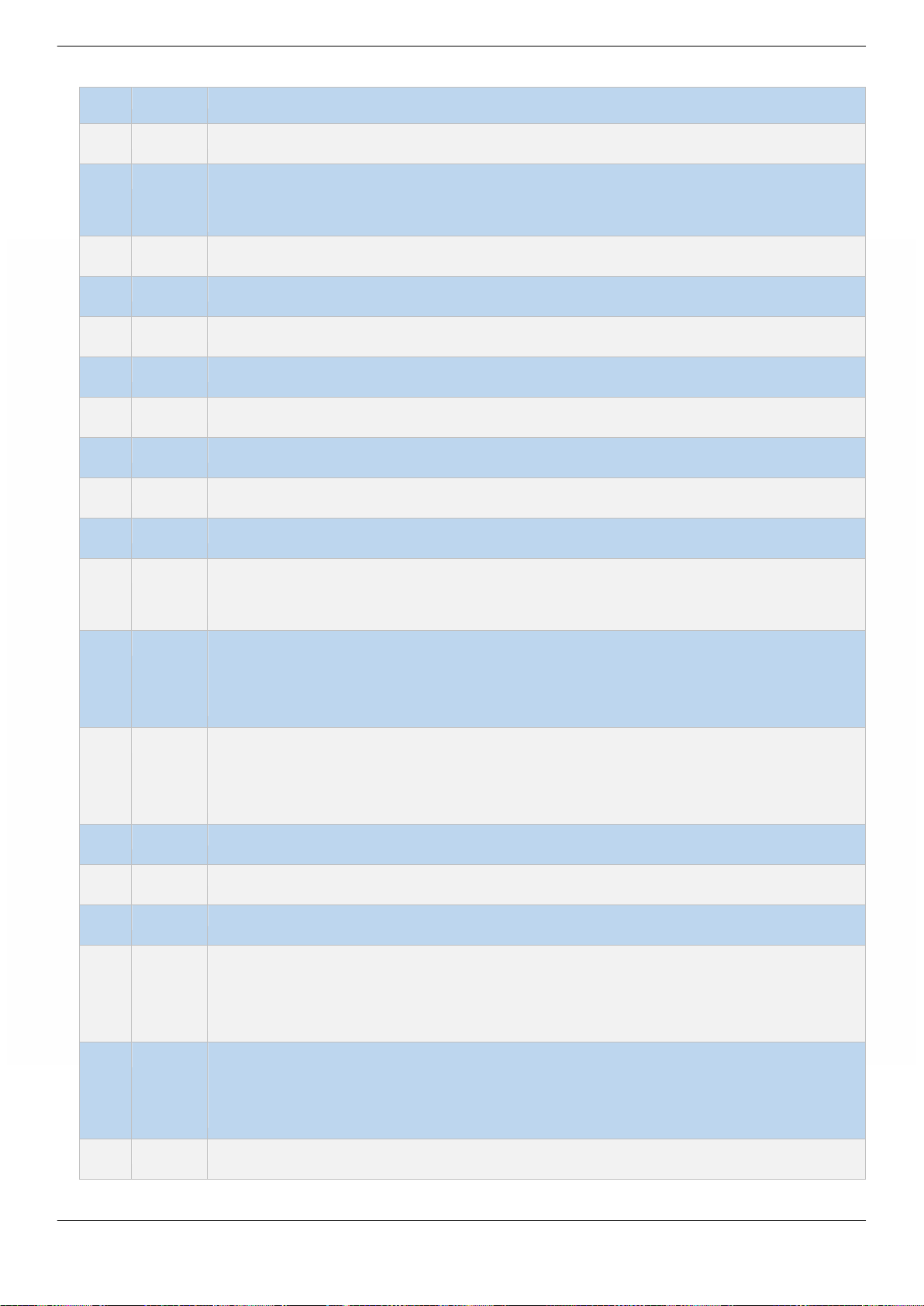
Trang
213
so sánh + S +V, the + từ dạng so sánh.
13.
A
Fine, thanks:
14.
D
lam afraid not: Cô e là không, biển báo ghi là không
cho động vật ăn
15.
C
Be unsuccessful # be home and dry: không thành công # xuôi chèo mát mái
16.
C
Confident # nervous:
17.
B
Alike = similar:
18.
B
Difficult = tough:
19.
C
Effective:
20.
B
Reply:
21.
B
Think: m, /ai/.
22.
D
Cleaned:
23.
B
He suggested going camping at the weekend
Suggest + Ving = Why don’t we + V ?= Let’s + V.
24.
B
If his parents hadn't supported him, he wouldn't have been successful in his
career = Nếu bố mẹ không giúp đỡ, anh ta không thể thành công trong sự nghiệp.
25.
B
I last visited my hometown a few years ago = lần cuối cùng tôi thăm quê cách đây
vài năm
few years.)
26.
A
Try - tries: -
27.
D
It - them children -
28.
C
Saving - -
29.
C
Mai usually helps her classmates with their studies, so they appreciate her.
30.
C
Since we cannot completely avoid stress in our lives, we need to find ways to
cope with it. Câu mang quan nguyên nhân - nên dùng
since
31.
C
However: Tuy nhiên -
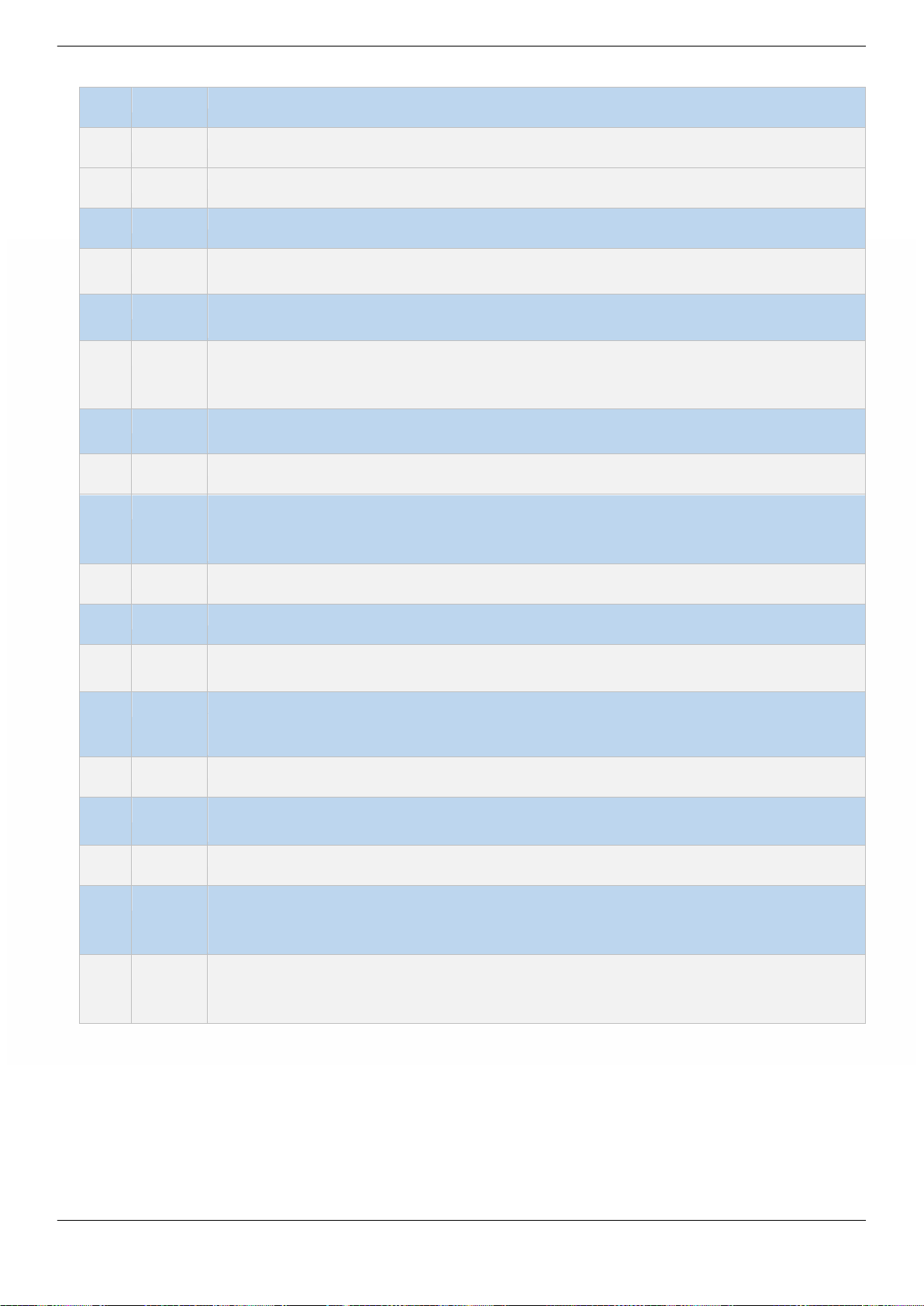
Trang
214
32.
A
Attract
33.
B
Willingbe willing to do st
34.
A
Learnto learn new vocabulary
35.
B
That
36.
D
Wedding ceremonies in Japan =
37.
D
A kind of gift
the bride and groom goshuugi - gift money in special envelopes.
38.
A
The couple’s
where the couple holds a candle while greeting their guests at each table, and the
cutting of the wedding cake
39.
A
They deliver a speech to thank their parents
groom thank their parents with a speech, then leave to end the party.
40.
B
Luck
41.
D
They were served in larger amounts
câu: So much of the food was ordered that guests end up taking the surplus home.
Today, the majority of the weddings serve just enough for everyone.
42.
B
Get married
43.
C
Global Warming
44.
A
Humans-scale change in the
atmosphere: the increase in what are called greenhouse gases.
45.
D
Scientists
will make the Earth a warmer place. They expect a global rise in average temperature
somewhere between 1.0 and 3.5 degrees Celsius in the next century.
46.
A
Appearing (v) = looming
47.
D
Few scientists agree that global warming is looming
disagreement, though, that global warming is looming.
48.
B
Decreasing (v) = plunging
49.
B
Higher agricultural production
conditions may translate into better agricultural yields in areas such as the western
United States.
50.
B
Informative

Trang
215
ĐỀ THAM KHẢO KỲ THI THPTQG – ĐỀ THI SỐ 10
Mark the letter A, B, C, or D on your answer sheet to indicate the most suitable
response to complete each of the following exchanges.
Question 1. Anna and Ms White are meeting in a bookshop.
Anna: "Good morning, Ms White. How are you?"
Ms White: "Hi, Anna. . And you?"
A. I'm fine, thanks B. I'm forty years old
C. I'm not working today D. I'm looking for a book
Question 2. Andrew is talking to a waiter in a restaurant.
Andrew: "Can I have the bill, please?"
Waiter: " ."
A. You are very kind B. Just a minute, please
C. My pleasure D. You're exactly right
Mark the letter A, B, C, or D on your answer sheet to indicate the word(s) CLOSEST in
meaning to the underlined word(s) in each of the following questions.
Question 3. They are going to declare details of the plan to the public later this week.
A. announce B. infer C. remind D. notice
Question 4. It rained so hard that the roads were quickly covered in water.
A. heavily B. lightly C. softly D. badly Mark
the letter A, B, C, or D on your answer sheet to indicate the word(s) OPPOSITE in
meaning to the underlined word(s) in each of the following questions.
Question 5. If you are at a loose end tomorrow, why don't we spend the day sunbathing
and relaxing on the beach?
A. having a lot to do B. having nothing to do
C. having nothing to lose D. having a lot to gain
Question 6. The twin girls are so identical that I can't distinguish one from the other.
A. similar B. alike C. different D. changeable
Mark the letter A, B, C, or D on your answer sheet to indicate the word whose
underlined part differs from the other three in pronunciation in each of the following
questions. Question 7. A. washed B. passed C. worked
D. opened
Question 8. A. hate B. face C. make D. dance
Mark the letter A, B, C, or D on your answer sheet to indicate the word that differs from the
other three in the position of primary stress in each of the following questions.
Question 9. A. medical B. essential C. dangerous D. regular
Question 10. A. doctor B. student C. advice D. parent
Mark the letter A, B, C, or D on your answer sheet to indicate the correct answer to each of the
following questions.

Trang
216
Question 11. The dog my father gave me is very lovely.
A. who B. when C. which D. where
Question 12. There has been growing public concern about the use of chemicals in food
recently.
A. preservation B. protection C. reservation D. conservation
Question 13. Peter bought a car as a present for his wife two weeks ago.
A. new German red B. red German new C. red new German D. new red German
Question 14. You pass the exam in order to graduate from high school.
A. must B. can C. may D. might
Question 15. During a job interview, candidates are advised to on the interviewer's
questions and make an effort to answer them properly.

Trang
217
A. emphasize B. decide C. concentrate D. rely
Question 16. The higher the cost of living is, .
A. the life of the immigrants becomes the harder
B. the hardest the life of the immigrants becomes
C. the harder does the life of the immigrants become
D. the harder the life of the immigrants becomes
Question 17. Harmful environmental factors can the development of certain diseases.
A. generate B. accelerate C. produce D. monitor
Question 18. Last week, we an interesting film about the animal world.
A. see B. saw C. are seeing D. will see
Question 19. The pace of life is much slower in the country than in the city.
A. an B. a C. Ø D. the
Question 20. The success of the company in such a market is remarkable.
A. compete B. competitively C. competitive D. competition
Question 21. A lot of research in medical science has been to improve human health.
A. made up B. carried out C. taken up D. given off
Question 22. It is important for students to full use of university facilities.
A. take B. do C. find D. make
Read the following passage and mark the letter A, B, C, or D on your answer sheet to indicate
the correct word or phrase that best fits each of the numbered blanks from 23 to 27.
Culture has a strong influence on non-verbal communication. Even the simple act of looking
someone in the eye is not at all that simple. In the USA, Americans are (23) to look directly
at people when speaking to them. It shows interest in what they are saying and is thought to carry a
(24) of honesty. Meanwhile, in Japan and Korea, people avoid long periods of eye contact.
It is considered more polite to look to the side during a conversation. The Lebanese, (25) ,
stand close together and look intensely into each other's eyes. The action shows sincerity and gives
people a better sense of what their counterparts want.
Given such differences with even the most common expressions, people (26) travel or
work abroad have a real need to learn the other culture's body language. People tend to be unaware
of the messages they are sending to others. So, it is (27) to consider your own body language
before dealing with people from other cultures. Knowing about the body language of friends, clients,
and colleagues can be very helpful in improving understanding and avoiding miscommunication.
(Source: Reading Fusion 1 by Andrew E. Bennett)
Read the following passage and mark the letter A, B, C, or D on your answer sheet to
indicate the correct answer to each of the questions from 28 to 34.
When naming a child, some parents seem to choose a name based simply on their personal
preference. In other families, grandparents or professional name-makers come up with a child's
name. In some cases, the time of a child's birth influences how the child's name is determined.
In many European cultures, names are typically chosen by parents. Parents' choice for their
Question 23.
A. encouraged
B. forbidden
C. assisted
D. opposed
Question 24.
A. sound
B. sense
C. taste
D. touch
Question 25.
A. in contrast
B. moreover
C. therefore
D. in addition
Question 26.
A. which
B. where
C. who
D. whose
Question 27.
A. usefully
B. use
C. usefulness
D. useful

Trang
218
child's name may be based on names of their relatives or ancestors. For example, in Italy, children
are traditionally named after their grandparents. The parents generally use the father's parents'
names first. If they have more children, then they will use the mother's parents' names. Similarly,

Trang
219
some people in Eastern Europe name their children after relatives who have died. This tradition is
seen as a means to protect the child from the Angel of Death.
Traditionally in some Asian countries, a child's grandfather or a fortune-teller chooses the
child's name. In contrast to the tradition of naming children after relatives, the child's name is
chosen to influence the child's character. For example, names may be based on a connection to
certain elements such as fire, water, earth, wood, or metal. Or the name might include a written
character meaning beauty, strength, or kindness.
In certain African cultures, when a child is born plays a large part in determining the child's
name. In Ghana's Akan culture, the day a child is born determines the child's name. But each day
has different names for boys and girls. For instance, a boy born on Friday is named Kofi, whereas
a girl born on the same day is named Afua. Both Kofi and Afua mean "wanderer" or "explorer."
Children with these names are seen as travelers.
No matter where the name comes from, a child's name is the first gift in life. Whether the
name is chosen according to preference or dictated by tradition, it reflects something about a
child's culture. For that reason, all names should be treasured and respected.
(Source: Reading Challenge 2 by Casey Malarcher & Andrea Janzen)
Question 28. What is the main idea of the passage?
A. The choice of name for a child in Asia
B. The history of child naming around the world
C. The practice of child naming in Europe
D. The tradition of child naming in different cultures
Question 29. According to the passage, in many European cultures, names are typically selected
by .
A. ancestors B. parents C. relatives D. grandparents
Question 30. The word "means" in paragraph 2 is closest in meaning to .
A. sign B. symbol C. route D. way
Question 31. What is a common belief in some Asian countries concerning the tradition of naming
a child?
A. A child's name must include a written character meaning beauty, strength, or kindness.
B. The choice of a child's name is believed to have an impact on his or her personality.
C. A child's name shouldn't be connected with certain elements of nature.
D. The choice of a child's name should be based on names of his or her relatives.
Question 32. Which of the following about the tradition of child naming in African countries
is NOT true according to the passage?
A. The arrival time of a child is an important factor in deciding his or her name.
B. Children born on Friday are normally given names meaning traveling.
C. Children receive the same name if they are born on the same day.
D. No matter how a child's name is chosen, it is related to his or her culture.
Question 33. The word "it" in paragraph 5 refers to .
A. preference B. culture C. name D. tradition
Question 34. The word "treasured" in paragraph 5 is closest in meaning to .
A. ignored B. developed C. valued D. revealed

Trang
220
Read the following passage and mark the letter A, B, C, or D on your answer sheet to indicate
the correct answer to each of the questions from 35 to 42.
Tropical rainforests are being destroyed and badly degraded at an unsustainable rate. Some
scientists estimate that in the early 1990s tropical forests were being destroyed at a rate of

Trang
221
approximately 28 hectares a minute, or about 14 million hectares each year an area about the size
of the state of Wisconsin. This figure marked a decrease since the 1980s, when approximately 16
million hectares were destroyed each year, largely due to a reported decline of deforestation in the
Amazon River Basin in the early 1990s. However, satellite images indicate that rates may have
rebounded in the late 1990s as burning in the Amazon increased again. Over the past three
decades alone, about 5 million square kilometers or 20 percent of the world's tropical forests
have been cleared. During this time, deforestation in tropical Asia reached almost 30 percent. High
rates of deforestation are inevitably followed by alarming rates of plant and animal extinction
because many rainforest species cannot survive outside their pristine rainforest habitat. Some
scientists estimate that dozens of rainforest species are becoming extinct every day.
Causes of deforestation vary from location to location, but certain patterns tend to be
consistent across all forests. Logging companies in search of valuable rainforest hardwoods, or, less
often, oil companies in search of petroleum, are often the first to enter a remote area of rainforest.
Some logged forests, if left alone, can regenerate in a few decades. But typically, they are not left
alone the roads built by logging companies often provide access for landless farmers to enter a new
area, as well as a means to transport agricultural crops to market. For every 1 kilometer of new roads
built through a forested area, 4 to 24 square kilometers are deforested and colonized.
Once the loggers leave the land, a typical cycle of destruction ensues. When the landless
farmers arrive, they clear the land for planting. Poor rainforest soils produce a low crop yield,
especially after a couple of years. At that point, the farmers often sell their lands to cattle ranchers
or large plantation owners. After nutrients have been exhausted and soils compacted by cattle,
lands are then abandoned and often laid to waste. Rainforest does not readily regenerate on these
lands without human intervention. Meanwhile, the colonist farmers and cattle ranchers move to a
new piece of land made accessible by logging roads, where the cycle of deforestation begins again.
(Source: Microsoft ® Encarta ® 2009. © 1993-2008 Microsoft Corporation)
Question 35. What does the passage mainly discuss?
A. The size of tropical rainforest loss
B. Causes and effects of rainforest destruction
C. The rate of rainforest destruction in the Amazon
D. Typical patterns of extinction of rainforest species
Question 36. According to paragraph 1, which of the following about the rate of rainforest
destruction is TRUE?
A. It was greater in the early 1990s than in the 1980s.
B. It was the same in the early 1990s as in the 1980s.
C. It was greater in the 1980s than in the early 1990s.
D. It kept increasing from the 1980s to the 1990s.
Question 37. The word "rebounded" in paragraph 1 could be best replaced by .
A. remained unchanged B. fallen again C. risen again D. gone up and down Question 38.
Which of the following can result from the loss of tropical rainforests?
A. The decrease in wasted lands
B. The disappearance of many rainforest species
C. The disappearance of landless farmers
D. The increase in the rainforest habitat
Question 39. According to the passage, what is the most common cause of deforestation in different

Trang
222
regions?
A. The search for oil B. The search for valuable woods
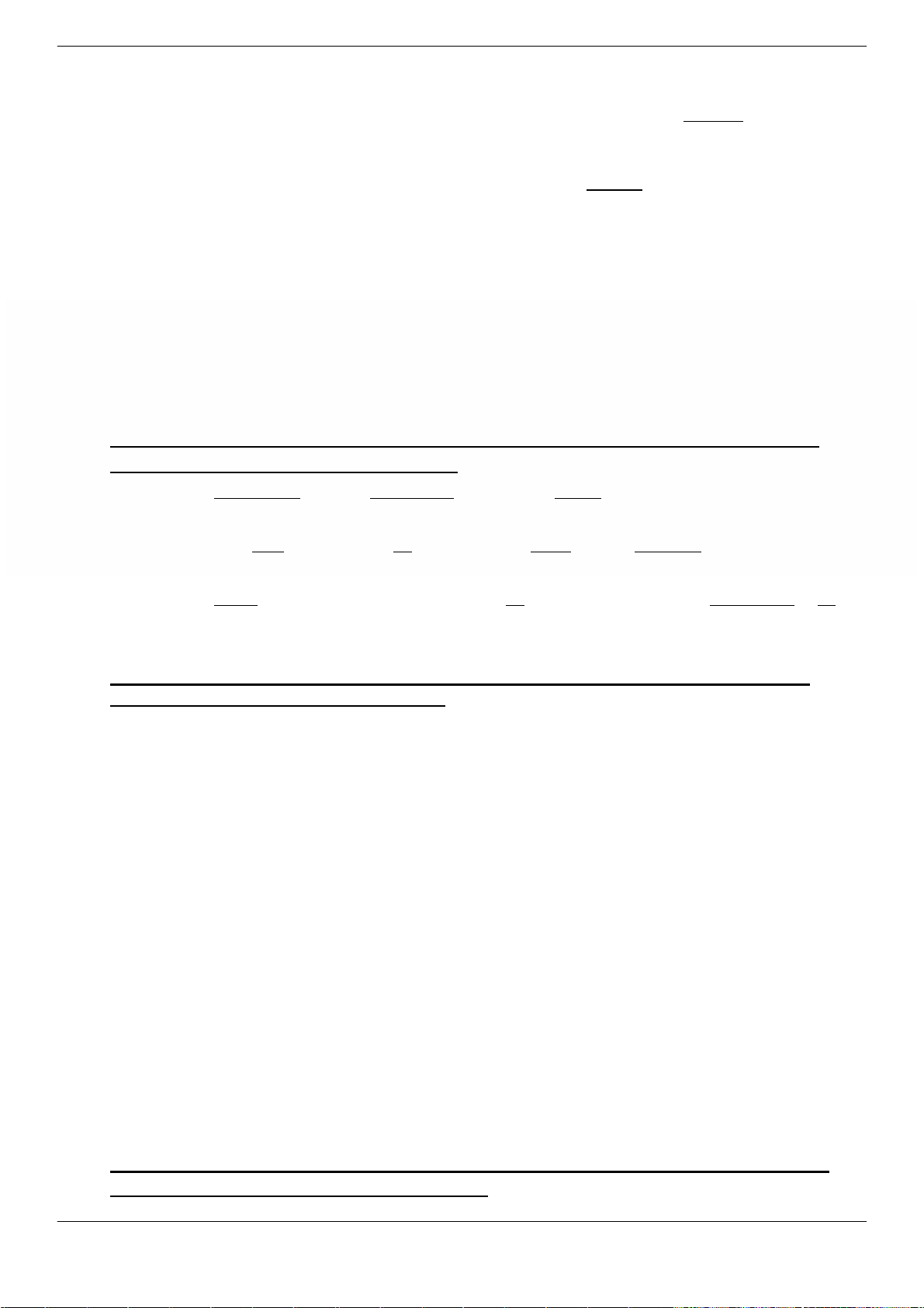
Trang
223
C. The search for rare animals D. The search for new farm lands
Question 40. The word "regenerate" in paragraph 2 is closest in meaning to .
A. recover B. renew C. repeat D. refine
Question 41. The phrase "these lands" in paragraph 3 refers to .
A. lands for raising cattle B. lands sold and colonized
C. lands abandoned and wasted D. lands for planting
Question 42. What can be inferred about rainforests from the passage?
A. Rainforest destruction can be reduced with the help of cattle ranchers.
B. The cycle of rainforest destruction will come to an end.
C. Human beings are the main contributor to deforestation in tropical regions.
D. Most tropical rainforests have been sold to plantation owners.
Mark the letter A, B, C, or D on your answer sheet to indicate the underlined part that needs
correction in each of the following questions.
Question 43. Working as a doctor would give me a chance taking care of people's health.
A B C D
Question 44. Jane help her mother to do the housework when she has free time.
A B C D
Question 45. Many living organisms depend largely on the environment for the satisfaction of its
A B C D
needs.
Mark the letter A, B, C, or D on your answer sheet to indicate the sentence that is closest in
meaning to each of the following questions.
Question 46. They cancelled all the sporting events because of the heavy rain.
A. Without the heavy rain, they wouldn't cancel all the sporting events.
B. If it hadn't rained heavily, they would have cancelled all the sporting events.
C. If it didn't rain heavily, they wouldn't cancel all the sporting events.
D. Had it not rained heavily, they wouldn't have cancelled all the sporting events.
Question 47. I haven't heard from Susan for several months.
A. I last heard from Susan several months ago.
B. Susan didn't hear from me several months ago.
C. Susan heard from me several months ago.
D. I didn't hear from Susan several months ago.
Question 48. "I didn't give John the money," said Mary.
A. Mary denied giving John the money.
B. Mary admitted giving John the money.
C. Mary suggested giving John the money.
D. Mary remembered giving John the money.
Mark the letter A, B, C, or D on your answer sheet to indicate the sentence that best combines
each pair of sentences in the following questions.
Question 49. Many Vietnamese women are successful in their careers. They are excellent
homemakers.

Trang
224
A. Many Vietnamese women are successful in their careers, and they are excellent homemakers.
B. Many Vietnamese women are successful in their careers, for they are excellent homemakers.
C. Many Vietnamese women are successful in their careers, so they are excellent homemakers.
D. Many Vietnamese women are successful in their careers, or they are excellent homemakers.

Trang
225
Question 50. Nam had all the necessary qualifications. They didn't offer him the job.
A. Despite having all the necessary qualifications, Nam was not offered the job.
B. They didn't offer Nam the job as he had all the necessary qualifications.
C. Nam had all the necessary qualifications, so they didn't offer him the job.
D. If Nam had had all the necessary qualifications, he would have been offered the job.
------------------------ THE END ------------------------
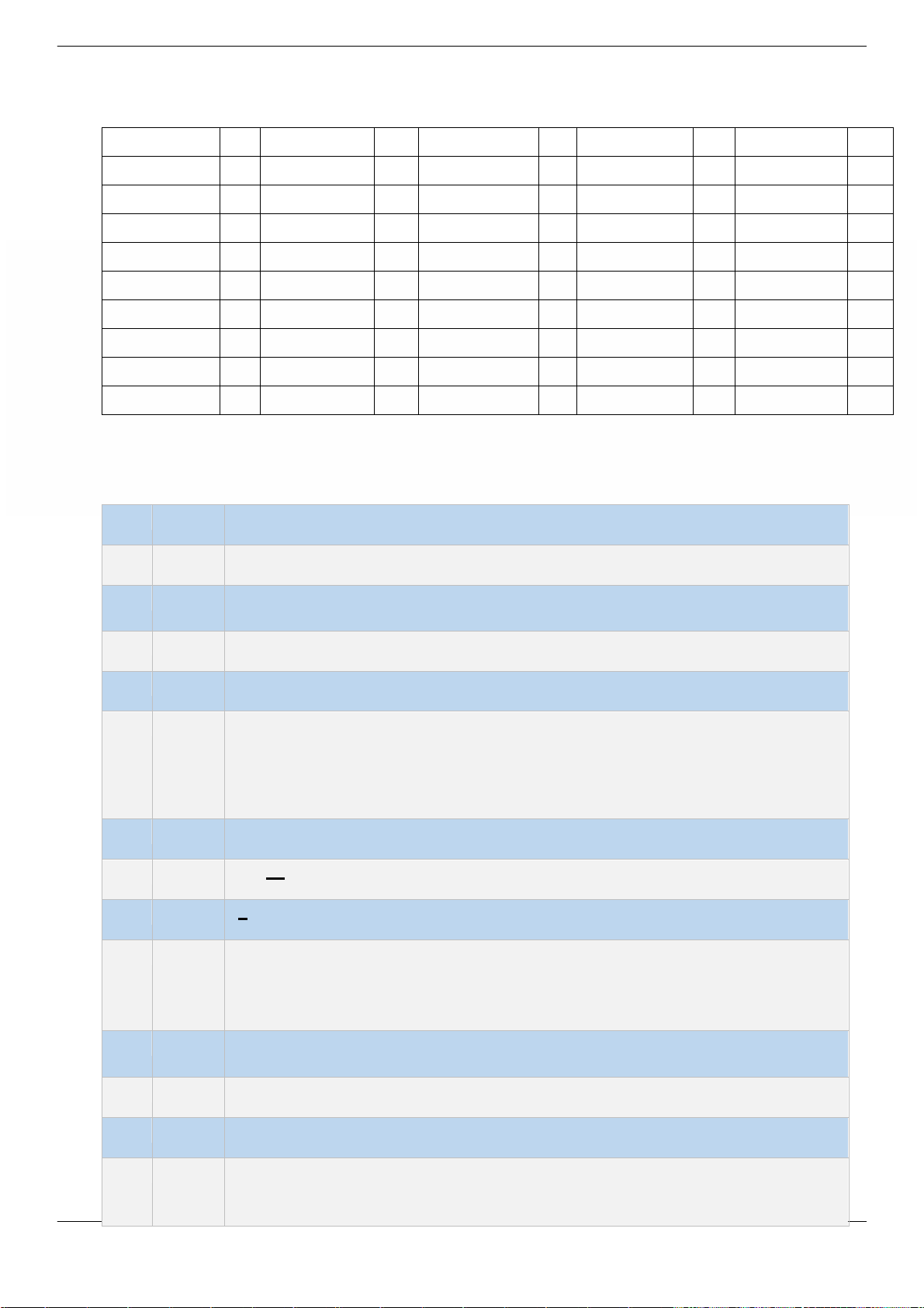
Trang
226
ĐÁP ÁN
Question 1
A
Question 11
C
Question 21
B
Question 31
B
Question 41
C
Question 2
B
Question 12
A
Question 22
D
Question 32
C
Question 42
C
Question 3
A
Question 13
D
Question 23
A
Question 33
C
Question 43
D
Question 4
A
Question 14
A
Question 24
B
Question 34
C
Question 44
A
Question 5
A
Question 15
C
Question 25
A
Question 35
B
Question 45
D
Question 6
C
Question 16
D
Question 26
C
Question 36
C
Question 46
D
Question 7
D
Question 17
B
Question 27
D
Question 37
C
Question 47
A
Question 8
D
Question 18
B
Question 28
D
Question 38
B
Question 48
A
Question 9
B
Question 19
C
Question 29
B
Question 39
B
Question 49
A
Question 10
C
Question 20
C
Question 30
D
Question 40
A
Question 50
A
LỜI GIẢI CHI TIẾT
Câu
Đáp án
Giải thích
1.
A
Fine, thanks
2.
B
3.
A
declareannounce
4.
A
hard: heavily
5.
A
at a loose end>< having a lotto do
làm
...........
6.
C
identical>< different: khác nhau
7.
D
opened
8.
D
dance
9.
B
essential
essential
dangerous
10.
C
11.
C
12.
A
food preservation
13.
D
new red Germanopinion-size-age-shape-color-
origin-material-purpose.
age-colour-origin

Trang
227
14.
A
must
phải
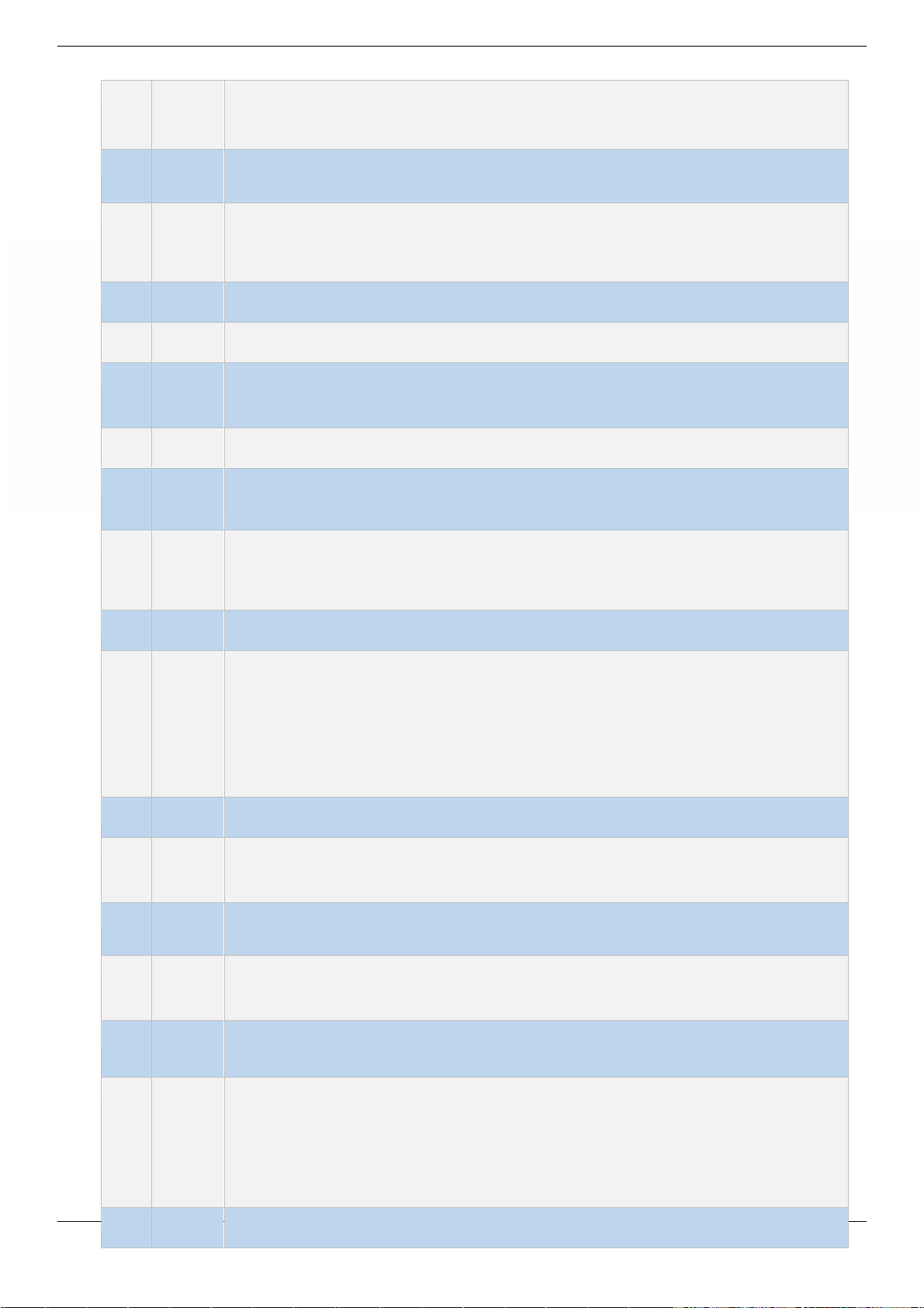
Trang
228
g
15.
C
tập trung vào
16.
D
The harder the life of the immigrants becomesThe + so
sánh hơn + S + V, the + so sánh hơn + S + V
17.
B
accelerate
18.
B
last week
19.
C
khi life
20.
C
competitive: có tính tranh, mang tính tranh; 1 Tính
market.
21.
B
carried out- research
22.
D
make use ofmake full use of
23.
A
encourage sb to do sth
(theo sau thì khích nhìn vào
24.
B
a sense of honesty
25.
A
in contrast
-
26.
C
who thay cho people travel and work abroad.
27.
D
useful: ích, có ích - 1 Tính cho trúc: it is + adj + to do sth: là
28.
D
The tradition of child naming in different cultures con
khôn
29.
B
ý 2: In many European cultures, names are typically chosen by
parents.
30.
D
meansway.
31.
B
the child's name is chosen to influence the child’s character -
charaterpersonality.
32.
C
s Akan culture, the day a child is born
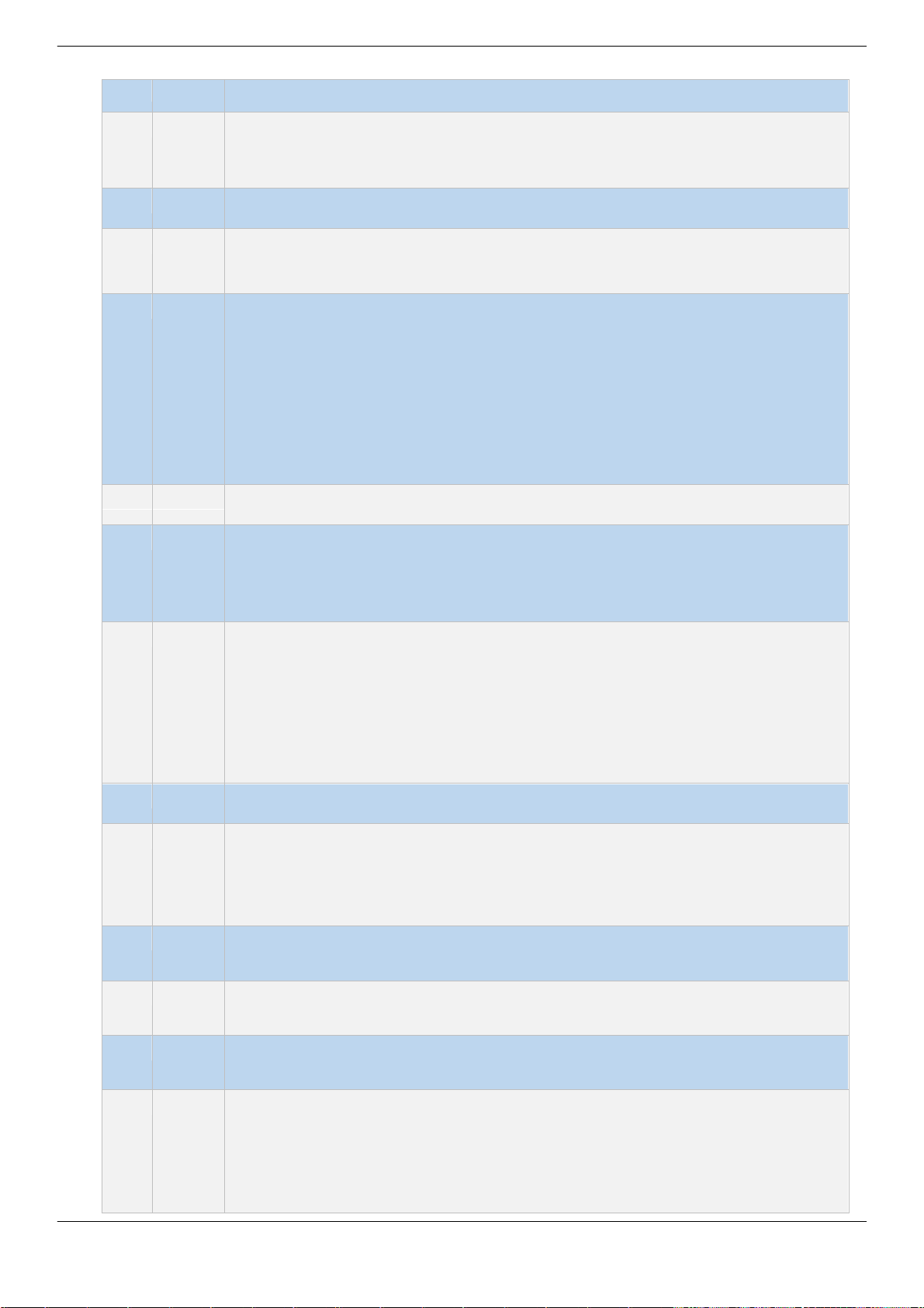
Trang
229
determines the child's name. But each day has different names for boys and girls".
33.
C
the name is chosen according to preference or dictated by
tradition, it reflects something about a child's culture.
it name.
34.
C
treasurevalue
35.
B
Causes and effects of rainforest destruction tàn
36.
C
It was greater in the 1980s than in the early 1990s
1990.
- Some scientists estimate that in the early 1990s tropical
forests were being destroyed at a rate of approximately 28 hectares a minute, or
about 14 million hectares each year - an area about the size of the state of
Wisconsin. This figure marked a decrease since the 1980s, when approximately
16 million hectares were destroyed each year, largely due to a reported decline
of deforestation in the Amazon River Basin in the early 1990s".
37.
C
reboundedrisen again.
38.
B
The disappearance of many rainforest species: loài sinh
39.
B
The search for valuable woods-
in search of valuable rainforest hardwoods, or less
often, oil, companies in search of petroleum, are often the first to enter a remote
area of rainforest.
làm trên kéo theo làm và các nông dân
40.
A
regeneraterecover
41.
C
cattle, lands are then abandoned and often laid to waste. Rainforest does not
readily regenerate on these lands without human intervention."
42.
C
Human beings are the main contributor to deforestation in tropical regions:
43.
D
Taking to take
give sb a chance to do sth
44.
A
help helps
45.
D
Its their
living organisms -

Trang
230
46.
D

Trang
231
- Had + S (+ not) + Vp2 + O, S + would + have
+ Vp2
47.
A
Quá
48.
A
John"
John.
49.
A
50.
A
A. Despite having all the necessary qualifications, Nam was not offered the job.
. dùng despite + V-ing
Bấm Tải xuống để xem toàn bộ.

